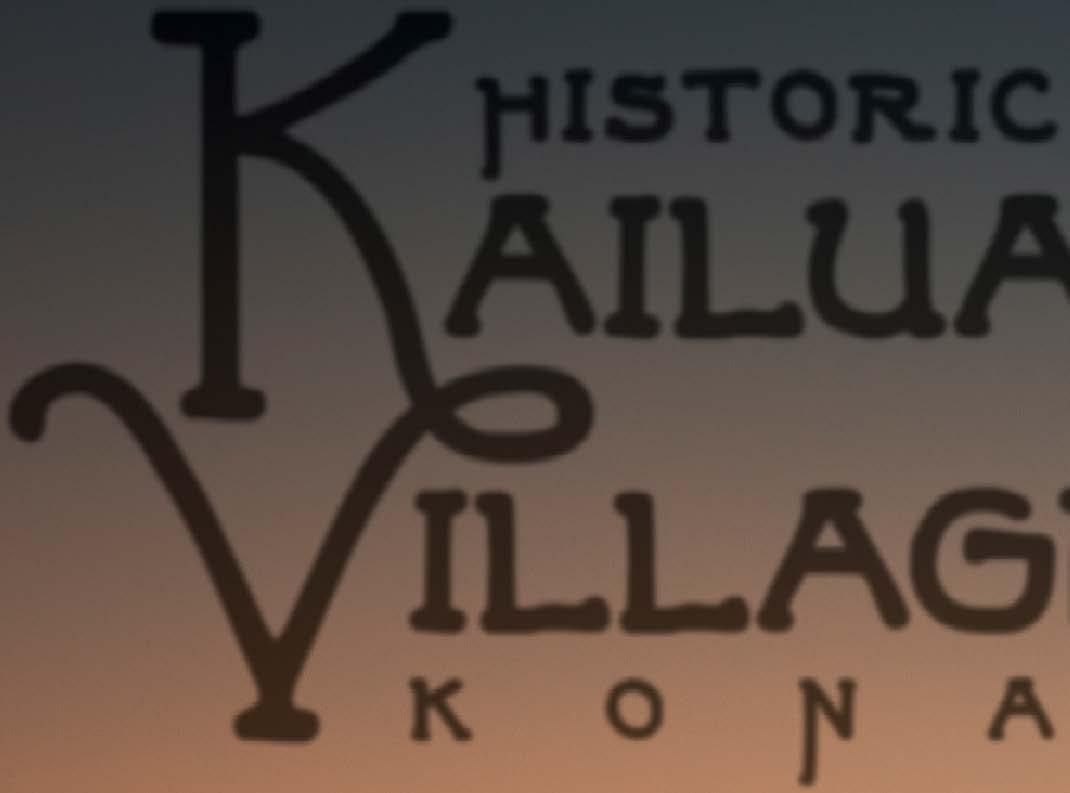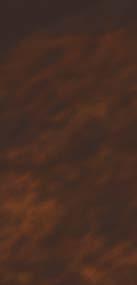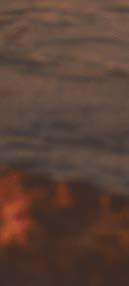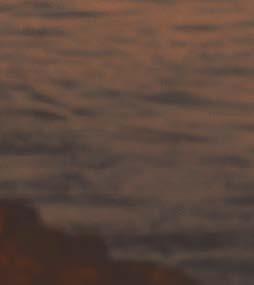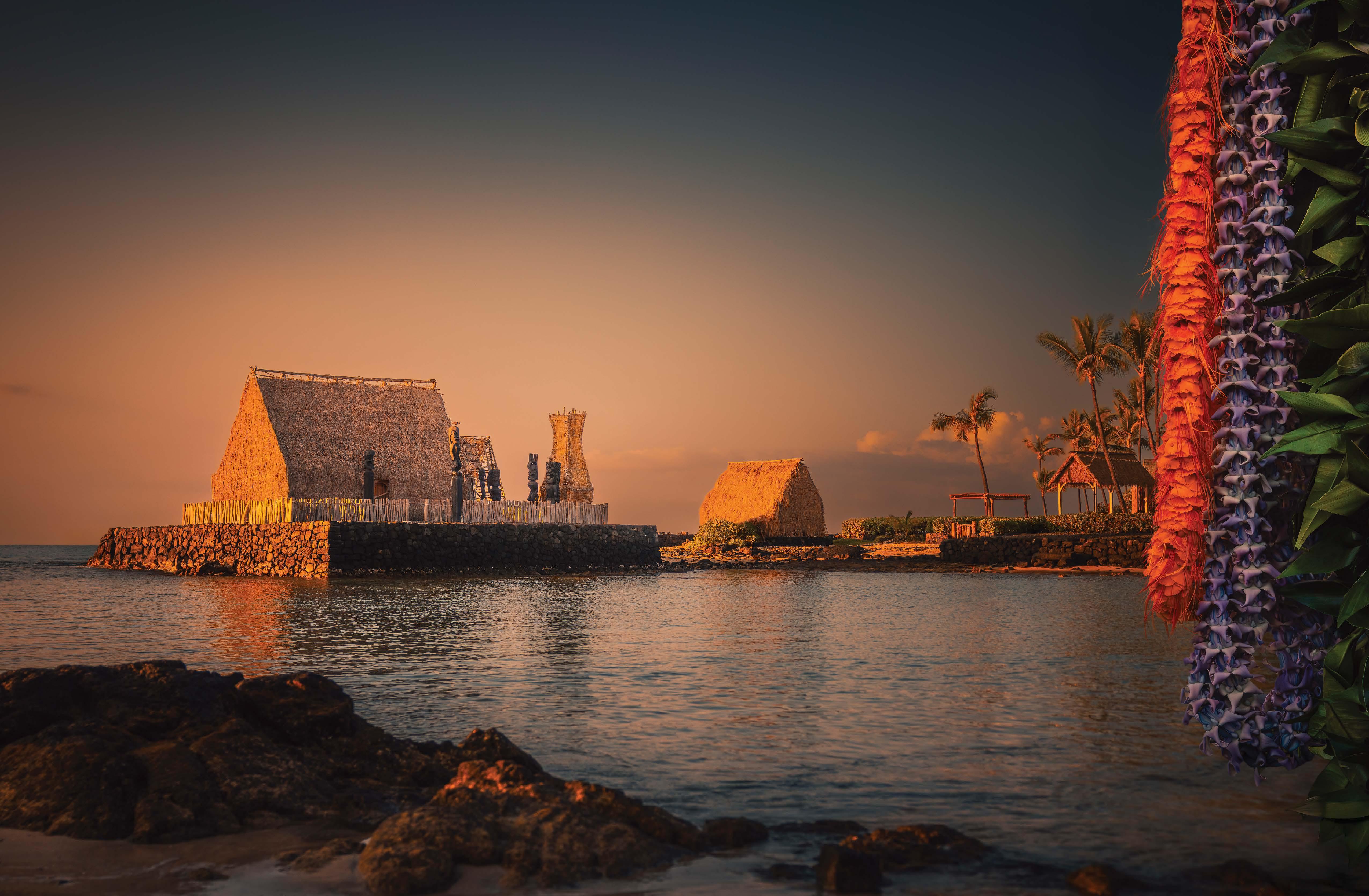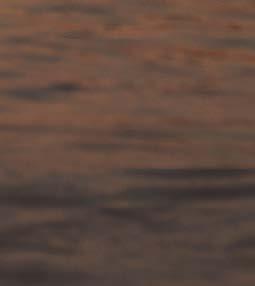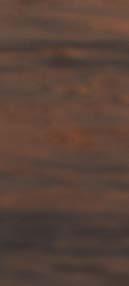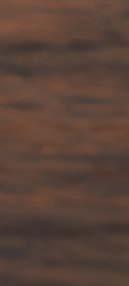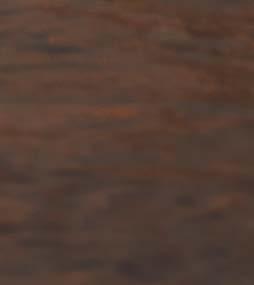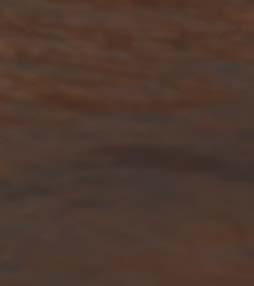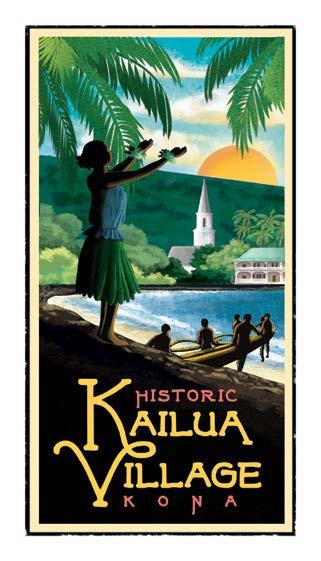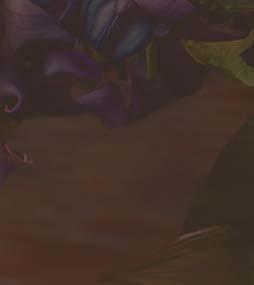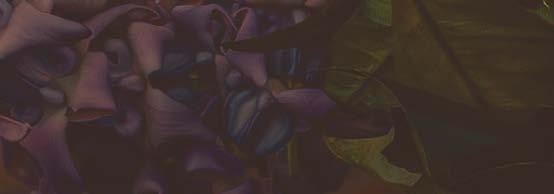




Tours showcasing every incredible sight on the Island of Hawai‘i. Departs from Hilo Airport.


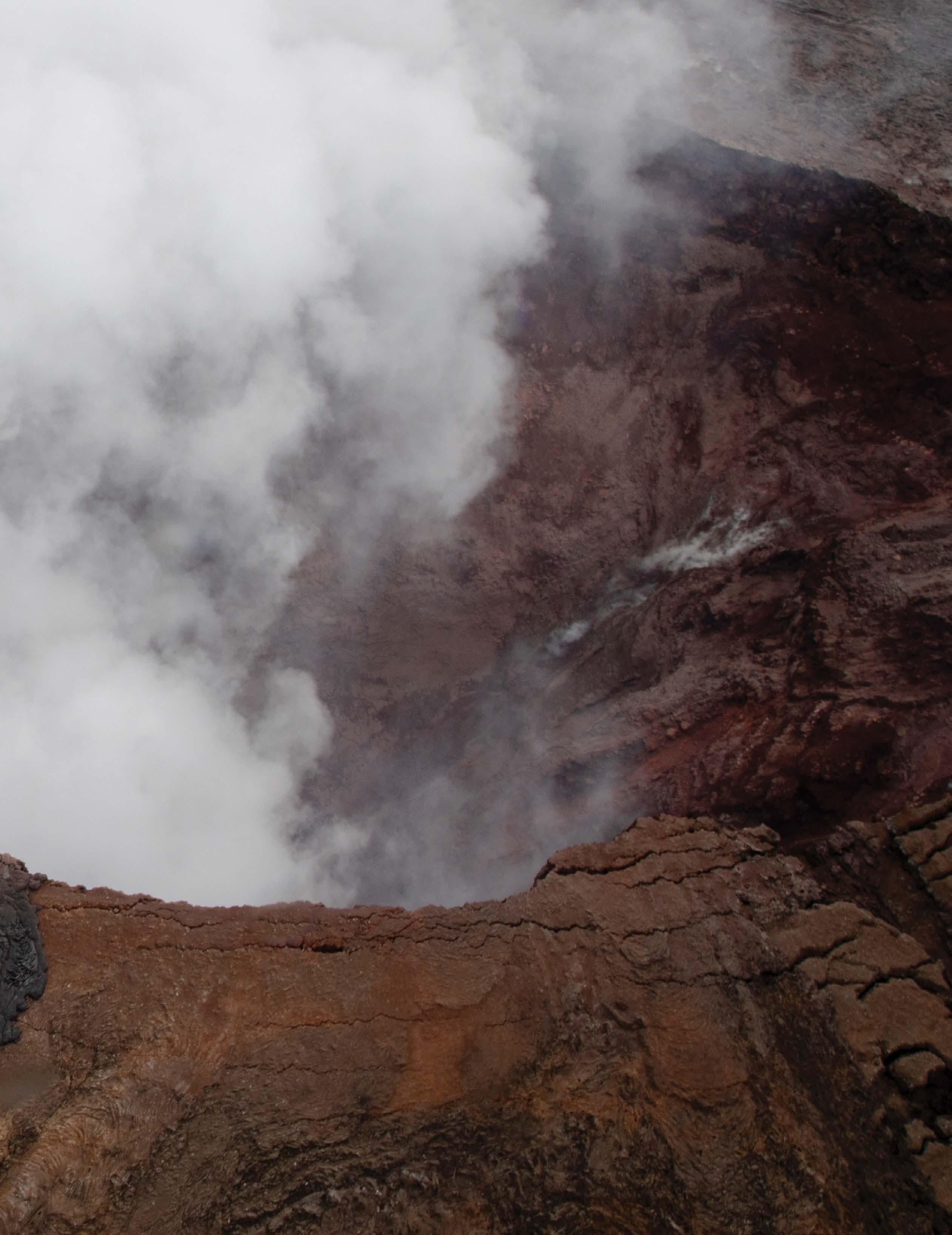


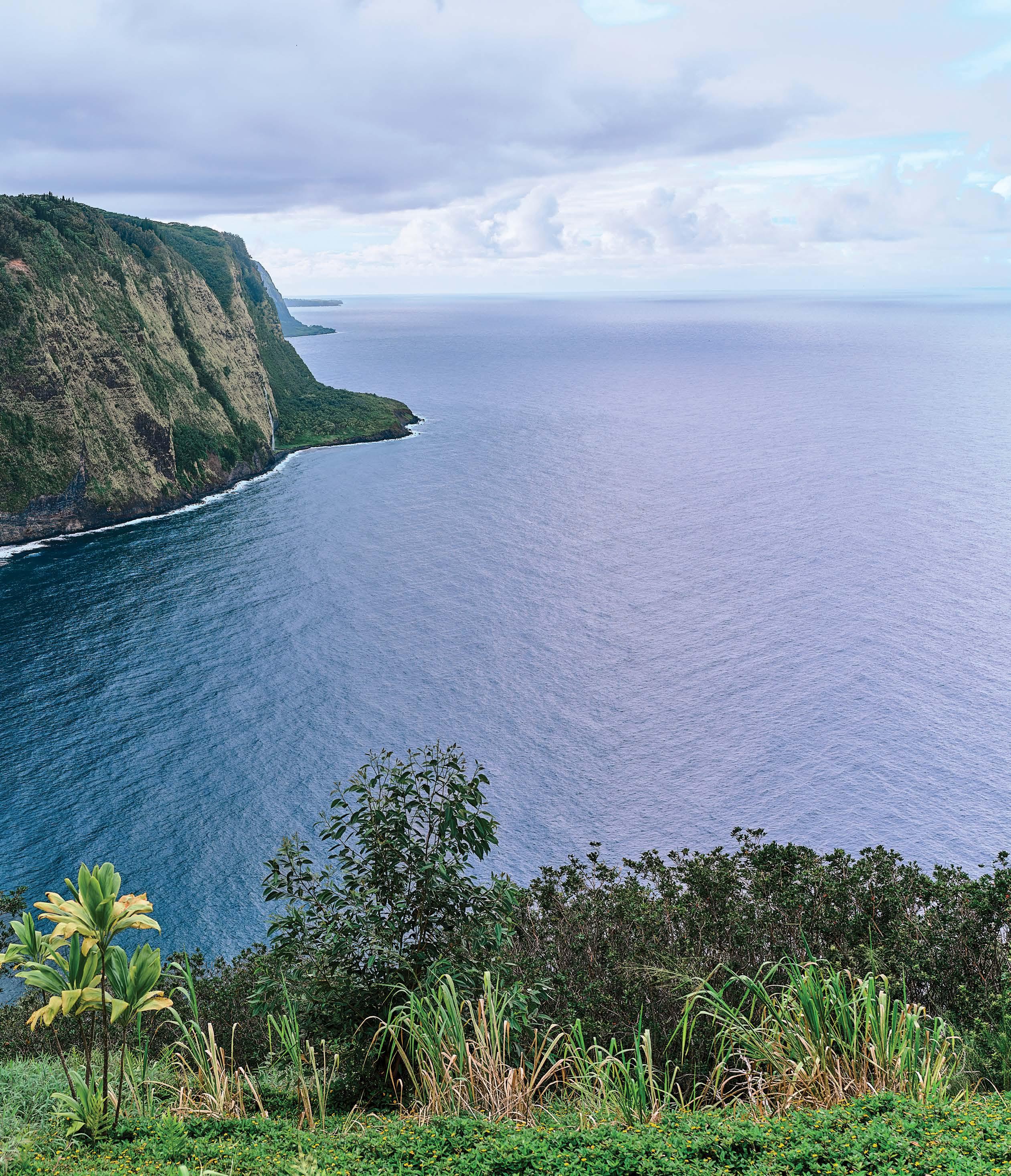
The Island of Hawai‘i is like nowhere else — and sharing the values of our people and encouraging visitors to experience our unique culture is what makes our home, this place, so special.
We encourage visitors to see our island’s natural beauty in a new way, as the backdrop, while showcasing the beauty of our values. From the melodic sounds of mele (songs) to sharing aloha with fragrant lei. From the preservation and perpetuation of Native Hawaiian knowledge to using food to bring the community together. We encourage visitors to seek engaging experiences through the lens of our people, which helps spread the benefits of tourism to broader communities throughout these islands.
In Hawai‘i, it’s not just the place — it’s the people — that make these islands so unique, beautiful and worth experiencing. Learn more at gohawaii.com/thepeopletheplace
Jack Dugan | Publisher
David Christy | Production Manager
Maggie Salerno | Publisher Assistant
Tara Dugan | Advertising Director
Michael Youngsma | Graphic Design
Alexandra Telford | Client Relations
Bree Tabisula | Accounting
Katherine Jimenez | Accounting
Experience the Island of Hawai‘i is published in partnership with the Hawai‘i Visitors & Convention Bureau.
Tom Mullen | Chief Operating Officer
Scott Pauli | Executive Director, IHVB
Karen Wataru Nakaoka | Senior Director, Member and Community Engagement
Gina Chun | Senior Director, Advertising and Marketing Programs
Kainoa Daines | Senior Director, Destination Education
Donna Kimura | Marketing Director, IHVB
Jerome Ikaika Nihipali | Education Manager
Roxanne Relles | Manager, CRM MVNP | Creative
Chuck Bergson | Chief Executive Officer
Jack Dugan | Chief Operating Officer
Editorial Inquiries: guidebooks@pmghawaii.com
Advertising Inquiries: tara@pmghawaii.com
Pacific Media Group 311 Ano Street, Kahului, HI 96732 PMGHawaii.com | 808.877.5566
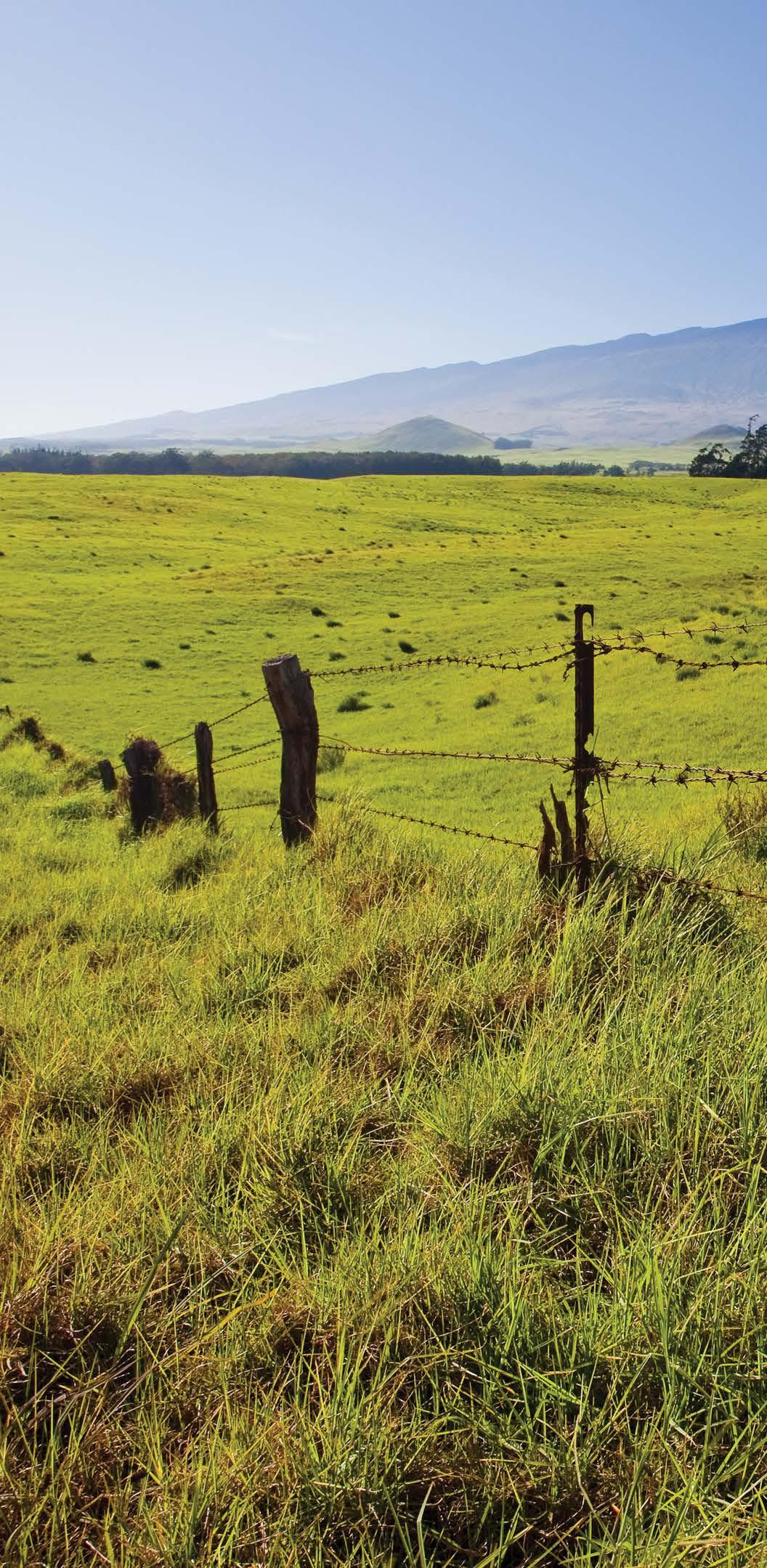
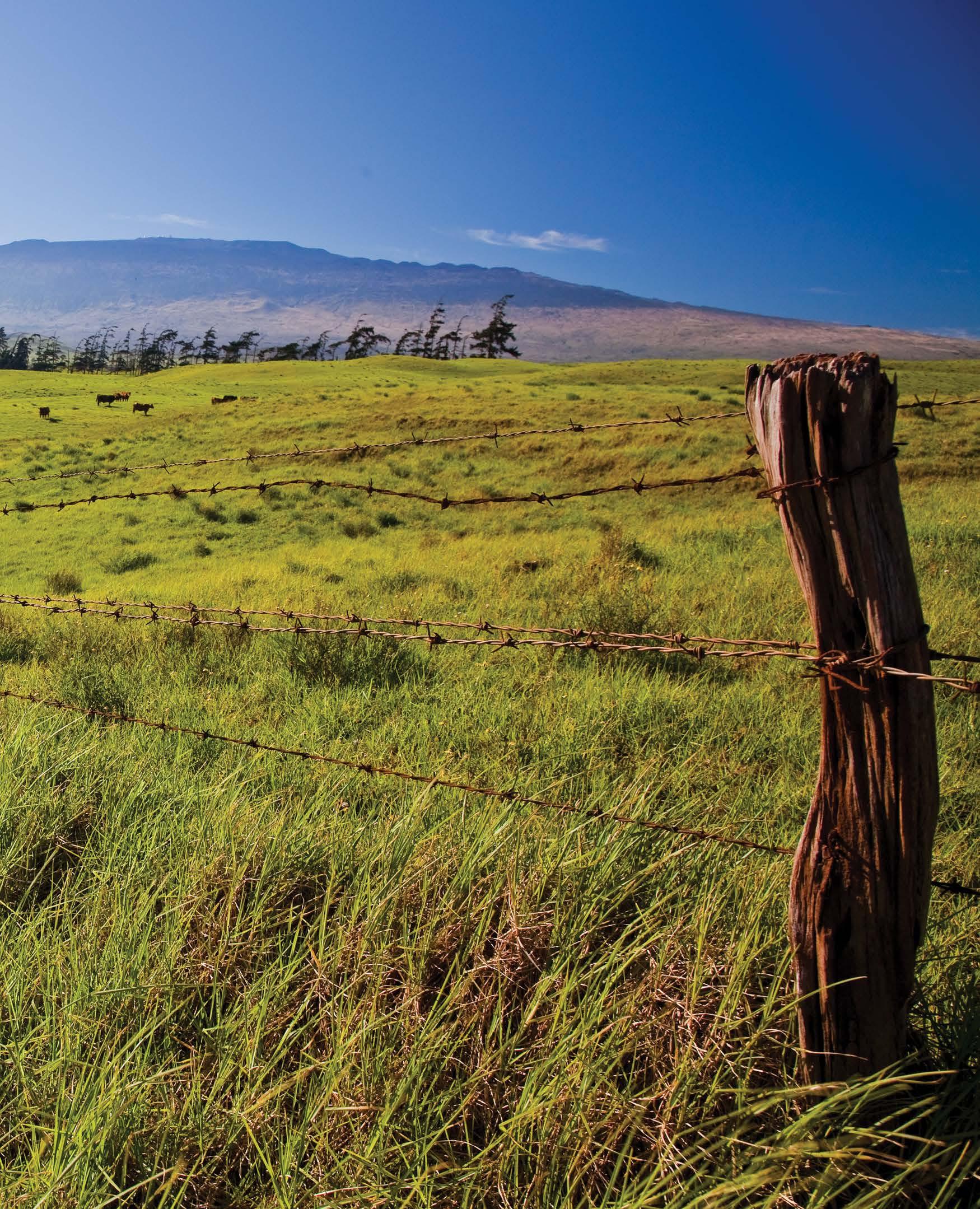
Kū ka‘apā Hawai‘i, he moku nui
([It is well for] Hawai’i Island to show activity; it is the largest of the islands.) Hawai‘i Island should lead forth for she is the largest.
‘Ōlelo No‘eau #1885
Spanning over 4,028 square miles, Hawai‘i Island is a land of extremes, where untouched beauty stretches from active volcanoes to snow-capped peaks, green pasturelands to vast lava deserts, lush rainforests to vibrant valleys and beaches with sands in shades of white, amber, gray and black, while also being home to all but four of the world’s climate subzones. This diversity, coupled with an appreciation of the history, culture and sense of place of the island, create a rewarding experience for visitors and residents alike.
Centuries before King Kamehameha I unified the Hawaiian Islands, four ali‘i (chiefs) ruled their respective islands with absolute authority. Cloaked in the plumage of native birds, the ruling class of these islands were revered by their people as they understood the importance of their kuleana (responsibility) to their people, ‘āina (land) and gods. They were so celebrated that we still honor them today, centuries after their bones have been secretly laid to rest. Their epic deeds and battles, preserved in oli (chants) and mele (songs), live on as poetic testaments to their leadership prowess and continue to form so much of each island’s identity.
Moku o Keawe, another name for Hawai‘i Island, means “island of Keawe” and honors Keawe‘īkekahiali‘iokamoku, a 17th-century ali‘i who united the island through diplomacy, alliances and strategic marriages. His leadership ushered in a time of peace and prosperity, laying the foundation for his descendants, including his great-grandson Kamehameha, who later unified the Hawaiian Islands. Today, Hale o Keawe at Pu‘uhonua o Hōnaunau National Historical Park stands as a testament to his legacy. The ruling chiefs of Hawai‘i upheld unity, peace and prosperity, and their spirit endures through the stories and traditions that keep their memory alive.
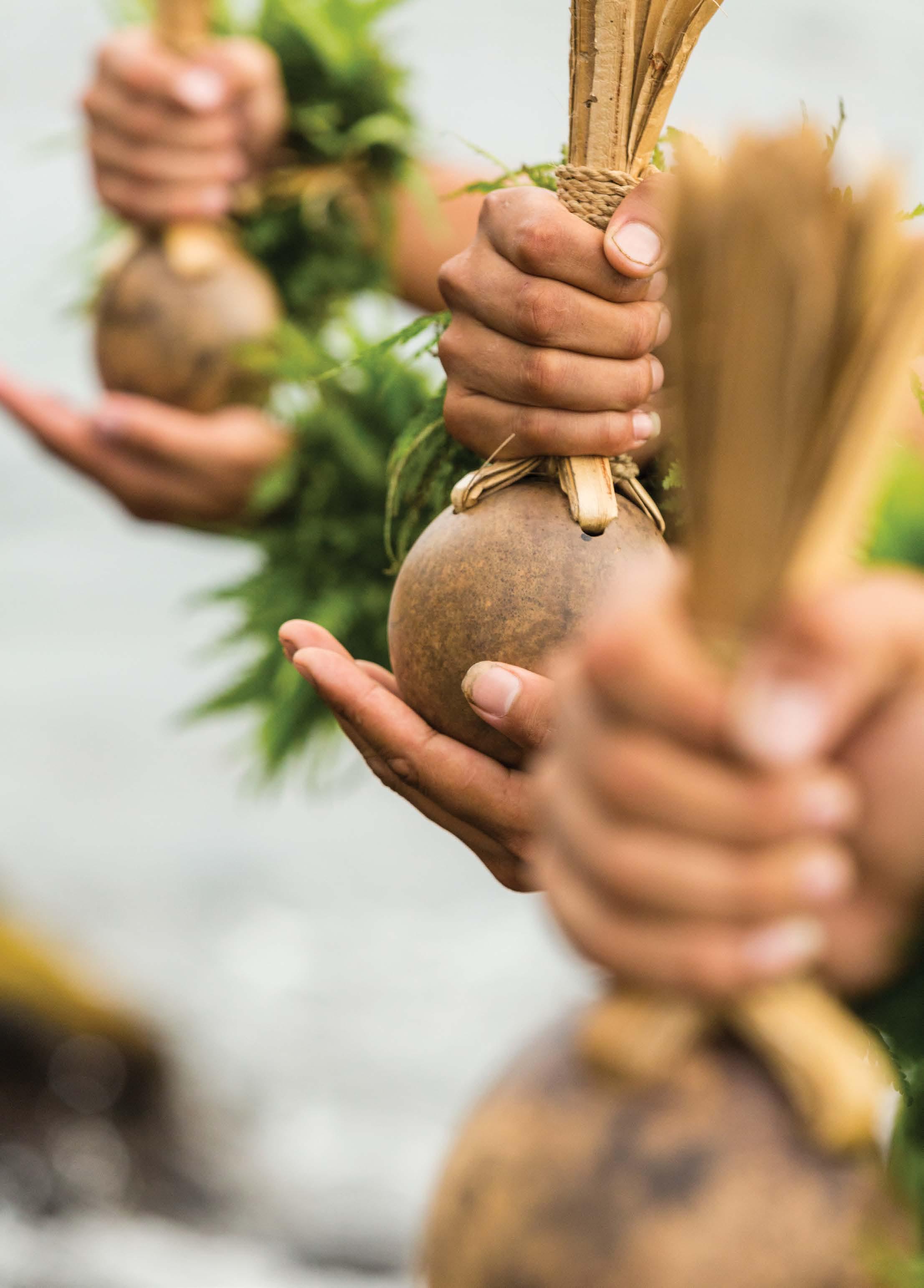
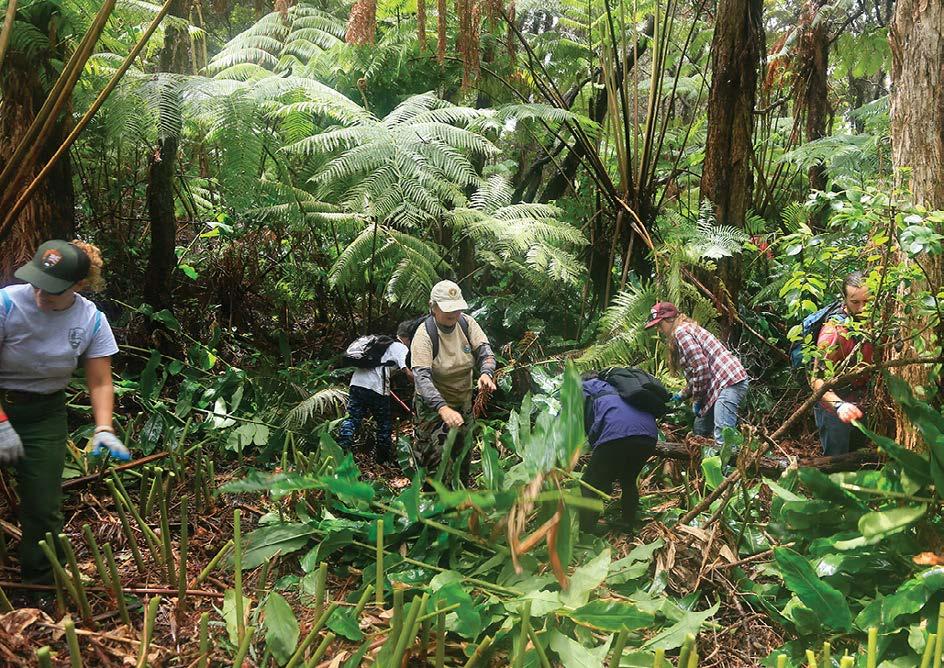
Visitors from around the world come to the island of Hawaiʻi for its awe-inspiring nature.
However, a trip to Hawai‘i becomes even more enriching when you immerse yourself in its unique culture and spirit. Throughout this guide (and throughout your visit), look for opportunities to mālama (to care for) Hawai‘i Island and expand your kuleana (responsibility).
Fundamental to the character of these islands are the values of mālama and kuleana Mālama means to care for, to protect, to help — a mindset and a call to action to protect our home. Kuleana combines responsibility and privilege into one idea.
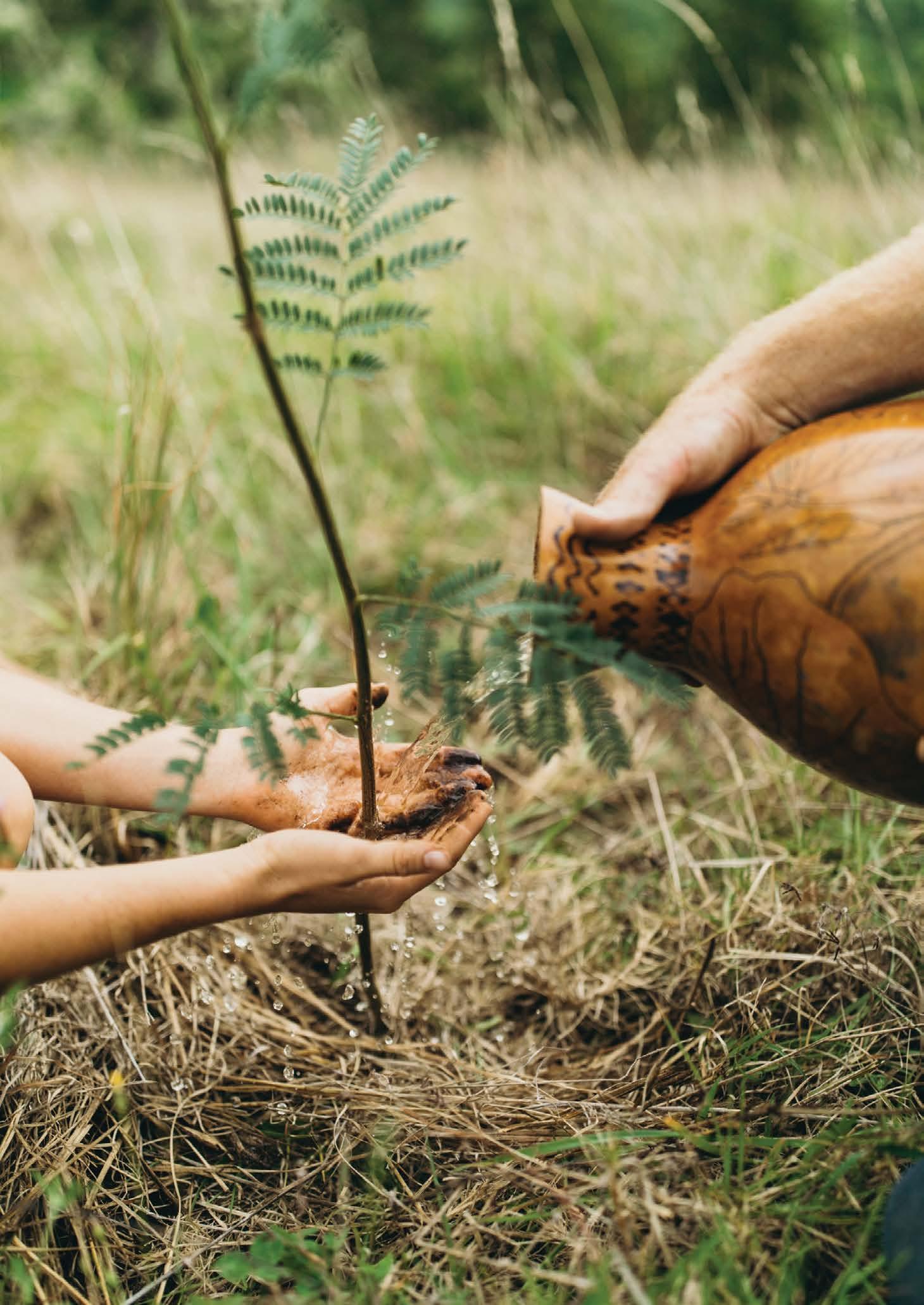
These are values held dear by both Native Hawaiians and kama‘āina (local residents) who have come to fully understand and embrace the idea that all of us who have the privilege of seeing the island’s natural beauty must take steps to ensure its safeguarding.
We encourage you to learn frequently used Hawaiian words like aloha (hello, goodbye, love, affection), mahalo (thank you), ma uka (towards the mountains) and ma kai (towards the sea) and use them in your adventures throughout the islands. You’ll find that locals truly appreciate the effort, and through these interactions you will come away with a deeper appreciation for what makes our culture so unique.
LEFT TO RIGHT
STEWARDSHIP AT THE SUMMIT | NPS HANDWASHING AND WATERING IN REFORESTATION PROJECT
As a visitor, we recommend taking the time to learn about the rich traditions and culture of these islands before, during and after your visit.
Mālama
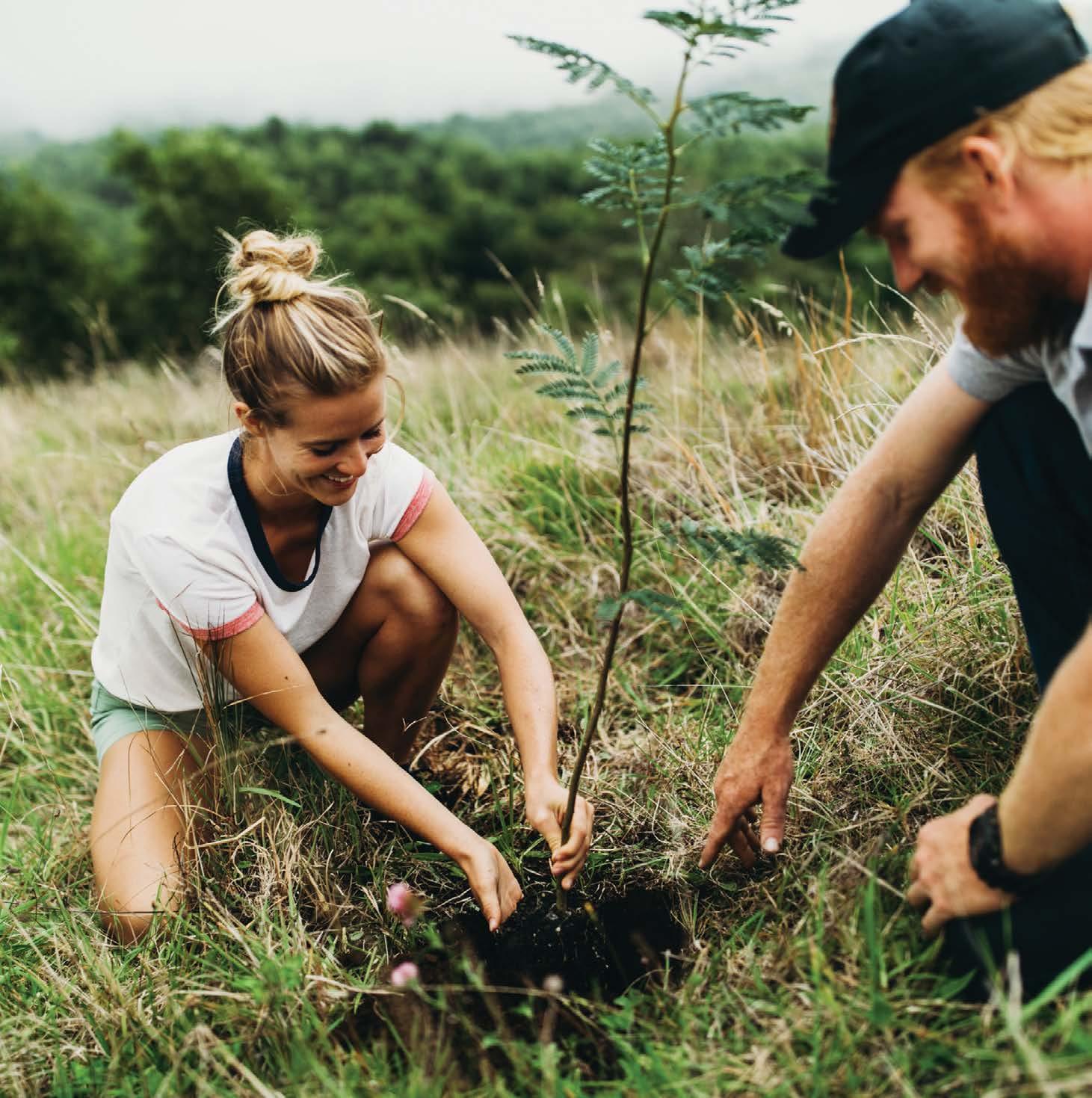
Mālama i ke kai (care for the ocean) is a Hawaiian tradition that you should practice while visiting the island of Hawai‘i. This means taking care not to upset the delicate natural balance of our ecosystems. When in the ocean, we ask that you not touch the coral or the plants and animals surrounding it. In fact, keep a respectful distance from all sea creatures for their safety and yours, and be sure not to walk on the reef.
Mālama i ka ‘āina (care for the land) is one of the most important concepts in Hawaiian
tradition, and it’s just as important today as ever. Help us protect our natural resources by staying on trails when hiking and by not disturbing any plants or historical features. Consider guided tours, which are sensitive to the environment and provide you the opportunity for a deeper learning experience with a local expert.
Please recycle or properly dispose of your ‘ōpala (trash) to avoid littering. Single-use plastic bags with handles are not provided in county stores. Fortunately, reusable grocery bags are offered at most stores to purchase. Numerous recycle bins and redemption centers are located throughout the islands.
Hawai‘i’s unique ecosystems are fragile. Removing natural resources (sand, shells, plants, lava rock, etc.) can disrupt local habitats, contribute to erosion and negatively impact wildlife. Conservation efforts aim to protect these natural resources for future generations. Violators can face fines.
It’s important to reduce the impact of your visit to our natural environment by observing local laws, customs and traditions, but you can also actively help to preserve this magnificent island. You can learn more about the true meaning of mālama ‘āina (care for the land) by contacting local organizations that are working to preserve and restore ecosystems across the island.
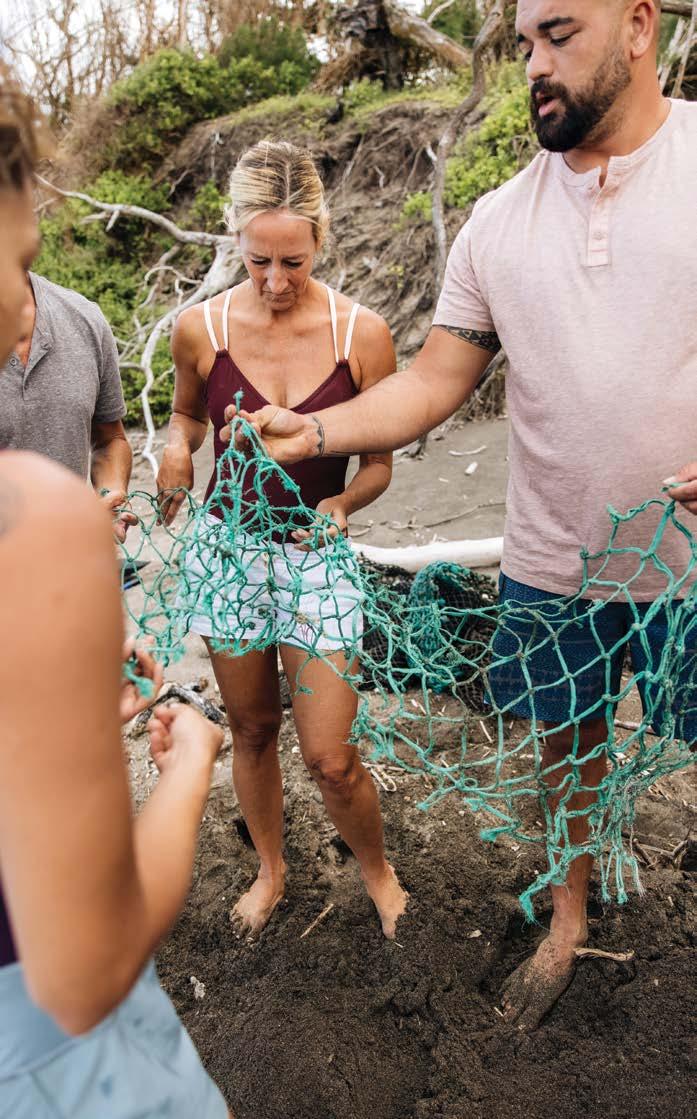

ALOHA WINE BAR
BIKEWORKS BEACH & SPORTS
BLUE GINGER
CARILOHA
CLAIRE’S
COCONUT AVE.
CROCS
DAIRY QUEEN
CULINARY MARKET
HAWAI’I ISLAND GROWN & MADE
2 ND & 4 TH THURSDAYS | 4 - 7 PM
HULA SHOW
FREE HAWAIIAN HULA
MONDAYS | 6 PM
GECKO GIRLZ
GENESIS GALLERY
HAWAII FLUID ART
ISLAND GOURMET MARKETS
ISLAND GREENS
KONA SURF N’ SANDALS
KOR SALON
KOZY’S COMEDY & MAGIC SHOW
KULEANA RUM SHACK
L&L HAWAIIAN BBQ
LAVA LIGHT GALLERY
MAHINA
MALIBU SHIRTS
MASHKA JEWELRY
MAUI DIVERS JEWELRY
OLIVIA CLARE BOUTIQUE
OLUKAI
OSHIMA SURF & SKATE
REYN SPOONER
SKIN FACTORY TATTOO
SOHA KEIKI & SOHA LIVING
STARBUCKS
SUNGLASS HUT
THE BISTRO AT THE CINEMAS
WAIKOLOA LUXURY CINEMAS
WAIKOLOA PIZZA
WAIKOLOA SHRIMP CO. AND MORE!
Mālama
Hawai‘i is home to an amazing diversity of fish and wildlife, many of which can be found nowhere else on the planet. Hawai‘i is frequently referred to as the “endangered species capital of the world.” Unfortunately, the introduction of alien species and diseases has devastated native animals and many plants they depend on. The Pacific Islands Fish and Wildlife Office lists more than 400 threatened and endangered species across the state. Many species in Hawai‘i are protected by the federal Endangered Species Act. Please follow NOAA guidelines should you encounter the following animals:
If there are any signs or barriers posted, please stay behind them; otherwise, stay at least 50 feet (15 meters) away from seals, both on land and in the ocean. Your presence can be especially stressful for mother seals, who are likely to attack if they feel they or their pups are threatened. For your safety and theirs, view mother seals and their pups from at least 150 feet (about 45 meters) away.
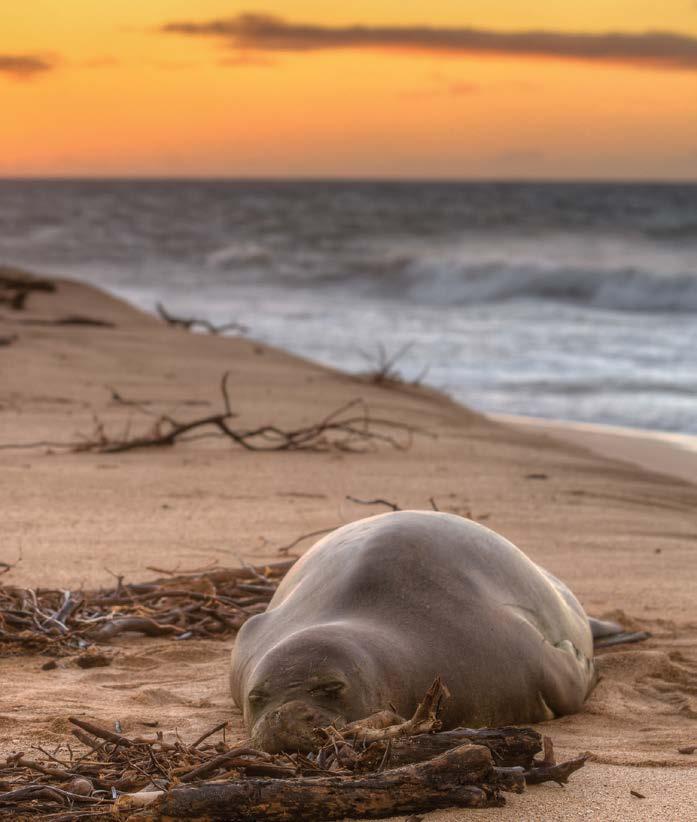
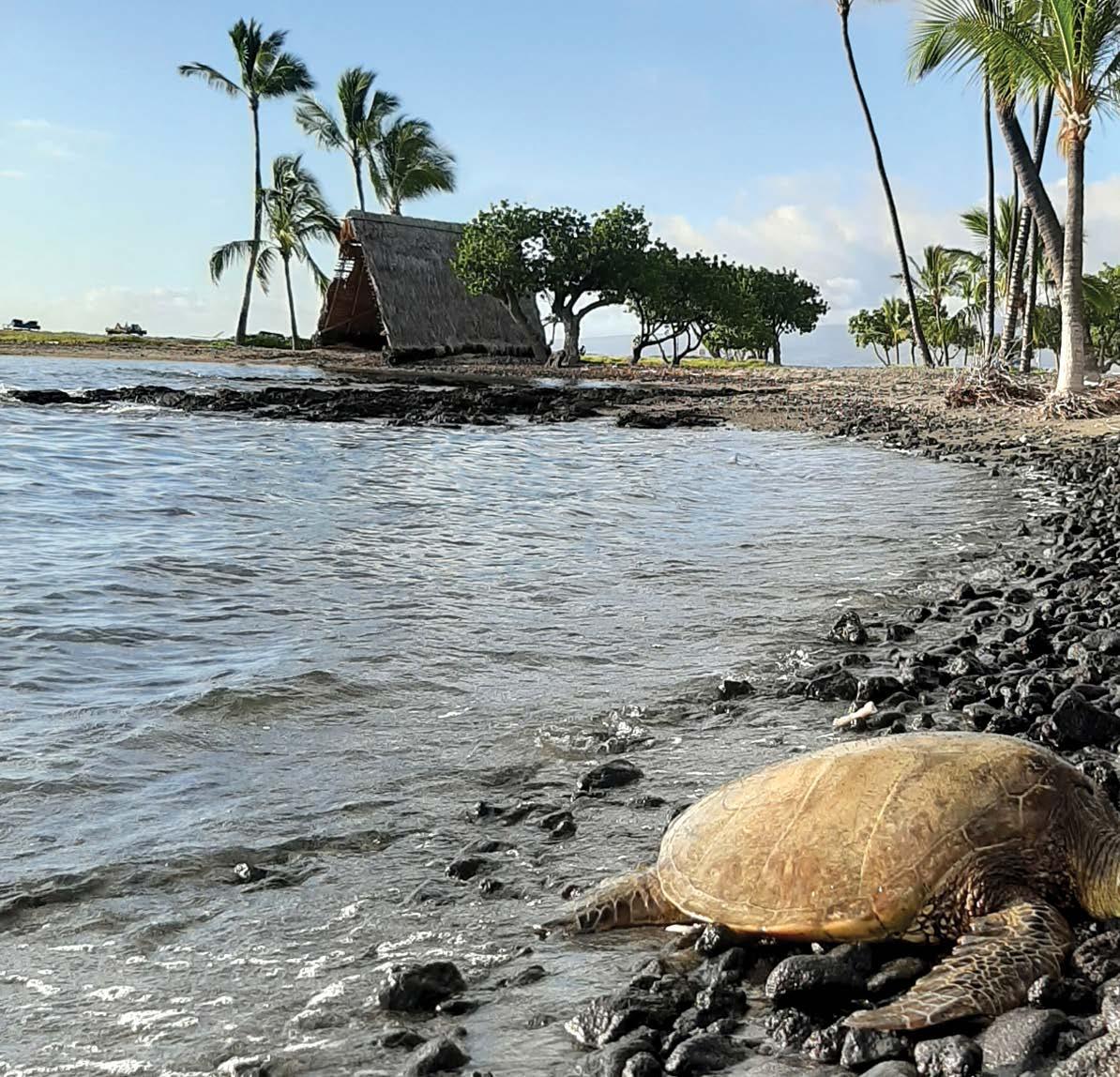
There’s an easy way to approximate this distance — extend your arm straight in front of you and make a “thumbs up” gesture. Rotate your hand so that your thumb is parallel to the ground. If your thumb obscures your view of the seal, you’re far enough. If not, back up until your thumb completely covers the seal.
Honu are miraculous to behold, but please keep your distance. Experts urge you to stay at least 10 feet (3 meters) away from all turtle species in Hawai‘i, whether on the beach or in the water.
Keep a respectful distance of at least 10 feet (3 meters) away — on land and in water.
Dolphins and whales are also frequently sighted in the warm waters close to shore. Federal law prohibits swimming with, approaching or remaining within 50 yards (45 meters) of spinner dolphins in Hawai‘i. Dolphins are nocturnal animals, so swimming out to them causes stress and takes away their much-needed resting time.
False killer whales are a species of oceanic dolphins found in Hawaiian waters and should be observed from no less than 50 yards (45 meters) away.
Required viewing distance: At least 100 yards (91 meters) away. Federal law prohibits approach within 100 yards, including by boat, kayak, drone, when swimming or by any other vessel or means.


Please help us protect our beloved wildlife and keep your distance from these precious creatures. If you see turtles, seals or dolphins near the beach or along the shoreline, please enjoy a different beach to avoid causing undue stress for the animals. Chasing and feeding marine mammals is prohibited by federal law. Pursuing and feeding marine life is prohibited by federal law. Limit your time observing an animal from afar to half an hour. Do not encircle or trap the animals between boats or shore. If approached by a marine animal while you are on a boat, put the engine in neutral and allow the animal to pass. Failure to comply with protections afforded endangered species will result in fines.
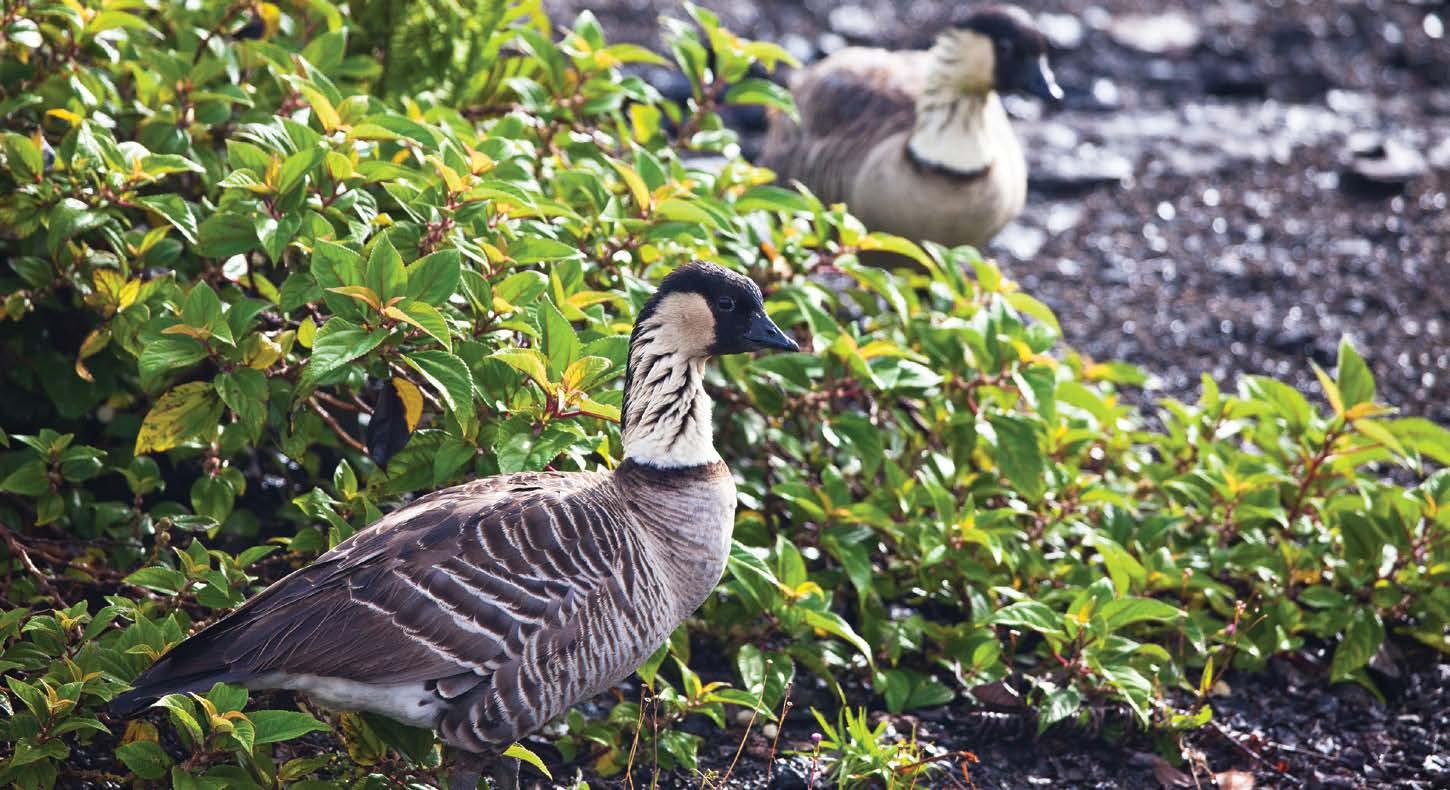
All of the Hawaiian Islands have complex and fragile ecosystems that are easily affected by outside influences. This is partly why Hawai‘i has the planet’s highest number of endangered and threatened native plant and animal species. An important value for Native Hawaiians and kama‘āina (local residents) is the idea of mālama ‘āina or to care for the land. There are many ways visitors can learn about the Native Hawaiian traditions used to work the land — and help locals regenerate Hawai‘i through sustainable efforts for generations to come.
For travelers interested in ecotourism and agritourism experiences, there are a variety of farm and agricultural tours, botanical gardens and more that showcase the island’s native plants, crops and unique environments.
Nēnē (Hawaiian Goose/Geese)
Feeding nēnē is illegal under state law and if you encounter them on the road, slow down and maintain a four-car-length distance to avoid inadvertently hitting one.
The most powerful aspect of Hawai‘i is not our incredible natural beauty or rich culture — it’s the deep relationship between the two. When you learn to love and appreciate Hawai‘i the way locals do, not only do you help us perpetuate all that we hold dear, but you get to experience what it’s like to have a connection with this remarkable place.
Launched in the fall of 2018, the Pono Pledge’s goal is to remind and encourage visitors and residents alike how to best enjoy the island of Hawai‘i — in a safe, responsible, mindful and regenerative way so that we can enjoy the beauty of the island for generations to come.
In 2022, the Pono Pledge video was created and shared by Hawai‘i Island residents and is available on the Pono Pledge website in ‘ōlelo Hawai‘i (Hawaiian language), English and with Japanese subtitles. The video includes beautiful scenic footage and was honored that year with a Silver Telly Award. Please enjoy the video at ponopledge.com and sign the online pledge.
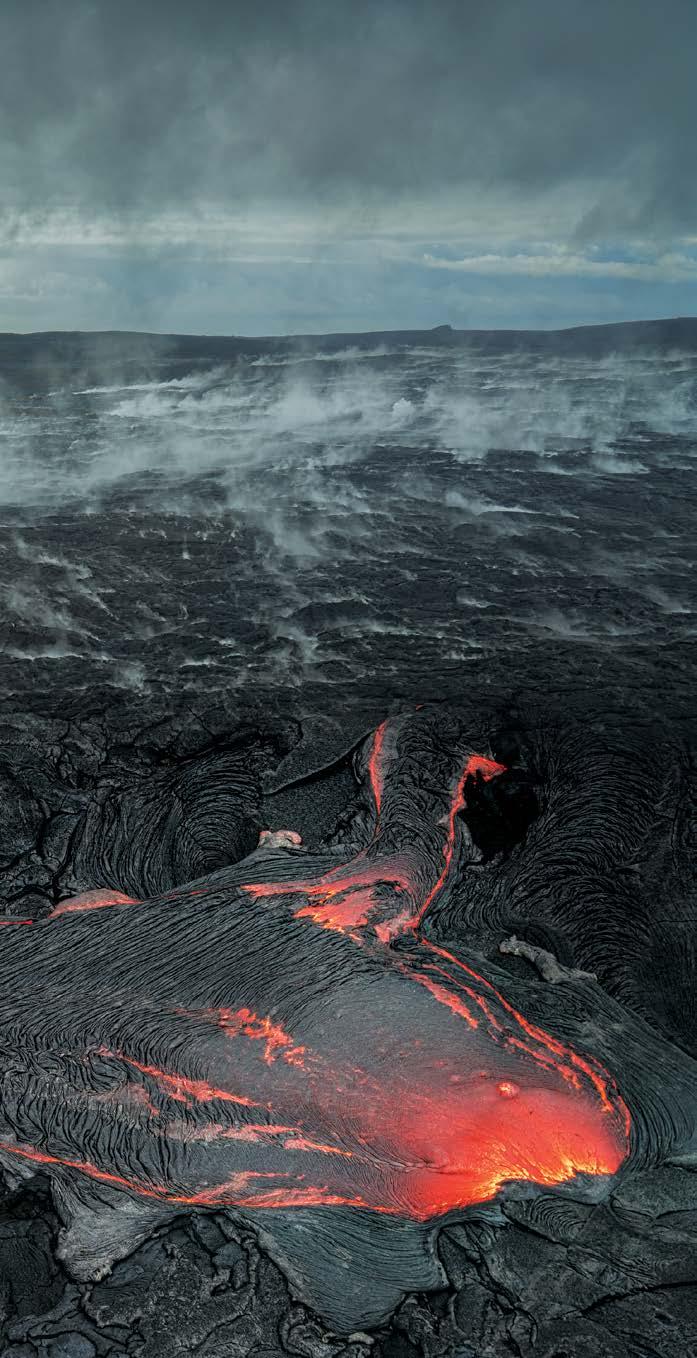
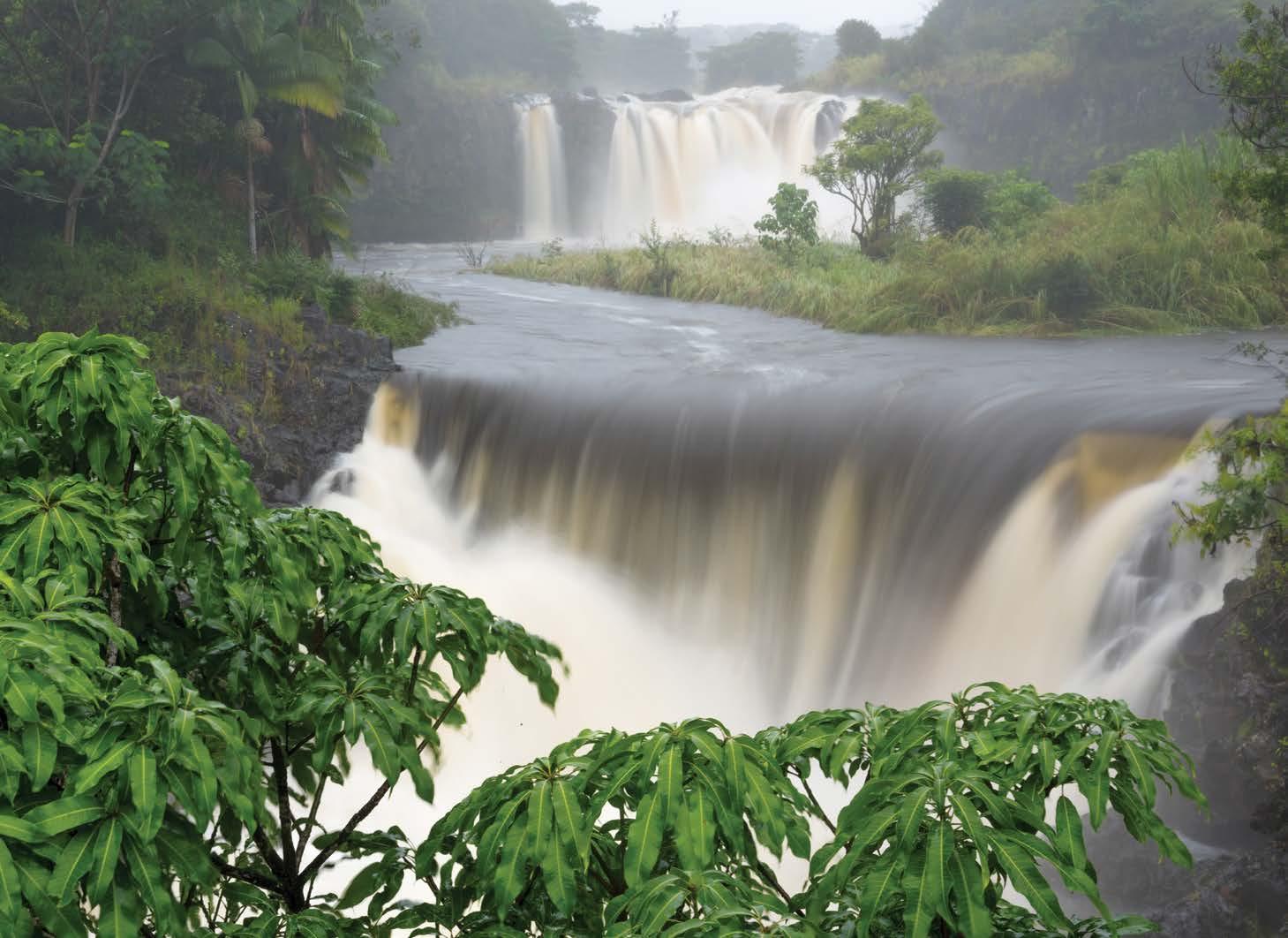
E kū i ka pono ke kipa i Hawai‘i. I pledge to be pono (righteous) on the island of Hawai‘i.
E nanea i ka ‘ikena, ‘a‘ole ho‘i e ki‘ihele hewa i kahi kuleana ‘ole.
I will mindfully seek wonder, but not wander where I do not belong.
E nihi ka helena i ka uka o Puna, mai pūlale i ka ‘ike a ka maka.
I will not defy death for breathtaking photos, trespass or venture beyond safety.
E mālama ‘ia ke kai a me ka honua, a e mahalo ‘ia ko laila mau ola lōhiu mai kahi mamao aku.
I will mālama (care for) land and sea, and admire wildlife only from afar.
Ho‘ohihi ka maka i ke ahi a ka Wahine, he ahi ‘ena‘ena e akahele ai.
Molten lava will mesmerize me, but I will not disrupt its flow.
‘A‘ole e kā‘ili ‘ia kā ha‘i, e waiho ‘ia ka pōhaku a me ke one i kona wahi pono‘ī.
I will not take what is not mine, leaving lava rocks and sand as originally found.
E nānā pono i ke kai, ‘a‘ole e huli kua ‘ia. I will heed ocean conditions, never turning my back to the Pacific.
Ke loku mai ka ua i uka, e ao a‘e i ia wai makamaka ‘ole.
When rain falls ma uka (inland), I will remain high above ground, out of rivers and streams.
He ali‘i ka ‘āina, he kauā ke kanaka. I will embrace the concept of being a steward of the land, revered as my loving chief.
E ‘apo i ke a‘o a ho‘ohana, a e ‘oi mau ka na‘auao.
Those who apply their teachings increase their knowledge.
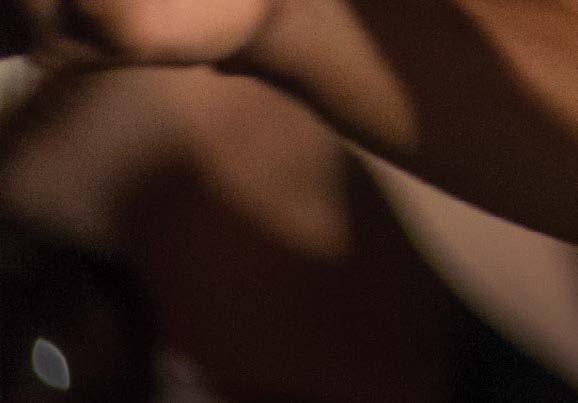
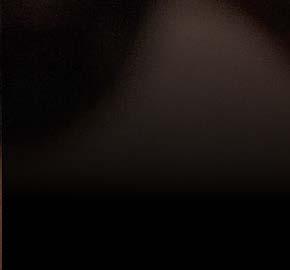




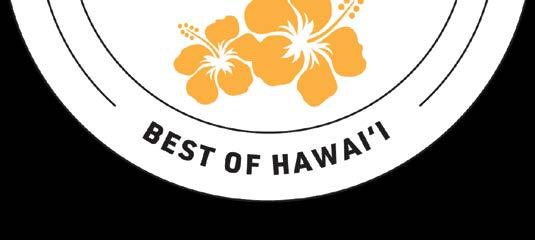


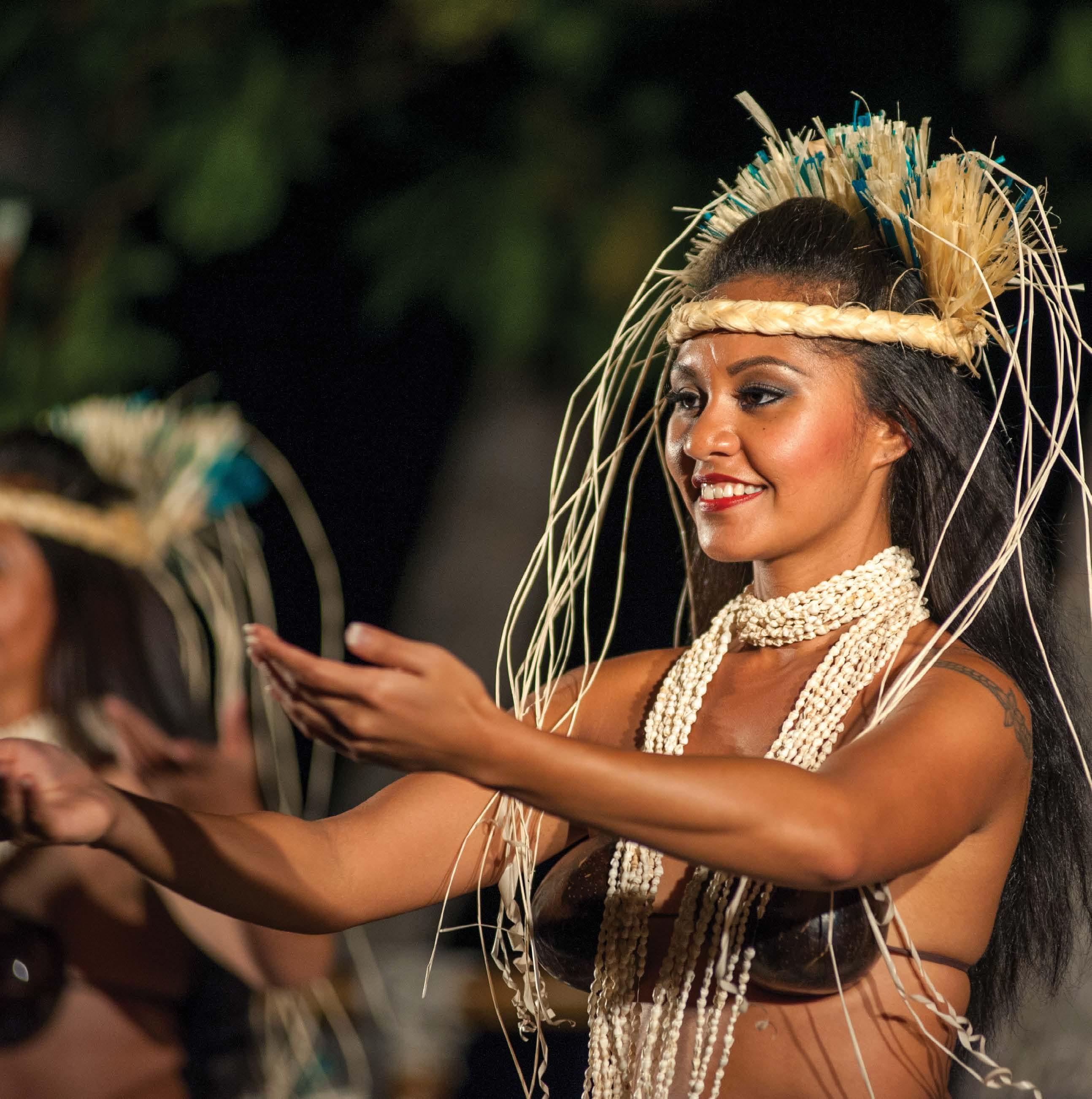


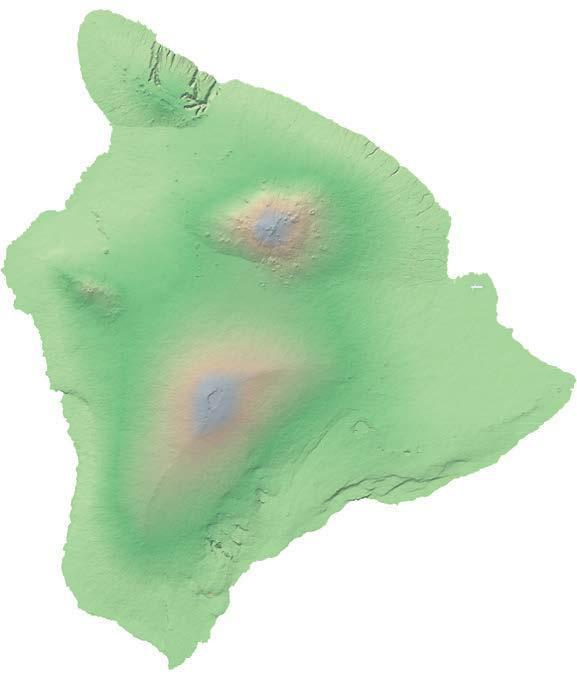


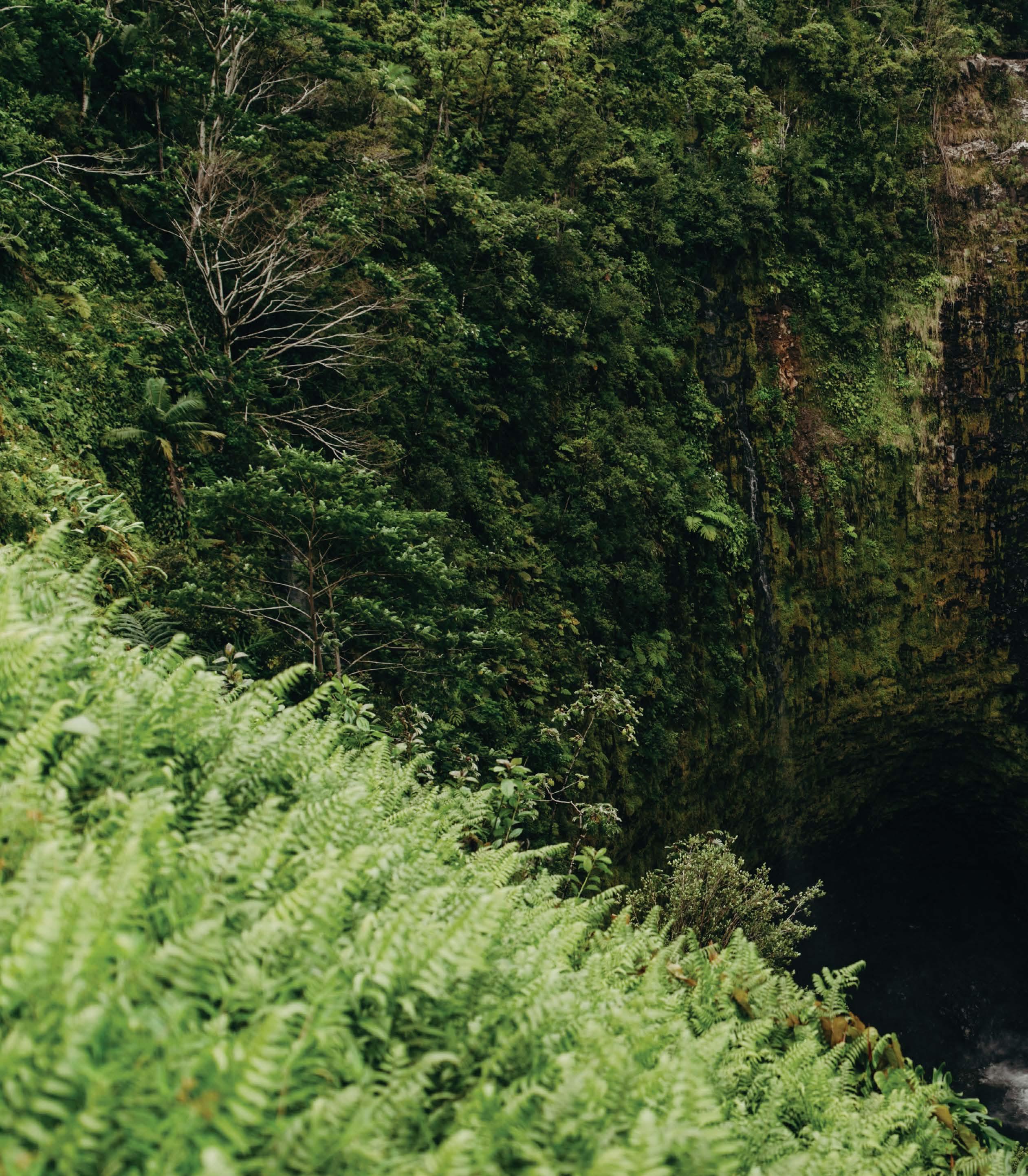
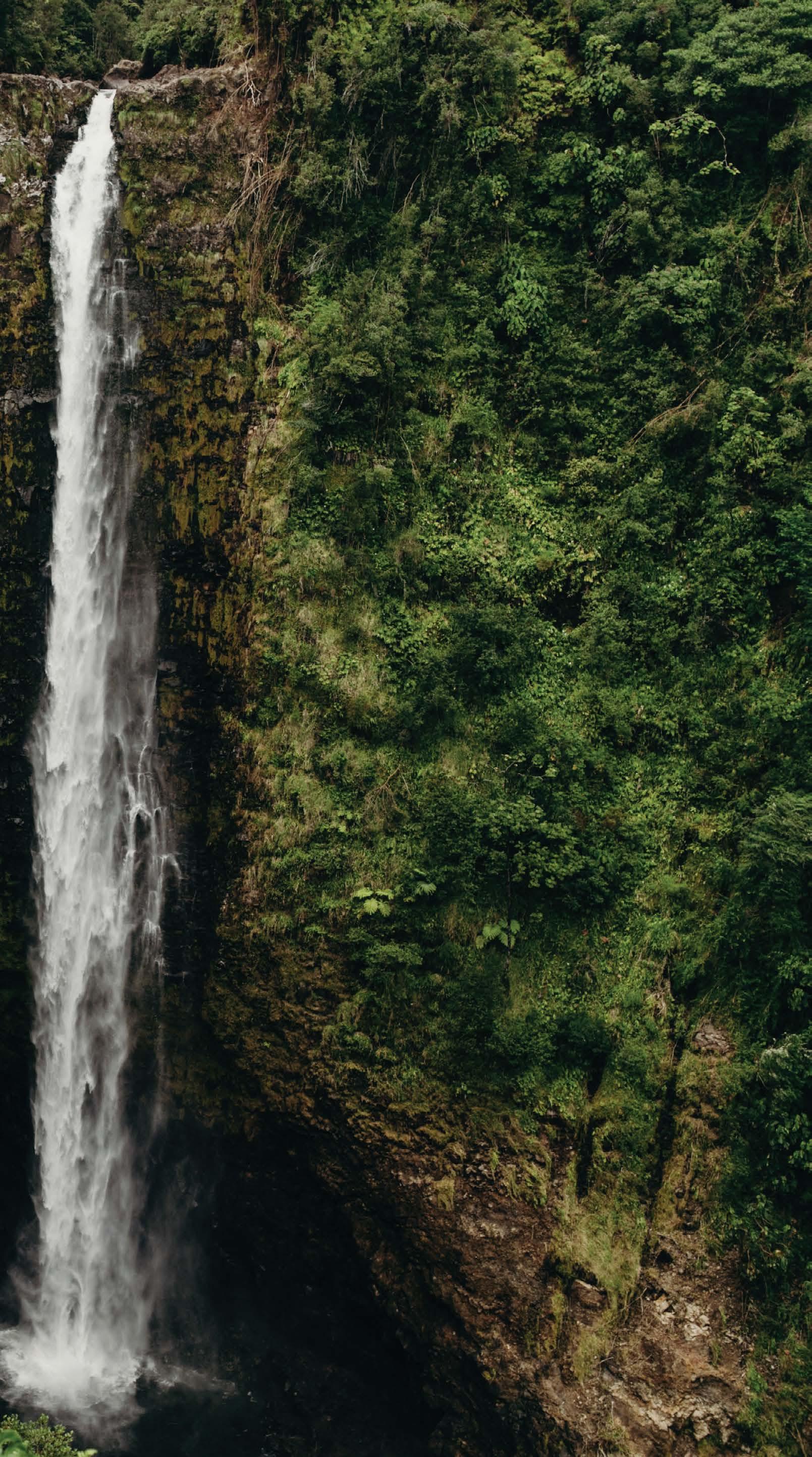
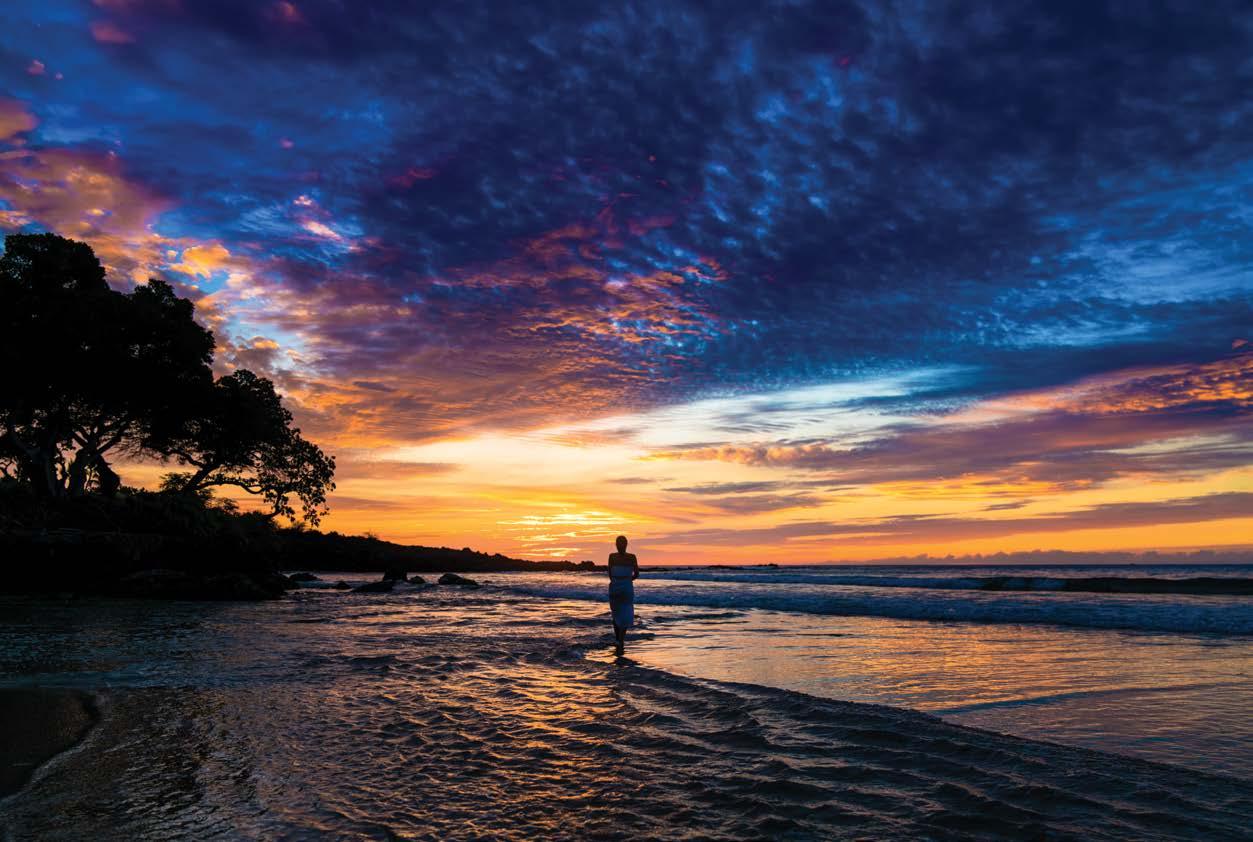
The largest among the Hawaiian Islands is also the most diverse, creating a setting you’ll treasure for a lifetime.
Explore the island of Hawai‘i by land, sea or sky, from its lush rainforests to seasonal snow-capped peaks. Kīlauea, the planet’s most active volcano, shapes the land and creates new landmass regularly. The island’s rich cultural heritage adds to its vibrant tapestry, making it a must-visit destination for nature lovers and cultural enthusiasts alike.
12 things you really need to know about the island of Hawai‘i
1
We’re still growing.
The largest and youngest of the eight main Hawaiian Islands, the island of Hawai‘i is also home to Kīlauea volcano, one of the world’s most active volcanoes. The 2018 eruption added over 800 acres of new land and covered over 13 square miles of existing land under new rock.
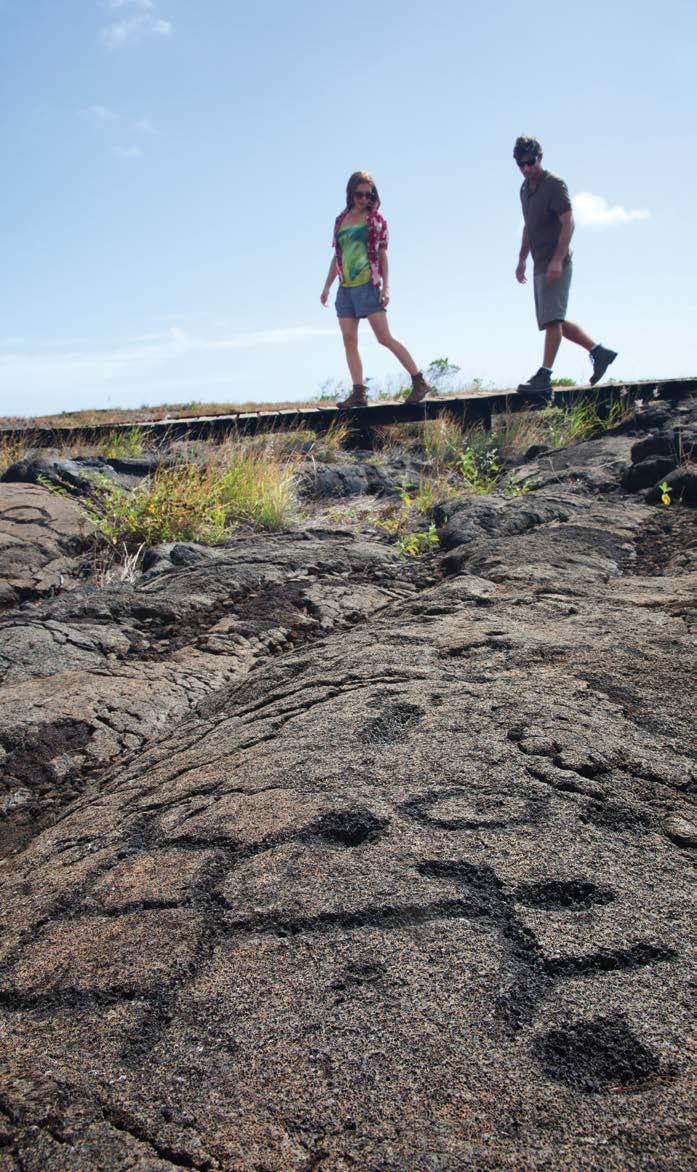

2 We’ve got all but four of the world’s climate subzones.
Studies by climatologists using the original Köppen Climate Classification System, often applied for identifying and defining global climate zones, determine that the island of Hawai‘i boasts everything from humid tropical and arid desert climates to temperate and ice climates.
3 The history of the Hawaiian Islands began here.
The island of Hawai‘i is believed to be the first of the main Hawaiian Islands discovered and settled by Polynesians, possibly as far back as the fifth century. Island-born King Kamehameha the Great created the Kingdom of Hawai‘i by unifying the entire island chain under his rule in 1810 after years-long battles of succession, initially basing the capital of the islands in Kailua-Kona.
4 We’ve got more land for more outdoor adventuring.
With 4,028 square miles of land encompassing everything from sandy beaches, windswept seashores and warm lava deserts to occasionally snowy alpine summits and lush rainforests and valleys, the island of Hawai‘i offers myriad outdoor adventures — hiking, snorkeling, sailing, biking, road-tripping, ziplining, horseback riding and stargazing.
5
Four of our five National Park Service (NPS) parks, sites and trails focus exclusively on Hawaiian culture.
Everyone knows about Hawai‘i Volcanoes National Park and its wonders of nature, science and Hawaiian culture. But did you know Hawaiian history and culture provide the main narrative drive of NPS sites
Pu‘uhonua o Hōnaunau National Historical
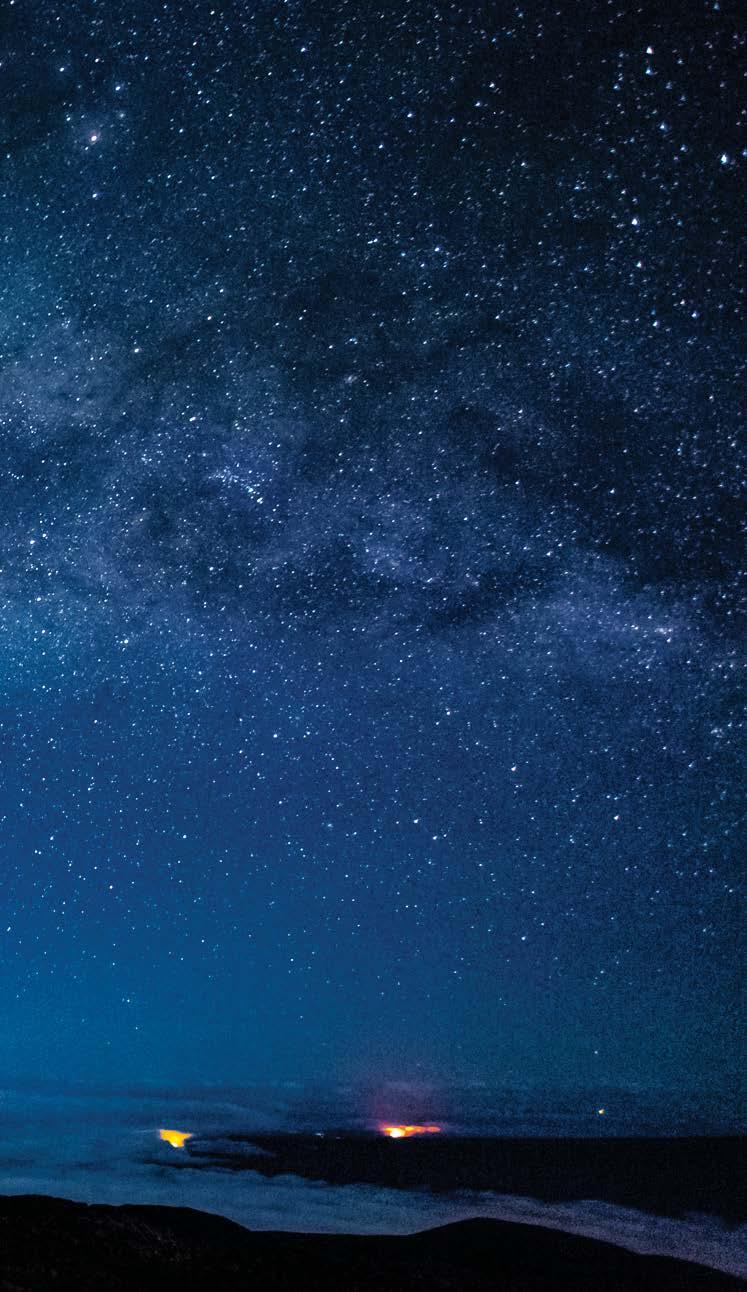
Park, Pu‘ukoholā Heiau National Historic Site, Kaloko-Honokōhau National Historical Park and the Ala Kahakai National Historic Trail? All five are must-visits.
6
We’re one of the best places on Earth for stargazing, with or without a telescope.
Several permitted tour operators offer access to the summit of Maunakea at night, followed by stargazing from the Maunakea Visitor Information Station. The island’s location at 19.5 degrees north latitude offers dazzling views of the entirety of Northern Hemisphere skies and 90 percent of the Southern Hemisphere’s. Sea-level options include ‘Imiloa Astronomy Center in Hilo, which shares the connection of Maunakea, astronomy and the traditional art of wayfinding. On certain nights, enjoy seaside stargazing on the Kohala Coast.
7
We make sure our marine life has lots of room to thrive.
With 266 miles of coastline, it’s no surprise that the island of Hawai‘i has the most marine conservation districts of all the Hawaiian Islands. That’s wonderful for the honu (Hawaiian green sea turtles), manta rays, dolphins and multitudes of colorful reef fish and marine life that thrive in our protected waters — an undersea nirvana for snorkel and scuba aficionados.
8
We’re home to the most prestigious hula competition in the world.
Held each year in Hilo, starting on Easter Sunday, the weeklong Merrie Monarch Festival’s three biggest nights are its signature hula competitions. Participation is by invitation, meaning only the best hālau hula (hula schools) from Hawai‘i and beyond compete. For nonticket holders, the fest also has craft fairs, a parade through Hilo and hula exhibitions.
9 We’ve got more oceanfront golf holes than any island in the Pacific.
It’s true — we dare you not to be at least a little bit distracted by all of the sublime natural scenery surrounding the island’s sumptuous greens. Enjoy views of Maunakea, Maunaloa, Hualālai and Kohala volcanoes. Fairways set like emerald oases amidst obsidian lava fields or set apart by churning seaside coves. Sightsee while you tee off.
10 If it can be grown or ranched, chances are good we’re growing and ranching it.
Coffee. Papaya. Mushrooms. Bananas. Strawberries. Cacao. Tea. Grass-fed beef and lamb. Honey. Herbs. Lettuces. And that’s just
for starters. With a diversity of climates and landscapes available to them, the island’s farmers and ranchers produce an ample bounty for supermarket shelves, farmers markets and an ever-growing number of farm-to-table restaurant menus and food hubs. Several farms offer tours — tea, coffee, flowers, macadamia nuts, sea salt, vanilla, spices, fruits and more!
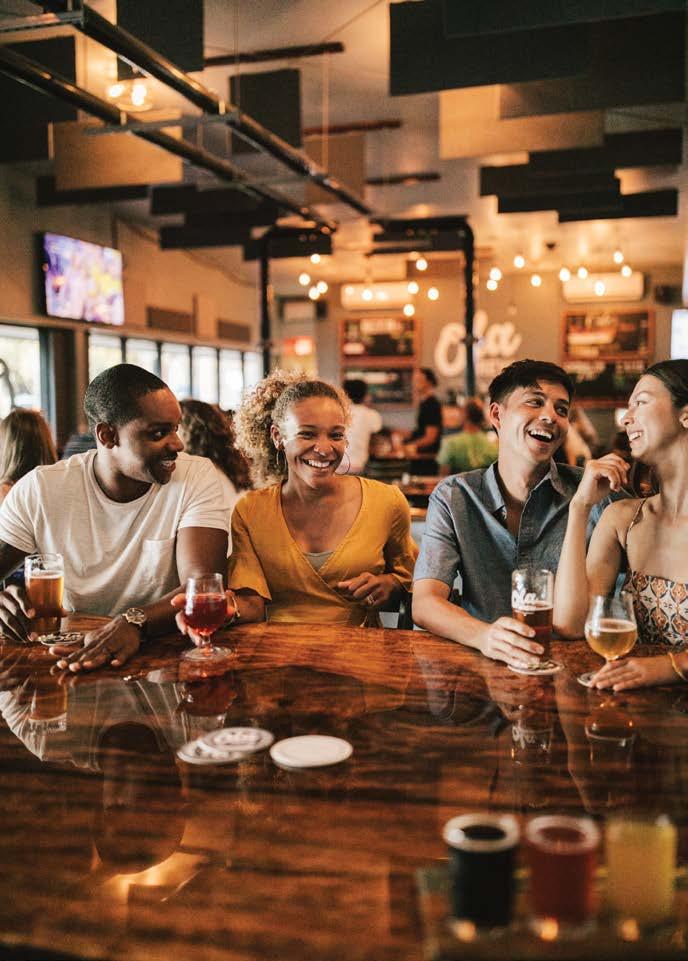
11 We expand the definition of nightlife.
Nightclubbing is for amateurs. On the island of Hawai‘i, our nightlife includes stargazing from the cloud-free elevations of Maunakea with one of several permitted tour operators or from the comfort of several Kohala Coast resorts. The magic of snorkeling alongside the most graceful manta rays, or scuba diving with pelagic fish. Or the enthralling opportunity to witness creation during a volcanic eruption.
12
We are the island of Hawai‘i.
Each of the islands has a Hawaiian name and ours is Hawai‘i.
Aia ka wai i ka maka o ka ‘ōpua. (Water in the face of billowy clouds.)
In Kona, when the cloud banks appear in the morning, it’s a sign that rain is to be expected. ‘Ōlelo No‘eau #55
With pristine waters for everything from snorkeling and kayaking to catamaran and submarine tours, along with its great resorts, you’ll love every minute you spend in Kona.
National Historical Park
One of five National Parks on the island of Hawai‘i, Pu‘uhonua o Hōnaunau is also referred to as the Place of Refuge. In old Hawai‘i, the punishment for breaking the law was death. The offender’s only chance for survival was to elude the pursuers and reach the nearest pu‘uhonua (place of refuge). A


965-foot-long masonry “great wall” surrounds the pu‘uhonua. The park is also home to other significant sites like the 1871 Trail, an abandoned farming and fishing village, three hōlua (sled courses) and Hale o Keawe, a structure surrounded by many ki‘i (carved wooden images) that houses the bones of great chiefs. Pu‘uhonua o Hōnaunau is an area of great mana (spiritual power), peace and forgiveness. Though this is an outdoor National Historical Park, we ask that you visit with the same respect and reverence you would bring to a sanctuary or burial site.
The island of Hawai‘i is home to 266 miles of coastline, with the most marine life conservation districts in the state. In 1969, Kealakekua Bay was designated as such because of its abundant, diverse marine life, including corals and fish. Additionally, the 180 acres surrounding the bay were designated a historical park in 1967 and added to the National Register of Historic Places in 1971. Kealakekua Bay is the largest sheltered natural bay on the island. To further protect this conservation district, only vessels with valid permits are allowed into the bay.
Ali‘i Drive is a picturesque stretch along the coast renowned for its historical significance, including sites like Ahu‘ena Heiau, a reconstructed temple and final home of King Kamehameha I, and Hulihe‘e Palace, one of three royal palaces in Hawai‘i. Lined with iconic coffee shops, art galleries, eateries and more, it’s also known for its vibrant atmosphere. Historic Kailua Village is home to several signature events, including the Queen Lili‘uokalani Long Distance Canoe Race (September) and the IRONMAN® World Championship (October). It’s a great place to enjoy the iconic sunset, listen to live local music, delight in decadent pūpū (appetizers) and then succumb to the star-filled sky.
During your visit, stop by Moku‘aikaua Church, the island’s first Christian church and a landmark on Ali‘i Drive. Moku‘aikaua was added to the National Register of Historic Places in 1978.
Located in the heart of Historic Kailua Village, the former summer vacation home of the Hawaiian monarchs is now an oceanfront museum filled with artifacts, beautiful koa wood furniture and the spirit of days gone by. The original construction of the residence was completed in 1838, and it was remodeled decades later during the time of King Kalākaua. Hulihe‘e was added to the National Register of Historic Sites in 1973.

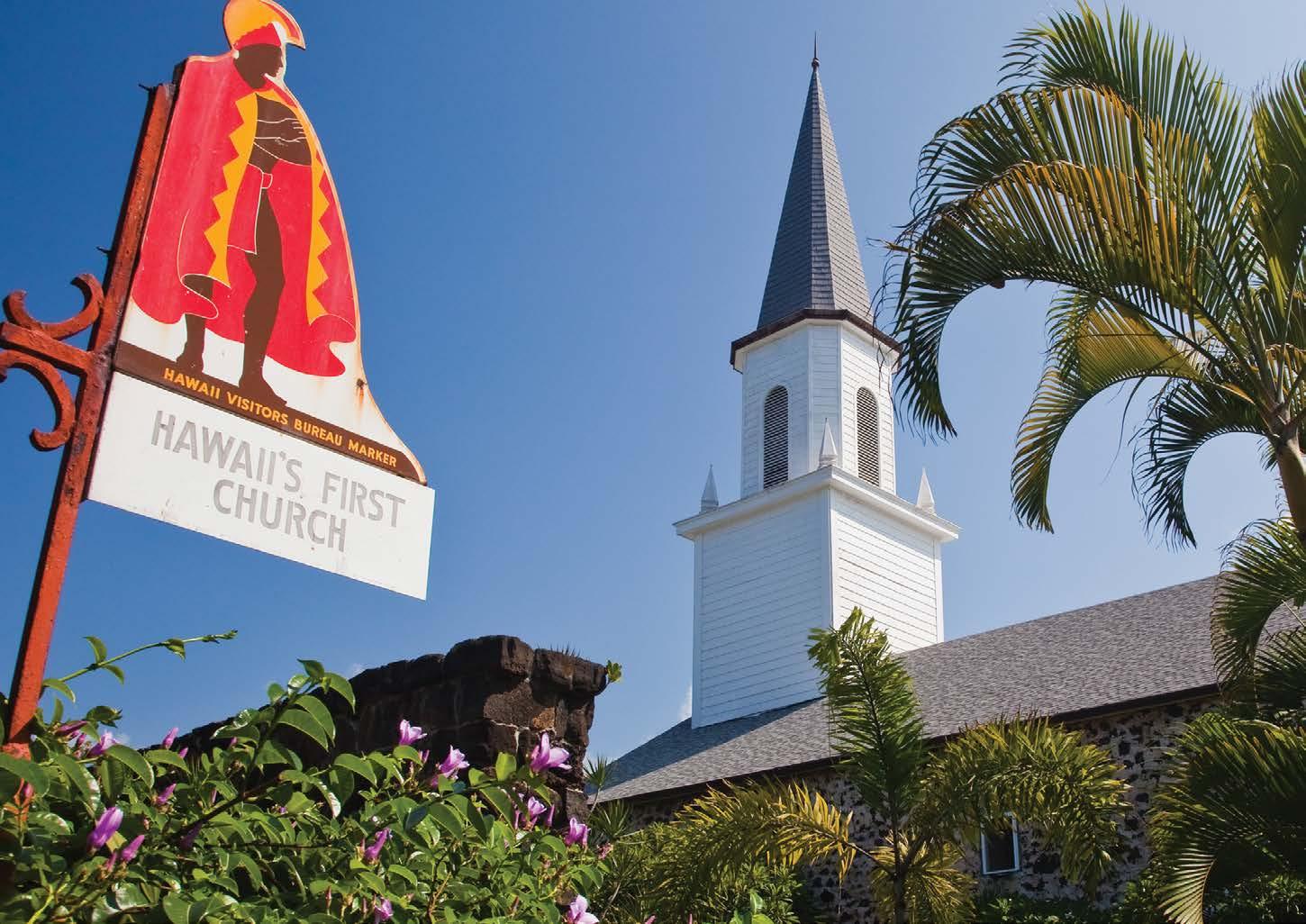
Nearby, just south of the Ellison Onizuka Kona International Airport at Keāhole (KOA), is the Natural Energy Laboratory of Hawai‘i Authority (NELHA). Here, deep, cold ocean water is pumped from 2,000 to 3,000 feet below the ocean’s surface. Tour businesses that take advantage of this technology — Kona Salt Farm, Big Island Abalone, Oceanrider Seahorse Farm and more.
Explore this coastal park and discover how an early Hawaiian settlement survived on the rugged Kona coast. Hike through four different ahupua‘a (traditional mountain-to-sea land divisions), see heiau (sacred temples) and ki‘i pōhaku (petroglyphs). The park is also home to two Hawaiian fishponds that show the engineering acuity of Native Hawaiians.
Stop by the former agricultural center of Hōlualoa, which is now a gathering place for artists inspired by the area’s charm. Visit this small town and check out exhibits and events at the Donkey Mill Art Center and stop at galleries and shops while strolling the town’s main street.

Kaloko-Honokōhau National Historical Park
ELLISON ONIZUKA KONA INT'L AIRPORT(KOA) Police
Maka‘eo — Old Kona Airpor t State Recreation Area
Keauhou Shopping Center
Hwy)
To Kohala Coast, North Kohala, Waimea To Waimea, Hilo
Makalei Golf Club
Kaloko Dr
Kealakehe Pkwy
KEA L AK E HE
Keawekāheka Pt.
Kealakekua Bay State Historical Park
Pu‘uhonua o Hōnaunau National Historical Park
ueen
Pt.
Kona Countr y Club
To Ka‘ū, Volcano, Hilo

A legendary Kona Resort reborn Perched on lava rock cli s, OUTRIGGER Kona Resort & Spa embodies the awe-inspiring beauty of the Pacific Ocean. Signature Experiences deem an unforgettable stay from the award-winning Feast & Fire Lu¯‘au to the majesty of the manta ray swim and immersive rich cultural tour. All capturing the true essence of Hawai‘i.





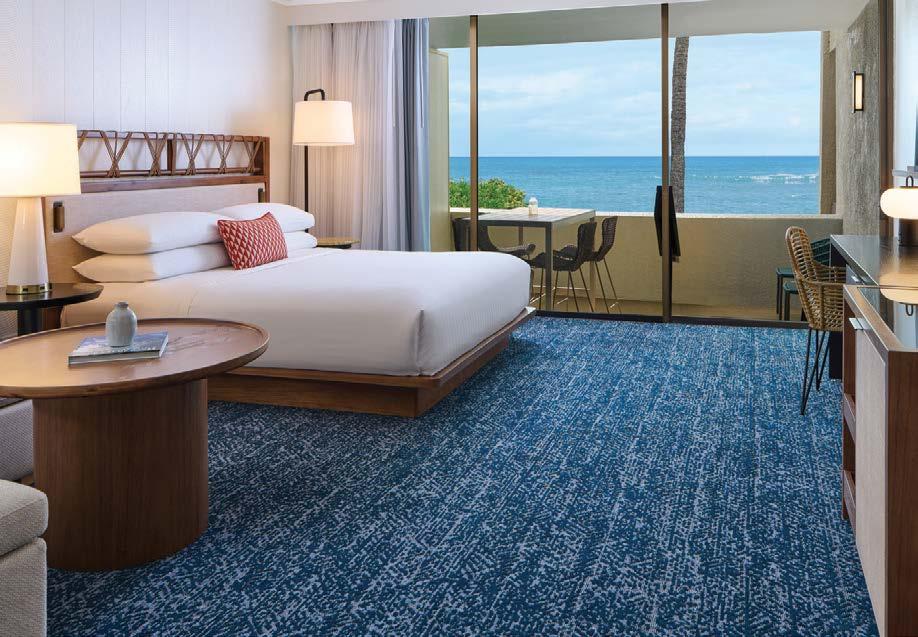

Coffee in Hawai‘i dates back to 1813, when Don Paulo Marin, a Spanish physician, planted the first trees in an area behind Honolulu, O‘ahu. Those first plantings did not survive. In 1825–1826, John Wilkinson, named agriculturalist by Kamehameha II and O‘ahu’s High Chief Boki, planted a small field on Boki’s land in Mānoa on O‘ahu. In 1828, Rev. Samuel Ruggles brought cuttings from Mānoa to Nāpo‘opo‘o in South Kona. In 1841, coffee plantations were established in the Kona District. In 1892, Herman Widemann introduced a bean from Guatemala that became known as Kona Coffee. Today, there are about 650 coffee farms in the Kona District. The average farm is about three acres. Kona Coffee represents about 95% of the coffee produced on Hawai‘i Island, with other districts like Ka‘ū, Hāmākua, Hilo and Puna also actively farming coffee. The Kona Coffee Cultural Festival honors Kona coffee pioneers and their traditions. Held in November, it is Hawai‘i’s oldest food festival.


Kohala, the northernmost district on the island of Hawai‘i, welcomes visitors with its warm embrace of rich cultural heritage, particularly as the birthplace and ancestral home of King Kamehameha I. It’s renowned for sacred temple sites, cultural connections, paniolo (cowboy) vibe, artists galleries and resort communities.
Pua ka lehua. (The lehua is in bloom.)
Said by the people of Kawaihae when the aku (bonito/skipjack) fish appear in schools. It was (is) considered unlucky to speak openly of going fishing. ‘Ōlelo No‘eau #2695
Nestled next to the expansive white sand of ‘Anaeho‘omalu Bay are two ancient Hawaiian fishponds that offer a glimpse into the islands’ rich aquacultural heritage. These fishponds, Ku‘uali‘i and Kahapapa, were meticulously constructed by early Hawaiians to raise and farm juvenile fish until they were ready for harvest, a sustainable practice that continues to this day. The bay itself is a popular destination for water sports enthusiasts, who come to enjoy activities like kayaking, snorkeling, swimming, sunbathing and more amid its picturesque natural setting.
The Puakō Petroglyph Archaeological Preserve is a 223-acre site that boasts over 3,000 ancient petroglyphs, or ki‘i pōhaku — intricate carvings etched into lava rock that date back to around 1200 AD. While the true meaning behind these enigmatic artworks remains a mystery, experts believe the
petroglyphs likely served as records of births, deaths and other important events in the lives of Hawai‘i’s early inhabitants.
Hāpuna Beach is one of Hawai‘i’s best natural white sand beaches. It’s a popular destination for sunbathers, swimmers, snorkelers and picnickers. Hāpuna is a well-maintained beach park with great swimming opportunities when the seas are calm. However, please be aware that dangerous rip currents and powerful shore breaks can occur during high surf conditions. Always check with the lifeguard before going in the water. Entrance and parking fees apply for visitors.
A great kahuna (priest) advised King Kamehameha I to have a heiau (temple) constructed and dedicated to the war god Kū at Pu‘ukoholā to aid in the fulfillment of
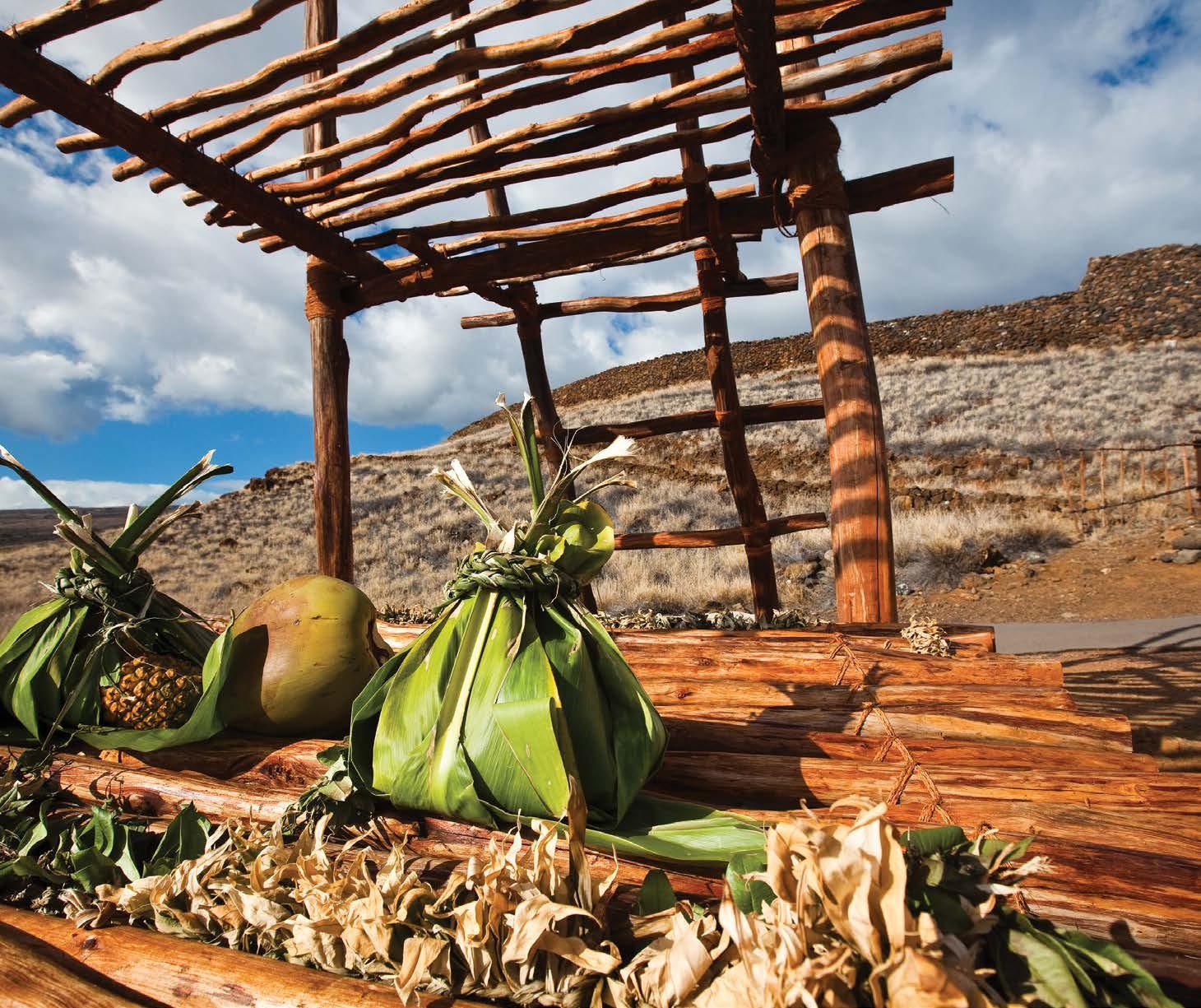
the prophecy that the King would unify all the islands. The construction of Pu‘ukoholā occurred around 1790. Heiau took on many forms — from simple stone markers used as fishing shrines to massive stone platforms. These large heiau (like Pu‘ukoholā) could only be accessed by priests and those of chiefly
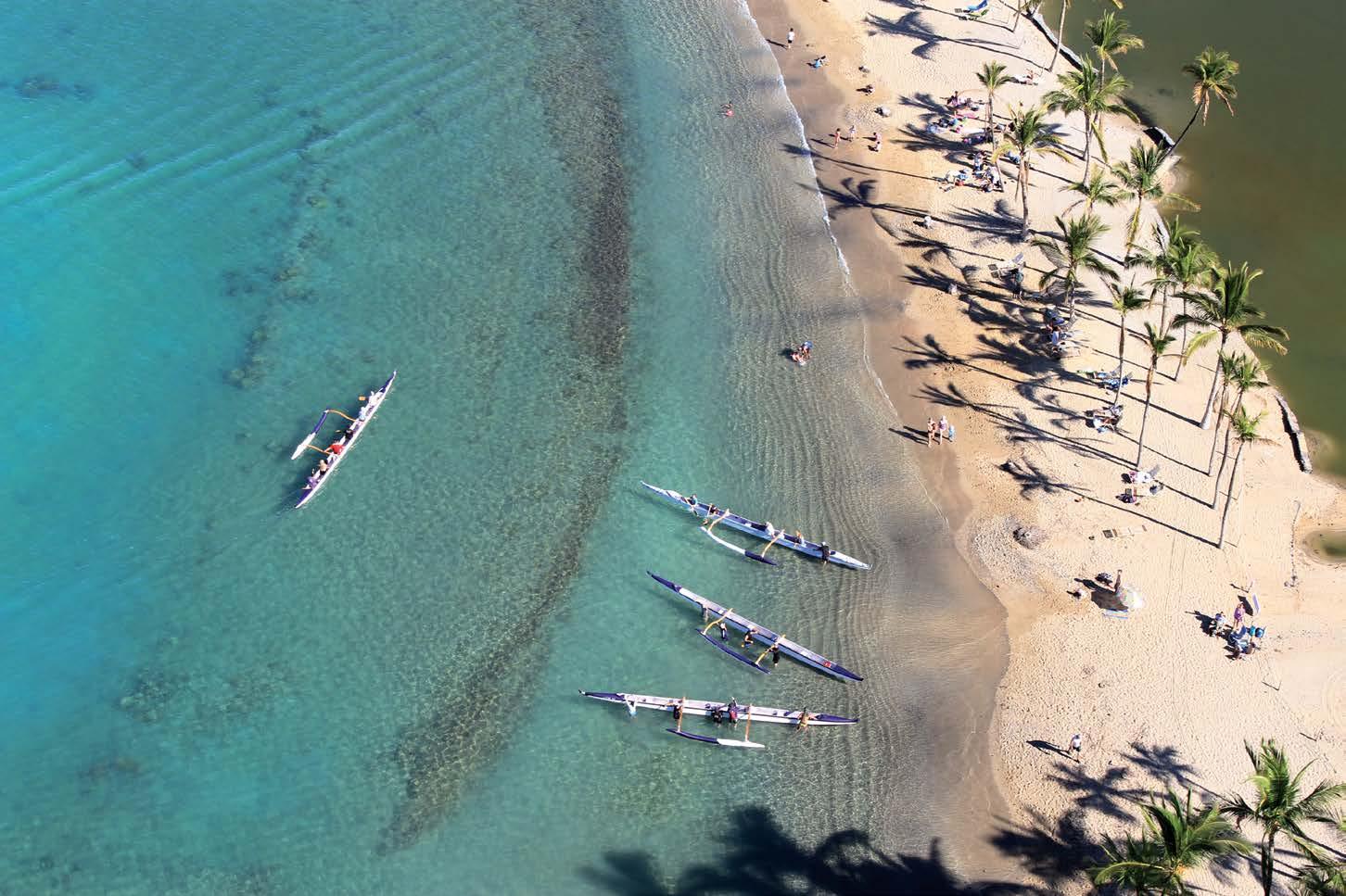
class. This massive stone heiau is believed to be one of the last structures built before western influence. It is also one of the larger, more carefully preserved temples on the island.
Directly below Pu’ukoholā Heiau stands Mailekini Heiau. During the reign of Kamehameha I, this temple was converted into a fort, an influence of his exposure to European military strategy and Western weapons. Mailekini Heiau symbolizes a time of great change in Hawai’i.
Situated below the park’s temples is the Royal Courtyard, Pelekane, which was once the site of many important events. Today, Pelekane hosts the annual cultural festival at Pu’ukoholā.
The offshore area known as Hale o Kapuni is believed to be the submerged ruins of another temple, one that was dedicated to the shark gods according to local lore. While these ruins are no longer visible, you may still catch a glimpse of the sharks that inhabit the area.
Lele ‘o Kohala me he lupe lā. (Kohala soars as a kite.)
An expression of adoration for Kohala, a district that has often been a leader in doing good works. ‘Ōlelo No‘eau #1988
Revered as the birthplace of King Kamehameha I, North Kohala is home to a collection of quaint shops and galleries, limitless natural beauty, sacred heiau (temples) and remnants of old fishing villages.
A self-guided tour through partially restored remains of this ancient coastal settlement will give you a glimpse of early life. As you walk through the area, you’ll encounter plants that thrive near the shore, providing a food source, building materials, medicines and utensils. Try your skills at one of a few games like ‘ulu maika (stone discrolling) and kōnane (a checkers-like game of strategy). Visit house sites, hālau wa‘a (canoe longhouses) and more.

If you’re visiting in October, this is where you can find the bicycle turnaround for the IRONMAN® World Championship. Yearround, find charming boutiques, restaurants, coffee shops and art galleries featuring works from local artists.
In the small town of Kapa‘au stands the original King Kamehameha I statue, forged in Florence, Italy, in 1880 and erected near his birthplace. Ancient prophecy foretold of his birth and destiny as a great warrior, diplomat and leader. After the ship that was ferrying
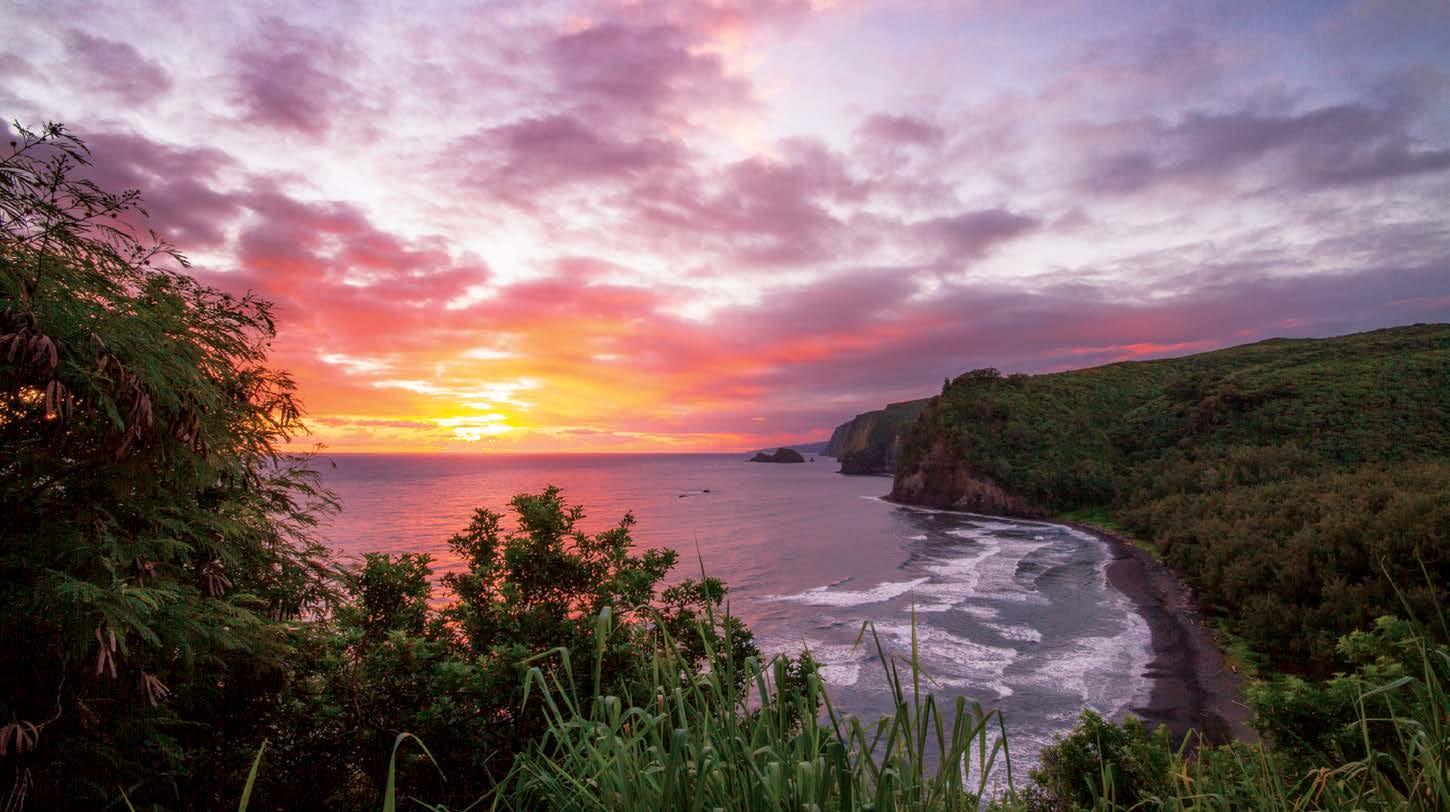
the statue sank off the Falkland Islands, a replacement statue was commissioned and erected in Downtown Honolulu. The original statue was found in 1912, restored and installed in Kapa‘au. On the way to Pololū Valley, look for this majestic tribute to the Kingdom of Hawai‘i’s first monarch, who united the Hawaiian Islands under one royal kingdom by 1810.
Pololū Valley, an awe-inspiring landscape carved into the Kohala volcano and traversed by the Pololū stream, marks the end of Highway 270. Before European colonization, the valley was renowned for its thriving kalo (taro) farming, including a cultivar named after it. In the 1800s, rice farming also flourished in this wahi pana (storied, special and sacred place). Today, the valley remains deeply connected to the Kohala community, with many descendants of the original inhabitants now practicing their kuleana (responsibility) as stewards. They share the valley’s rich history, culture and profound sense of place with visitors, instilling a deep appreciation for this remarkable landscape. In 2021, KUPU Hawai‘i, Nā Ala Hele Trails and the area’s lineal descendants created the Pololū Valley Stewardship program to mālama ku‘u home — to manage, educate and share it with visitors and residents. When visiting Pololū Valley, please respect this special place.
KTA Super Stores is Hawai‘i Island’s one-stop grocery store, offering local favorites from fresh poke and produce to convenient grab ‘n go bento, omiyage, and more! Explore our exclusive Mountain Apple Brand products, proudly made right here in Hawai‘i. Support local, buy local – since 1916!
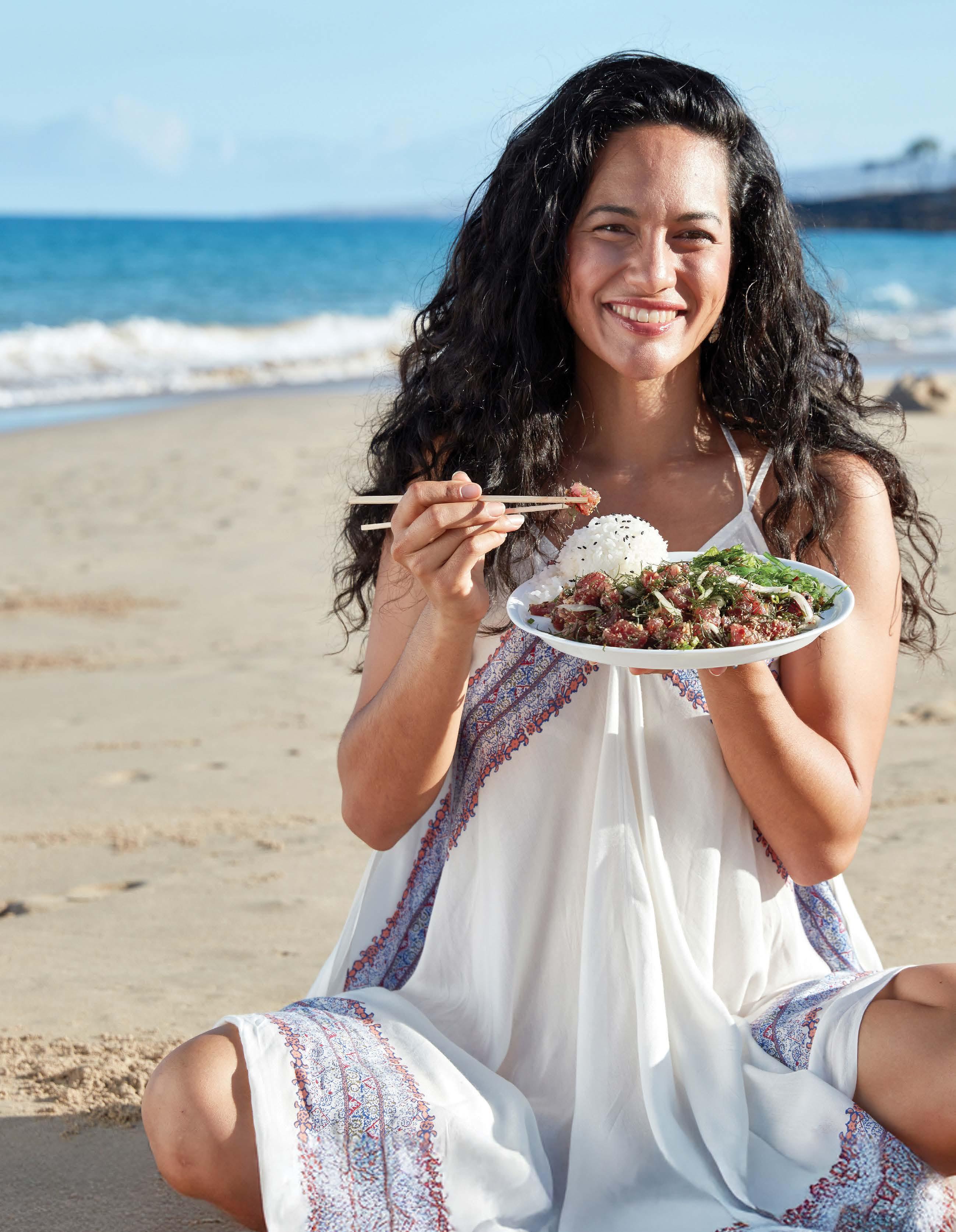
KTA PHARMACY, PONAHAWAI 670 Ponahawai Street, Suite 211 808-865-0505
KTA PUAINAKO, HILO 50 East Puainako Street 808-959-9111 KTA KAILUA-KONA 74-5594 Palani Road 808-329-1677

KTA KEAUHOU 78-6831 Ali‘i Drive 808-322-2311
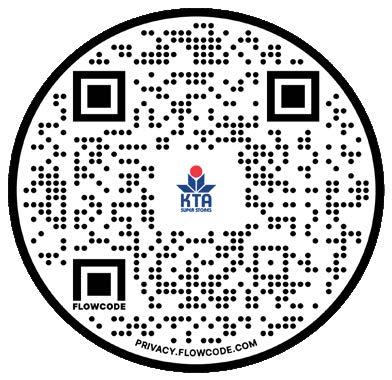
Waimea, i ka ua Kīpu‘upu‘u.
(Waimea, land of the Kīpu‘upu‘u rain.)
Waimea is famed in mele of old for its cold chilling rain. ‘Ōlelo No‘eau #2913
Waimea was once home to Kamehameha I’s fastest and fiercest warriors, trained in traditional Hawaiian martial arts and appropriately named after the Kīpu‘upu‘u rain of the area. Waimea is also headquarters of Parker Ranch, which was established in 1847 and still retains a lot of its paniolo (cowboy) culture and pride.
Home of the late Anna Lindsey Perry-Fiske, the “First Lady of Ranching” in Hawai‘i. A treasure trove of historical items including a collection of records, photographs, artifacts and household items offer a historical account of the renowned Lindsey family.


There are several markets held in Waimea town on Saturday, as well as one on Wednesday. Enjoy the freshest in fruits, vegetables, flowers and so much more. These lively markets also feature locally made crafts, baked goods and specialty products, offering a wonderful opportunity to support local farmers and artisans while experiencing the flavors of Hawai‘i Island.
A variety of shops and art galleries are scattered throughout town. Visitors can explore charming stores filled with handcrafted island treasures, paniolo-inspired goods and locally made jewelry, as well as vibrant farmers markets showcasing fresh
produce and artisan crafts. The town’s art galleries highlight stunning works from Hawaiian and Polynesian artists, featuring everything from contemporary paintings to intricate wood carvings and glass sculptures. Whether searching for a special keepsake or an inspiring piece of art, Waimea provides an authentic and enriching shopping experience.
A peaceful, accessible nature park that cultivates lifelong stewardship of the ‘āina for the enrichment of the community and all who visit. The most ambitious project of the Waimea Outdoor Circle to date, this park serves as a living example
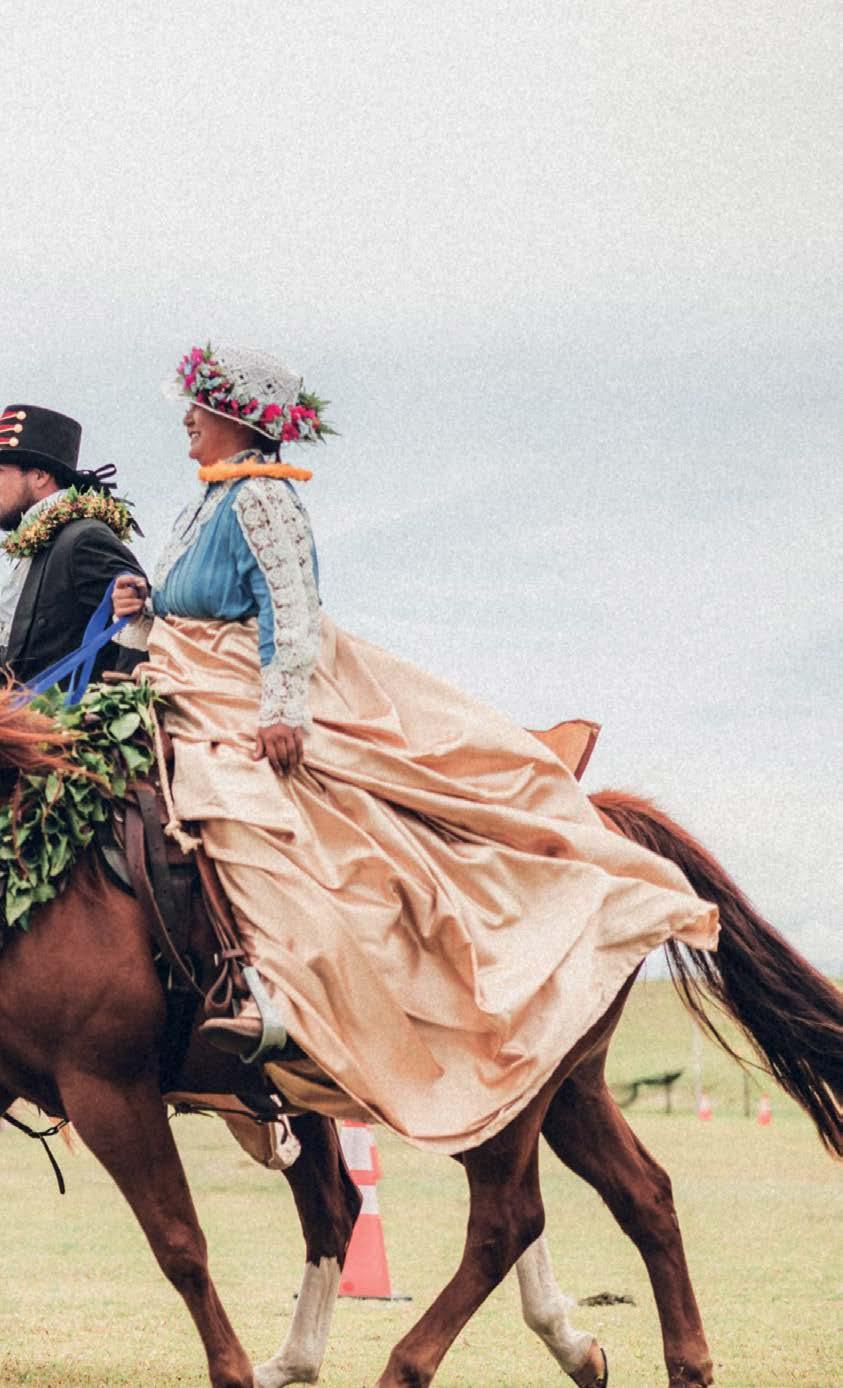
of conservation and education, inspiring future generations to cherish and protect Hawai‘i’s natural beauty.

Kawaihae Harbor & Pua Ka‘ilima Cultural Surf Park
‘Ōhai‘ula — Spencer Beach Park
Kauna‘oa Bay
Holoholokai Beach Park
KALĀHUIPUA‘A
Hāpuna Bay Honoka‘ope Bay
Puakō Bay
Petroglyph
Kīholo Bay
Bay
Hāmākua ‘āina pali loa (Hāmākua, land of the tall cliffs.)
Praise of Hāmākua. ‘Ōlelo No‘eau #438
The Hāmākua Coast is a stretch of towering green cliffs, hidden valleys and dramatic ocean views, where lush rainforests meet the rugged, untamed shoreline of Hawai‘i Island.
Take a road trip along the Hāmākua Heritage Corridor scenic drive and see the beauty of lush tropical rainforests, deep water-carved gulches, valleys thick with tropical foliage, cascading waterfalls and lovely seaside views pass by your car window. Stop at small, quaint towns like historic Honoka‘a for local specialty shops and boutiques. Don’t miss a visit to Kalōpā State Recreation Area, where you can explore peaceful hiking trails through a rare native Hawaiian forest.
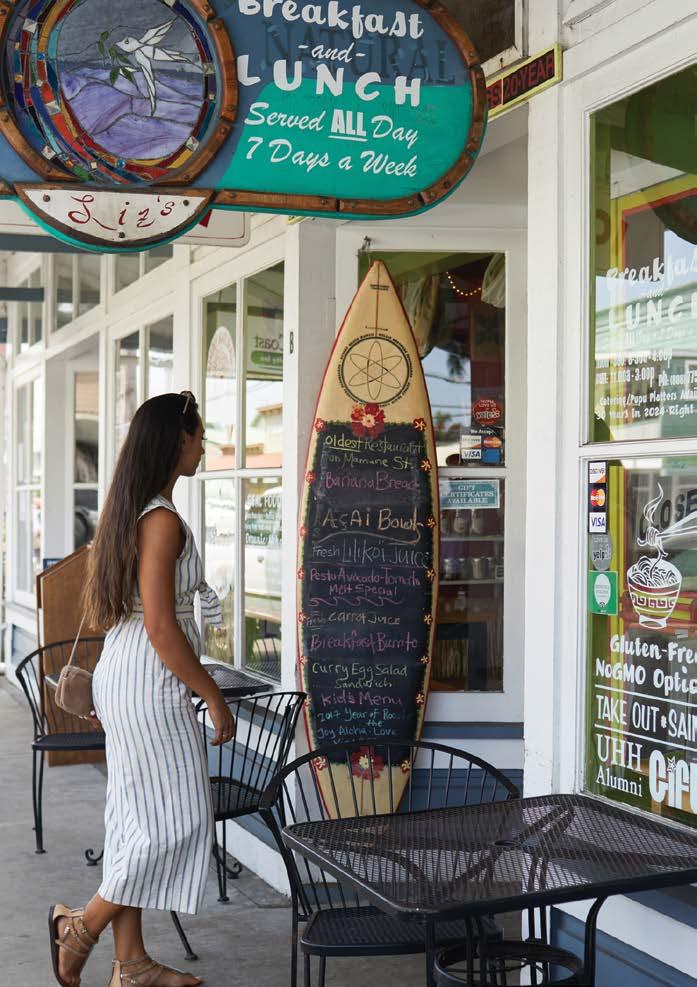
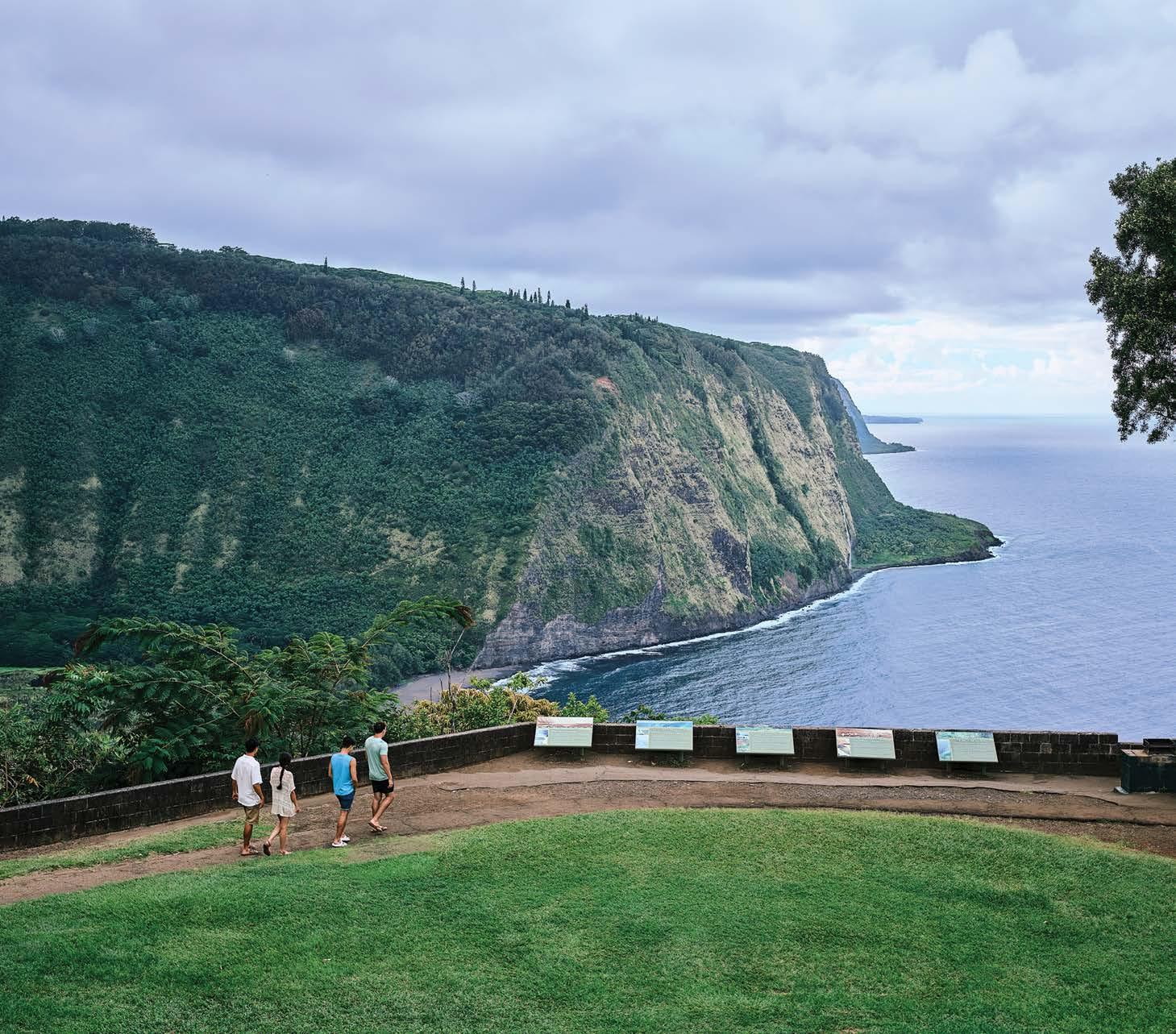
Once an important center for political and religious life and home to thousands of Native Hawaiians, Waipi‘o Valley is now home to less than a hundred residents who live and work amongst thriving fields of kalo (taro). Witness the majesty of this lush valley at the lookout at the end of Hāmākua Heritage Corridor Drive. From this vantage point, enjoy breathtaking panoramic views of towering cliffs, verdant landscapes and the black sand beach stretching along the valley floor.
A handful of local boutiques and restaurants, and the gateway to the scenic Waipi‘o Valley Lookout. Honoka‘a is home to Tex Drive In, famous for their delicious malasadas (Portugueseinspired pastry) and great local plate lunch options. This historic plantation town also hosts the annual Honoka‘a Western Week, celebrating its rich paniolo (cowboy) heritage with rodeos, parades and community events.
An easy family nature hike (0.7-mile loop trail) in a native ‘ōhi‘a forest at 2,000-foot elevation. The trail passes through an arboretum of the island’s native plants. Picnic areas and rustic cabins make it a great spot for a peaceful getaway.
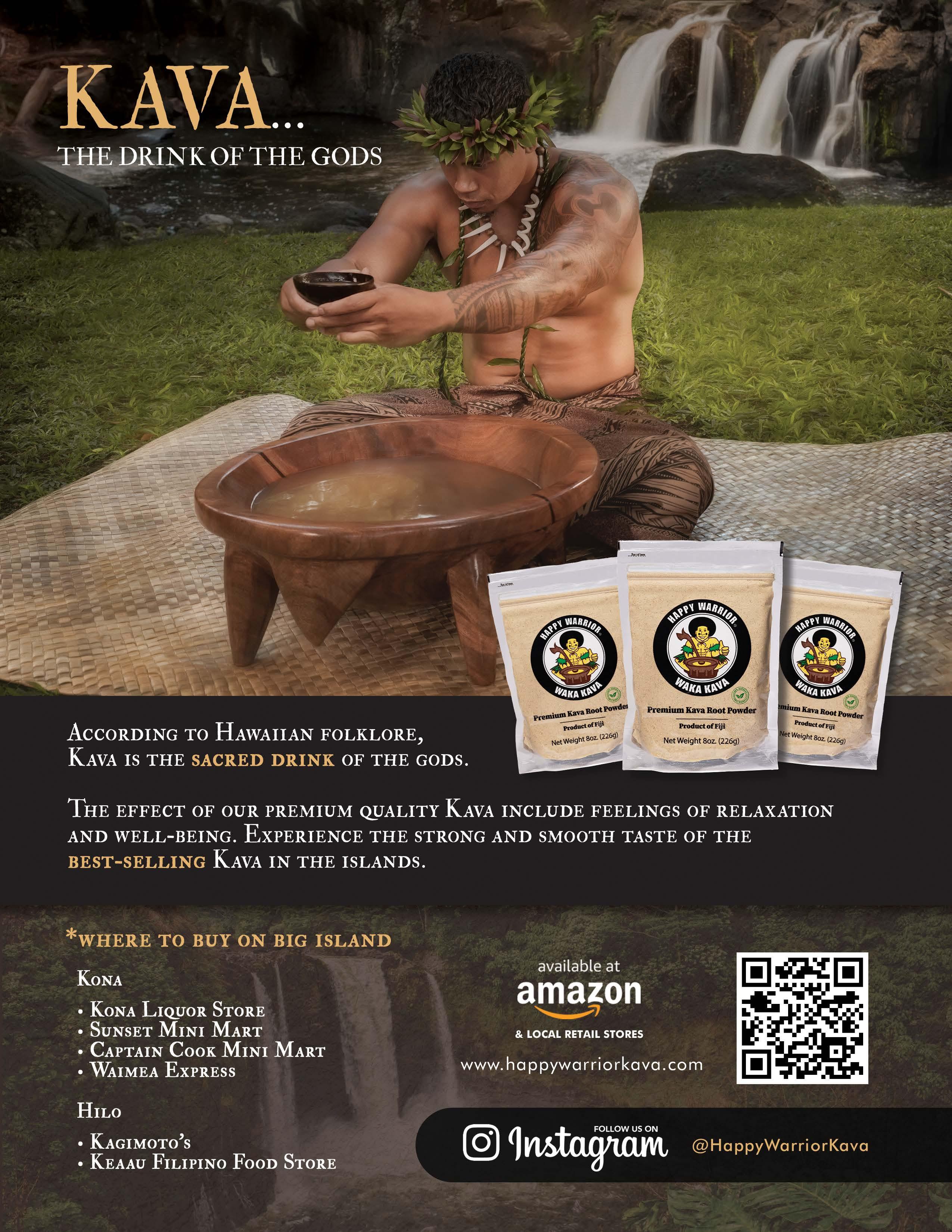

Hilo i ka ua Kanilehua (Hilo of the Kanilehua rains.)
The Kanilehua rain, the rain that patters in the lehua forest, is frequently referred to in chants and songs of Hilo. ‘Ōlelo No‘eau #1000
With cascading waterfalls, lush botanical gardens, towering banyan trees and a historic bayfront, Hilo is a district rich in natural beauty and old Hawai‘i charm.
This lookout offers a breathtaking view of the rugged coastline and crashing waves of Hawai‘i Island’s Hāmākua Coast to North Hilo coast. Perched above Laupāhoehoe Point, this spot provides a sweeping perspective of the dramatic lava rock shore, where powerful surf meets the deep blue Pacific. It’s a great place to stop, take in the scenery and learn about the area’s history, including the 1946 tsunami that reshaped this coastal community.
One leisurely hike, two magnificent waterfalls! At ‘Akaka Falls State Park, a pleasant 0.4-mile loop trail — with gentle inclines, downhill sections and some stairs — guides you through lush tropical scenery and breathtaking natural sights. The first waterfall along the paved path is the stunning Kahuna Falls, cascading 100 feet from the mountains. Next, the dramatic ‘Akaka Falls plunges 442 feet from towering cliffs, creating an unforgettable spectacle. ‘Akaka Falls is the tallest sheer-drop waterfall in Hawai‘i.
Downtown Hilo is rich in history, with cultural sites, museums and charming local businesses. Stroll past plantation-era storefronts, now home to boutiques, galleries and cafés overlooking scenic Hilo Bay. Visit the Pacific Tsunami Museum to learn about the town’s resilience or explore the Mokupāpapa Discovery Center to discover the marine life of the Northwestern Hawaiian Islands. With everything within walking distance, Downtown Hilo invites you to explore its vibrant heritage at a leisurely pace.
Open seven days a week, with “Big Market Days” on Wednesday and Saturday, this vibrant market features fresh flowers, locally grown produce, food vendors, coffee and specialty drinks, handmade bath and body products, crafts, art, photography, clothing and more. As one of the largest and most popular farmers markets in Hawai‘i, it offers a unique opportunity to support local farmers and artisans while experiencing the flavors and creativity of the islands.

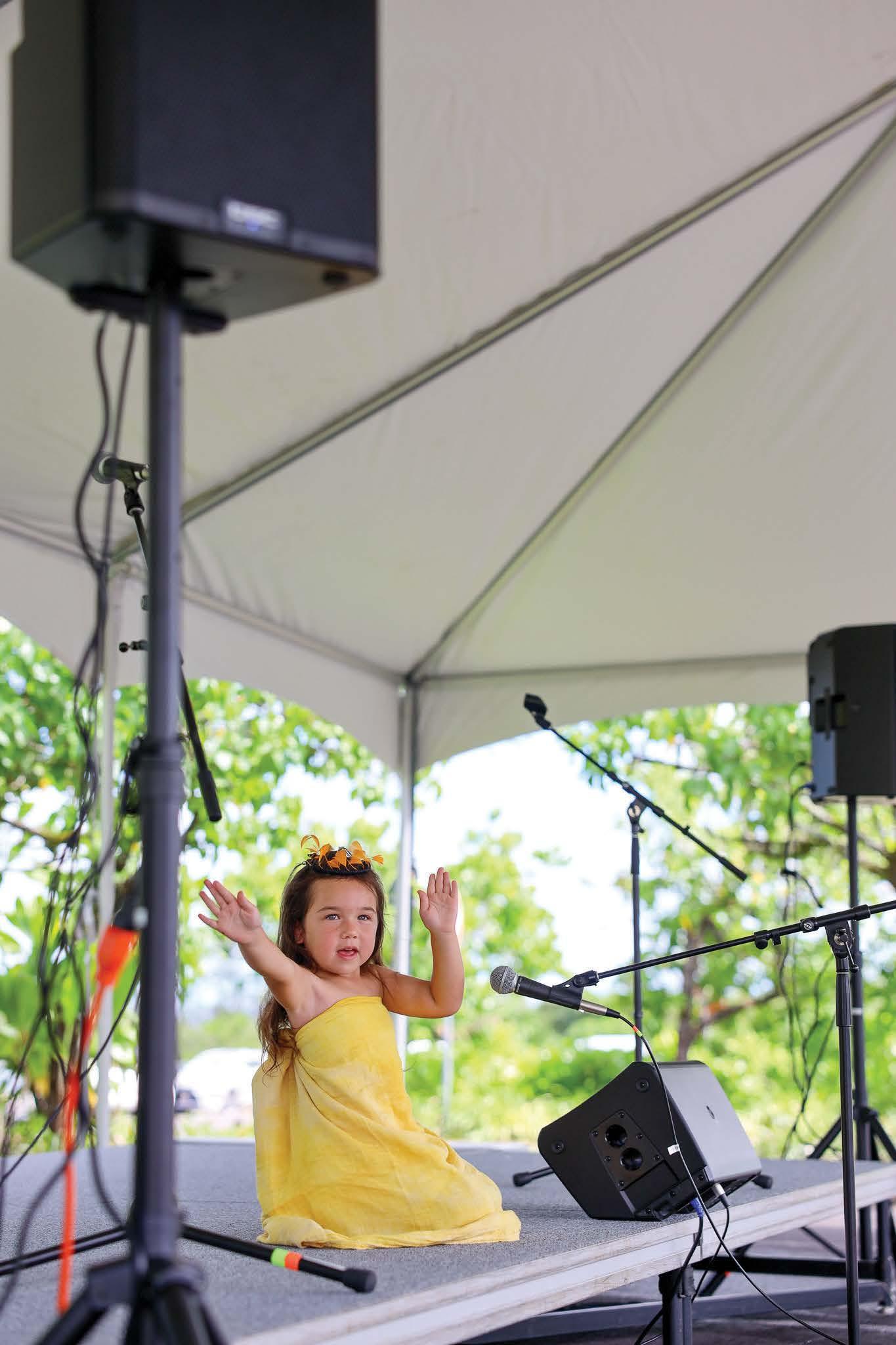


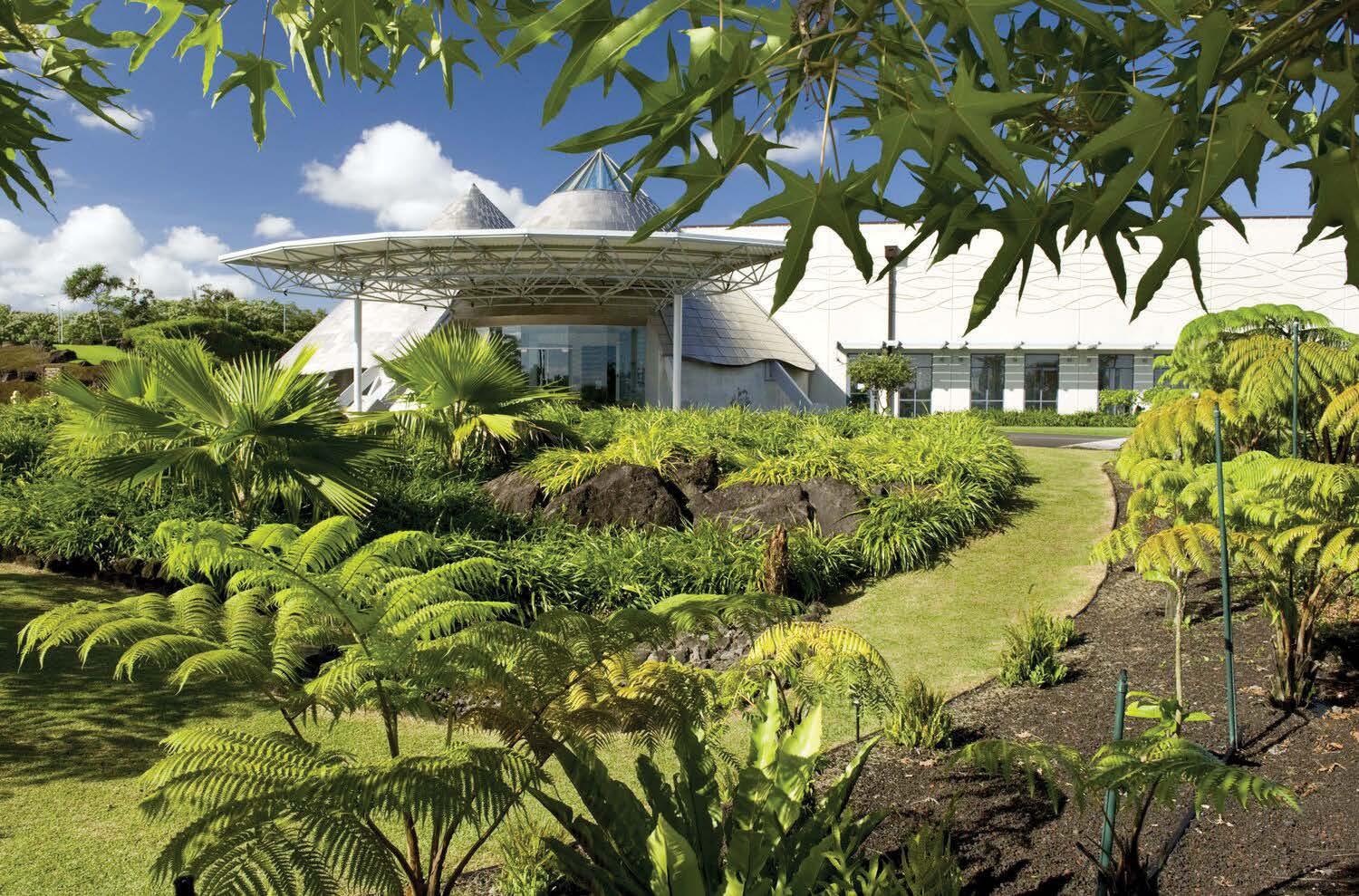


Wailuku River State Park — Waiānuenue (Rainbow Falls) and Pe‘epe‘e
Wailuku River State Park has two captivating lookout areas. The first showcases the famous 80-foot Waiānuenue, or Rainbow Falls, known for the vibrant rainbow that often appears in its mist. The second lookout area features Pe‘epe‘e, or the Boiling Pots — a series of pools connected by underground flows and cascades. The waters here roll and bubble as if boiling, giving this feature its fitting nickname.
The name “Wailuku” is derived from the Hawaiian words “wai” (fresh water) and “luku” (destruction or slaughter). While these natural wonders are truly mesmerizing, please enjoy them from the designated park areas only, as swimming is not permitted.
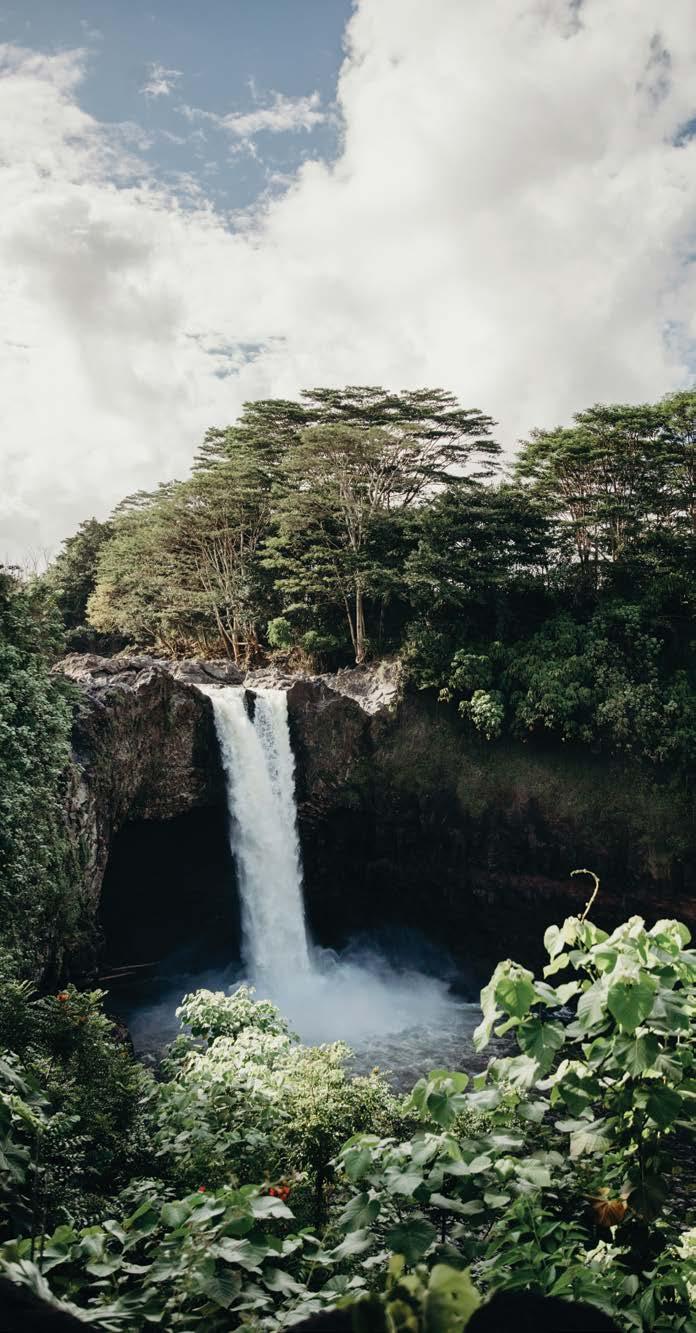
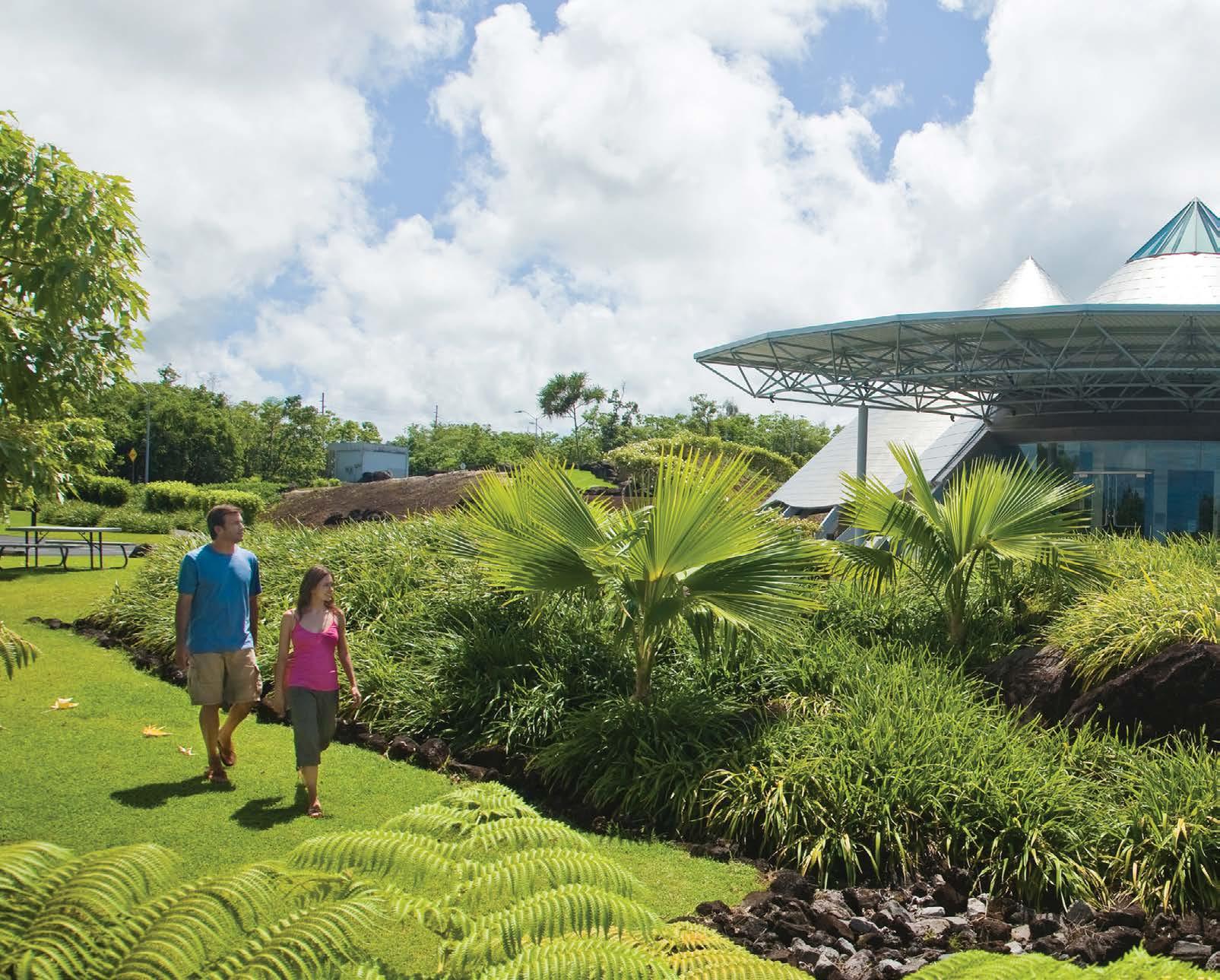
The restored home of missionaries David and Sarah Lyman showcases a fascinating collection of Hawaiian artifacts and fine art. Interactive exhibits offer insight into early missionary life and Hawai‘i’s natural history, along with rotating art displays. Built in 1839, the Lyman House is one of the oldest surviving wood-frame structures on the island of Hawai‘i. Learn more at lymanmuseum.org.
Kaūmana Cave is a lava tube that was created by Maunaloa’s 1881 lava flow. A collapsed skylight provides access to this two-mile tube. Please heed posted signs at the entrance.
Hilo has several picturesque parks and gardens for those who love to relax in nature. Lili‘uokalani Gardens, named after Hawai‘i’s last queen, is an authentic Japanese garden set on 24.6 acres in downtown Hilo and dedicated as a tribute to Japanese immigrants in 1917. Also, be sure to visit the Hawai‘i Tropical Botanical Garden, located on the four-mile scenic route at Onomea Bay. This garden’s trails pass tranquil streams, cascading waterfalls and more than 2,000 species of rare and exotic plants. Stop by Botanical World Adventures or The Umauma Experience to view their lush gardens or have some adventures with their various tours and ziplines. botanicalworld.com umaumaexperience.com
The ‘Imiloa Astronomy Center of Hawai‘i allows you to study the stars from sea level. View an incredible IMAX-style movie in the large planetarium that will make you feel like you’re flying through space. Interactive exhibits connect Hawaiian culture with modern astronomy, highlighting the way Polynesian navigators used the stars to explore the Pacific. imiloahawaii.org

Established in 1977, this is the home of the famous diagonally dipped shortbread cookies. All of the chocolates and cookies at Big Island Candies are handmade with the finest ingredients, such as high-grade chocolate, island eggs and premium, 100 percent Hawai‘i-grown macadamia nuts. bigislandcandies.com
The Pana‘ewa Zoo is the only rainforest zoo in the United States. Its mission is to educate visitors, cater to the unique needs of its animal residents, enrich their lives, nurture the surrounding rainforest and foster compassion for all creatures.
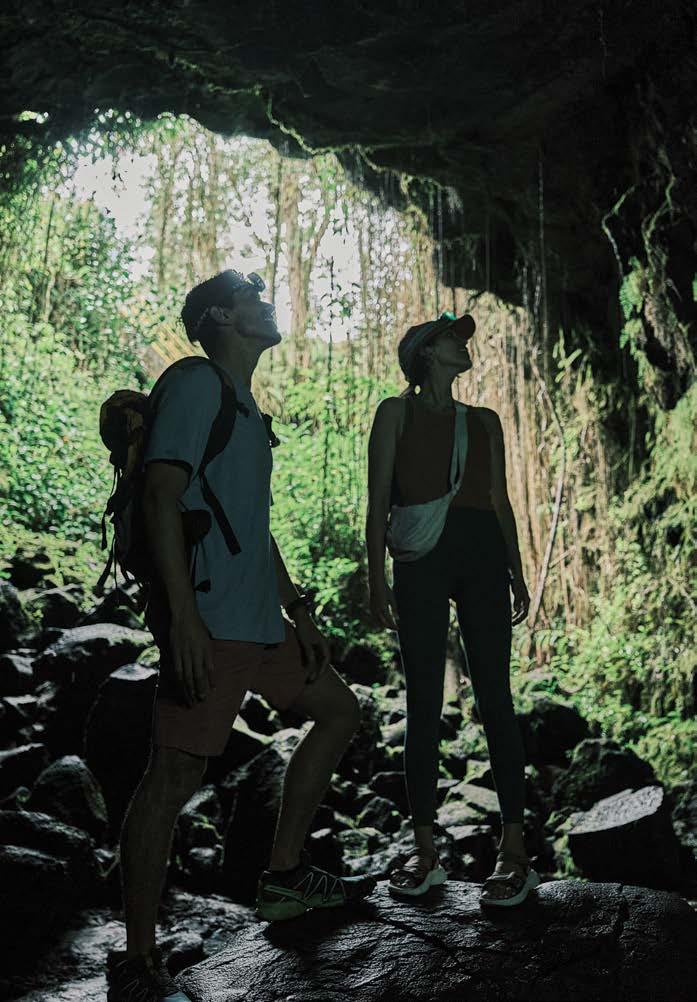
Ka makani hali ‘ala o Puna.
(The fragrance-bearing wind of Puna.)
Famed for the fragrance of maile, lehua and hala. It was said that when the wind blew from the land, fishermen at the sea could smell the fragrance of these leaves and flowers. ‘Ōlelo No‘eau #1458
A place of rugged coastlines, lush forests and local markets, offering visitors a more offthe-beaten-path experience.
From coffee and clothing to skincare and more, Mauna Loa Visitor Center celebrates the spirit of Hawai‘i and supports local innovation. Stroll through a self-guided nature walk and discover a variety of over 25 plant and animal species, including macadamia trees. hawaiianhost.com/pages/ maunaloa-visitor-center
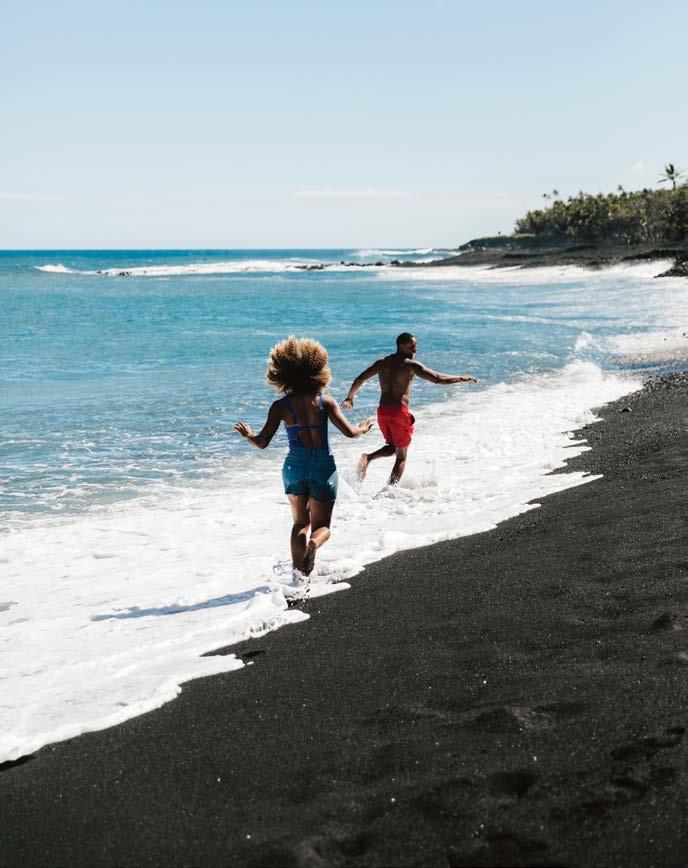

More than 3,000 weekly visitors and 173 vendors offer an array of local products at the Maku‘u Market, a five-acre, open-air market.
Don’t just observe Hawaiian culture — live it! The imu (earth oven) and mea ‘ai (food) are at the very heart of Hawaiian culinary tradition. This immersive experience invites guests to actively participate in building a traditional underground imu, using locally sourced plants and stones. The food is then slow-cooked to perfection, creating a feast that’s so much more than just a meal — it’s a profound connection to generations of knowledge and stories passed down through the land. imumeaai.com
This unique geological site features a striking forest of lava tree molds along a scenic 0.7-mile loop trail. Formed when a fast-moving lava flow engulfed a rainforest, these hollow lava casts are the remnants of trees that once stood here. Over time, nature has reclaimed the area, creating a dramatic landscape of hardened lava sculptures surrounded by lush greenery. The easy-tonavigate trail makes it a great stop for visitors looking to experience Hawai’i’s volcanic history up close. Interpretive signs along the path provide insight into the area’s formation and the powerful forces that shaped it.
Named after Private Isaac Kepo‘okalani Hale (pronounced HAH-lay), a decorated Native Hawaiian soldier known for his bravery and sacrifice during the Korean War, a home in Pohoiki has sheltered generations of his family and remains a private residence. Pohoiki is a black sand and rock shoreline created by the 2018 Kīlauea eruption, where you can sunbathe. Be sure to heed any lifeguard safety warnings.
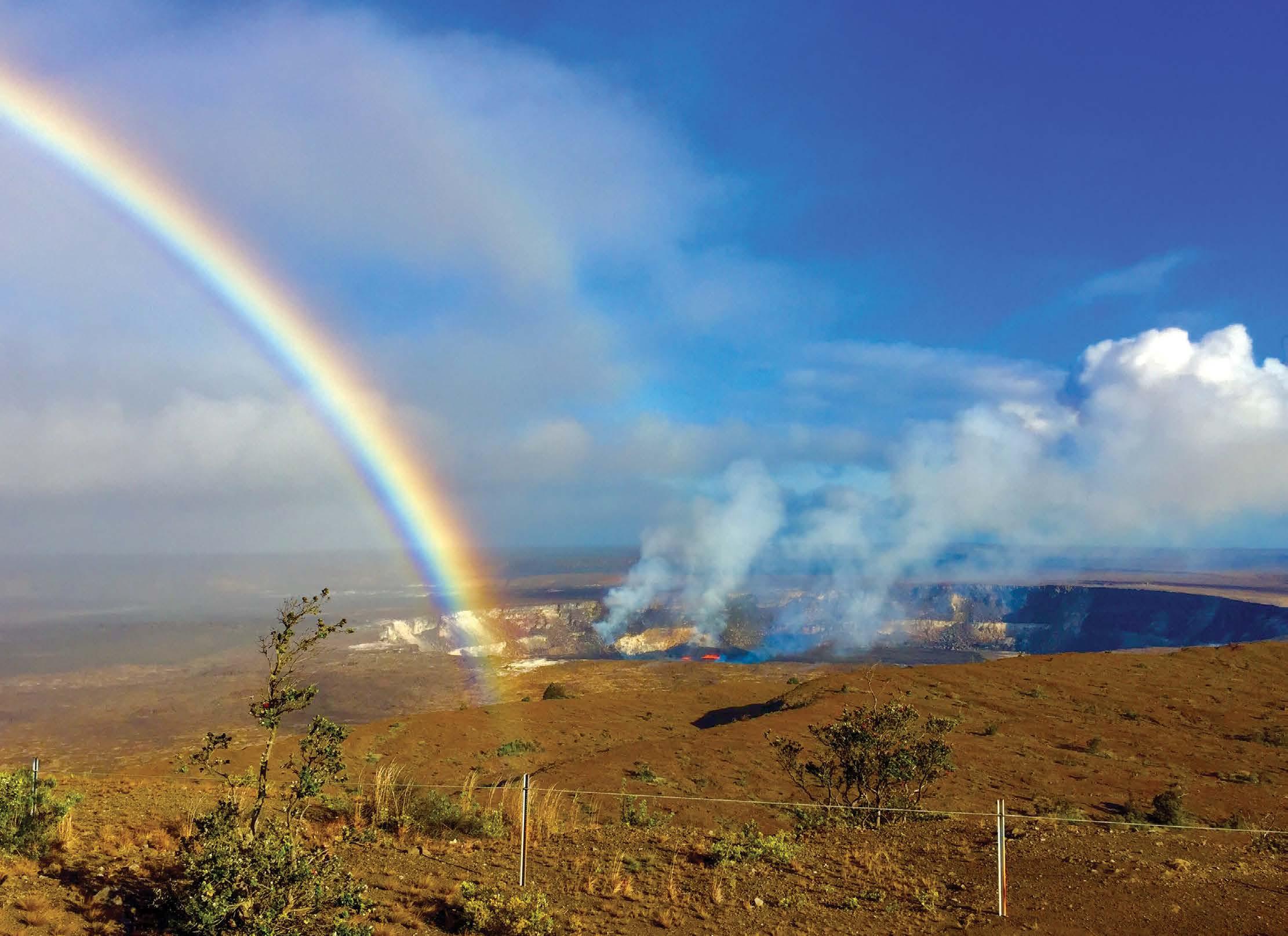



We
Let’s go on a
A low-cliffed, volcanic coastline in an ironwood grove, named after Ranger Albert J. MacKenzie, who planted the largest grove of ironwood trees in Hawai‘i in the 1930s. An old Hawaiian coastal trail traverses the area; please be a mindful visitor here, as there are cultural sites. With strong currents, powerful waves, and a rocky shoreline, this location is best suited for sightseeing only.
Ka‘ū, hiehie I ka makani. (Ka‘ū, regal in the gales.)
An expression of admiration for the district of Ka‘ū, Hawai‘i or for a stately or outstanding person of that district.
‘Ōlelo No‘eau #1605
An untapped treasure, with a stunning black sand beach, a coffee mill, breathtaking volcanic landscapes and a welcoming community that embodies the island’s rich history.

Established in 1916 and spanning 354,461 acres, Hawai‘i Volcanoes National Park is Hawai‘i Island’s most popular attraction. The park encompasses the summits and several rift zones of two of the world’s most active

volcanoes, Kīlauea and Maunaloa. The park is an International Biosphere Reserve and UNESCO World Heritage Site.
Adventure and education abound throughout Hawai’i Volcanoes National Park. This journey for the soul reawakens our minds to the ever-changing, powerful and humbling processes of our dynamic planet. Today, the park displays the results of millions of years of volcanic activity and centuries of Hawaiian culture. Home to native plants and animals, as well as the revered Pelehonuamea, goddess of fire, the park invites visitors to explore its wonders.
Visiting an active volcano is an exciting experience, but it’s important to follow the directions of park rangers and all posted signs. Volcanic activity is unpredictable, so viewing opportunities and locations may change at any time. Always check with the Kīlauea Visitor Center for current activity and safety information before exploring. You can also learn more at nps.gov/havo/planyourvisit/index.htm

Since 1993, Volcano Winery has been crafting award-winning wines on the slopes of Kīlauea, making it the southernmost winery in the United States. Their unique blends feature exotic local ingredients such as yellow guava and jaboticaba, alongside traditional grape varietals. Visitors can enjoy tastings of these one-of-a-kind libations and browse the gift shop for “winetastic” souvenirs, including bottles exclusive to the winery. Open for tours and tastings. volcanowinery.com
Ka‘ū Coffee Mill is a grower and producer of coffee with a farm spanning 100 acres. The mill provides a full range of services from pulping to roasting for local farmers. A visitor center and retail store are located at the mill and are open daily, except holidays. Tours are provided for anyone interested in learning more about the coffee industry. kaucoffeemill.com
When molten lava reaches the cool water of the ocean, it shatters into tiny pieces and becomes black sand. Many culturally and historically significant sites can be found here, as well as ki‘i pōhaku (petroglyphs), animals such as the endangered ‘ea (hawksbill turtle), threatened honu (green sea turtles), endangered ‘ōpe‘ape‘a (Hawaiian hoary bat) and ‘io (Hawaiian hawk).
Home of the world-famous Punalu‘u sweetbread. This landmark bakery in the quaint town of Nā‘ālehu has a large gift shop featuring all of their delicious treats as well as collectible gifts and souvenirs. Enjoy a lunch by the fish pond in their tropical gardens, or pick up your favorites to go. punaluubakeshop.com
Located on the shoulders of Maunaloa and part of Hawai‘i Volcanoes National Park, this 116,000-acre hidden gem offers a variety of day hikes with scenic views and relics of Kahuku’s cattle ranching era. The entrance to the Kahuku Unit is located in Ka‘ū, near mile-marker 70.5 on Highway 11, a one-hour drive from Kīlauea Visitor Center. Please check the park website for hours of operation.
Part of the Manukā Natural Area Reserve, this park is the perfect spot for a picnic lunch with the family or a relaxing stroll. A two-mile loop trail takes you through the park’s arboretum. Experience lava flows from different eruptions, a pit crater (at the top of the trail), cultural sites and native and non-native plants and animals.
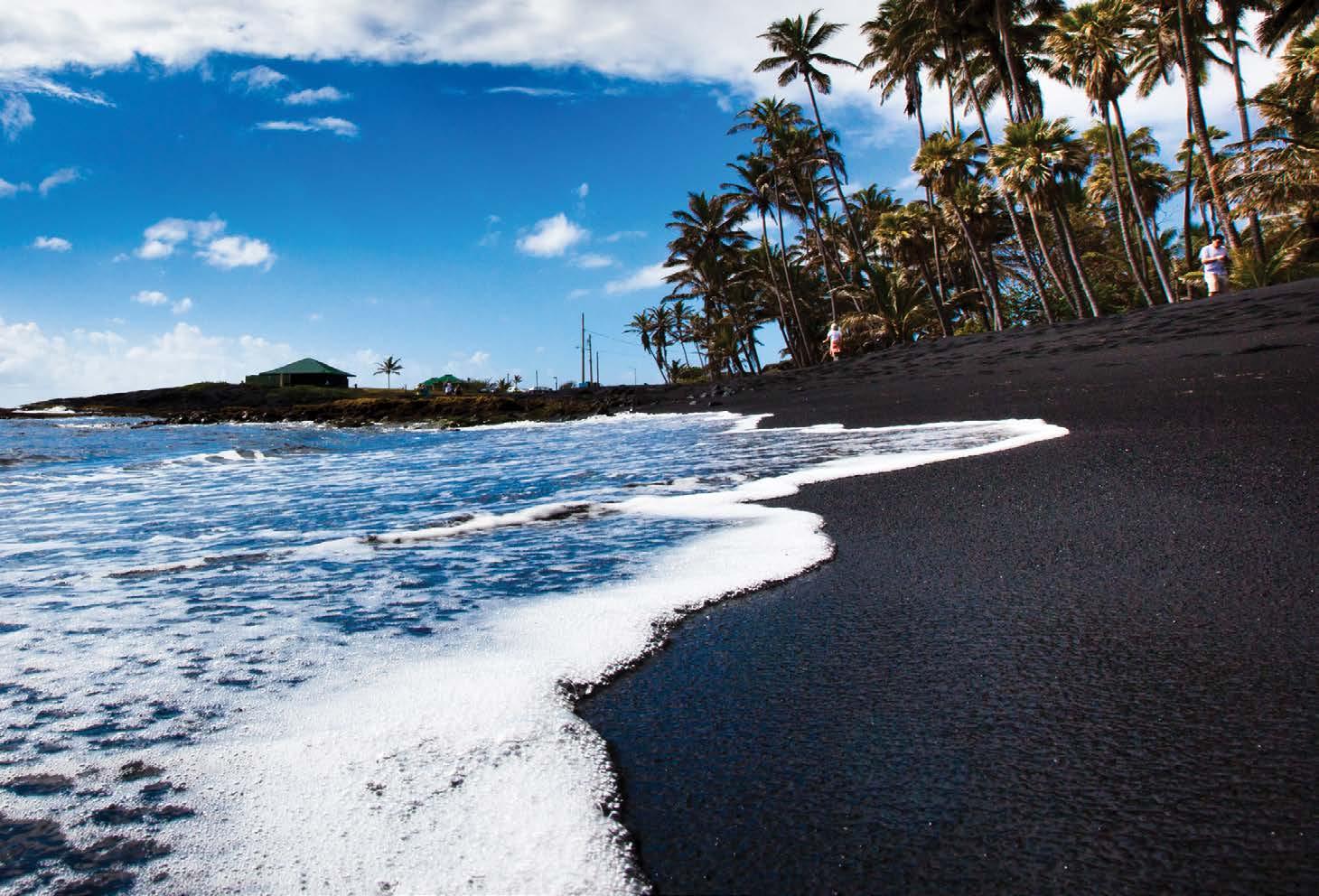
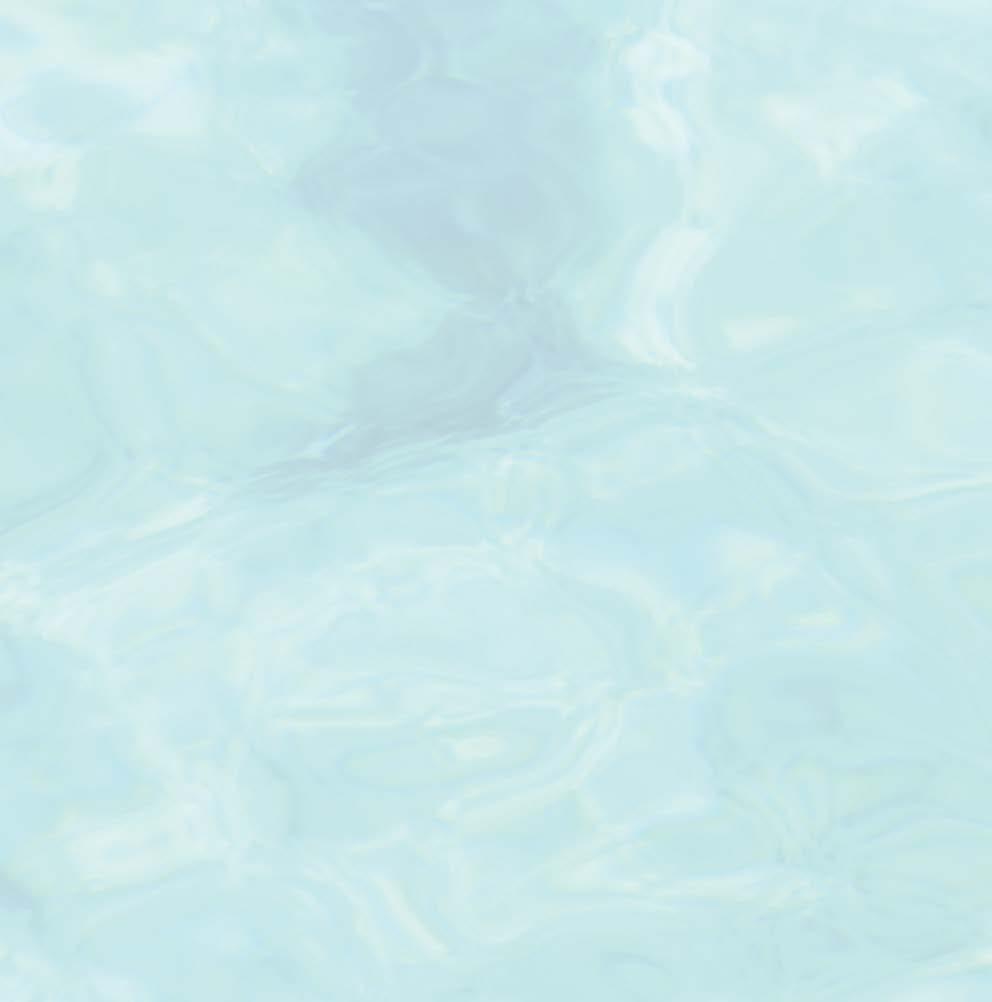
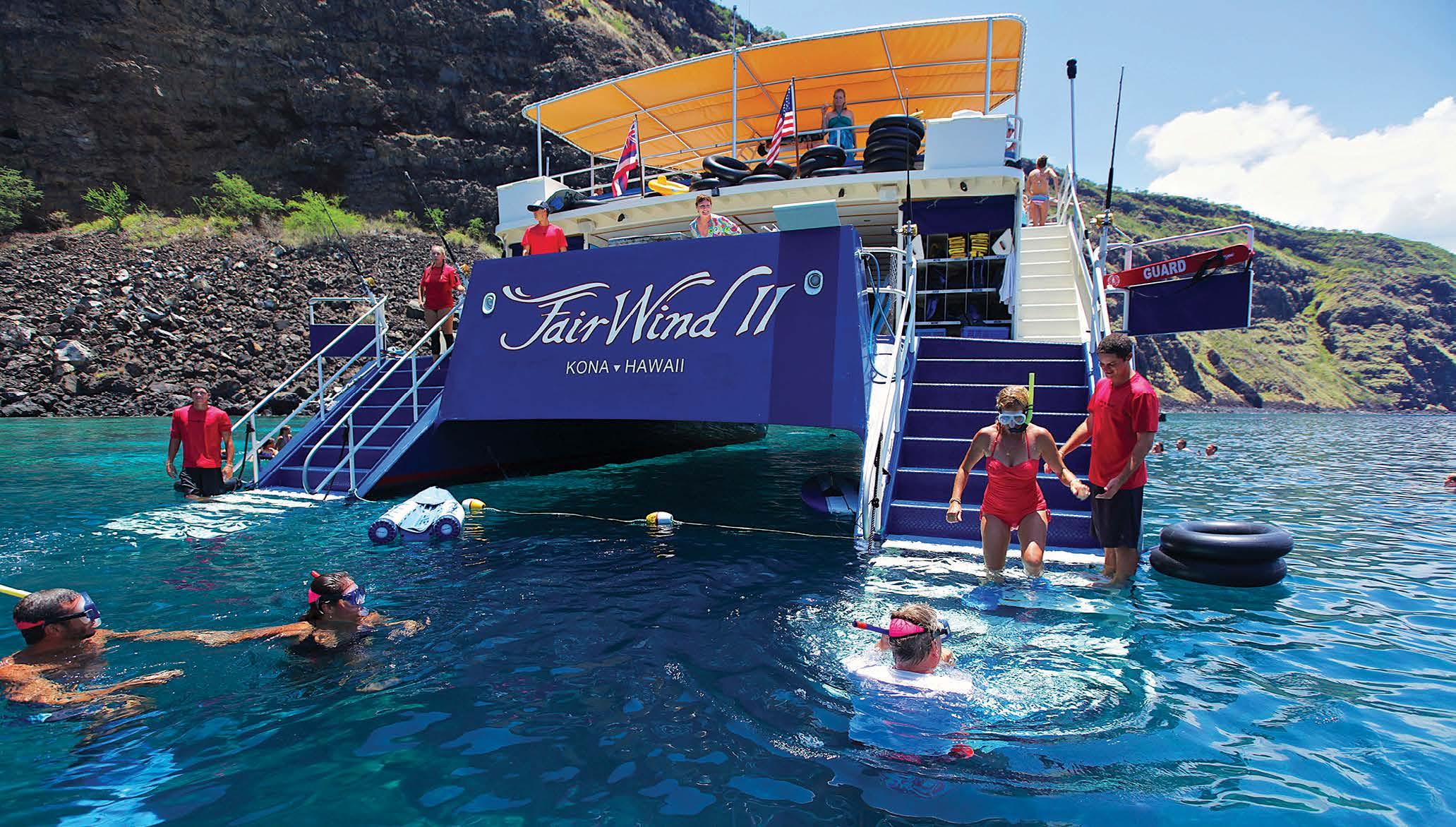
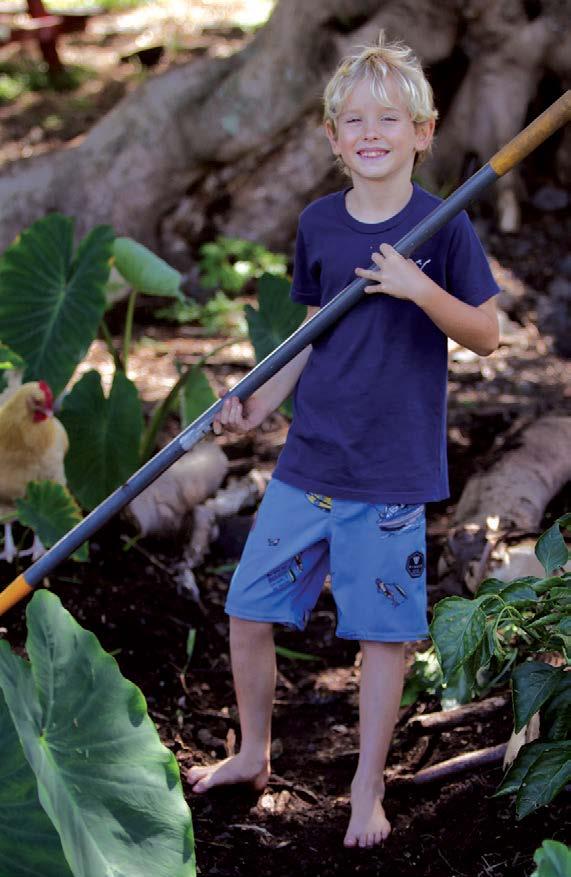

Join us on a journey.
Fair Wind’s eco-tours immerse you in Hawai‘i’s natural ocean beauty and wonders while minimizing our environmental impact and ensuring these precious natural resources thrive for generations to come. That’s why sustainability is at the heart of everything we do—both in the kai (ocean) and on the ‘a – ina (land).
Fair Wind has reduced our carbon footprint by converting our ocean vessels from petroleum-based fuels to 100% locallymade biodiesel from restaurant cooking oil. Onboard, guests enjoy delicious veggie-forward meals prepared with ingredients sourced from our very own farm and small family farms.
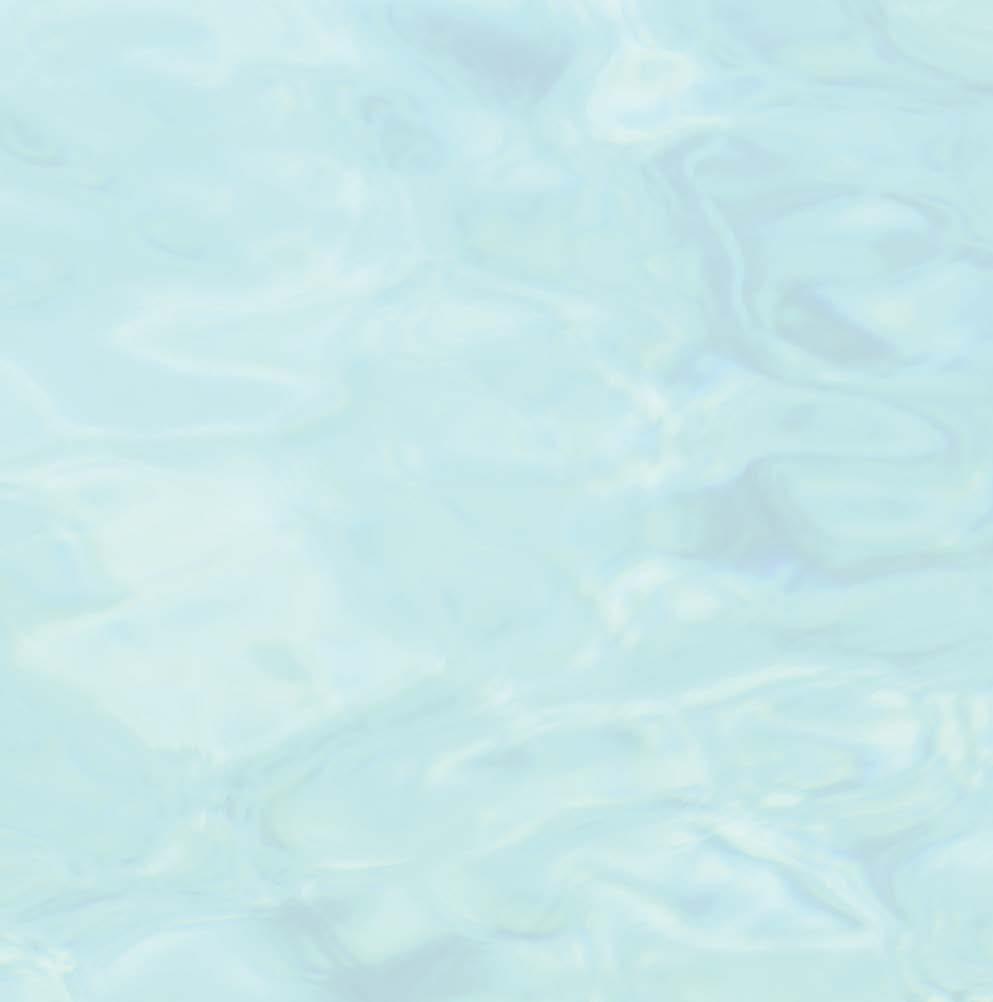

Our commitment to green cuisine not only showcases the rich flavors of Hawai‘i but also significantly reduces waste, allowing us to compost nearly all of our food scraps and biodegradable dishware back at our farm.
From breadfruit to sweet potatoes and our farm grown 100% Kona coffee, the flavors of Hawai’i come full circle, creating a deeper connection between the land, the ocean, and you, our guests. Every aspect of your experience is designed with island flavors and conservation in mind.
Fair Wind is a family legacy passed down through four generations of care, sustainability and protection of Hawai‘i’s natural resources. Your journey with us will nourish the land, sustain our ocean and deepen your connection to Hawaii.
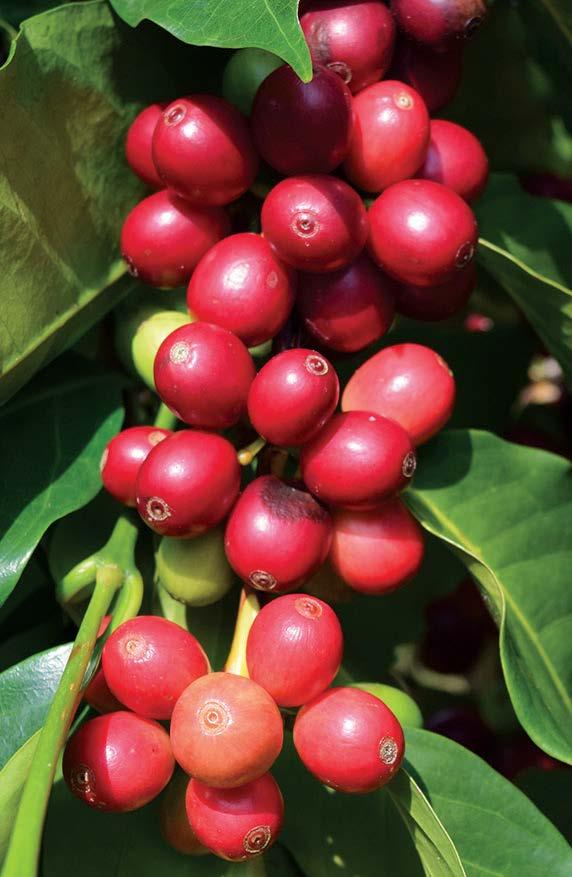

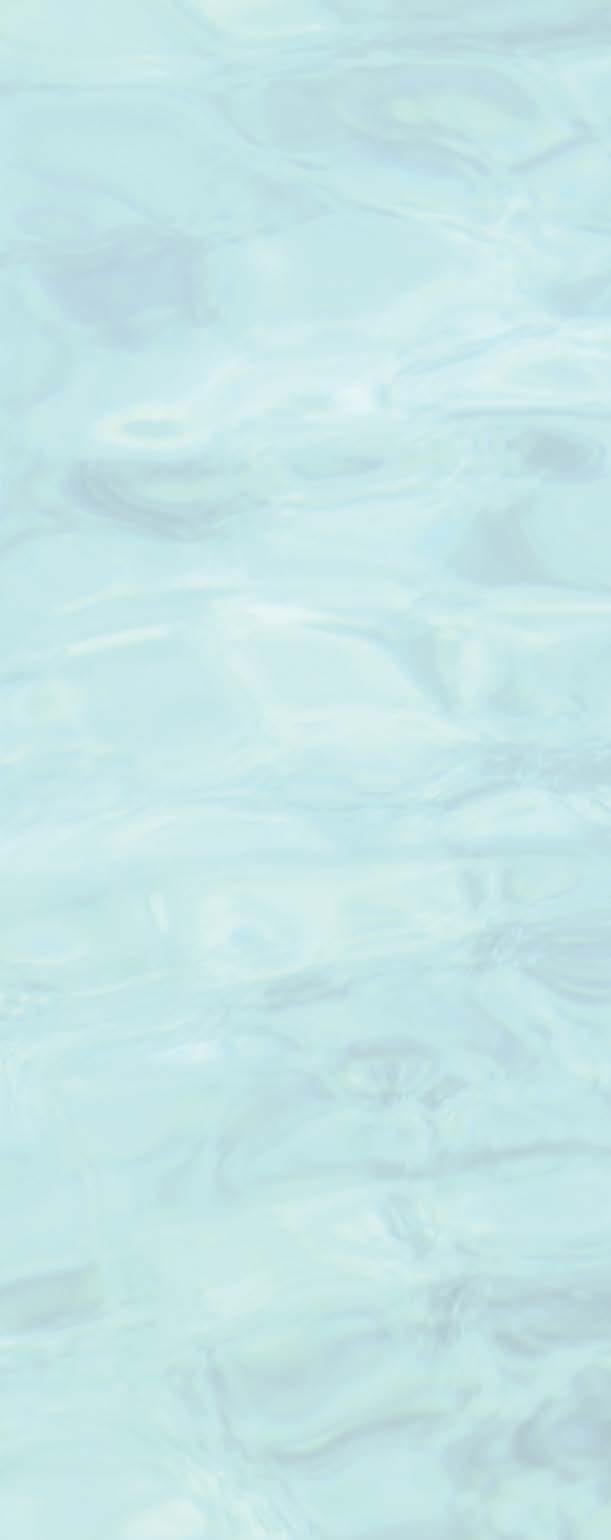

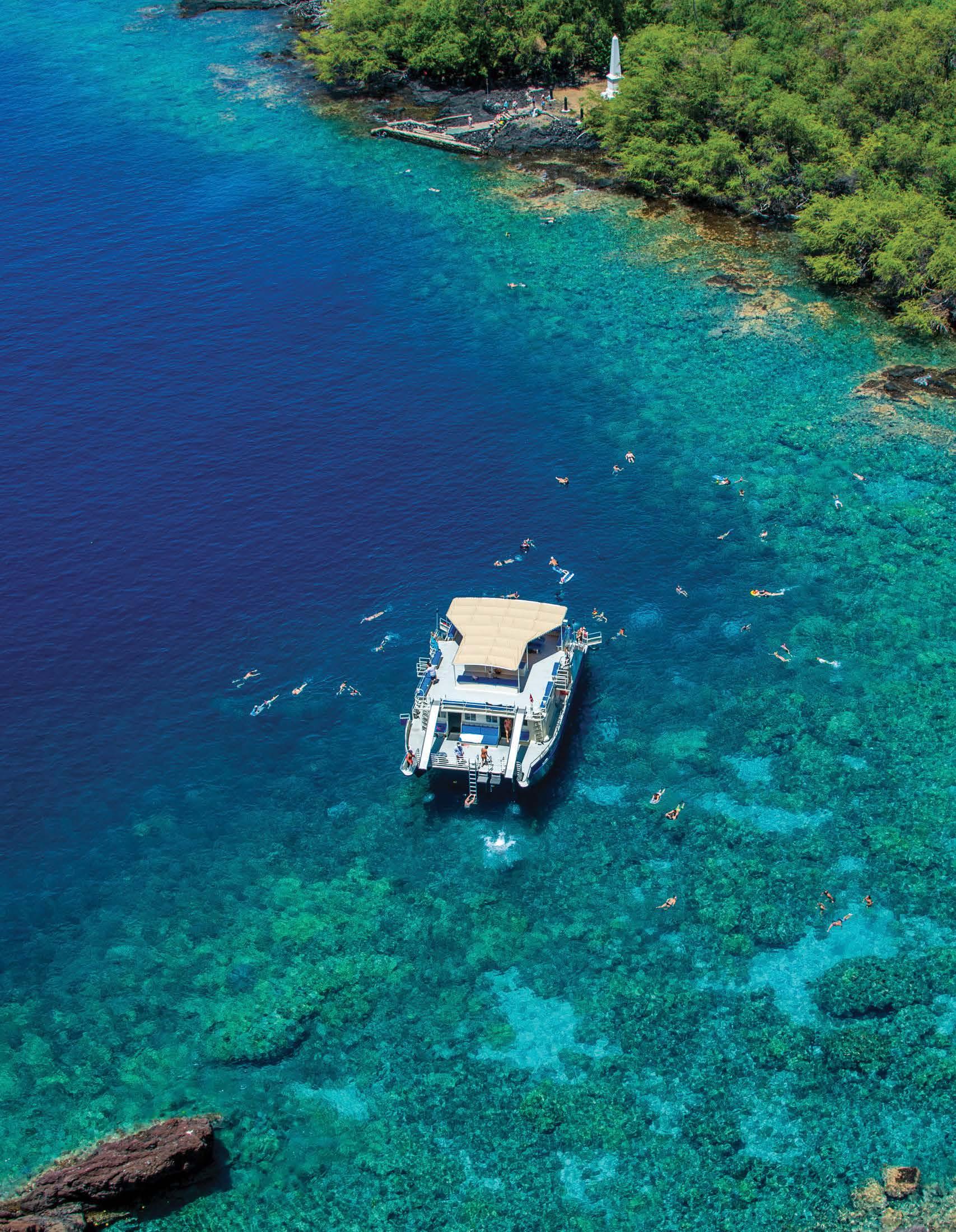
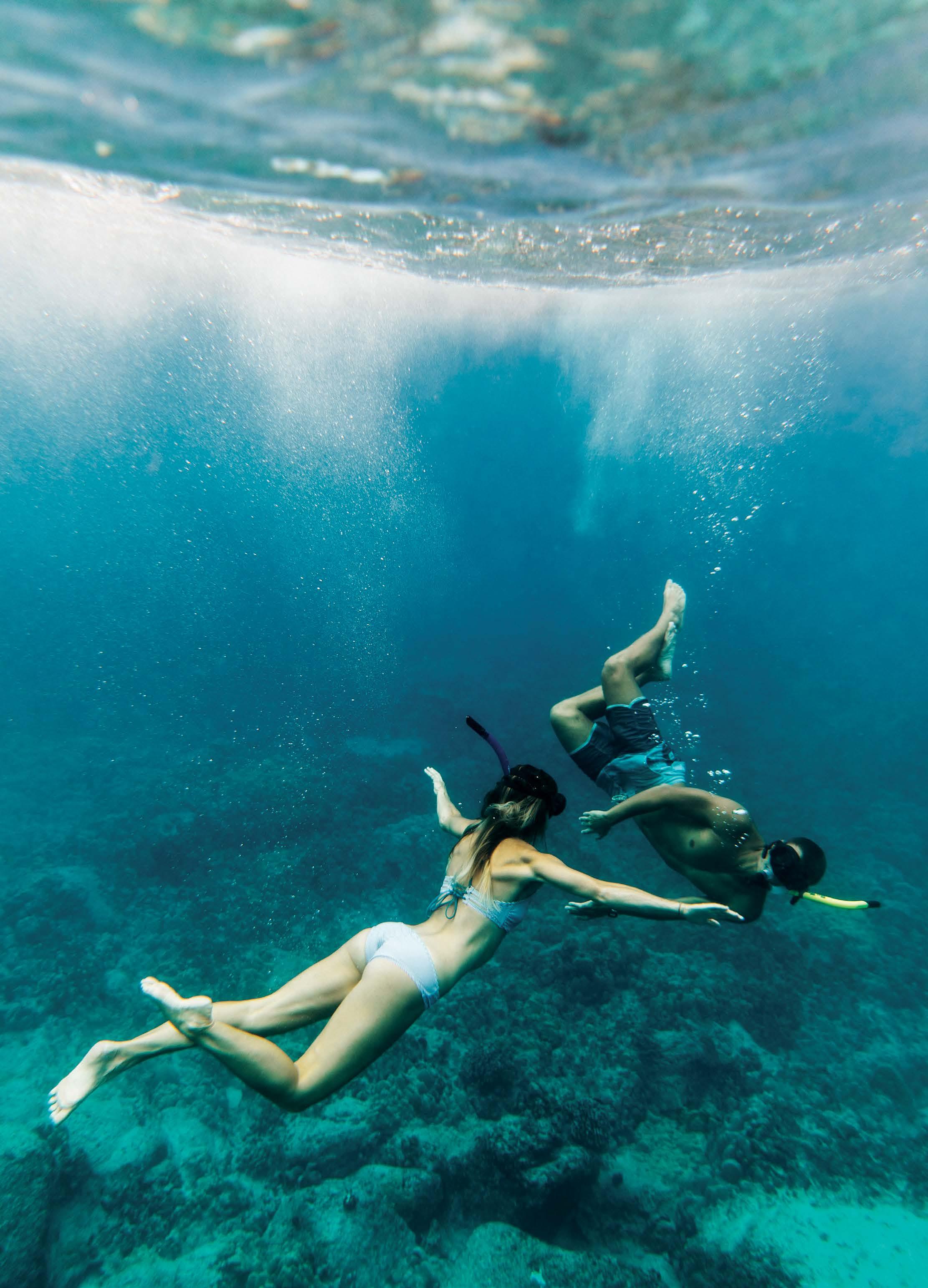
Once you arrive on the island of Hawai‘i, the only question will be: What shall we do next? Perhaps that means lounging on a hammock listening to the surf roll by or marveling over the dramatic landscapes of Hawai‘i Volcanoes National Park. Go snorkeling with graceful manta rays in the darkness of night and watch for whales migrating in the winter season across welcoming Pacific waters. We promise that every day will reveal something new.
An “active” volcano, as classified by the USGS (US Geological Survey), does not necessarily equate to one that is erupting. Most know that Hawai‘i Island is home to two of the world’s most active volcanoes, Kīlauea and Maunaloa, but did you know the USGS also classifies Hualālai and Maunakea as “active”?
The USGS closely monitors Kīlauea and Maunaloa due to their potential for eruptions. Despite advances in volcano monitoring technology, scientists are unable to predict with certainty when the next eruption will occur or the exact nature of the eruptive phase.

The USGS Hawaiian Volcano Observatory (HVO) on Hawai‘i Island serves as a hub for volcanic research and monitoring. HVO scientists conduct fieldwork, analyze data and publish reports to advance our understanding of volcanic processes and improve hazard assessment. This vital work contributes to public safety and emergency preparedness, especially in communities near active volcanic areas.
The USGS plays a crucial role on Hawai‘i Island, contributing valuable insights into volcanic processes, public safety and the dynamic geology of Hawai’i. Their dedication to scientific research and communication ensures that residents and visitors are well-informed and prepared to live in the shadow of these majestic yet unpredictable natural wonders.
If you plan to visit Kīlauea, please visit Hawai‘i Volcanoes National Park’s “Plan Your Visit” landing page first at nps.gov/havo/planyourvisit/index.htm. In the event of an eruption, the eruption viewing page shares important information on where to see the eruption, walking distances from the parking areas, safety tips (such as staying on the trail and out of closed areas) and more.
Hawai‘i Island volcanoes are a reminder of the creative forces of planet Earth.
USGS Hawaiian Volcano Observatory | usgs.gov/observatories/hvo
USGS HVO Live Stream | Kīlauea | youtube.com/usgs/live
Hawai‘i Volcanoes National Park | nps.gov/havo
One is more than 100 years old. Two are engineering and architectural marvels. All five are connected to the history of Hawaiian culture.
The island of Hawai‘i has five national parks — well, actually, one national park, two national historical parks, one national historic site and one national historic trail. But that’s still a very impressive tally of National Park Service (NPS)-managed sites for one island. Each is unique in its scenic beauty, history, location and natural and manmade treasures.
The park with the most acreage (354,461 acres). The one with the most miles (155) of marked hiking trails. The only one that climbs from sea level to more than 13,000 feet,
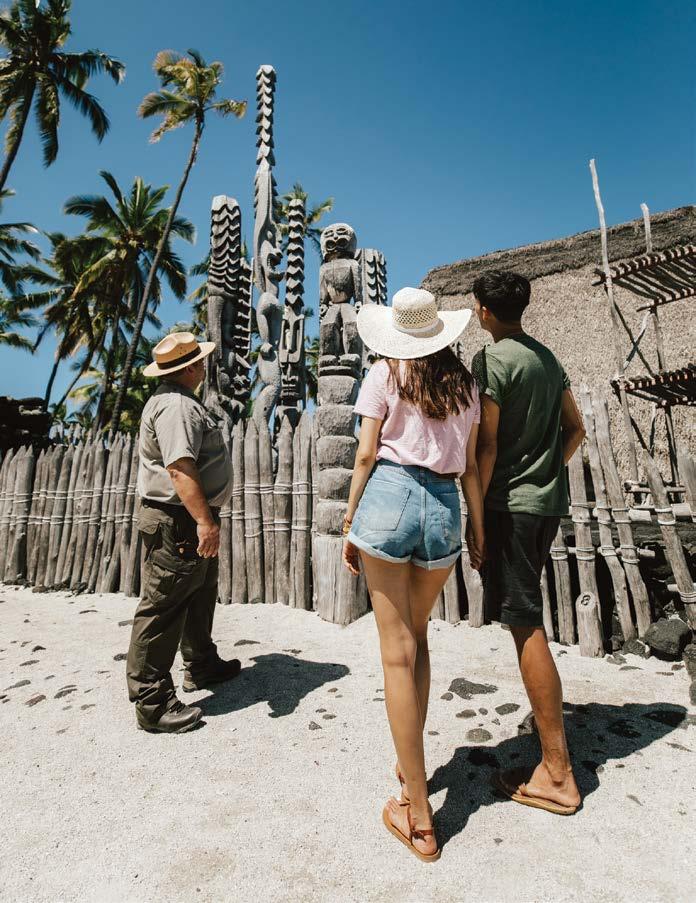
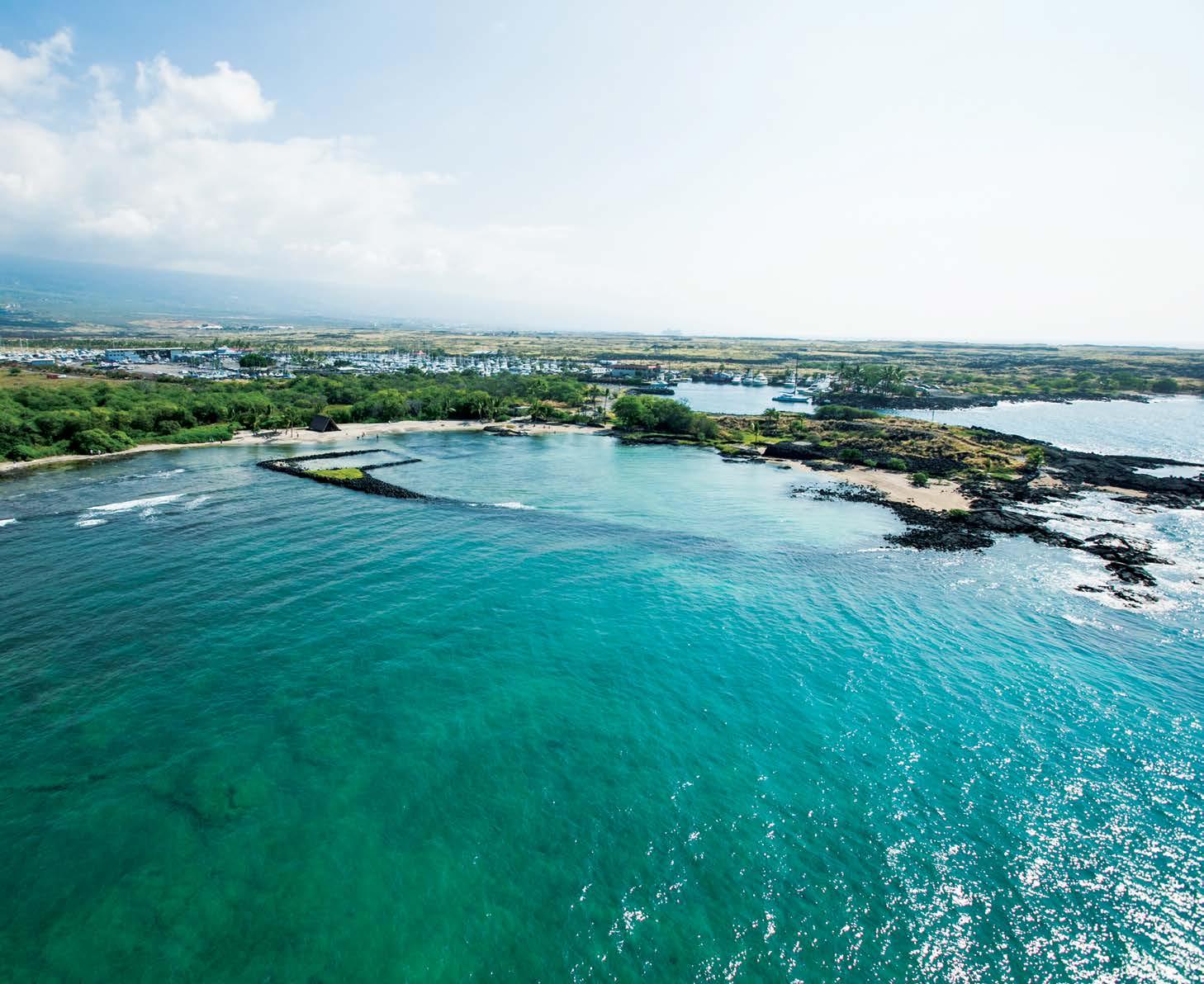
encompassing two volcanoes — Kīlauea, one of the world’s most active volcanoes, and Maunaloa, the world’s most massive subaerial volcano — and six of Earth’s climate subzones along the way. Hawai‘i Volcanoes National Park is unique in all the world. This is a place of contrasting environments and landscapes that satisfies single-day guests, but truly rewards multi-day and returning visitors seeking deeper exploration of its rugged lava fields, rainforest flora and fauna, lava tubes and craters, coastline meetings of lava rock and ocean, Hawaiian cultural sites, ash-covered deserts and even alpine tundra.
Everyone does this:
• See Halema‘uma‘u Crater after it doubled in size following seismic activity at Kīlauea’s summit in 2018
• Hike the once-rainforest-covered Devastation Trail
• Explore steamy Ha‘akulamanu (Sulphur Banks) for a quick loop hike
Not everyone does this, but should:
• Catch the sunrise at Hōlei Sea Arch
• Drive scenic Maunaloa Road to its 6,667foot elevation lookout
• See Pu‘uloa Petroglyph Field’s Hawaiian lava etchings
National Historical Park est. 1961
Translated into English, Pu‘uhonua o Hōnaunau means “place of refuge of Hōnaunau.” Prior to the 1819 abolishment of the kapu (system of Hawaiian sacred laws), fugitives breaking kapu or persons fleeing death or harm could find full protection at this serene oceanfront sanctuary at Hōnaunau Bay on the south Kona Coast. After being absolved by priests, all were free to leave, protected by the mana (spiritual power) of ali‘i (royalty) buried at the pu‘uhonua (place of refuge) who were deified as protection gods. For modern-day visitors, the park preserves the scenic 420-acre site’s sanctuary area, fishponds and palm grove of its royal grounds, as well as remnants of Ki‘ilae village.
Everyone does this: Take the self-guided pu‘uhonua tour and “talk story” (chat) with cultural staff.
Not everyone does this, but should: Hike the mile-long lava trail to the coastal Ki‘ilae settlement.
Pu‘ukoholā Heiau
National Historic Site est. 1972
One of the last major pre-contact sacred structures built in Hawai‘i, construction of the stone heiau at Pu‘ukoholā commenced in 1790 by order of King Kamehameha the Great to honor his family war god Kūkā‘ilimoku. It is believed laborers forming a 20-mile human chain, from seaside Pololū Valley over 5,480foot Kohala volcano to Pu‘ukoholā, transported the heiau’s water-worn stones hand to hand. Built without mortar, the massive temple, with its 16- to 20-foot stone walls, was completed in a year. Imagine all of this when observing its imposing size.
Everyone does this: Walk the site’s half-mile trail, which loops past (but not into) Pu‘ukoholā Heiau (“Temple on Whale Hill”) and Mailekini Heiau, as well as along the coastline on a portion of the Ala Kahakai National Historic Trail (see below).
Not everyone does this, but should: Take the coast trail to the royal courtyard, Pelekane, and the shoreline overlooking Hale o Kapuni Heiau, a submerged temple dedicated to the shark gods. Sign up for the annual ocean count (observation of whales) at Pu‘ukoholā. oceancount.org
4
Kaloko-Honokōhau
National Historical Park est. 1978
About as ocean-based as it is land-based, this 1,100-acre sanctuary of native plant, animal and marine life and early Hawaiian aquaculture development restores and preserves the coastal sections of four ahupua‘a (traditional mountain-to-sea land divisions) once populated by hundreds of Hawaiians. Today, its three-mile coastal trail winds past centuries-old ponds and loko kuapā (lava rock seawalls) built for fish trapping, protected wetlands for native birds and honu (green sea turtles) sunning on the sand. And nearly all of this scenic trail is walkable.
Everyone does this: Hike the coastal trail (which is also a section of the Ala Kahakai Trail — see below) to check out petroglyphs, ‘Aimakapā Fishpond and the restored ‘Ai‘ōpio Fishtrap.
Not everyone does this, but should: Hike the coastal trail’s full distance to see up close the early Hawaiian engineering achievement that is the massive, restored loko kuapā of Kaloko Fishpond.
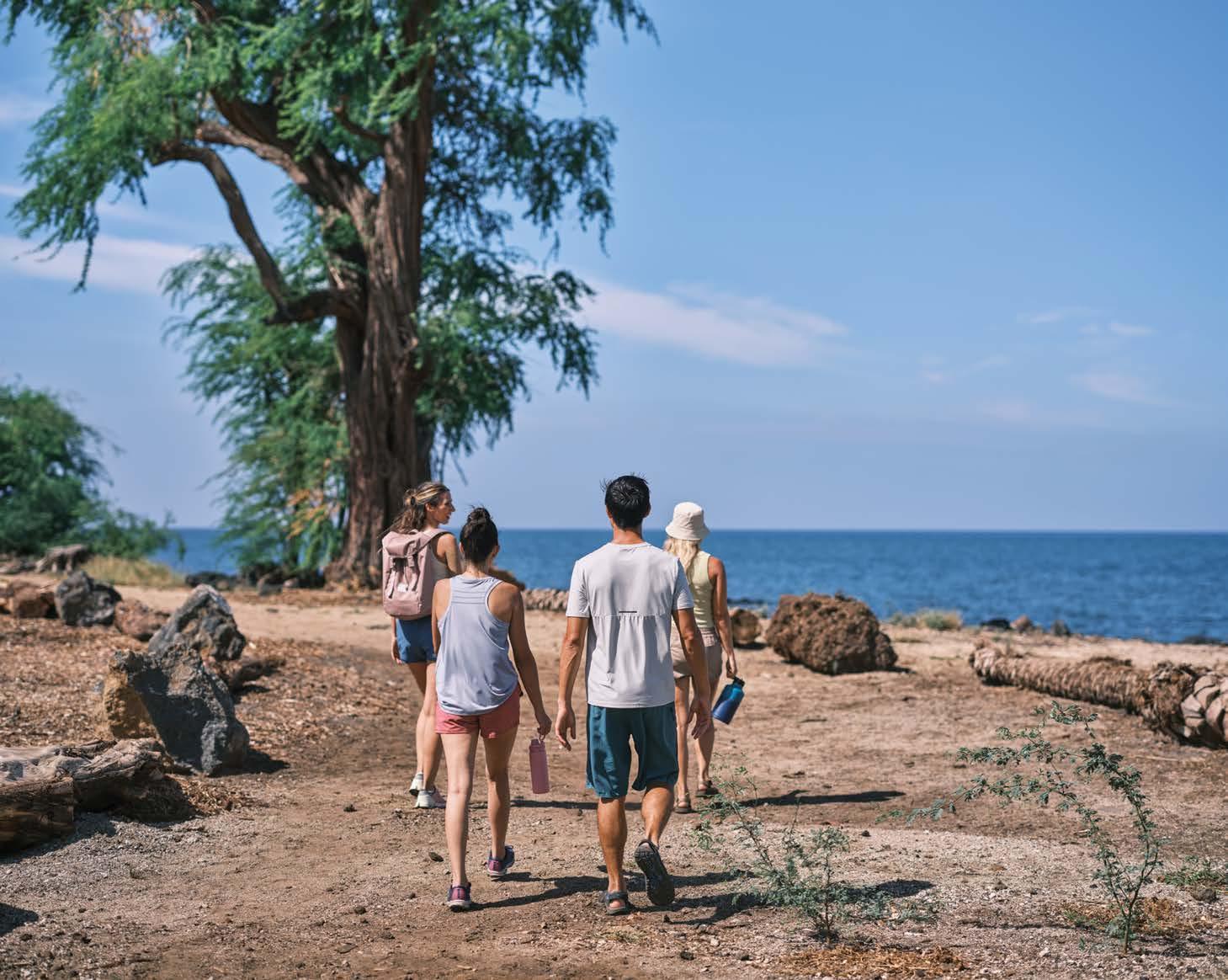
One of the most well-marked remaining Hawai‘i ala loa (much-traveled foot trails used by early Hawaiians to move between settlements), the Ala Kahakai tracks a coastal system of trails and routes from the northernmost tip of the island of Hawai‘i, south along the Kohala and Kona Coasts and around southernmost point Kalae to the easternmost boundary of Hawai‘i Volcanoes National Park. More than 175 miles in its entirety, the trail passes through all four NPS-managed sites on the island of Hawai‘i as well as alongside multiple Hawaiian cultural and historic sites and privately owned properties. It’s not possible to walk all of it yet — public access to the full trail, as well as its maintenance and management, is a long-term NPS mission — but that’s what return hikes are for.
Everyone does this: Hike a one-quarter-mile section of the Ala Kahakai within the boundary of the Pu‘ukoholā Heiau site or a 3.5-mile portion of it within Kaloko-Honokōhau Park.
Not everyone does this, but should: If stamina allows, hike portions of the Ala Kahakai in the remote backcountry areas of Hawai‘i Volcanoes National Park with a friend or group. Note: please talk to the park rangers first.
There are over 266 miles of coastline surrounding the island of Hawai‘i — everything from white sand beaches to black sand beaches, to waves that etch into the cliffside, to marine preserves. Here are some of our favorite activities.
Some of the world’s best sailing conditions can be found right off the western coastline of the island of Hawai‘i. Enjoy cool breezes and take in the sights from a sailboat, sailing canoe or catamaran. Go deep-sea fishing, snorkeling or on a dinner cruise — a day on the ocean is always special for the whole family. A glass-bottom boat or submarine gives you front-row seats to underwater scenery — no towels required.
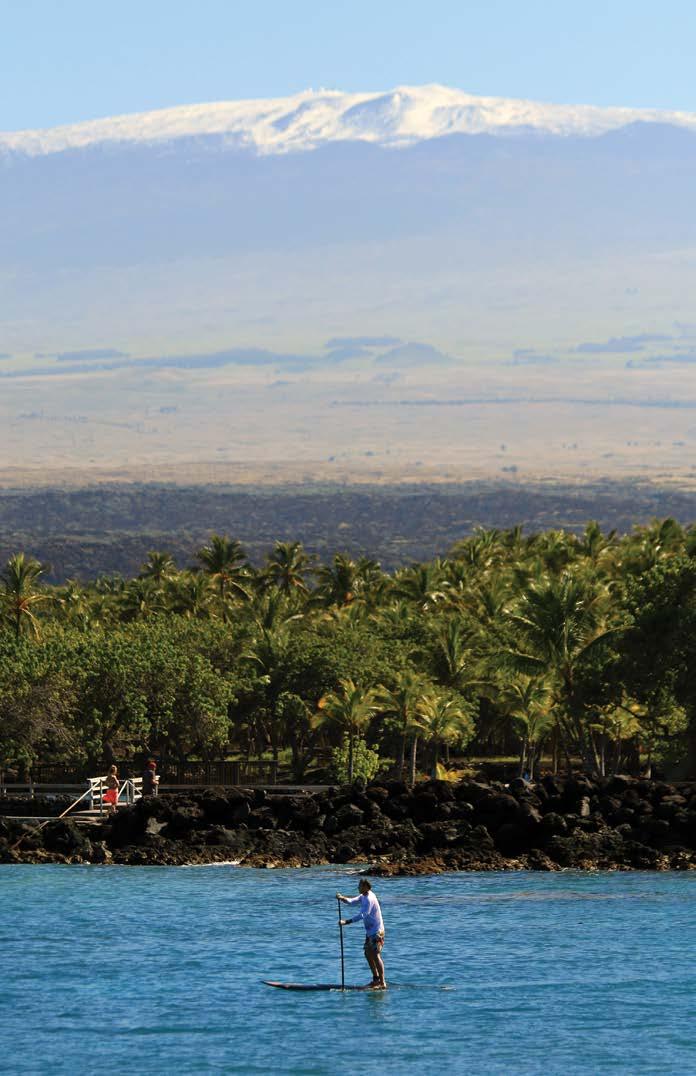

Kayaking and stand-up paddleboarding are great ways to get acquainted with the waters around the island. Trust us, it’s easier than you think! Paddle at your own pace along the shores of Hilo Bay or the numerous coves that line the Kona and Kohala Coasts. Check out a lesson or two for beginners.
From December through May, the great humpback whales travel from their summer feeding grounds in Alaska to the warm, sheltered waters of Hawai‘i mate, give birth, and care for their young. Nearly any coastal viewpoint offers a chance to witness these incredible creatures breaching and spouting offshore. Bring your camera to capture the unforgettable sight of these gentle giants in their natural habitat!
There are hundreds of snorkeling sites around the island where you can find fasci-
nating underwater life. All you need is a snorkel, mask and fins. Be sure to look out for the humuhumunukunukuāpua‘a (Hawai‘i’s state fish). Please do not approach protected marine animals.
Are you a certified diver? If so, gear up for a dive at one of the great island spots! If you’ve always wanted to give it a try, there are numerous dive shops and certified instructors who can train you for an introductory scuba dive or prepare you for full certification. Like with snorkeling, the best diving spots are found along the west side of the island. For the best viewing and for safety, stay close to shore and always dive with a local guide who knows the top spots and can navigate changing ocean conditions. While scuba diving in Hawai‘i, always respect the coral reefs and marine life by avoiding contact, not touching or stepping on coral and keeping a safe distance from marine animals to help preserve the delicate underwater ecosystem.


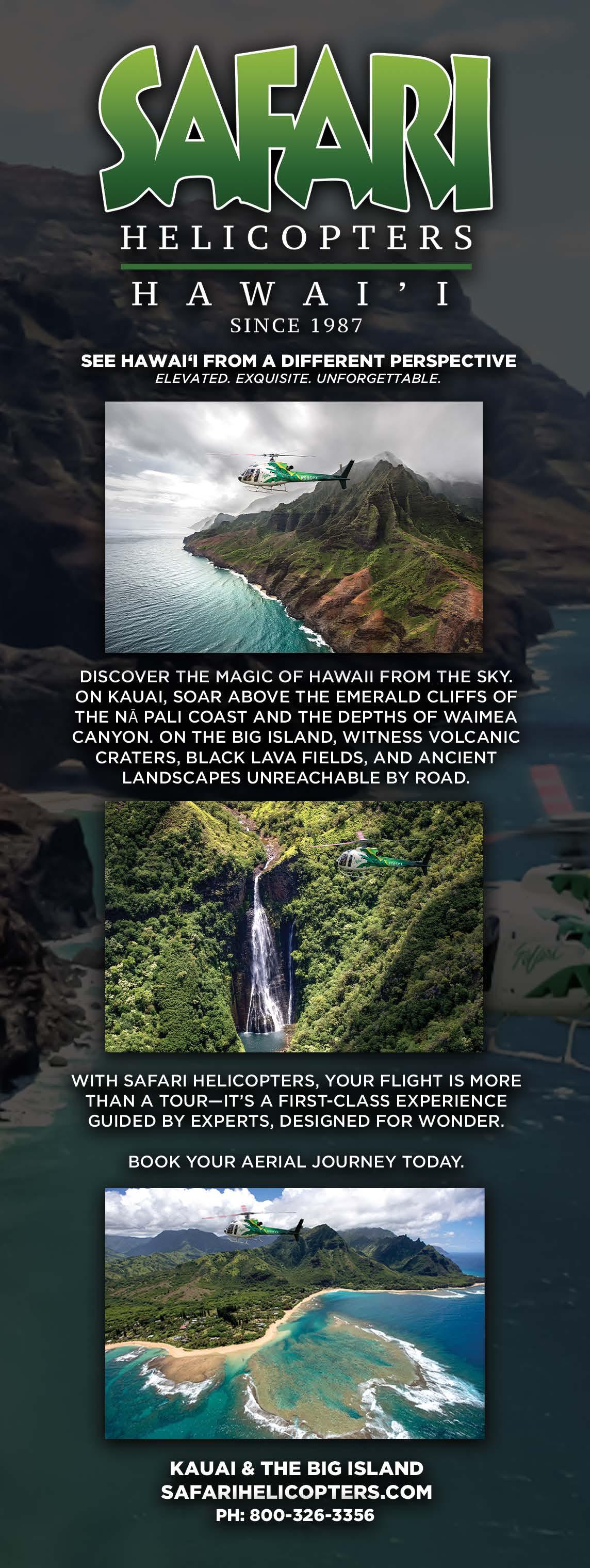
The ultimate thrill in nature presents itself in the seas of the island of Hawai‘i. Consider swimming with manta rays — don’t worry, they feed on plankton, not people, and can’t sting you! The Kona Coast is the most popular location to spot manta rays, and underwater lights are used at nighttime to best attract feeding mantas. View these majestic creatures, with wingspans of up to 20 feet or more, as a diver from the ocean floor or as a snorkeler on the surface. Appease your curiosity and indulge in this up-close-andpersonal experience.

The island of Hawai‘i is home to some of the world’s most beautiful beaches. We recommend only swimming at beaches with lifeguards, which include:
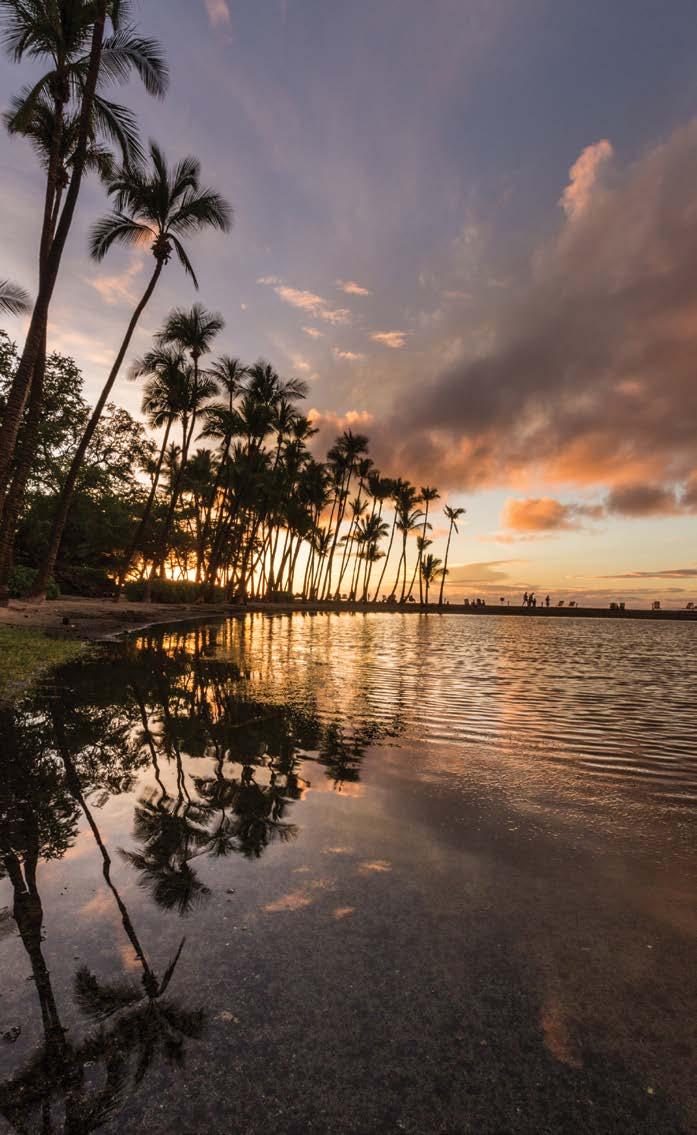
• Carlsmith Beach Park
• Honoli‘i Beach Park
• Leleiwi Beach Park
• Onekahakaha Beach Park
• Richardson Ocean Park
• Hāpuna Beach State Recreation Area
• Spencer Beach Park at ‘Ōhai‘ula
• La‘aloa, or White Sands, Beach Park
• Kahalu‘u Beach Park
• Kekaha Kai State Beach Park
• Isaac Hale Beach Park at Pohoiki
• Punalu‘u Beach Park
For more information, visit hawaiibeachsafety.com
It’s challenging and delicious! Try your hand at deep-sea fishing on the Kona Coast to hook big mahimahi, ono and ‘ahi, and enjoy the stunning island scenery, too. Find the Pacific Blue Marlin, the ultimate big-game fish, in the waters off Kona year-round. Most charter fishing boats go out to sea from Honokōhau Harbor outside Historic Kailua Village. Good luck!
What a better way to see the sights and scenery of the island of Hawai‘i than by hiking or biking? Here are some fun suggestions we’ve gathered for you to truly experience the island’s attractions.
From coastal trails to lush forest paths and even petroglyph fields, the island of Hawai‘i has a wealth of hiking options for those of any ability level. Get a snippet of Hawai‘i’s history while traversing along a section of the Ala Kahakai
National Historic Trail — a 175-mile corridor and trail network of cultural and historical significance. Staying on the Kohala Coast? Try the Kawaihae to ‘Anaeho‘omalu section (15.4 miles). Other trails will take you into tropical wilderness, volcanic landscapes, quiet beaches, romantic waterfalls, ridgeline lookouts or across open ranchlands. Bring good hiking shoes, appropriate apparel, lots of drinking water and your camera! For more information on Hawai‘i’s Trail and Access System, visit dlnr.hawaii.gov/recreation/nah/hawaii/
Soar high above the island’s breathtaking landscapes on a thrilling zipline adventure, gliding over lush forests, deep valleys and cascading waterfalls. Feel the rush of the wind as you take in panoramic views of the island’s untouched natural beauty, all while securely harnessed with expert guides, ensuring a safe and unforgettable ride.
The entire Northern Hemisphere and most of the Southern Hemisphere can be seen from the island of Hawai‘i. Its skies are clear, dry and have very low light impact, making it the perfect place for stargazing. Guided stargazing tours offer great views of the stars from Maunakea’s summit, as well as transportation, dinner, warm parkas and detailed narratives about the area’s history and cultural significance. If you prefer stargazing from a lower elevation, visit ‘Imiloa Astronomy Center of Hawai‘i in Hilo, where you can view IMAX-style movies in the planetarium and learn more about Native Hawaiians and their connection to the night sky. Or enjoy shoreline stargazing from select hotels along the Kohala Coast on the west side.

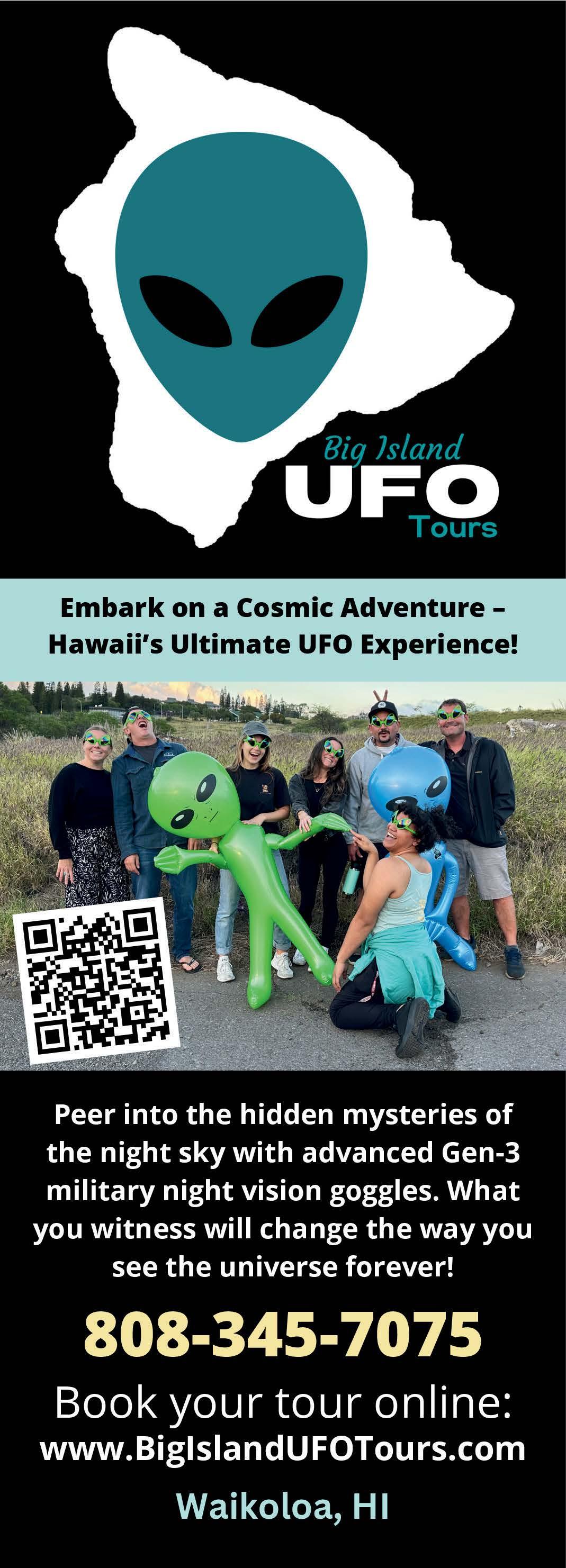
Feel the warm tropical breeze as you take in the stunning landscapes of the island of Hawai‘i on two wheels. Ride the world-famous 112-mile IRONMAN® World Championship biking route or explore one of the island’s many scenic trails. Rent a bike or join a guided tour for an unforgettable cycling adventure.
Let your new four-legged friend do the walking as you explore paniolo (cowboy) country on horseback. There are horses for riders of all levels of experience. With your steadfast steed, enjoy the island’s beautiful mountain scenery and panoramic coastal views.
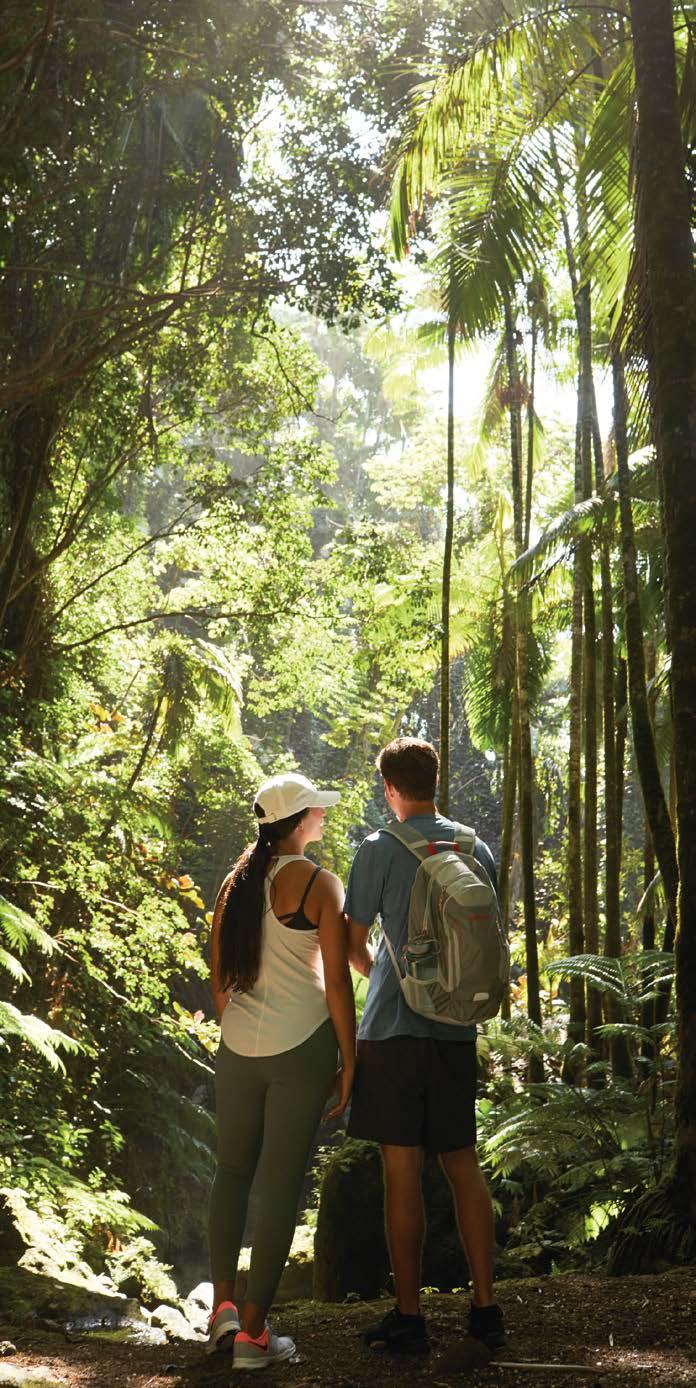

Wander through Hawai‘i Island’s lush rainforests, where towering tree ferns and vibrant wild orchids create a breathtaking natural canopy. Join a knowledgeable guide or explore on your own to discover the island’s rich biodiversity, from rare native plants to ancient lava formations shaping the landscape. Listen to the melodic calls of Hawai‘i’s native birds as they flit through the treetops, offering a glimpse into the island’s unique ecosystems and the fascinating evolution of its endemic species.
Nearly twice the size of all the other Hawaiian Islands combined, Hawai‘i Island
offers an awe-inspiring landscape best appreciated from the sky. A helicopter tour provides a breathtaking bird’s-eye view of the island’s dramatic volcanoes, lush mountains and cascading waterfalls — many of which are hidden deep within remote valleys. Witness the rugged coastline and take in sights that are otherwise inaccessible by land. This unforgettable experience offers a rare perspective on the island’s raw beauty, making it one of the most spectacular ways to explore Hawai‘i’s largest and most diverse island. In the expansive skies above, also watch for the pueo (Hawaiian owl), which is uniquely active in the daytime.
Try out some paniolo (cowboy) activities during an evening at Kahuā Ranch. Pitch horseshoes, test your skills at tossing a lasso and cook s’mores around a campfire. At this 8,500-acre working cattle and sheep ranch, you’ll definitely learn a bunch and have lots of fun! paniolobbqdinner.com
Begin your visit to Hawai‘i Volcanoes National Park at the visitor center, where families can watch a film as an introduction to the park. Schedule ranger-guided activities and pick up maps with more information on the park’s many hikes. Stay on designated trails, respect all safety signs and be aware of changing conditions to ensure a safe and enjoyable experience in this dynamic volcanic landscape. nps.gov/havo

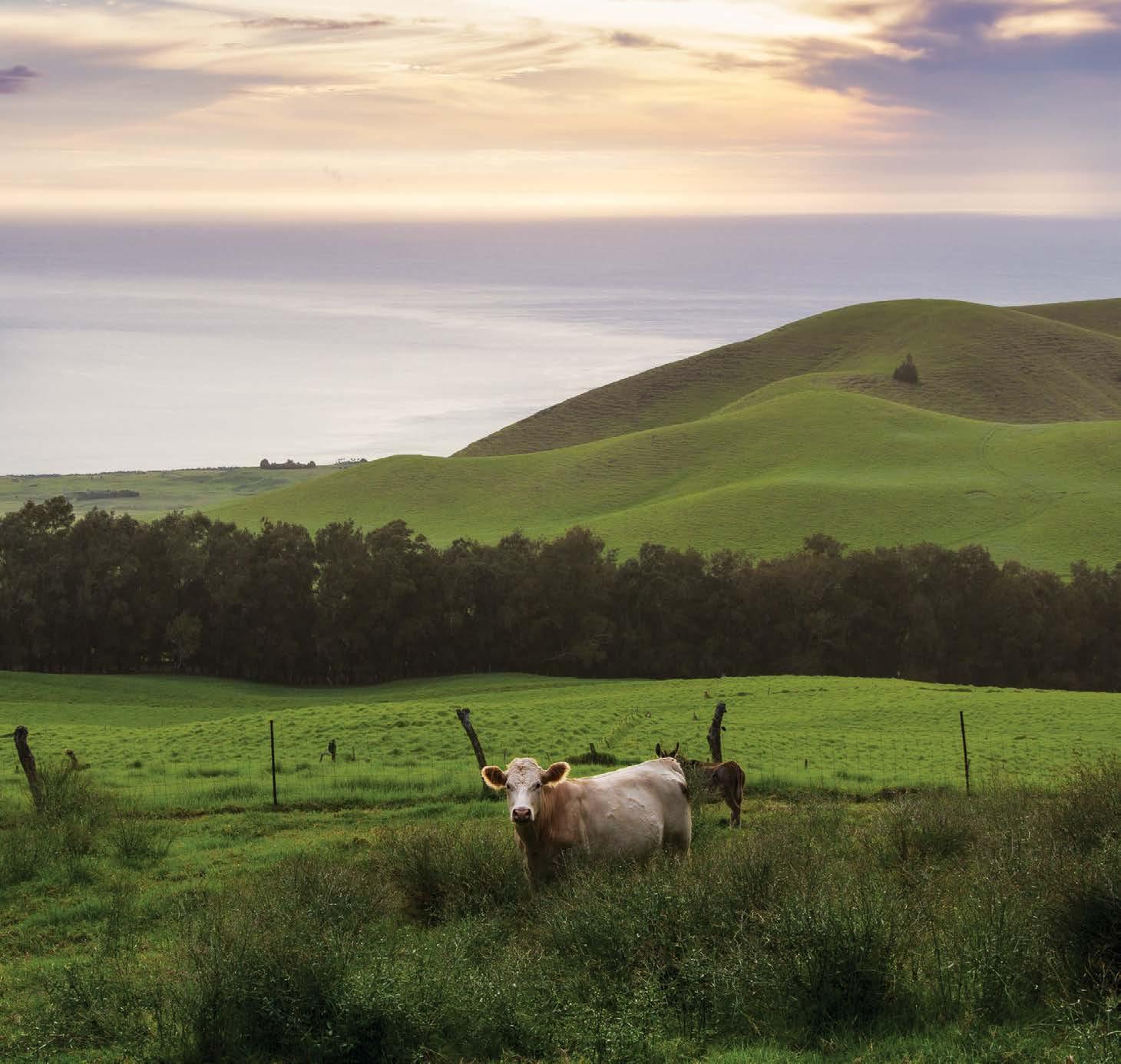
Explore the Mokupāpapa Discovery Center in Hilo, where engaging exhibits bring Hawai‘i’s remote and pristine coral reefs to life. Learn about the unique marine ecosystems of the Papahānaumokuākea Marine National Monument, one of the largest protected areas in the world. Get an up-close look at a life-size model of the endangered Hawaiian monk seal, marvel at the vibrant marine life in the 2,500-gallon aquarium and discover the efforts to preserve these fragile underwater habitats. papahanaumokuakea.gov/education/center.html
Families visiting the Hawai‘i Wildlife Center can learn about ongoing conservation efforts to protect Hawai‘i’s coastal birds. The “get up close” reference infers they can literally get close to these birds in rehab, but they are not allowed to. As the first organization dedicated solely to caring for and rehabilitating coastal birds, the center offers an engaging and educational experience for all ages. Explore the interactive courtyard and education pavilion to discover the unique species that call Hawai‘i home and the vital role of wildlife rescue in preserving these fragile ecosystems. hawaiiwildlifecenter.org
The state has nine national parks, and five of them are on the island of Hawai‘i. These include Hawai‘i Volcanoes National Park, Pu‘uhonua o Hōnaunau National Historical Park, KalokoHonokōhau National Historical Park, Pu‘ukoholā Heiau National Historic Site and the Ala Kahakai National Historic Trail. Each park offers a unique glimpse into the island’s rich cultural history and stunning landscapes — from ancient Hawaiian temples to lava-sculpted coastlines. Whether you’re hiking through volcanic craters or walking in the footsteps of Hawaiian royalty, these parks provide an unforgettable way to experience the island’s natural beauty and heritage.
Those who say “the journey is the destination” may be talking about a drive around the island of Hawai‘i. This drive earned the island one of National Geographic’s 50 Ultimate Road Trips in the World and Rand McNally’s Best of the Road®, the only trip awarded in the state. Rent a car for flexibility and ease before you arrive to the island. Guided island tours are also available.
A drive around the island would not be complete without visiting the eight Heritage Sites of Hawai‘i. These special, “must-see” places provide significant historical, cultural and environmental contributions to the island of Hawai‘i.
This 180-acre park was once royal grounds and a place of refuge for Hawaiian lawbreakers.


Once a favorite retreat of Hawaiian royalty, this palace features original koa furniture, Hawaiian artifacts and personal memorabilia of the royal family. daughtersofhawaii.org/ hulihee-palace
Historical
This is where Captain James Cook first set foot on the island of Hawai‘i in 1779, and died a year later. A monument stands here in his name.
Find out about life in early Hawai‘i by learning about fishpond systems and viewing ki‘i pōhaku (petroglyphs) and heiau (temples).
National
This site features one of the largest heiau (temples) built in Hawai‘i.
Take a self-guided tour and explore traditional Hawaiian coastal lifestyles. ‘Akaka Falls
A self-guided walk features two amazing waterfalls, ‘Akaka Falls (442 feet) and Kahuna Falls (100 feet).
National Park
An UNESCO (United Nations Educational, Scientific and Cultural Organization) World Heritage Site and one of Hawai‘i’s most popular attractions.


Immerse yourself into the fascinating and hidden world of bees at our picturesque honey farm. Peek inside actual hives and discover how honey is made. Taste award-winning honey and learn how you can help bees thrive.

• Attend in your vacation attire (no bee suits required)
• Come curious, leave buzzing with knowledge
• One-hour Tour
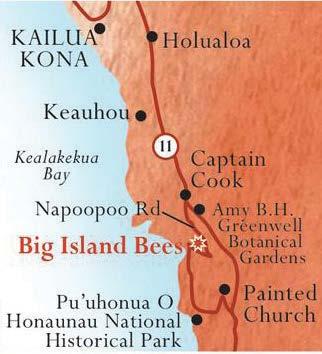
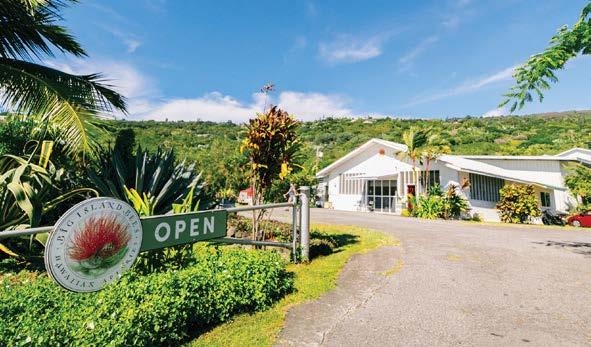


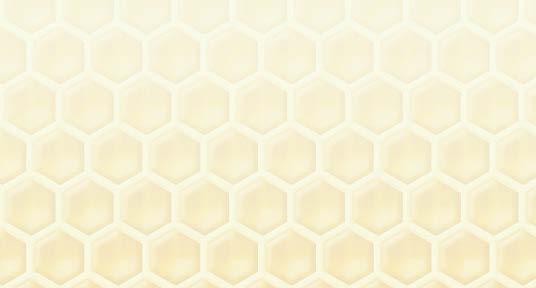

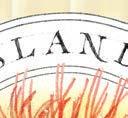








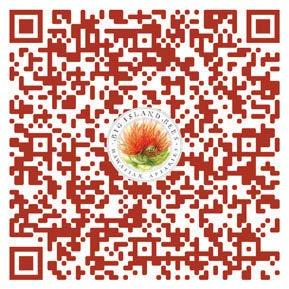
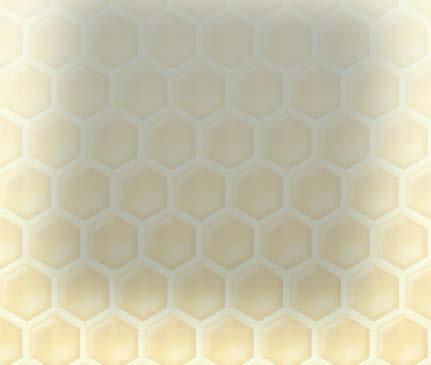


What a better place to tee off than surrounded by breathtaking mountain ranges and the Pacific Ocean? We’ve got more oceanfront holes than any other island in the Pacific. Don’t let your beautiful surroundings distract you — these gorgeous courses are fun yet challenging! Play at a course graced by designers like Perry Dye, Arnold Palmer, Ed Seay, William Bell, Jay Morrish and Robert Trent Jones.
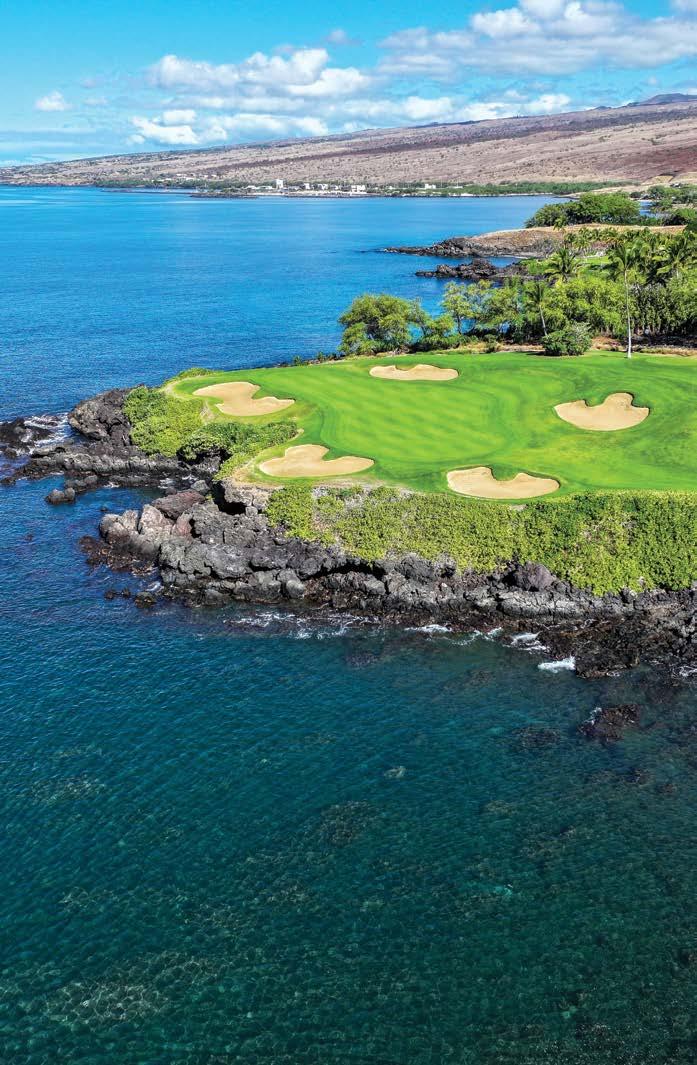
Offering challenging experiences to novice and professional golf enthusiasts alike.
68-1050 Makaiwa Place, Kohala Coast 808-885-6655, aubergeresorts.com/ maunalani/experiences/golf/
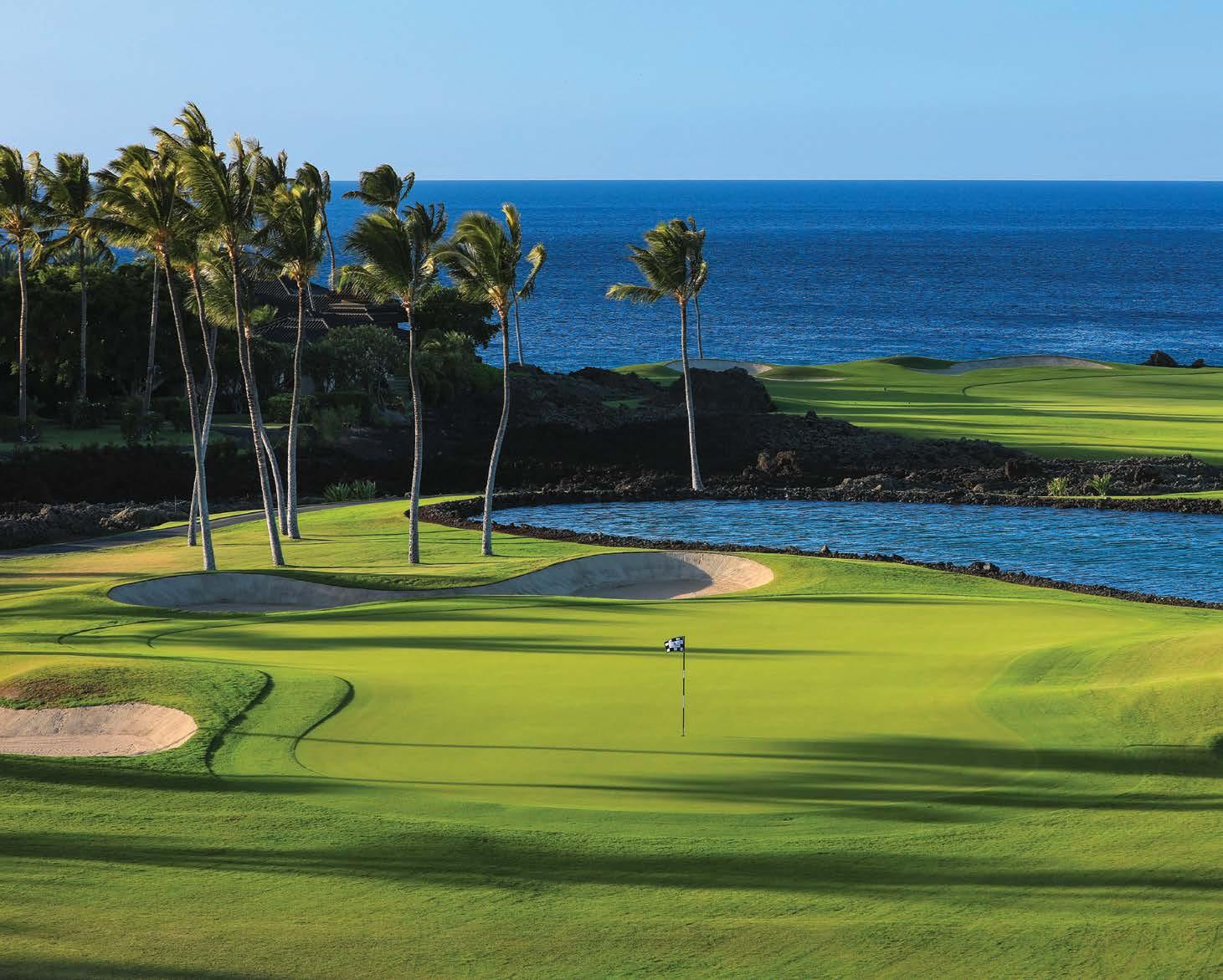
The distinctive design elements of this course combine to create a stunning natural tapestry on which your game thrives.
62-100 Kauna‘oa Dr, Kohala Coast 808-880-3000, maunakearesort.com/golf/ hapuna-golf-course
This private Jack Nicklaus course is home of the PGA Mitsubishi Electric Championship.
100 Ka‘ūpūlehu Dr, Kailua-Kona 808-325-8000, fourseasons.com/hualalai/golf/
Just six miles away from Kailua Village, the club features spectacular ocean views, excellent facilities and friendly service. Expect pleasant sunny skies and gentle ocean breezes and, between the months of December and May, keep a lookout for humpback whales in the distance.
78-7000 Ali‘i Dr, Kailua-Kona 808-322-2595, konagolf.com
The first resort course on the island and repeatedly on “Best Course” lists, this 18-hole resort course is demanding but rewarding if for nothing else than its breathtaking beauty.
62-100 Mauna Kea Beach Dr, Kohala Coast 808-882-5400, maunakeabeachhotel.com/golf/
Hawai‘i’s premier 27-hole golf experience — Beach Nine, Lakes Nine and Kings’ Nine.
69-600 Waikōloa Beach Dr, Kohala Coast 808-886-7888, waikoloabeachgolf.com
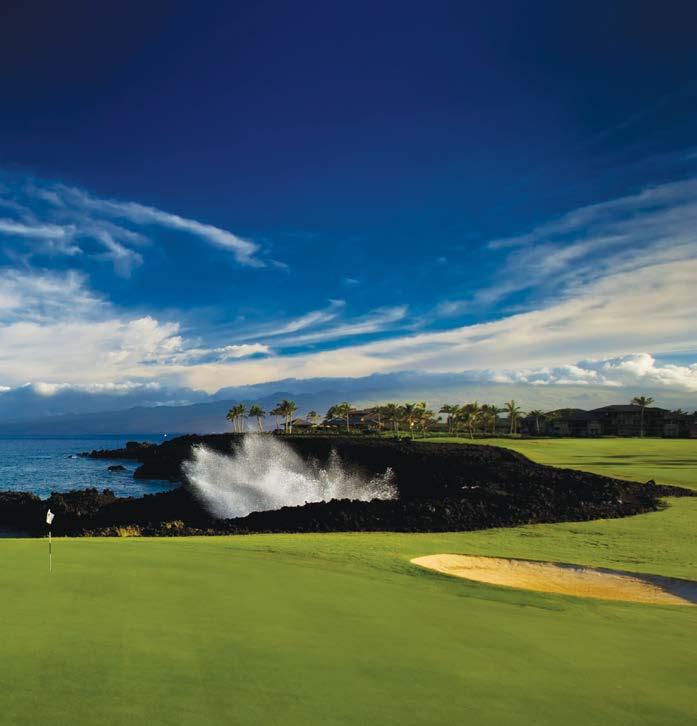
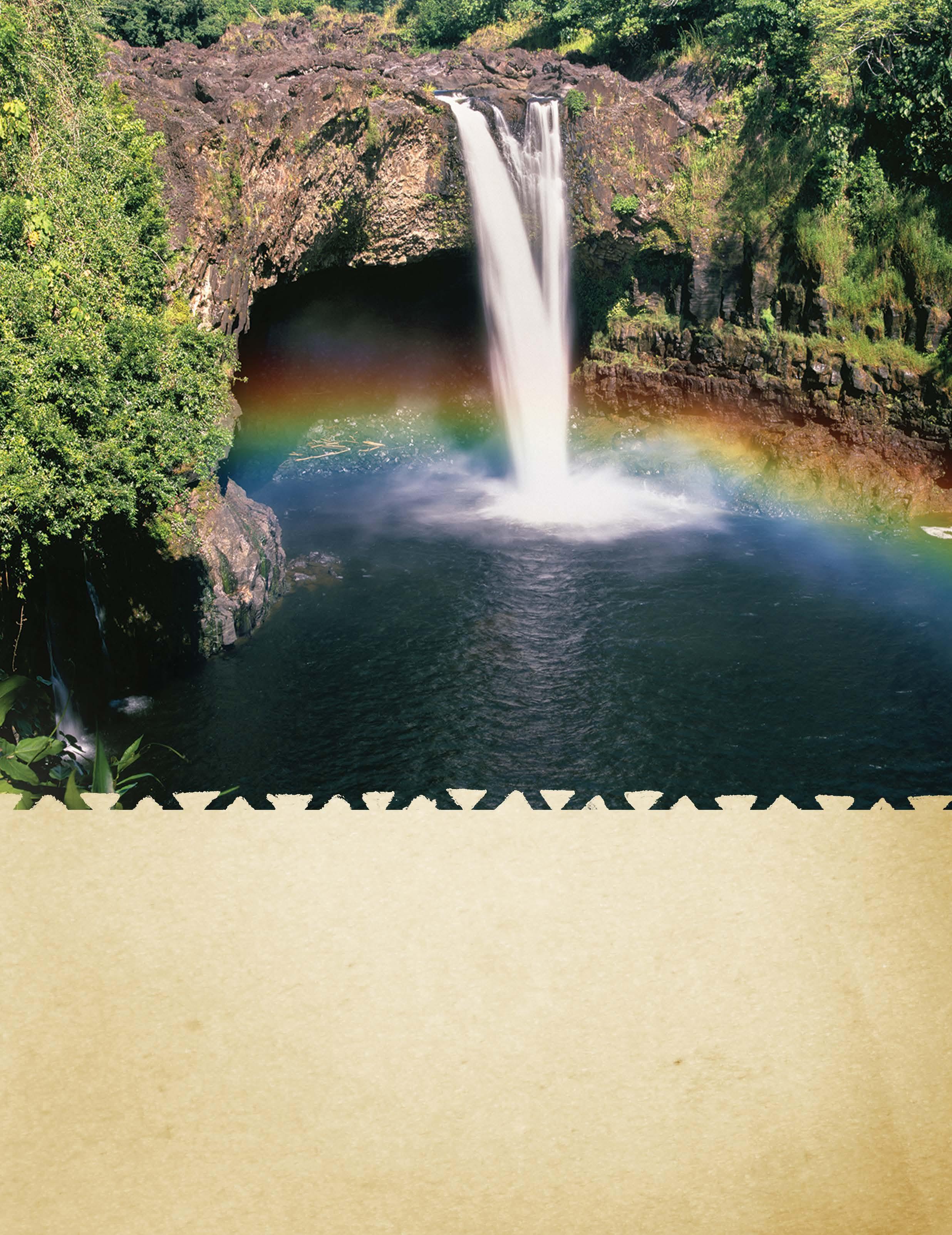


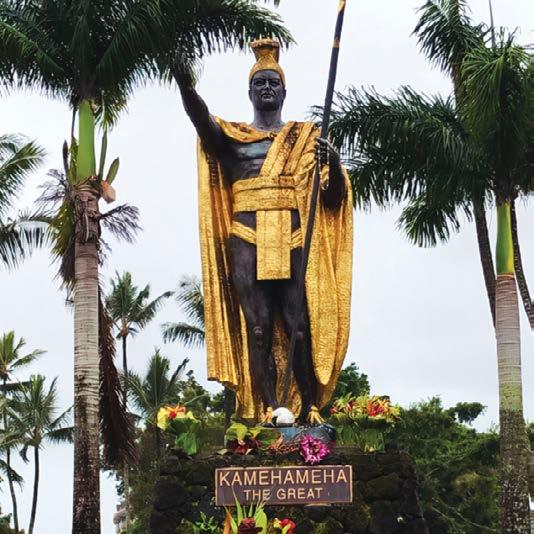
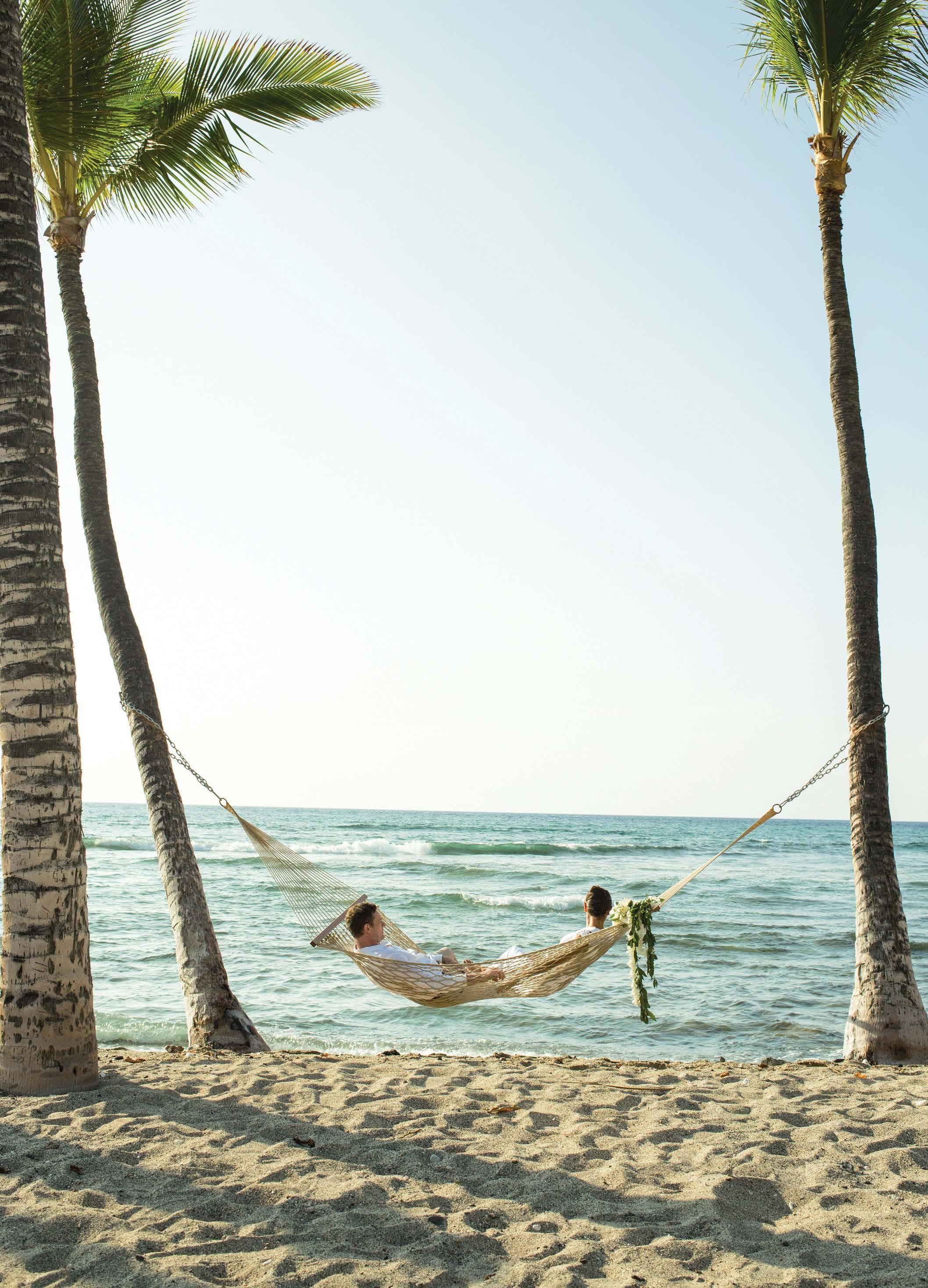
Ease
Experience the breadth of nature as you hike through the forest or walk along sunwarmed sands. Feel all of your tensions melt away within the soothing surroundings of a luxurious spa. Artists share with you their latest inspirations and charming boutique shops showcase local finds, while celebrated chefs tell the stories of Hawai‘i through the language of food. On an island where nature is so wonderfully intertwined with daily life, you’ll find yourself falling in love with Hawai‘i a million times over.

Together you’ll learn the language of flowers and the subtle messages of hula. You’ll lean side by side on a ship’s rail to watch dolphins leap toward the sunset. You’ll trace the outlines of constellations in the starlit night sky. You’ll sway to the mellow sounds of a slack-key guitar. From first love to renewed vows, the island of Hawai‘i is truly an island of romance.
LEFT TO RIGHT
COUPLE
COUPLE
Lose yourself in the island of Hawai‘i’s captivating beauty and create unforgettable moments of romance that will last a lifetime. Craft the perfect proposal story by popping the question after an afternoon exploring the island’s lush forests and dramatic waterfalls. Capture your affection in an amazingly romantic photo shoot set against the charming gardens and parks. Celebrate your love with a private barefoot ceremony on a secluded beach or an elegant formal affair at a private estate, intimate chapel or resort. Stay and revel in the ultimate honeymoon destination. Already married? Renew your vows or celebrate your anniversary on the stunning Pacific Ocean. The island of Hawai’i is the perfect setting for your romantic celebration.
For any person to lawfully marry in the State of Hawai‘i, a license for that purpose must be obtained from an authorized agent. Once the license has been issued, there is no waiting period before the marriage can take place. A marriage license and marriage certificate are two different documents. The marriage license permits a marriage to take place. The marriage certificate indicates that a legal marriage has been performed. For more information on requirements, steps to apply, cost or fees and eligibility, call 808-974-6008 or visit health.hawaii.gov/vitalrecords/ marriage-licenses
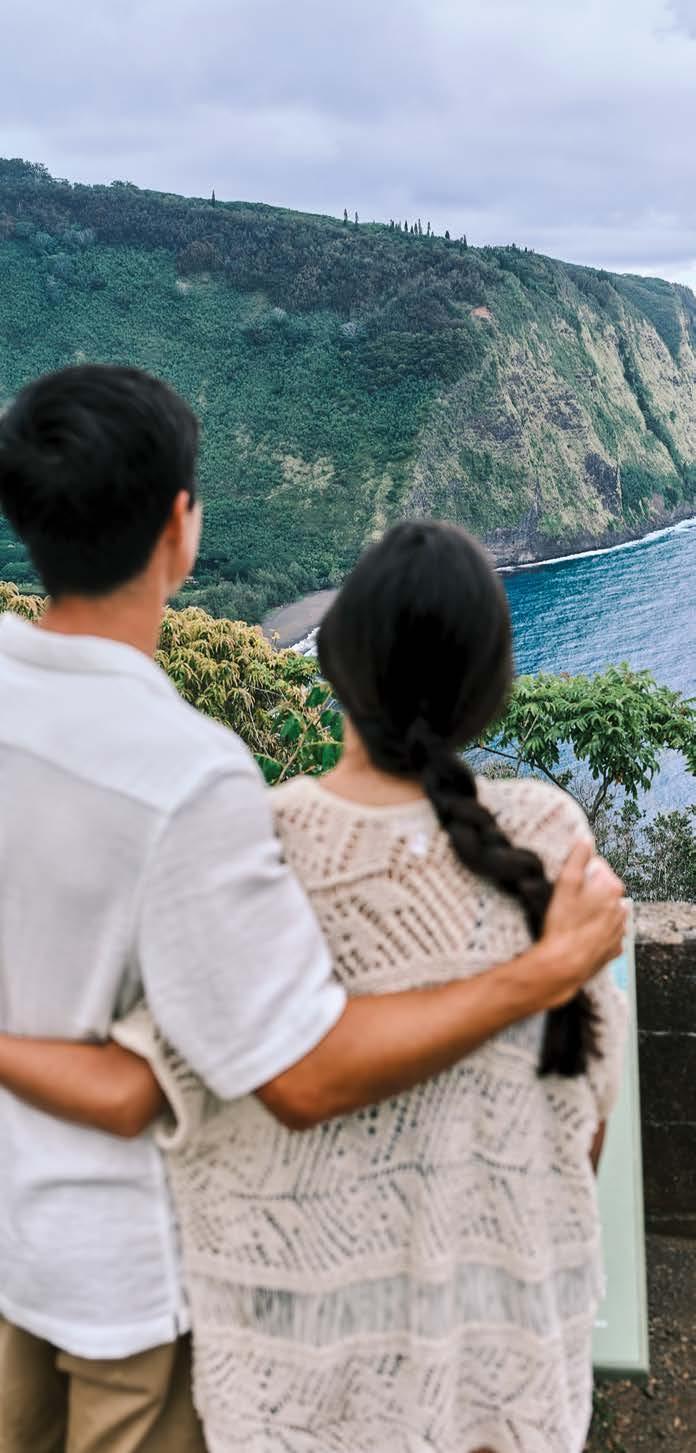
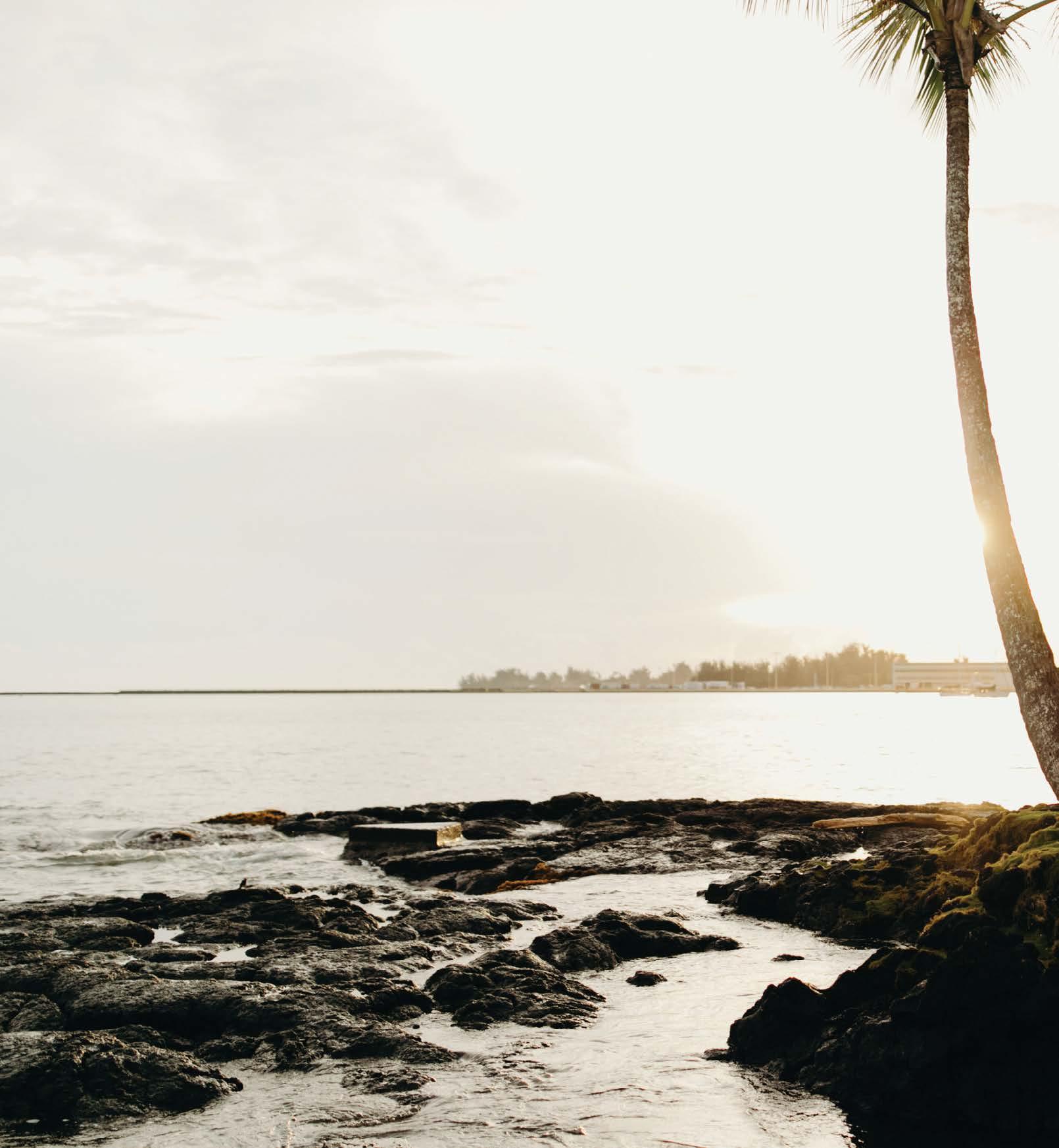
There’s something about the island of Hawai‘i that can make you fall in love all over again, with adventures both sensuous and sublime.
• Watch the sun sink into the blue Pacific Ocean, while you dig your toes into the sand.
• Get a couples massage (garden- or oceanside) at a spa.
• Hold hands while you snorkel amongst the colorful and playful tropical fishes.
• Dance underwater at night alongside graceful manta rays.
• Get lost in the rhythm of soothing Hawaiian music as you sip refreshing tropical beverages.
• Dine oceanside at one of the many fabulous restaurants.
• Enjoy the beauty of a horseback ride through acres of verdant pastureland.
• Sit at the shoreline of a white sandy beach and share a kiss while the pristine waves caress you.
• Surrender to the embrace of warm ocean breezes as you bid farewell to the day aboard a sunset catamaran sail.

A relaxing vacation to the island of Hawai‘i, often referred to as the “healing island,” wouldn’t be complete without at least one spa experience.
Pamper yourself with this traditional form of Hawaiian massage, which employs broad, flowing, rhythmic strokes to relax the body and nurture the spirit.
Hot rocks are used to massage and relieve sore, tight muscles.
A mineral-rich seaweed is applied to detoxify and stimulate circulation.
This traditional Japanese massage uses finger pressure to loosen tight muscles.
The ancient Japanese method of healing by touch.
Long, kneading, circular massage strokes are used to reduce tension.
Local ingredients like seaweed, papaya, kī (ti leaf), rose petals, honey, ginger, coffee and poi are used to renew, rejuvenate and stimulate circulation.
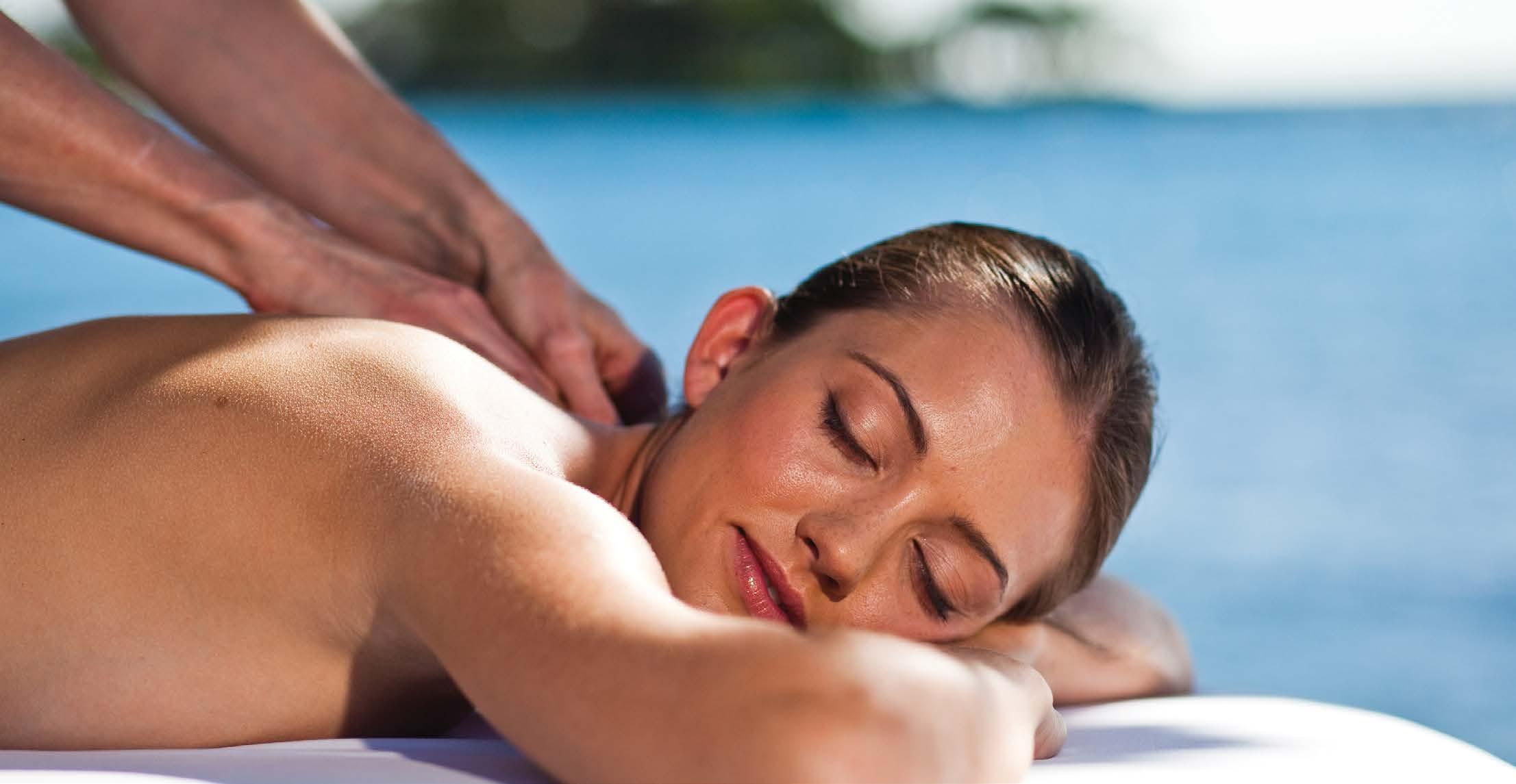
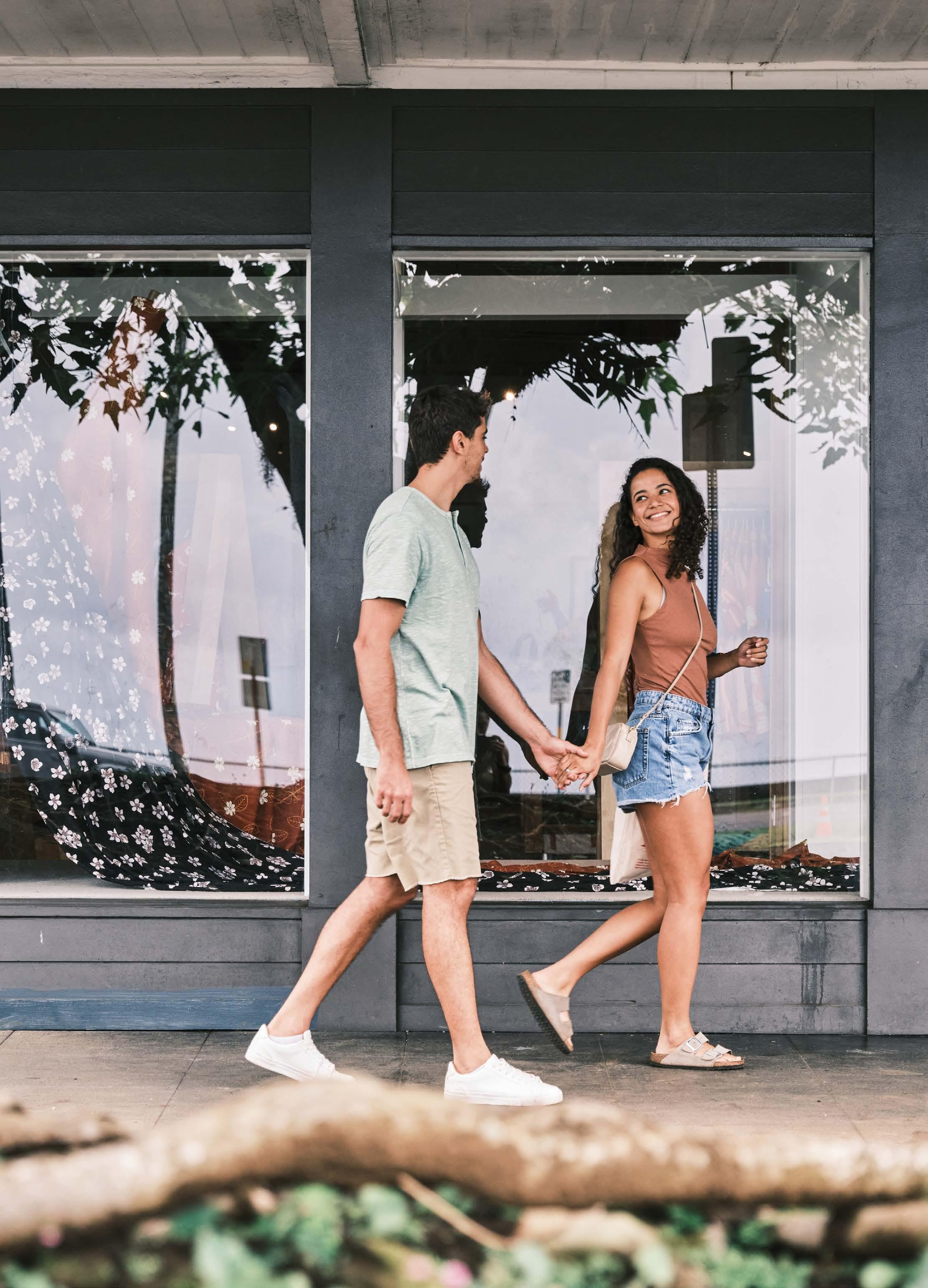
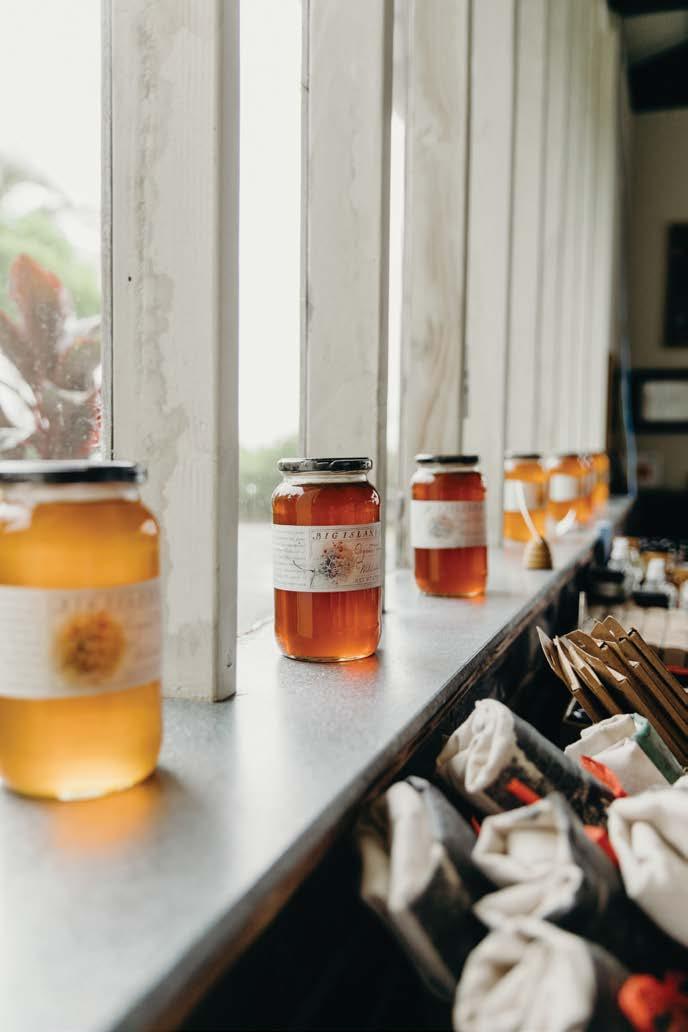
From vibrant farmers’ markets and local craft fairs to luxury boutiques and unique island-made products, shopping on Hawai‘i Island offers something for every traveler. Discover handmade jewelry, Kona coffee and authentic Hawaiian art while supporting local artisans and businesses. LEFT
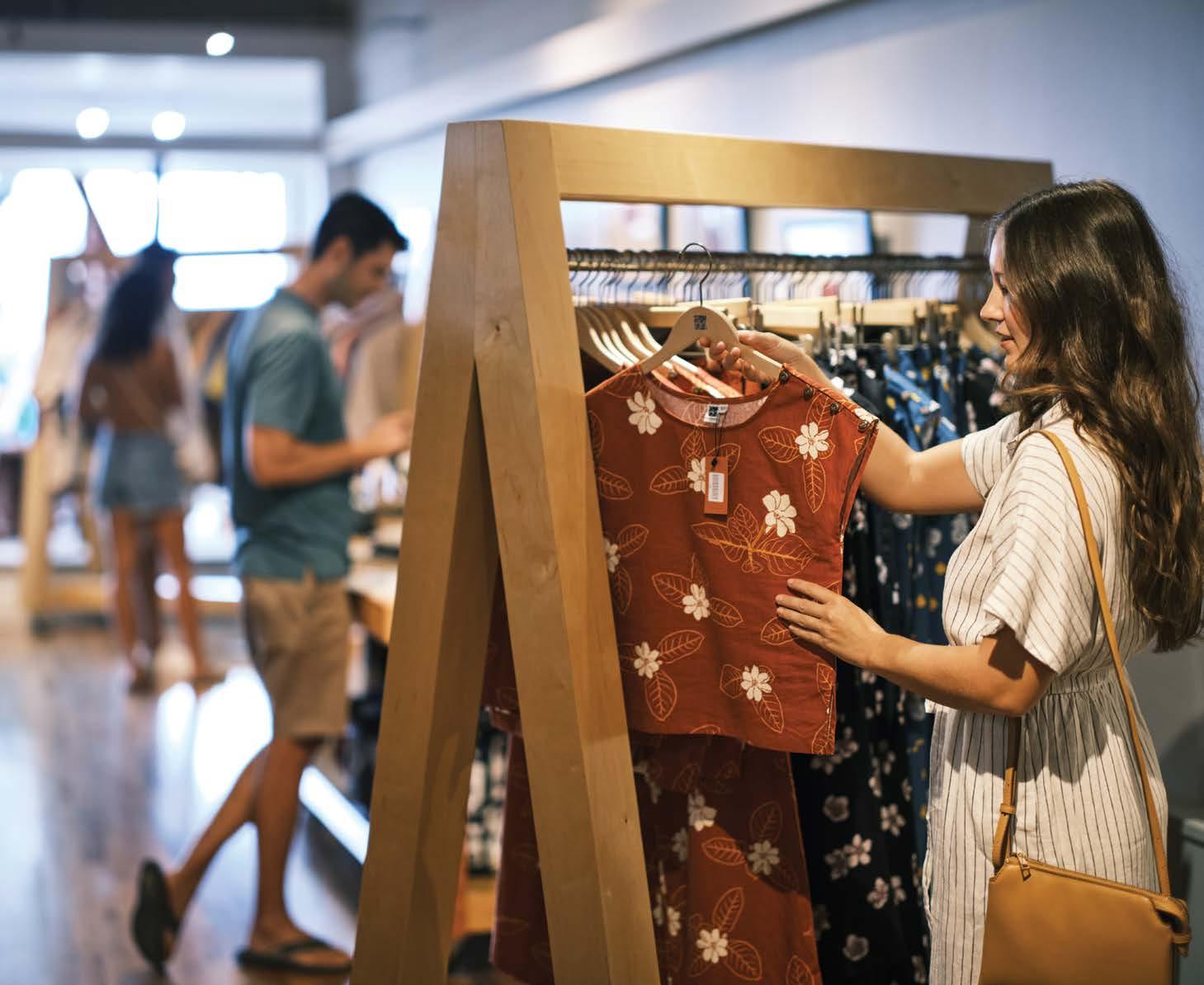
If you’re looking for a local treat or gift, one of the island’s farmers markets has got you covered. Try homemade jams and jellies on fresh artisan breads, or island-grown coffee or tea from the ma uka (upland) slopes. Find beautiful orchids (earning the island its nickname, “the Orchid Isle”), anthuriums, protea and ginger. There are many farmers markets around the island. Here are a few examples from each district.
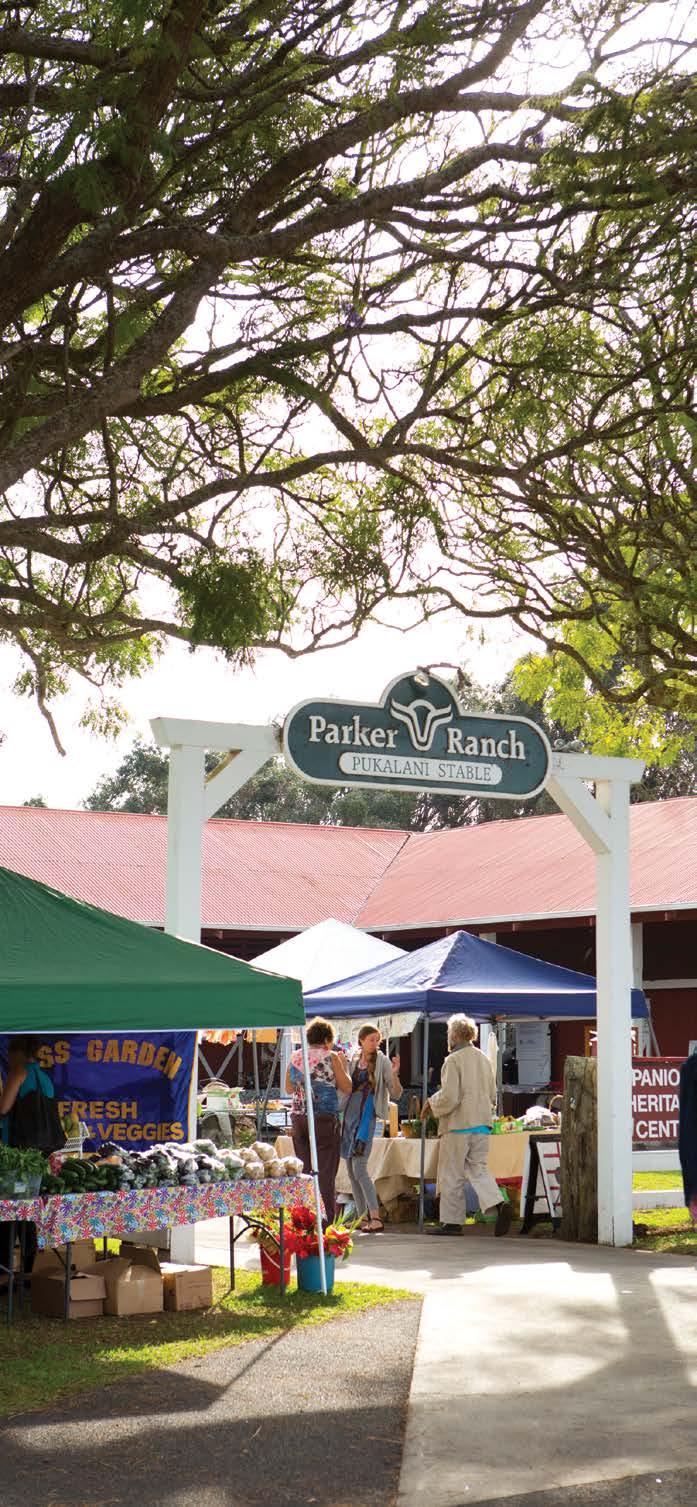
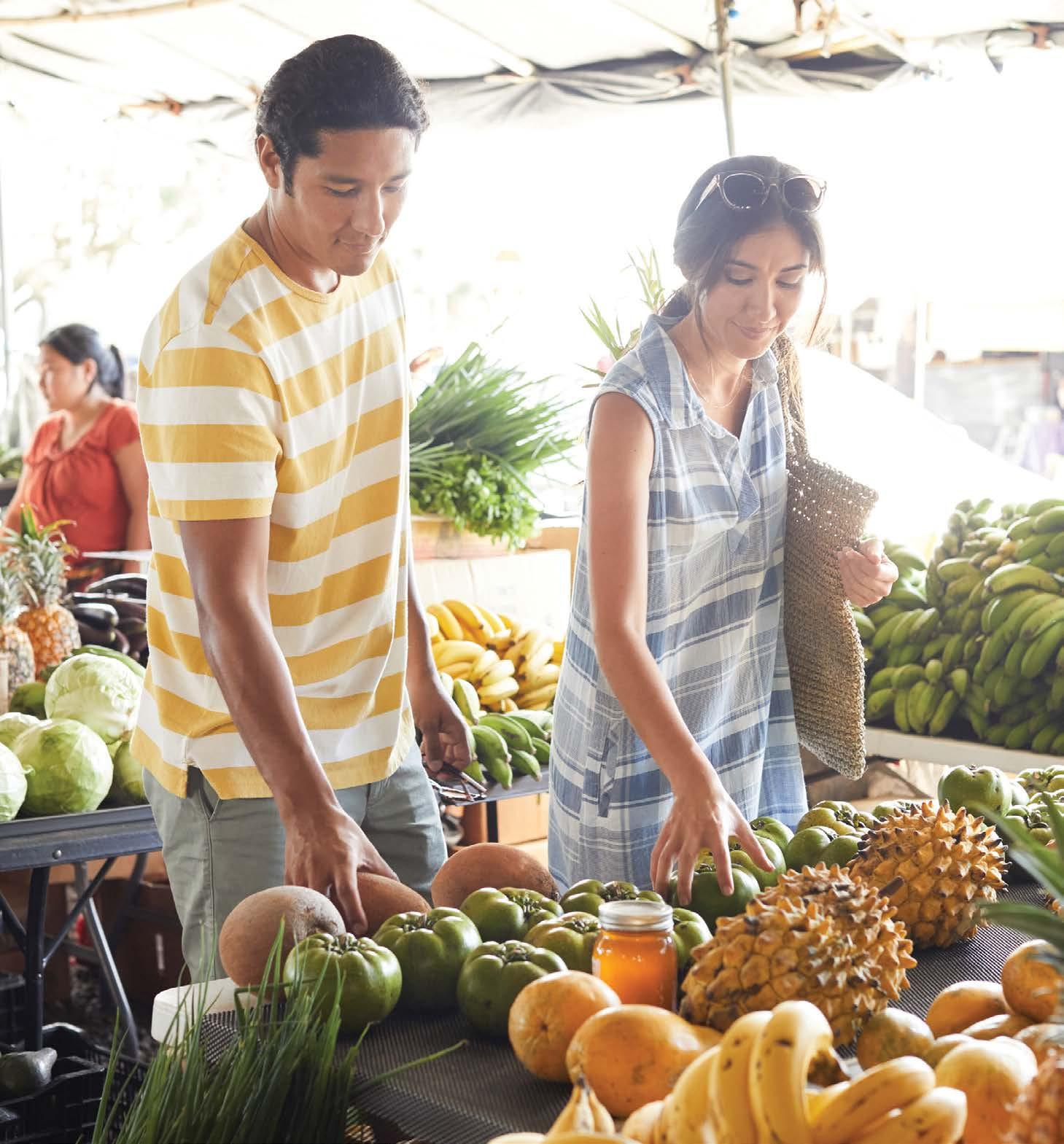
Keauhou Farmers Market keauhoufarmersmarket.com
Hilo Farmers Market hilofarmersmarket.com
Maku‘u Farmers Market makuu.org/makuu-market
Nā‘ālehu Farmers Market okaukakou.org/farmer-s-market

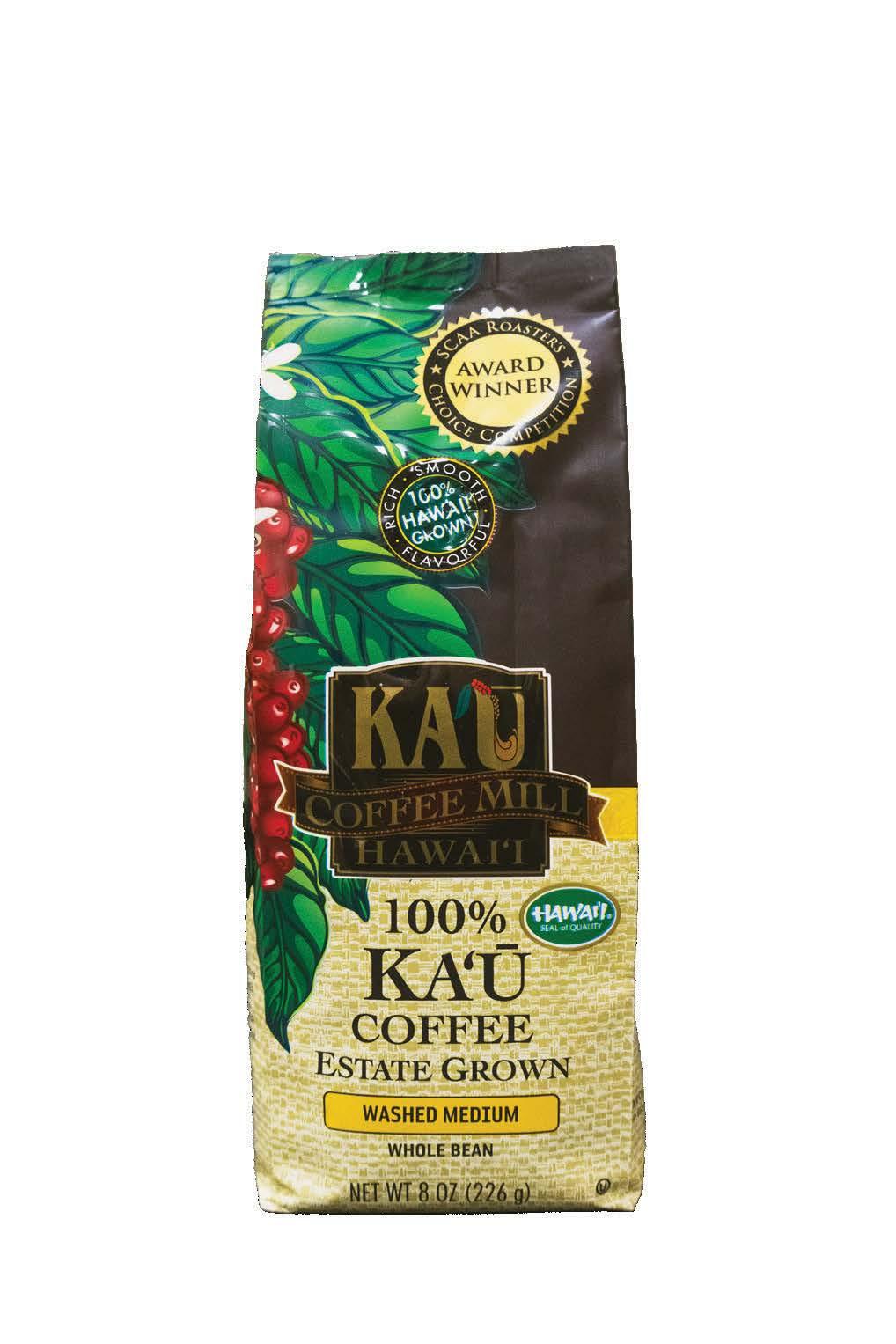
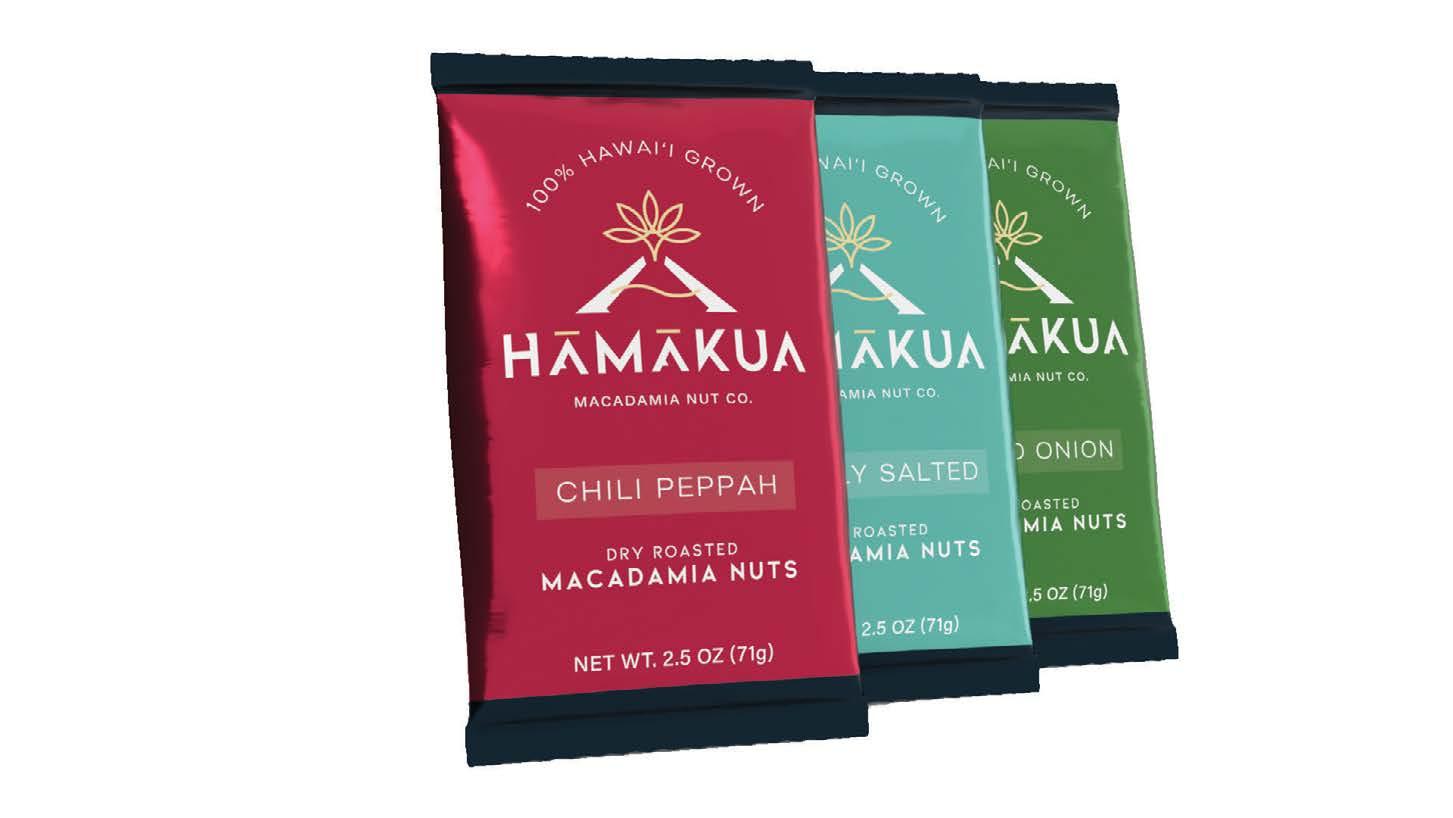



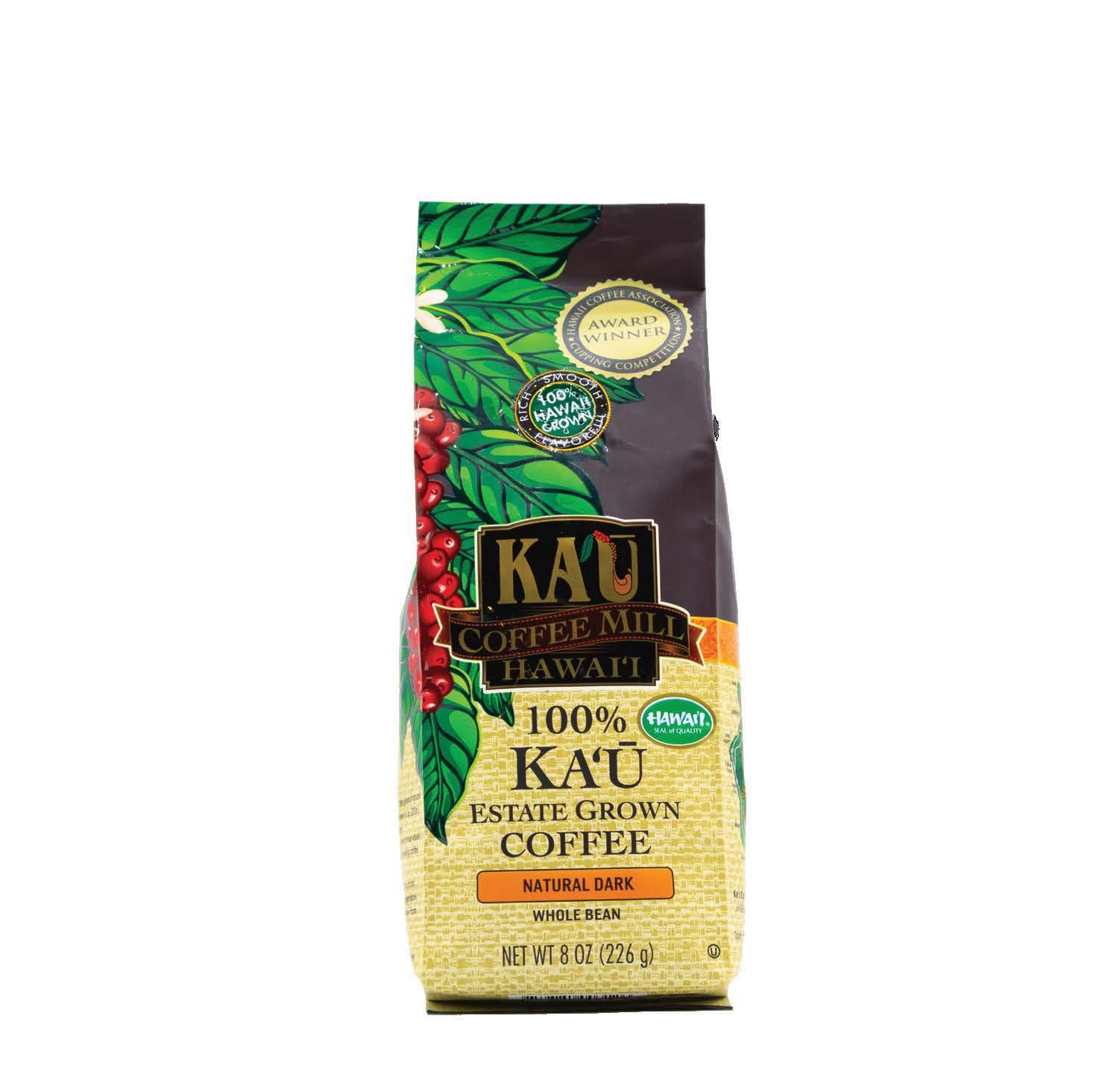



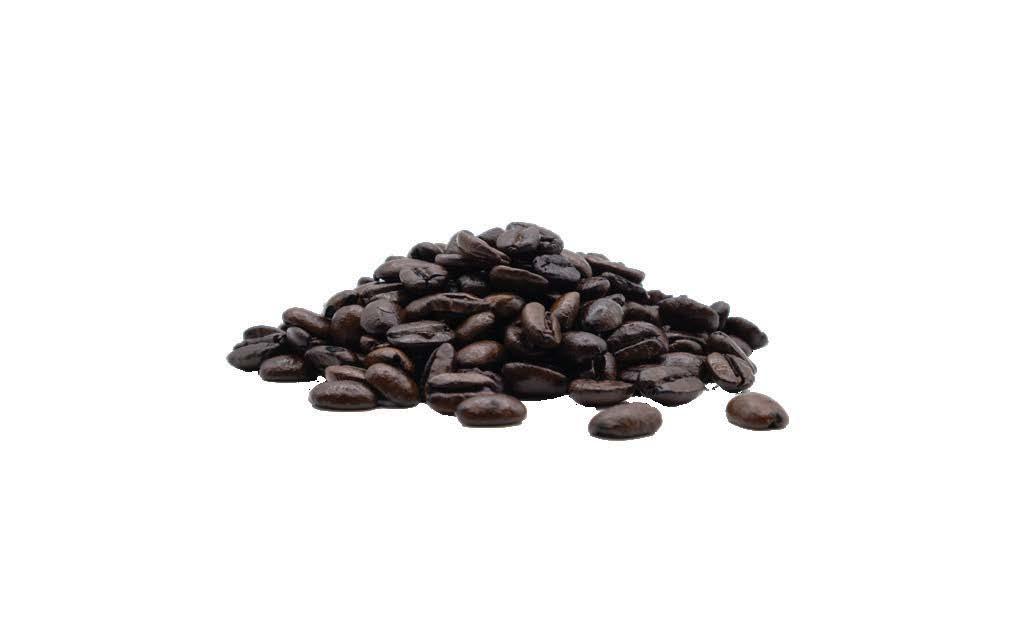
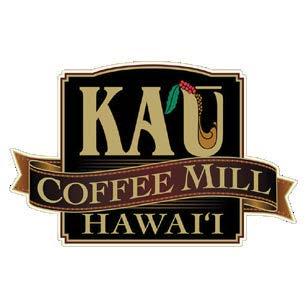
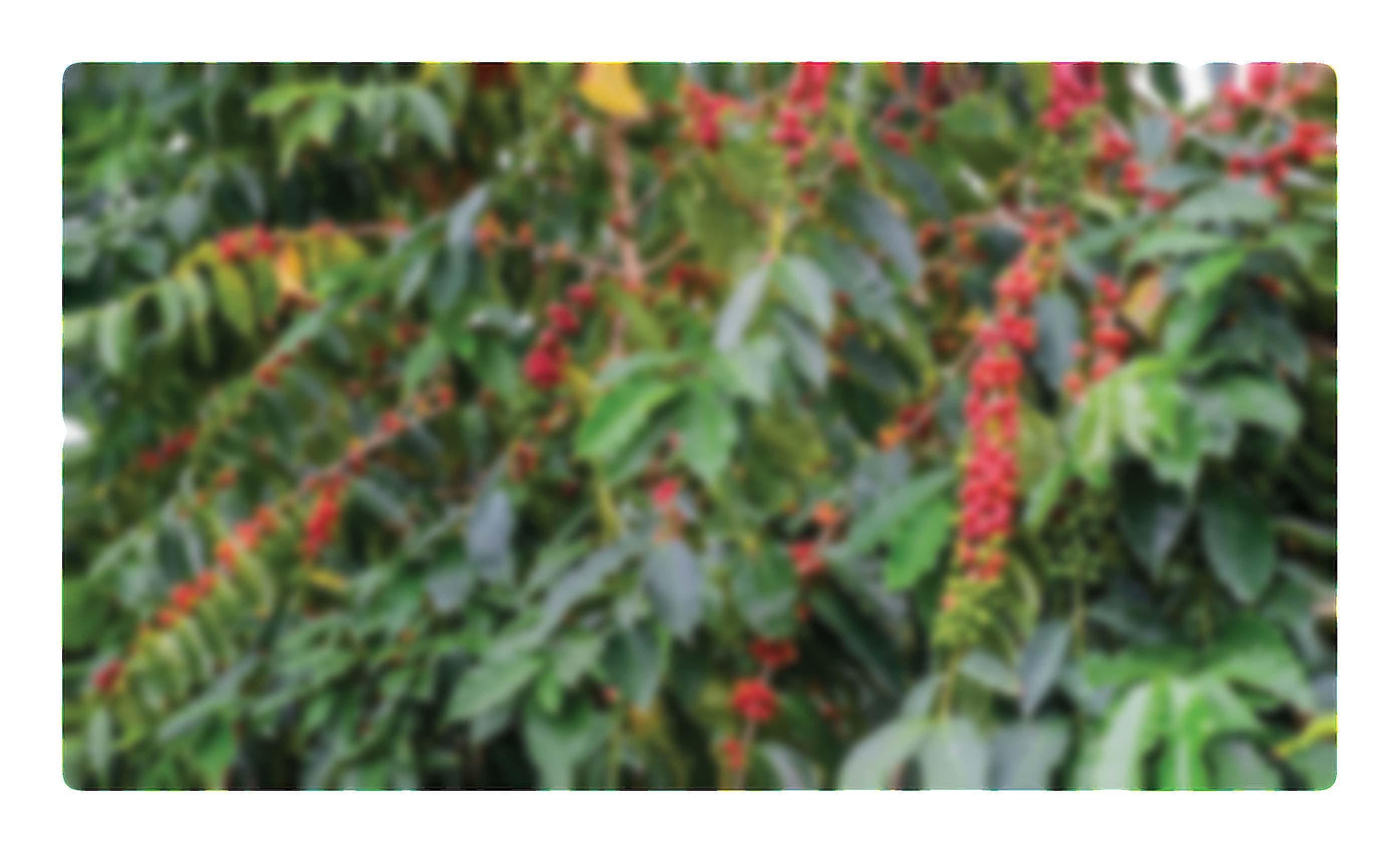
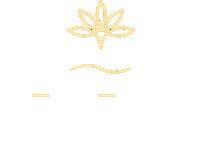
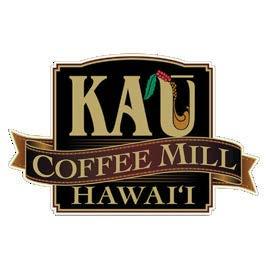
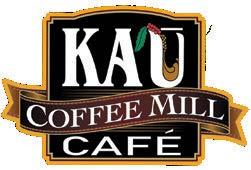
This place is a shopper’s paradise. When it comes to shopping on the island of Hawai‘i, here are the places you won’t want to miss.
Keauhou Shopping Center
Kona Commons
Lanihau Center
Kings’ Shops
Queens’ Marketplace queensmarketplace.com
The Shops at Mauna Lani
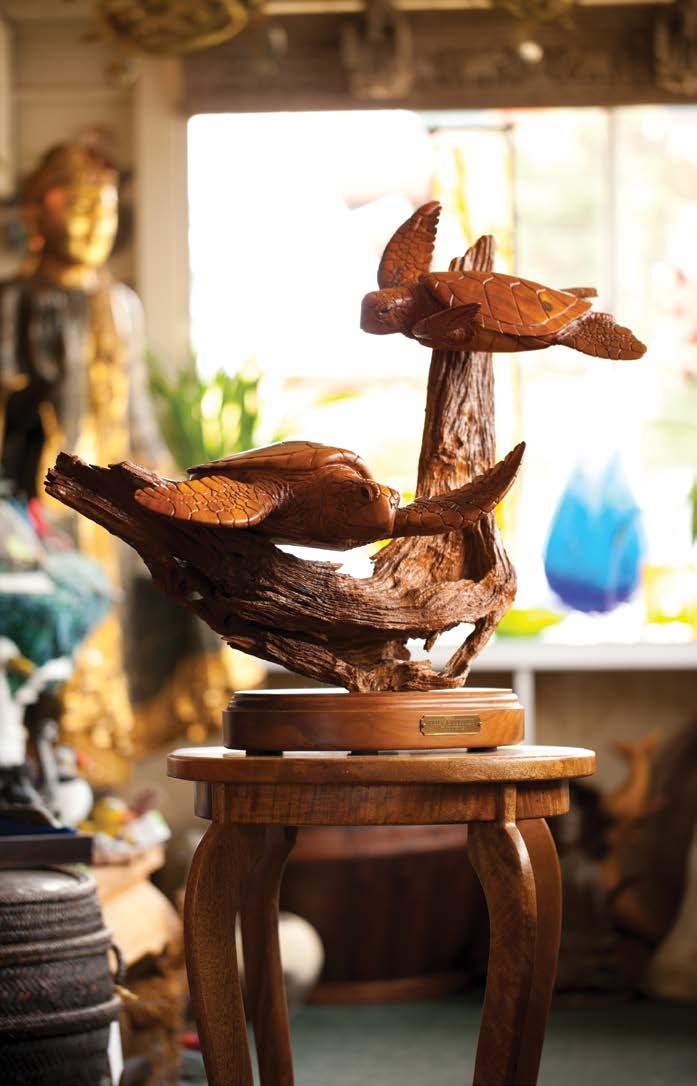
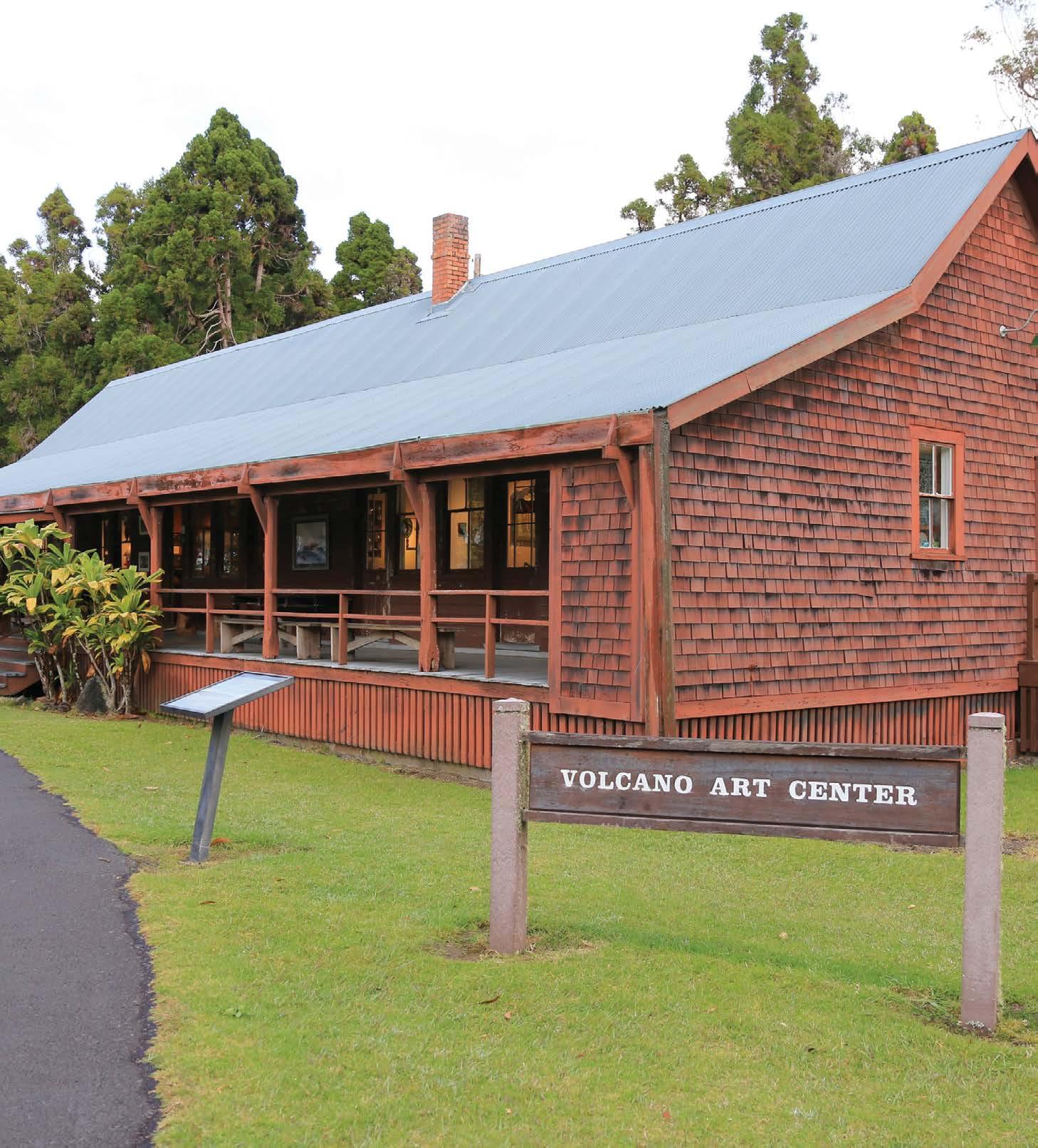
Waimea Center
Hilo
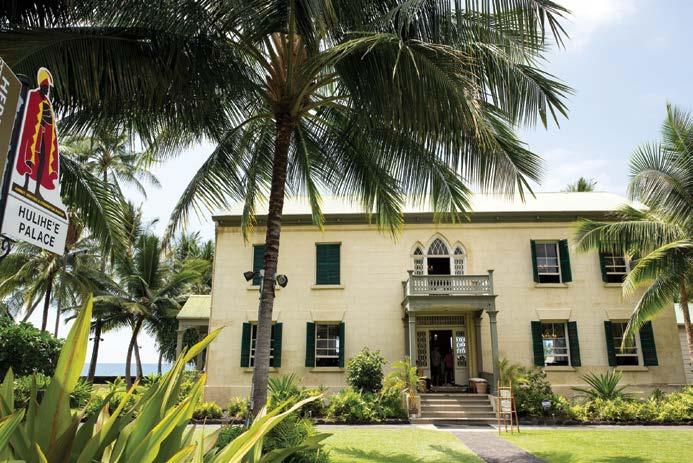
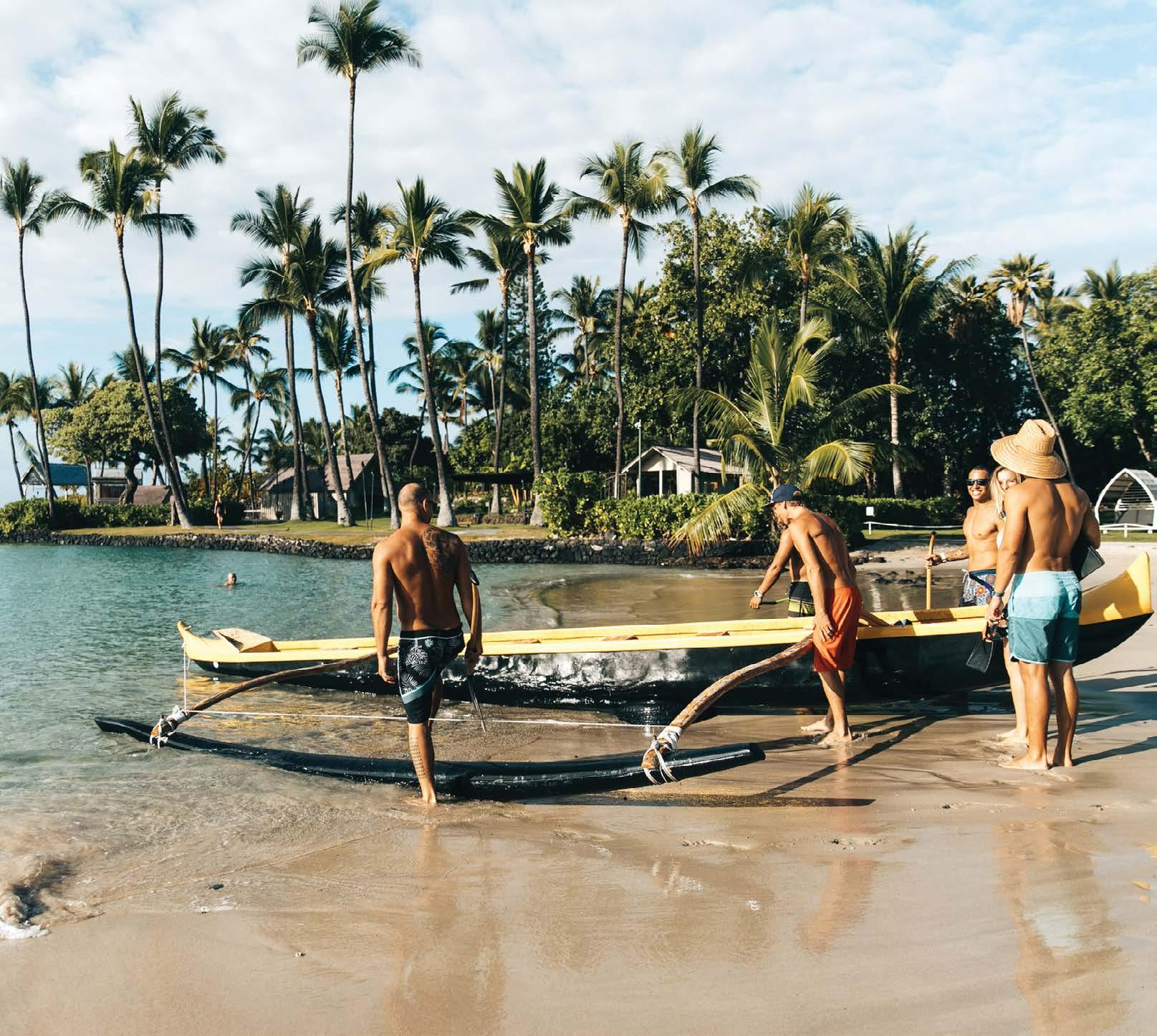
Historic Kailua Village is where culture, history, and island hospitality come together. Once the home of Hawaiian royalty, this charming seaside village invites visitors to slow down and experience the vibrant spirit of aloha and the Hawai‘i of yesteryear.
Begin your journey at Kamakahonu, a National Historic Landmark to see where King Kamehameha lived and ruled the Hawaiian kingdom. Kamakahonu is where the kapu system was broken and where the first Christian missionaries that came to Hawai‘i were allowed to come ashore.


Visit Hulihe‘e Palace, one of only three royal palaces in the United States. Discover authentic Hawaiian artifacts, walk in royal footsteps and see how Hawaiian royalty lived. Just steps away is Mokuaikaua Church, the first Christian church in Hawai‘i. Church services started here in 1820.
Historic Kailua Village is a paradise for food and coffee lovers. Enjoy everything from Kona coffee shops and casual cafes to stunning seaside dining all within walking distance. And remember, no visit is complete without an oceanfront luau with hula dancers and Hawaiian music.
Boutique shops and local art galleries line the waterfront, offering the perfect mix of Hawai‘i souvenirs and one-of-a-kind treasures.
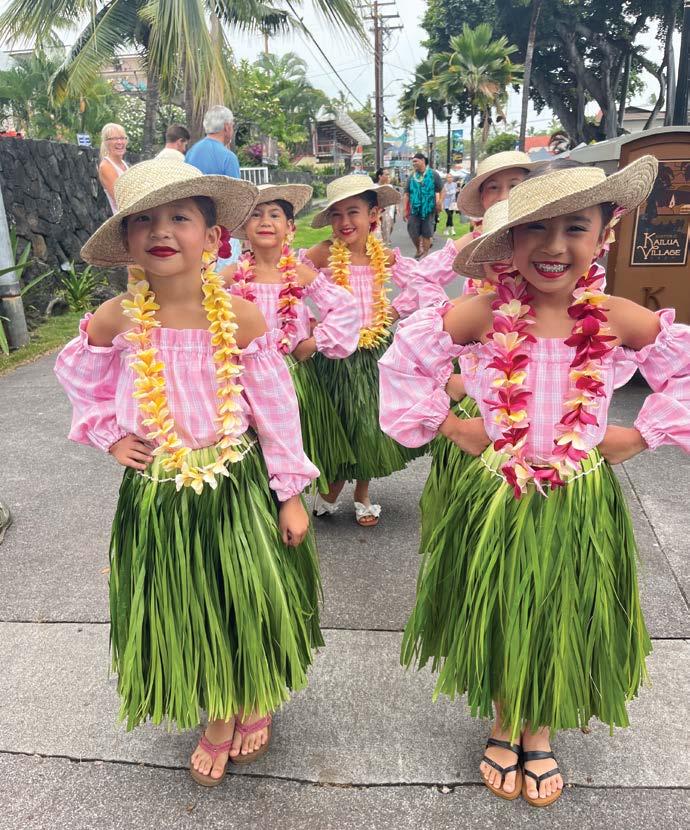
Iconic events including IRONMAN World Championship, Queen Liliuokalani Canoe Race, Hawaiian International Billfish Tournament and the Kona Coffee Cultural Festival make Historic Kailua Village home.
Kona is also world renown for some of the most mesmerizing sunsets in the world. As each day gently slips into twilight, take a front-row seat, grab a Mai Tai or your favorite umbrella drink and catch Kona’s famous sunsets.
Complete the evening with a seaside dining experience and stay in stunning accommodations in a picture postcard Hawai‘i setting in Historic Kailua Village.
Learn more at HistoricKailuaVillage.com
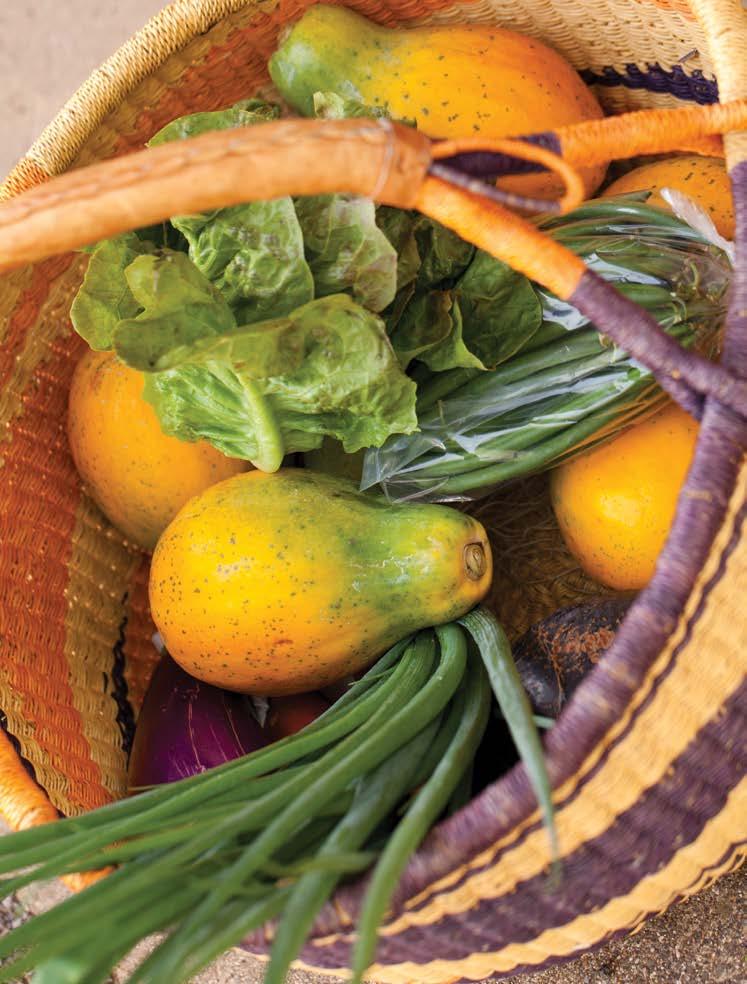


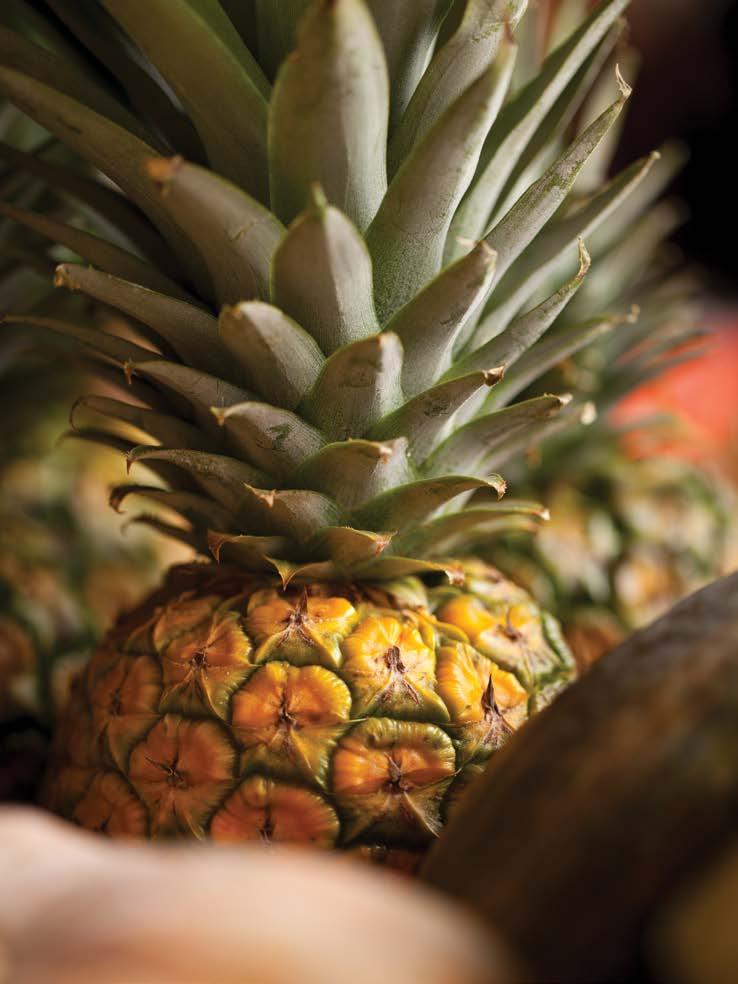


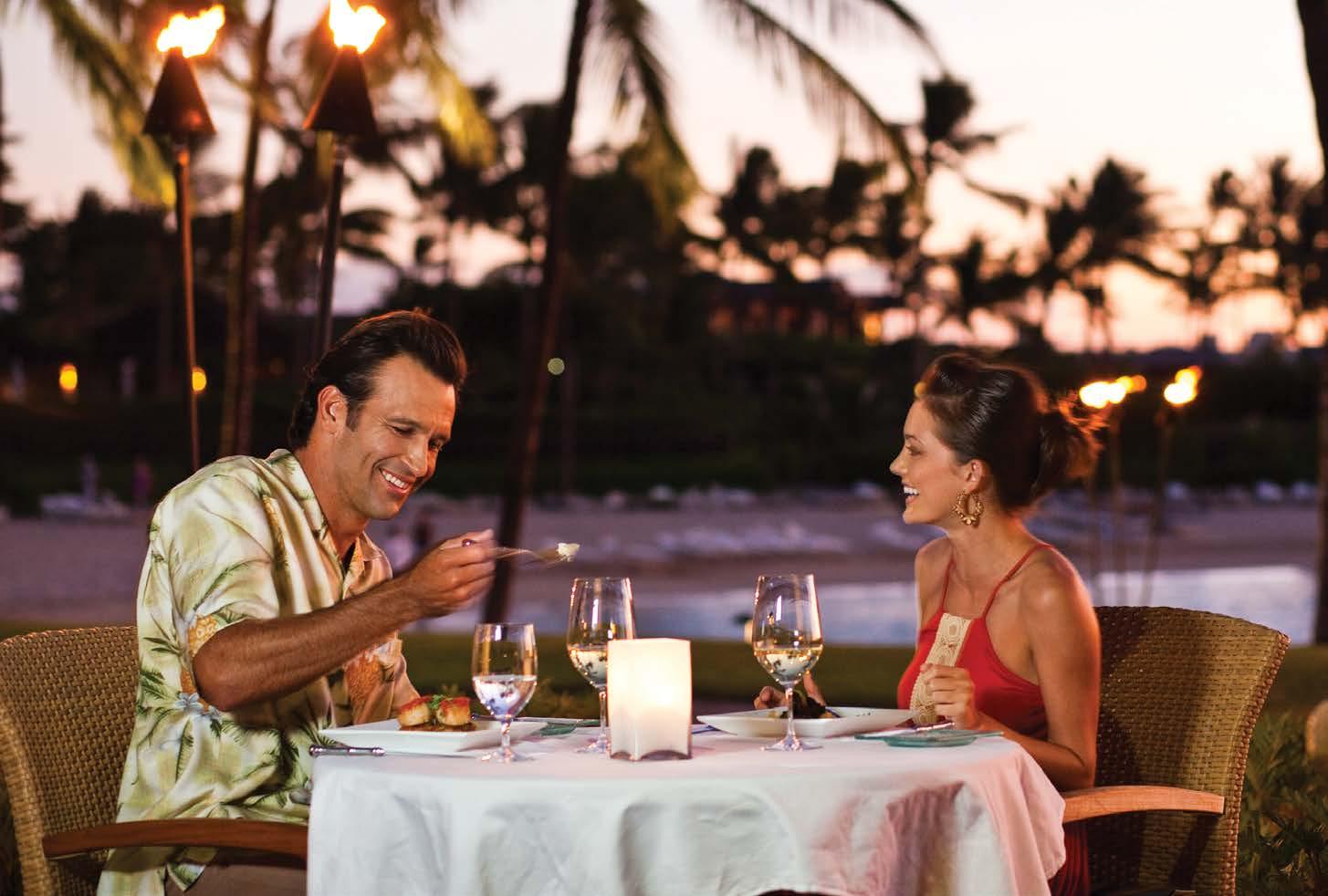
If you thought the hike was challenging, what about choosing among the island’s many dining choices? They boast fresh ingredients, delightful flavors and settings beyond compare. From your first cup of island coffee to your last chocolatecovered macadamia nut, your days on the island of Hawai‘i are sure to be simply delicious.
It’s likely you know that farmers on the island of Hawai‘i grow acres of macadamia nuts, brilliant tropical flowers and some of the world’s most award-winning coffee. But did you know that island growers, ranchers and ocean farmers also produce prized cacao and vanilla beans, spices, singular honey varieties and acclaimed seafood? And that’s not everything. Read on.
In addition to bags of 100 percent Kona coffee, grown on the cloud-level slopes of Hualālai volcano, non-blended beans from the island’s Puna, Hilo, Hāmākua and Ka‘ū districts are popular luggage fillers of coffee connoisseurs. In recent years, roasts of Ka‘ū district beans have won numerous awards from coffee experts worldwide. Many island growers offer educational farm tours and
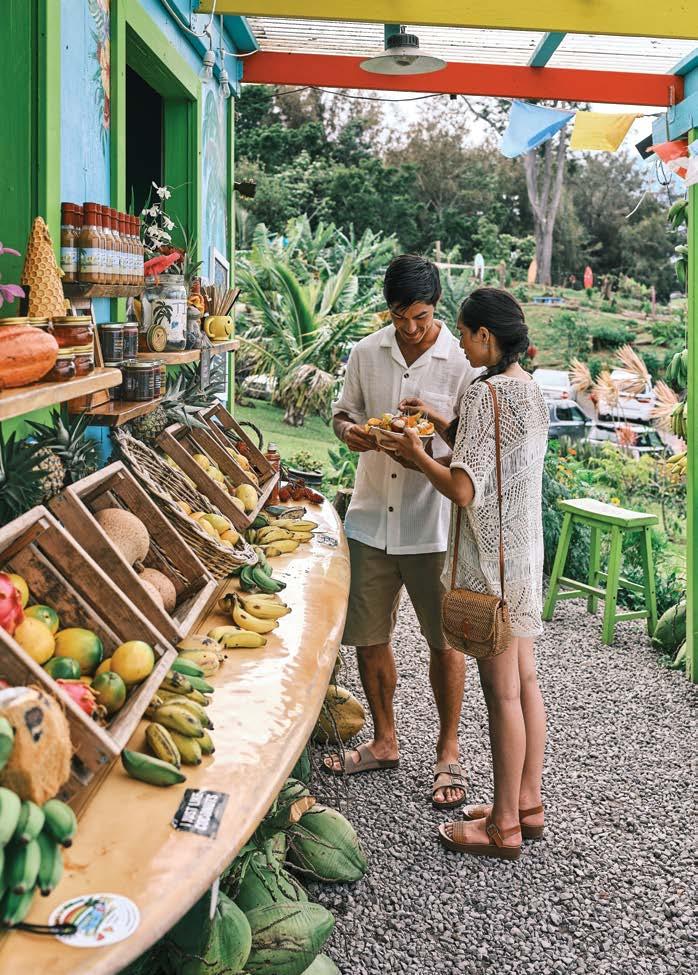

tastings of their coffees. Annual festivals in Kona and Ka‘ū celebrate each district’s roasts with food, entertainment and, of course, lots of java. You can also sample island-grown tea — green, black, white and Hawai‘i’s own māmaki tea.
Several botanical gardens and farms, especially on the island of Hawai‘i’s rain-kissed east side, offer visitors opportunities to get up close and personal with a profusion of tropical flora varieties. Looking to take home potted orchids or send fresh-cut protea, multiple varieties of hearty anthuriums or other tropical flowers? Most growers excel at shipping and packing even the most delicate flora for travel, like Green Point Nurseries store.greenpointnursery.com. Hawai‘i Island is home to the lion’s share of floral producers in the state. Also, check out the Hilo Orchid Society and Kona Orchid Society for events and offerings.
Macadamia nut farms on the island of Hawai‘i range from small, family-run operations to largescale growers who also craft a variety of “mac nut” edibles shipped worldwide. From chocolate-covered mac nuts to an array of flavored nuts, including jalapeño, wasabi, SPAM® and Kona Coffee, you can enjoy sweet and savory mac nuts by visiting local shops or ordering online.
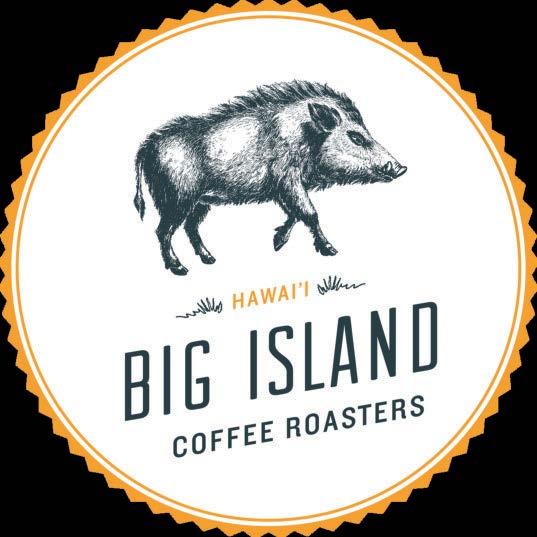
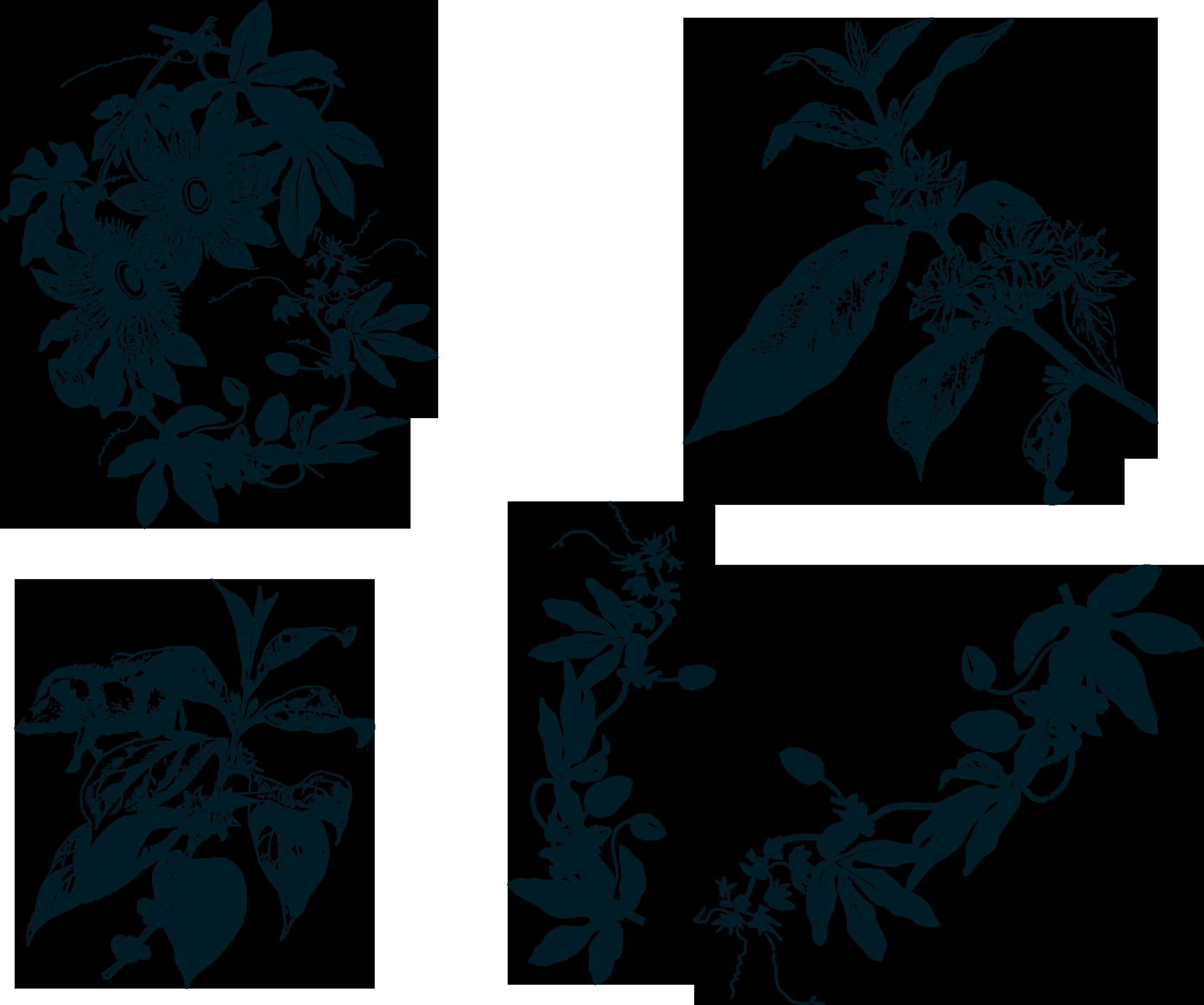



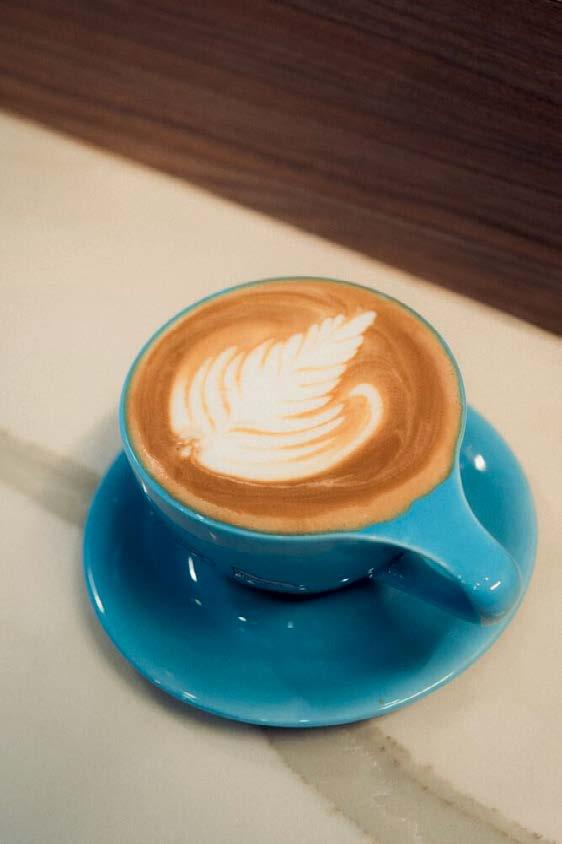
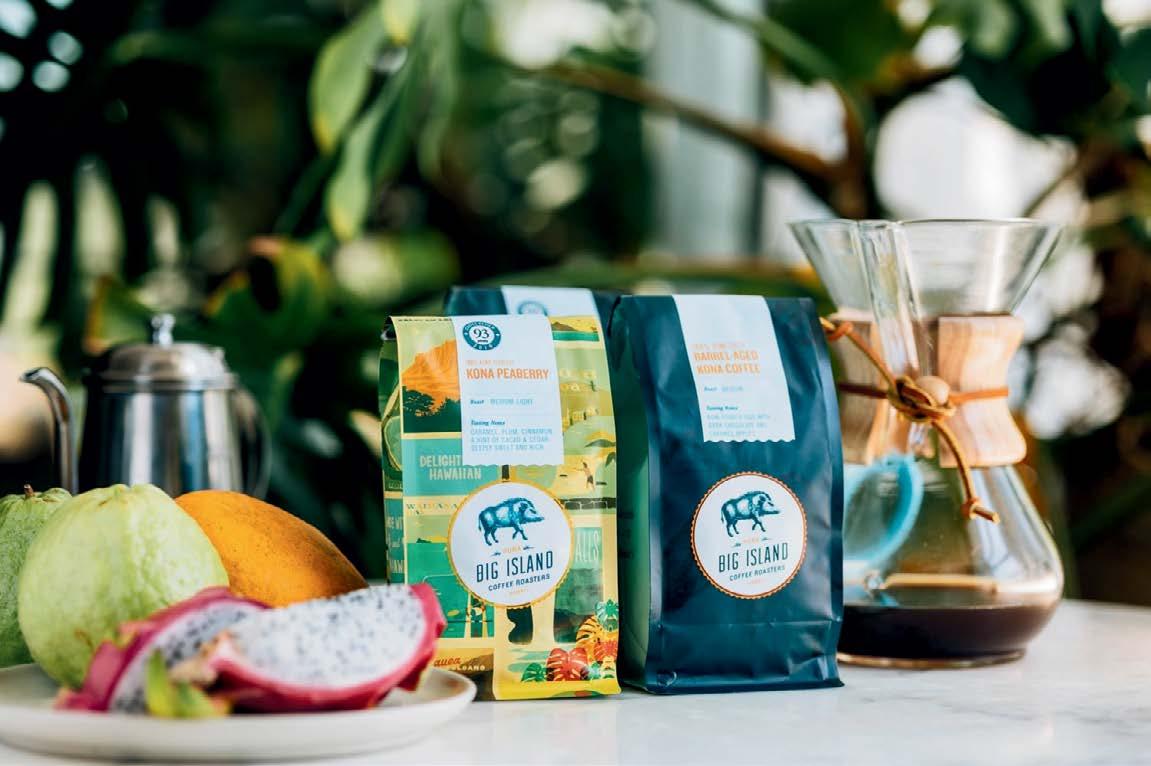


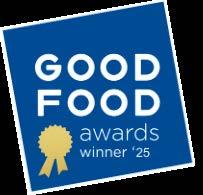


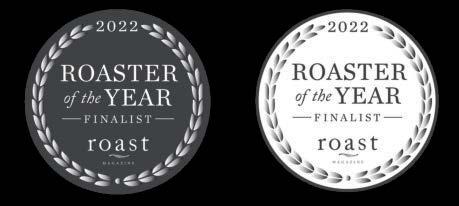
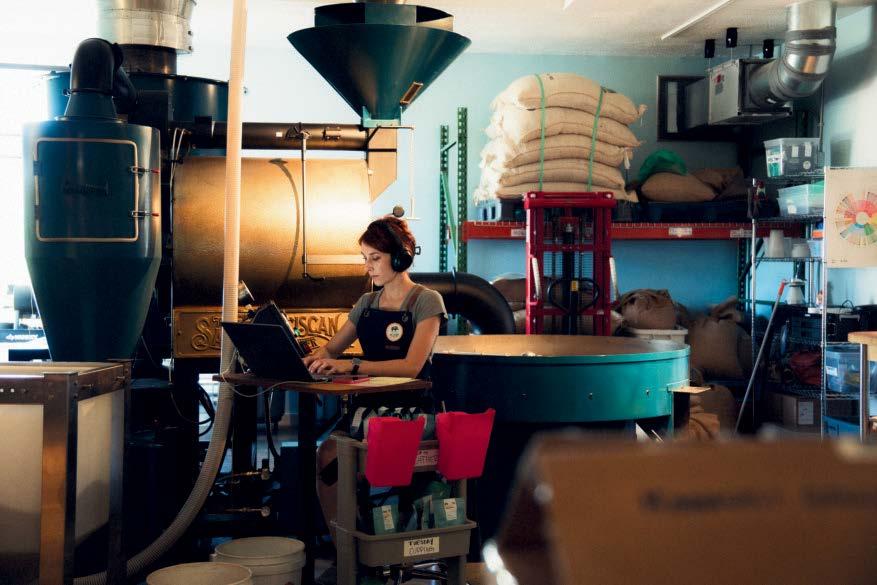



Did you know that before Western contact, Native Hawaiians traditionally practiced sustainable aquatic farming? Hawaiian Ocean Science and Technology Park (HOST), just south of Ellison Onizuka Kona International Airport at Keāhole (KOA), provides space for modern-day aquaculture and mariculture organizations to conduct pioneering work, utilizing deep sea water delivered from pipelines positioned at depths of up to 3,000 feet. Some of the products include lobster, seaweed, abalone, black cod (butterfish), sea salt, world-renowned kampachi and more for local and international consumption. Some facilities offer tours.
The latest trend? Sip on Hawai‘i Island craft brews and ciders made especially with local fruits and ingredients. Venture to the Kuleana Rum Shack to experience rich and elegant rums, carefully crafted using 40 varieties of kō, Hawaiian heirloom sugarcane. Cheers!
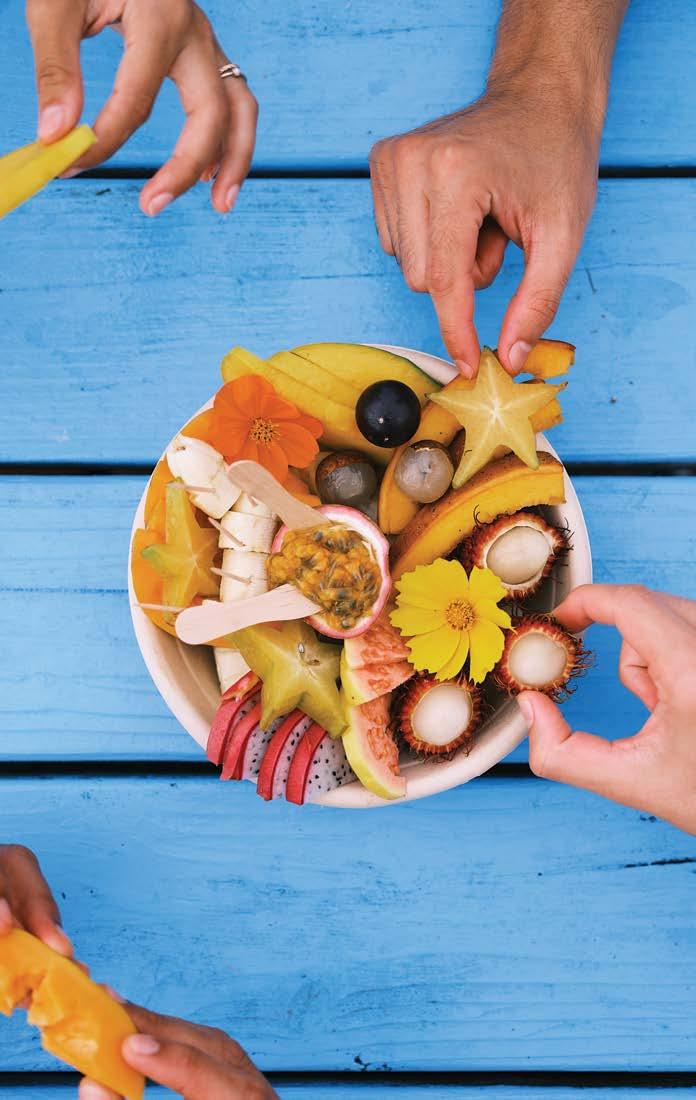
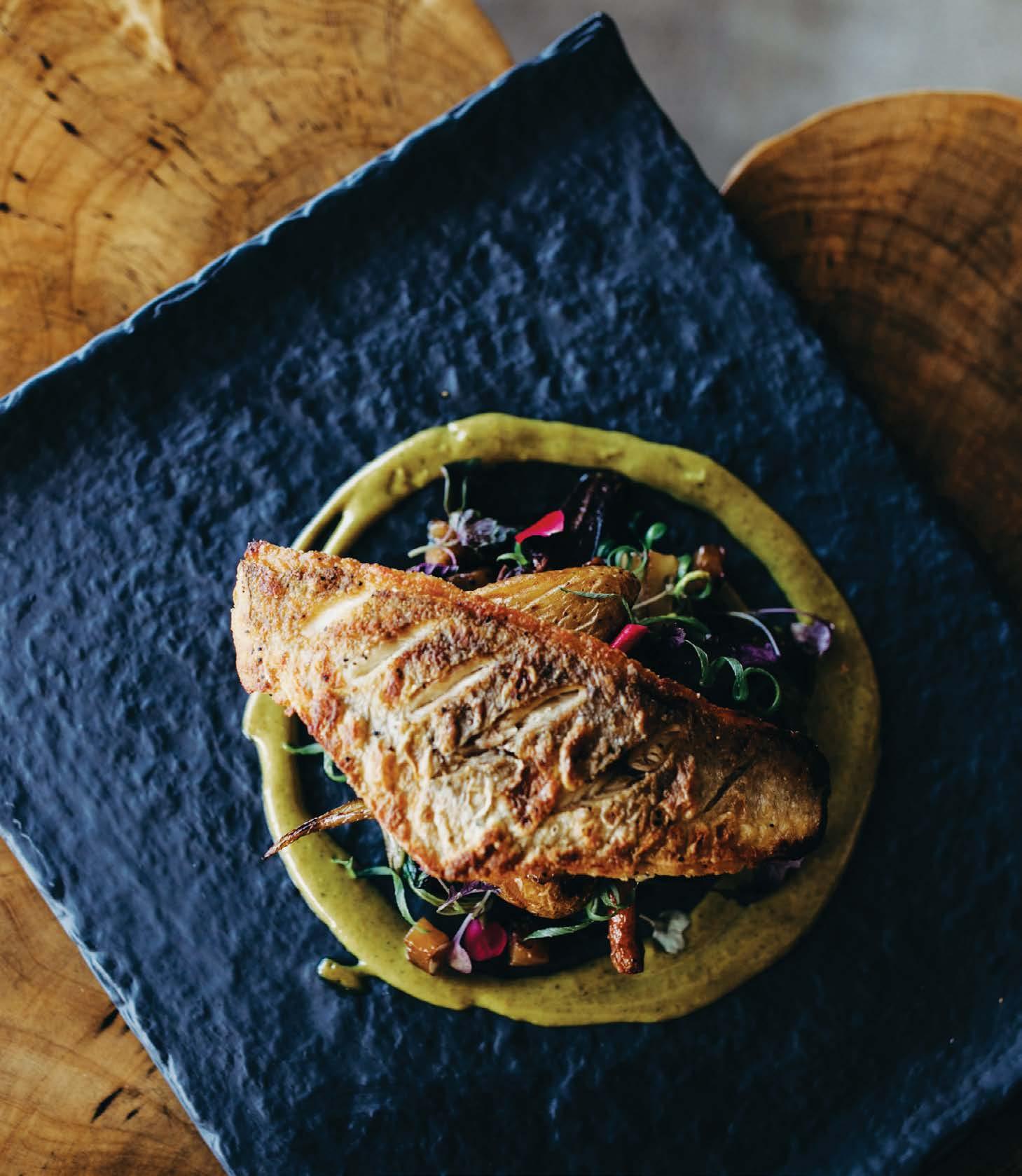
Liliko‘i. Pohā and ‘ōhelo berries. Jaboticaba. Mountain apple. Tahitian lime. Lychee. Papaya. Mango. ‘Ulu (breadfruit). Rambutan. Avocado (over 200 varieties of avocado exist in the Hawaiian Islands, with some weighing in at six pounds!). The island of Hawai‘i’s vast agricultural acreage offers smaller-scale farmers ample room to experiment with micro-orchards of these specialized fruit varieties and more for jellies, jams, marmalades and chutneys. Many island-grown tropical fruits even find their way into the dough of bakery-fresh loaves of Portuguese sweet bread and warm malasadas. And grapes, grown on vines at the 4,000-foot elevation of Kīlauea volcano, bring a unique flavor to the vintages produced by a volcano-area winery.
Small- and large-scale growers are embracing the island’s sweeping acreage and diverse climate zones to raise all types of crops, taking their fresh-picked produce straight to consumers and chefs. Farmers markets are plentiful throughout Hawai‘i Island, offering everything from hō‘i‘o (fern shoots) and heirloom tomatoes to microgreens and cucumbers. Plus, multi-farm tours allow visitors to sample fresh produce while soaking in scenery and local history.
With its long ranching history and more ranchlands than its neighbor islands, it’s no surprise the island of Hawai‘i produces much of the
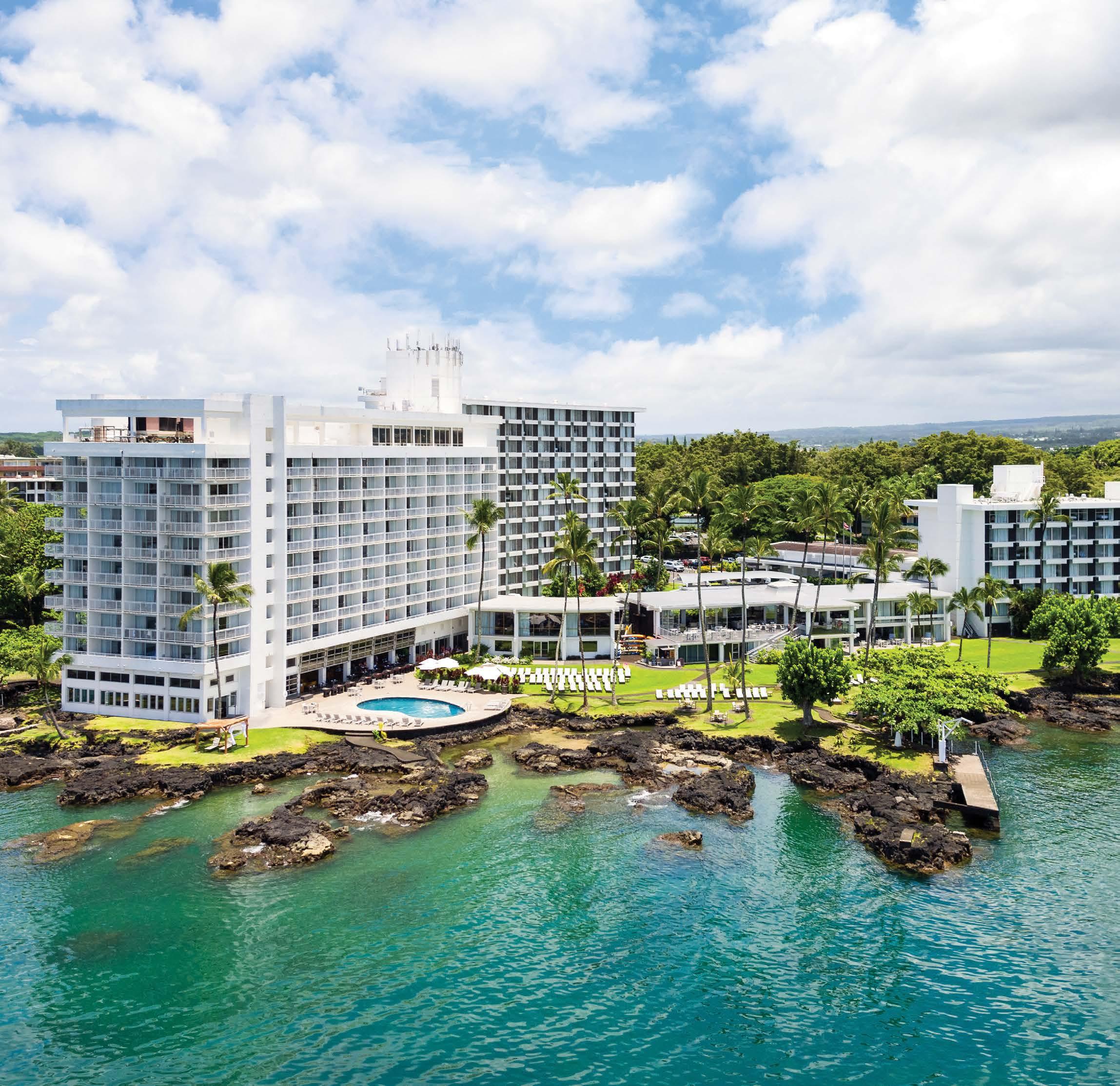
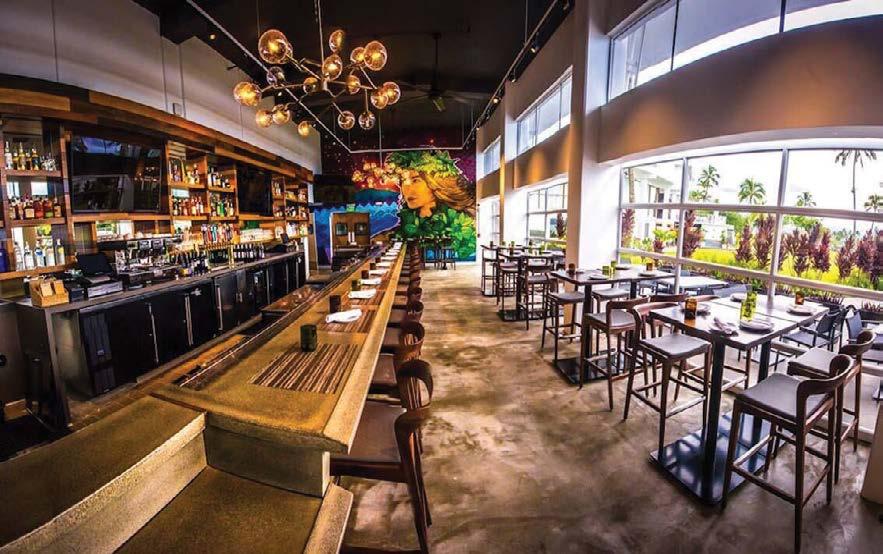
state’s pasture-raised beef. Praised for its leanness, juiciness when grilled and naturally savory flavor, grass-fed beef from the island of Hawai‘i is found on restaurant menus and in supermarkets state-wide.
The island of Hawai‘i is home to several honey producers, crafting ambrosial large- and smallbatch products from hives located throughout the island. But where island apiarists truly excel are varieties of honey brought to market — a result of the landscape’s many beeenticing nectar sources. At retailers, farmers markets and a few Kohala Coast resorts, you’ll find different types of organic honey naturally infused with hints of kiawe, lehua, macadamia nut and other blossoms in familiar gold and crystallized white varieties. Several farms offer no-stings-guaranteed tours of hives and processing facilities.
Home kitchen and restaurant chefs across the islands scoop up the flavorful, wonderfully meaty gourmet fungi from local farms and
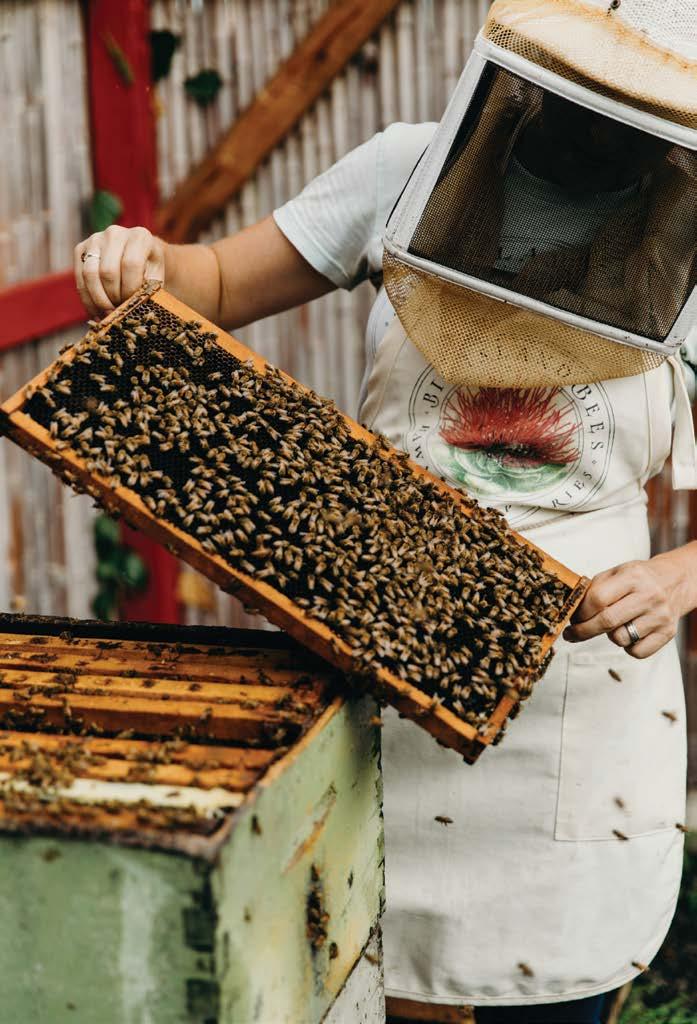

growers as fast as they can get them. Hawai‘i Island-grown mushrooms are a favorite of chefs and fungi aficionados.
In the only U.S. state where cacao is grown commercially, artisanal single-origin chocolate made from cacao beans grown on small farms on the island of Hawai‘i is fast becoming one of the most in-demand types among connoisseurs. You can learn about — and, better still, taste — the array of chocolate produced by the island’s expanding cacao industry at the annual Big Island Chocolate Festival or by touring one of the island’s larger farms. Or simply purchase a bar of island-made chocolate and share it with your friends — or not!
A lively celebration of food and entertainment, as well as lessons on Hawaiian and other Polynesian cultures, are the featured fare at a lū‘au Feast on delicious Hawaiian-inspired dishes, like kālua pork (cooked in a traditional earth
oven), laulau (seasoned pork or beef and fish steamed in lū‘au (young kalo/taro leaves) and kī (ti leaves) and poi, a Hawaiian staple made of pounded kalo corms. Open your eyes, ears and stomach to all that Hawai‘i has to share.
Outrigger Kona Resort and Spa outrigger.com/hawaii/hawaii-big-island/ outrigger-kona-resort-and-spa/fooddrink/feast-fire-luau
Mauna Lani, Auberge Resorts Collection maunalaniluau.com
Hawai‘i Loa Lū‘au
Fairmont Orchid 808-887-7320 hawaiiloaluau.com
Kauhale Kanaka o Puna 808-960-3893 imumeaai.com
Island Breeze Lū‘au — He ‘Ohana Kākou
Courtyard Marriott King Kamehameha’s Kona Beach Hotel 1-866-482-9775 islandbreezeluau.com
Royal Kona Resort royalkona.com/luau
Hilton Waikoloa Village 808-886-1234 hilton.com/en/hotels/koahwhh-hiltonwaikoloa-village/luau
The Mauna Kea Lū‘au
Mauna Kea Beach Hotel, Kohala Coast 808-882-5707 maunakearesort.com/dine/signature/ mauna-kea-luau
Waikoloa Beach Marriott Resort & Spa, Waikoloa 808-886-6789 thesunsetluau.com
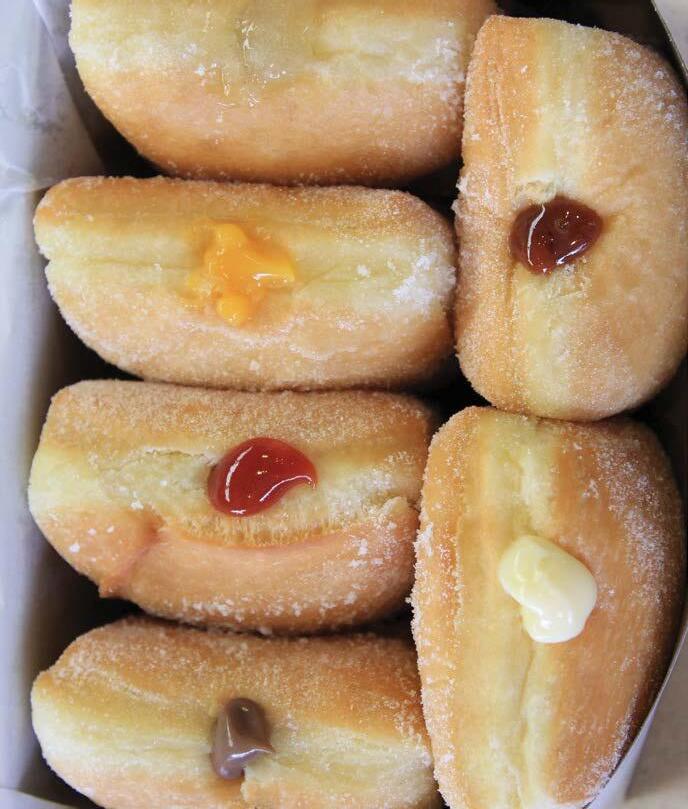
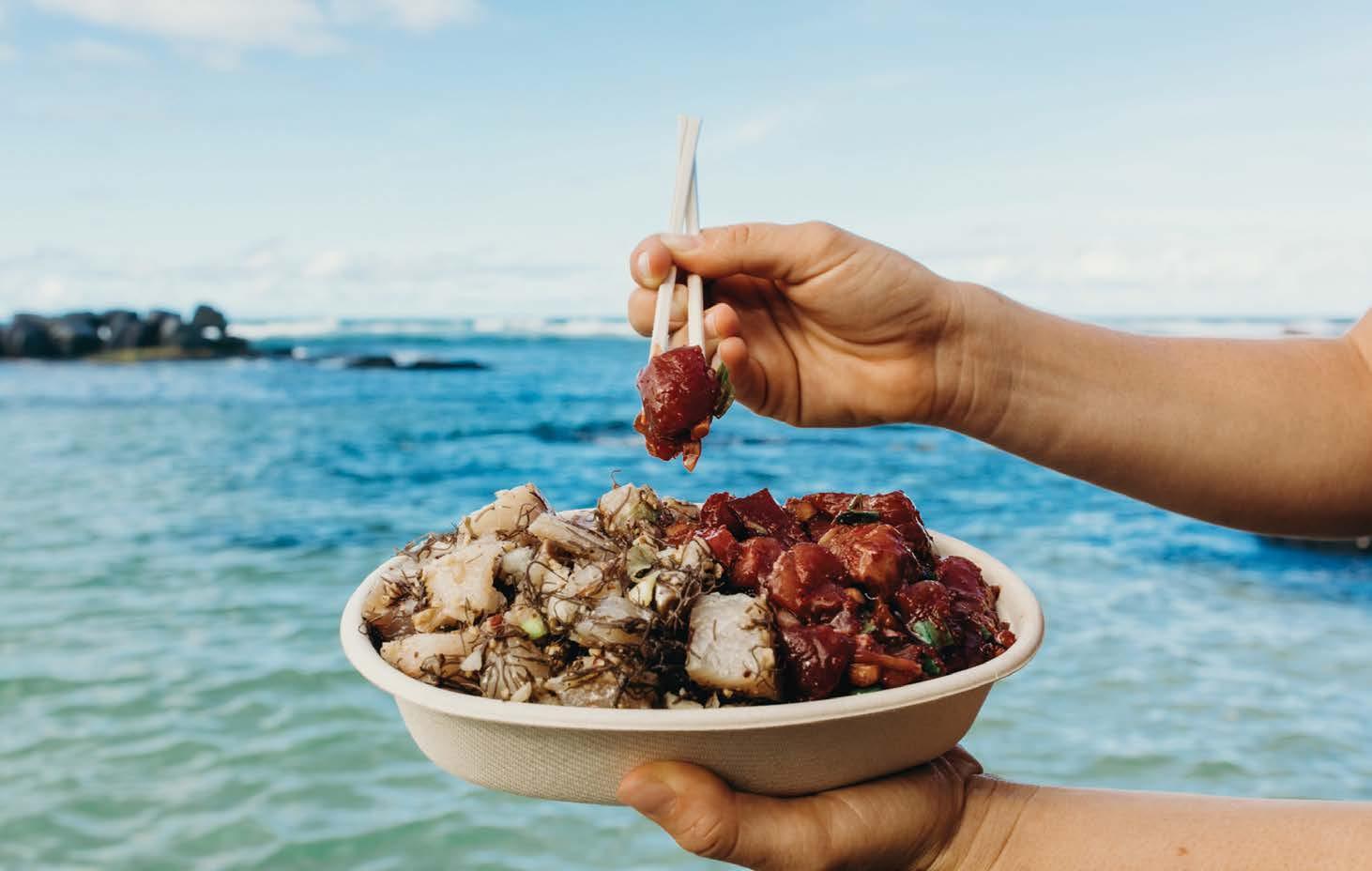
Our locally grown ingredients are the X factor behind the island of Hawai‘i’s tasty food. Fertile soils and sea offer the freshest produce, fruits, grass-fed beef, fish and other seafood. Creative visionaries take it one step further with island-made and grown honey, goat cheese, lamb, chocolate, vanilla and more! Follow the farm-to-table process by taking a farm tour. See how ideal climates help produce local vegetables, like mushrooms, cabbages, ginger, greens, sweet corn, kalo (taro) and tomatoes, all grown from volcanic soil and bursting with flavor. Orchards provide amazing bananas, guava, lychee, mango and papaya. Macadamia nuts are another popular Hawai‘i Island product — be sure to tour an orchard and processing plant to see how the world’s hardest nut is cracked.
Local Grindz
Some locals say:
• “Broke da mouth” — in other words, “Absolutely delicious!”
• haupia: firm coconut pudding
• shave ice: crushed ice flavored with sweet, brightly colored syrup (unless you’re on Hawai‘i Island - especially the East side - then it’s “ice shave”)
• kālua pig: pork covered with kī (ti) and banana leaves and cooked in an imu (underground oven)
• laulau: steamed fish and pork wrapped in kalo (taro) and kī (ti) leaves
• loco moco: hamburger patty, served over rice and topped with eggs and gravy
• lomi salmon: raw, salted salmon combined with diced tomatoes and onions
• malasada: Portuguese hole-less donut, golden brown on the outside, soft and fluffy on the inside and rolled in sugar
• manapua: meat-filled bun, steamed or baked; Chinese bao
• mochi: Japanese rice cake made of glutinous rice
• plate lunch: two scoops of white rice, one scoop of macaroni salad and a main entrée or two
• poi: pounded kalo (taro) root
• poke: to cube; seasoned raw fish salad
• pūpū: appetizer
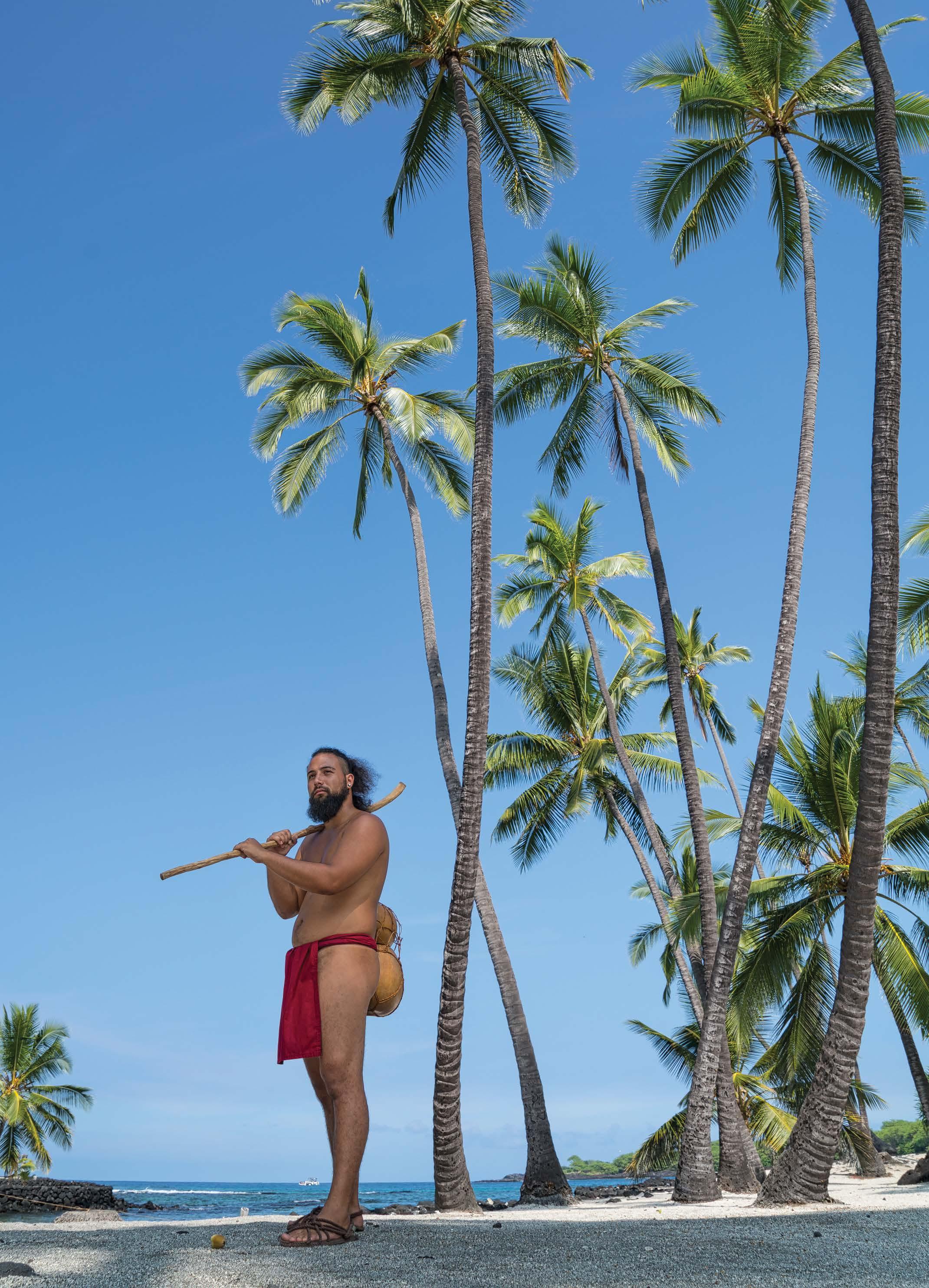
a place of endless
The past is an essential part of the present on this island of wonder, where Pelehonuamea — the goddess of fire and volcanoes — wields her power to shape the landscape. View sacred sites long honored by island residents, including heiau (temples), petroglyphs and fishponds. There is so much to explore that you’ll find inspiration at every turn.
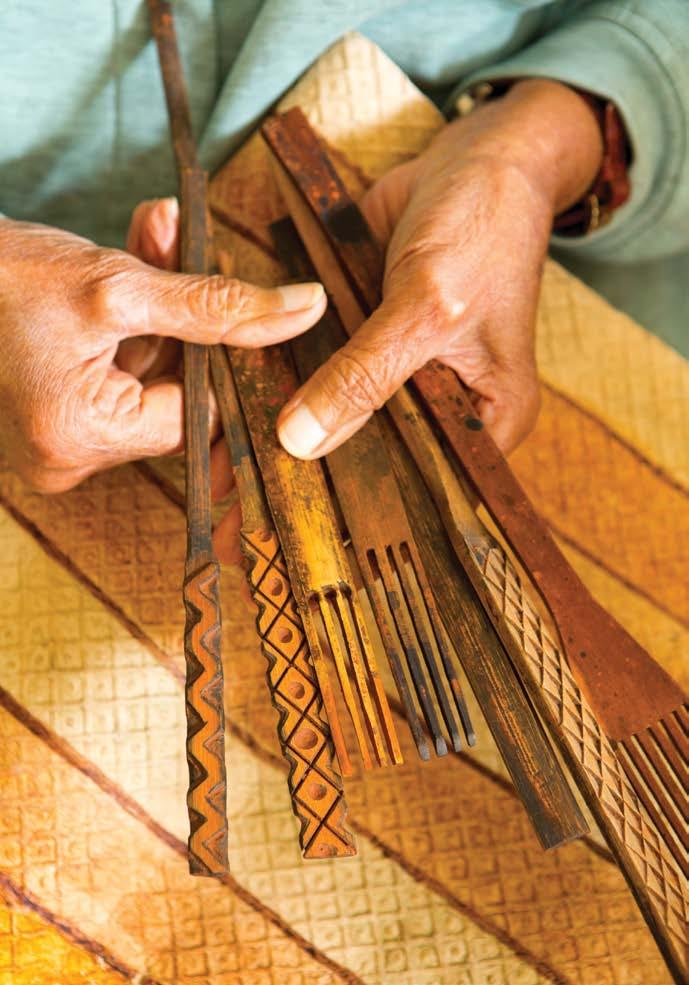
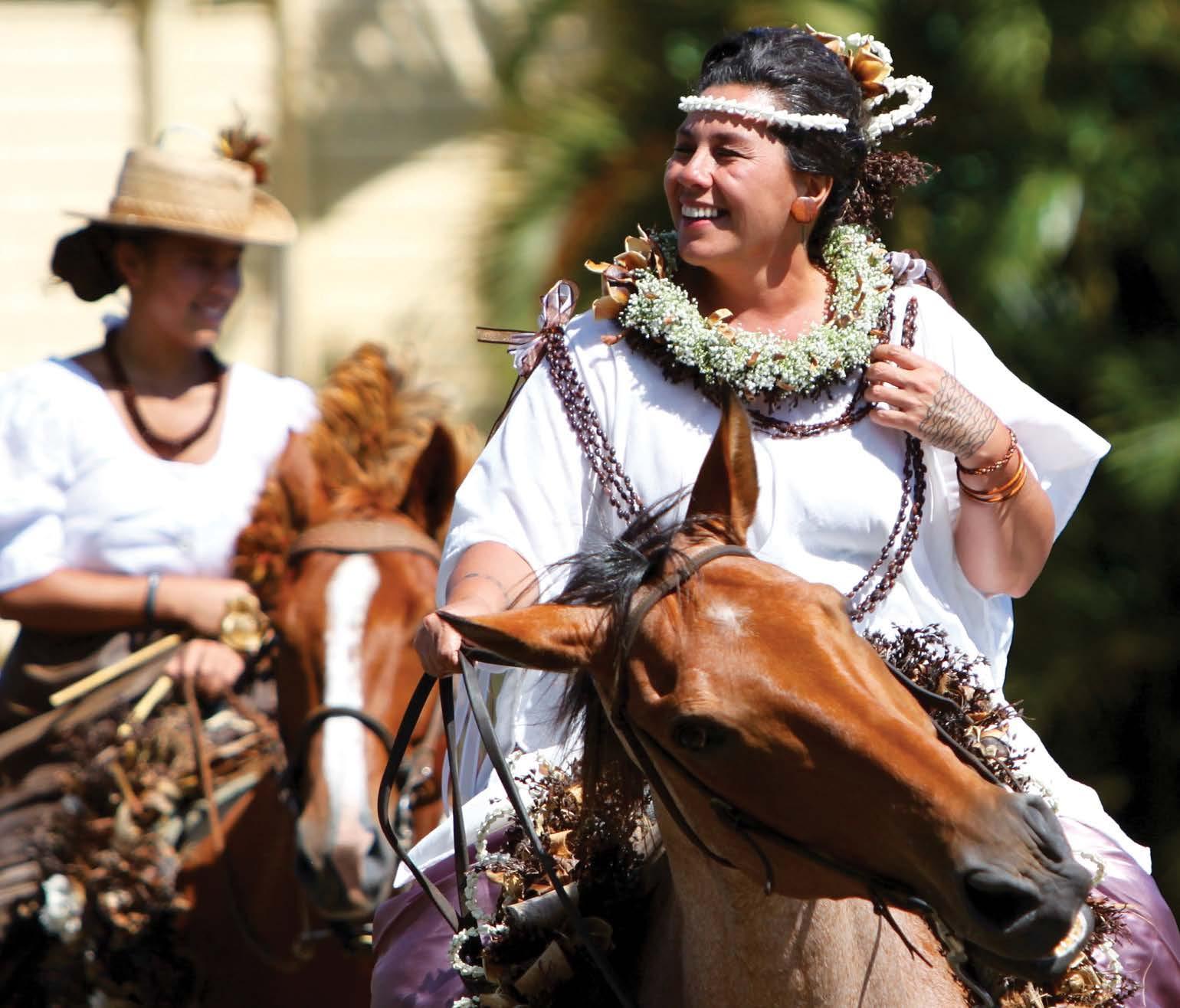
Throughout the Hawaiian Islands, there is a special intangible feeling often referred to as aloha — a word that gives the State of Hawai‘i its nickname, “The Aloha State.” Aloha is commonly heard as a greeting, but its meaning goes much deeper. It means love, kindness, compassion. It can also mean mercy, sympathy, sentiment, grace and charity. Aloha lives in many ways, and we invite you to discover its true significance on the island of Hawai‘i.
Pā‘ū has several meanings, including the skirt worn by hula dancers. In the 1800s, after the introduction of horses to the islands, a voluminous pā‘ū (skirt) made of fabric was artfully wrapped around a woman to protect her fancy clothing from the elements as she rode to a party or gathering. Today, pā‘ū are seen at many of Hawai‘i’s colorful floral parades, worn by women on horseback, often in colors that represent each main Hawaiian Island. Often referred to as a pā‘ū unit or pā‘ū riders, the riders and horses are bedecked with gorgeous floral lei
Enjoy the beautiful and diverse sounds of the island of Hawai‘i. From traditional slack-key guitar and ‘ukulele music to Hawaiian reggae, hip hop and modern beats. Download music from local artists to kickstart your vacation or as the perfect souvenir to remember your time on the islands.
Nothing is quite as universally symbolic of the Hawaiian Islands as the art of hula. While other Pacific cultures have unique dance traditions, hula is unique to Hawai‘i and has become an embodiment of Hawaiian culture, treasured and enjoyed by all who experience it. It was King Kalākaua who said, “Hula is the language of the heart, therefore the heartbeat of the Hawaiian people.” Beloved for reviving hula in the late 19th century, King Kalākaua is to whom the world’s premier hula event, the Merrie Monarch Festival, is dedicated. Each year in Hilo, this weeklong festival features two different eras and styles of hula: hula kahiko (traditional) and hula ‘auana (contemporary).
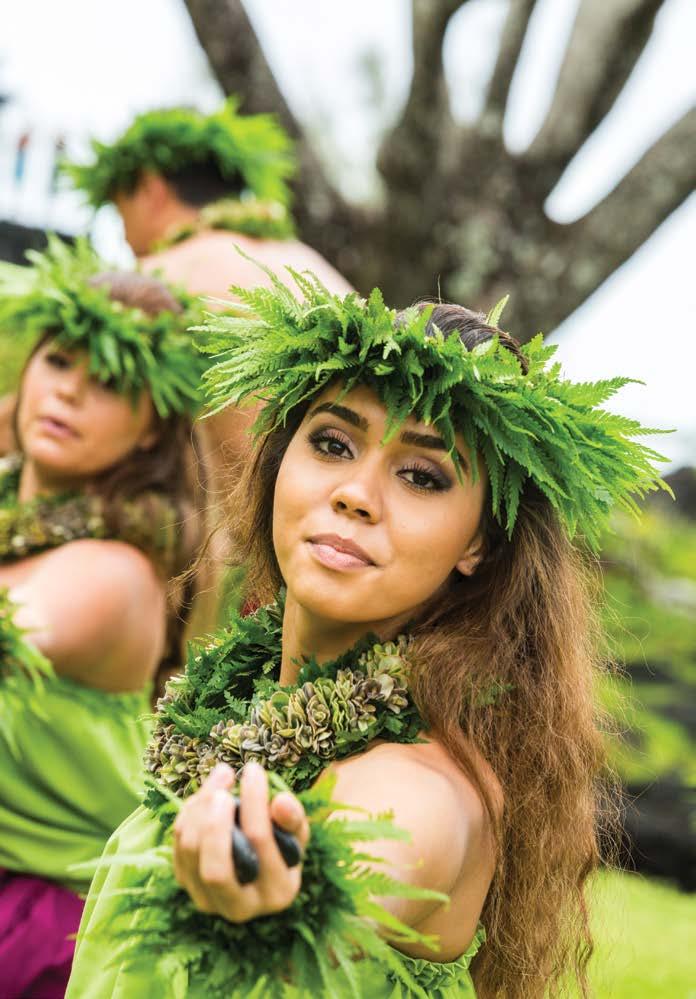
The two official languages of Hawai‘i are ‘Ōlelo Hawai‘i (Hawaiian) and English.
The Hawaiian language is a Polynesian dialect with 13 letters in its alphabet: A, E, H, I, K, L, M, N, O, P, U, W and the ‘okina (‘). The ‘okina is a glottal stop, like the sound between the ohs in oh-oh, and is a consonant. The ‘okina and kahakō ( ˉ ), or macron, change the pronunciation and meaning of a word. The Hawaiian language has 18 sounds:
• a like a in above
• ā like a in far
• e like e in bet
• ē like ay in pay
• i like y in city
• ī like ee in see
• o like o in low
• ō like o in sole
• u like oo in hoot
• ū like oo in moon
• he, ke, la, mu, nu, pi, we and w with a v sound.
Some vowels are diphthongs, forming a single sound as in “ai” in Wailuku. In general, the consonants are pronounced as in English with the exception of w. W can be either a v or a w sound, but it’s best to take direction from locals.
We’d recommend keeping the following in your word bank:
‘Āina: land; that which feeds us
Aloha: a reciprocal greeting of affection; hello, good-bye and so much more
Hele or Holoholo: travel
Kahuna: priest, minister, expert in any traditional practice
Kama‘āina: native-born or resident
Kāne: man
Kapu: prohibited, no trespassing; sacred
Keiki: child
Kuleana: responsibility, privilege
Kupuna: ancestor, grandparent or elder
Kōkua: help
Lei: a garland given for any occasion; traditionally flower, seed, shell, nut, feathers and various forms of foliage
Mahalo: thank you; respect
Ma kai: directional phrase - toward the ocean
Ma uka: directional phrase - toward the mountains
Mālama: to take care of; protect; save; preserve
‘Ohana: family
‘Ono: delicious
Pau: finished
Wahine: woman
Wikiwiki or ‘Āwīwī: fast
Hawaiian Dictionary: hilo.hawaii.edu/wehe/
In double-hulled canoes and using the stars, ocean currents, birds and other gifts of nature as their guide, it’s believed that voyagers from Tahiti and the Marquesas Islands in the South Pacific first landed near Kalae, or South Point, over 1,500 years ago.
Centuries later, in 1778, Captain James Cook arrived, opening the door to an influx of foreigners. Only a year later, warriors at Hawai‘i’s Kealakekua Bay killed Cook after a contentious chain of events. During this time, the island of Hawai‘i was divided into separate chiefdoms and war between factions became common. In 1791, Kohala-born Kamehameha I united the island and continued to unify all of the other islands into what would later be called the collective Hawaiian Islands. King Kamehameha I housed his court on the island of Hawai‘i until 1804 and returned here in 1812 before passing away in 1819. British Captain George Vancouver gifted

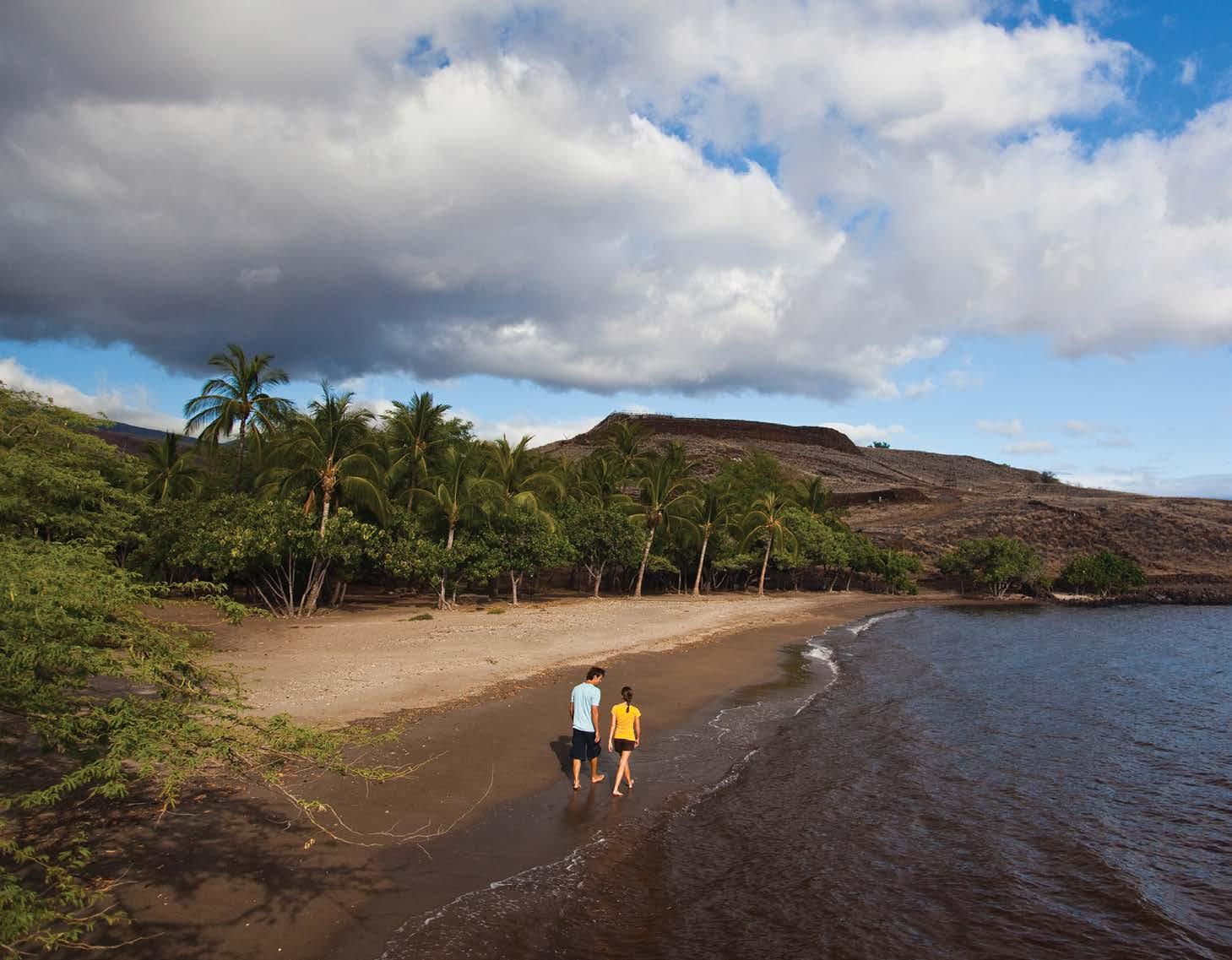
five cattle to Kamehameha in 1788, from whence Parker Ranch, at one time the largest privately-owned cattle ranch in the country, was born. In the 1830s Kamehameha I’s son, Kamehameha III, introduced vaqueros (Mexican cowboys) to help corral the growing population of cattle. In 1820, Protestant missionaries from Boston arrived in Historic Kailua Village and other westerners followed. Many different cultures, once foreign to Hawai‘i, came to work the sugar plantations in the 20th century. Today, our island remains rooted in Hawaiian culture while enjoying many traditions brought to our shores by those long-ago immigrants.
This restored compound on the Kona Coast served as the last place of refuge for kapu (taboo) breakers. Hawaiian temple ruins, fishponds, sacred burial spots and petroglyphs from ancient times are preserved here.
Built under the rule of King Kamehameha I in 1790, this was the last major heiau (religious temple) constructed by Hawaiians. Located in Kawaihae, this is the largest restored heiau in Hawai‘i.
A monument here marks the spot where Captain James Cook, who first established European contact with the Hawaiian Islands, was killed in a battle with Native Hawaiians in 1779. Today, this marine life preserve is a great place to snorkel.
Hawai‘i’s greatest ali‘i (chief) was believed to have been born at the island’s northern tip sometime in the 1750s. Near his birthplace, in Kapa‘au, stands the original King Kamehameha I statue. Thought to be lost at sea, the statue was recovered after a replacement was created.
Located on Ali‘i Drive in Kailua Village, this is the first Christian church built in Hawai‘i by the first missionaries to arrive on the islands in 1820. It was added to the National Register of Historic Places in 1978 and, in 2014, was recognized by the National Trust for Historic Preservation as one of the 11 Most Endangered Historic Sites in the U.S.
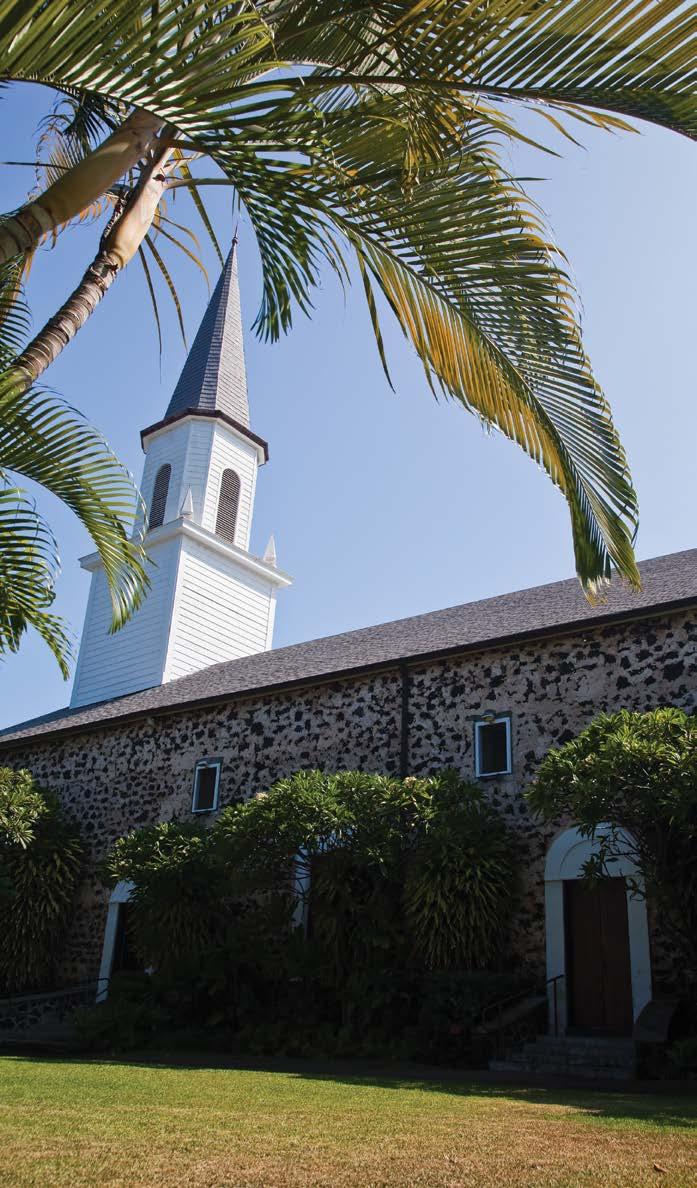

What a better place to explore our island’s history than a museum? There are so many to choose from.
Kaloko-Honokōhau
National Historical Park
Established in 1978, this park preserves, protects and interprets traditional Native Hawaiian activities and culture, including ki‘i pōhaku (petroglyphs), kahua (housing platforms), hōlua (stone slide) and heiau (places of worship). It also has portions of four different ahupua‘a (traditional mountain-to-sea land divisions) within the park’s boundaries.
Restored from an old stationmaster’s home, this museum commemorates the Hilo Railroad (1899–1946) that hauled sugar, provisions and people up and down the coast. 808-962-6300, thetrainmuseum.com
The center explores the connections between Hawaiian cultural traditions and the science of astronomy. Experience interactive
exhibits, planetarium shows and group tours, and don’t forget the gift shop, café or many events held throughout the year! 808-932-8901, imiloahawaii.org
This museum showcases the natural and cultural history of the island, featuring the furniture and items used by early missionary families. 808-935-5021, lymanmuseum.org
The Discovery Center for Hawai‘i’s Remote Coral Reefs offers educational and interactive exhibits, including a 2,500-gallon aquarium. 808-498-4709, papahanaumokuakea. gov/education/center.html

This museum educates about tsunamis and serves as a living memorial to those who lost their lives in past tsunamis. 808-935-0926, tsunami.org
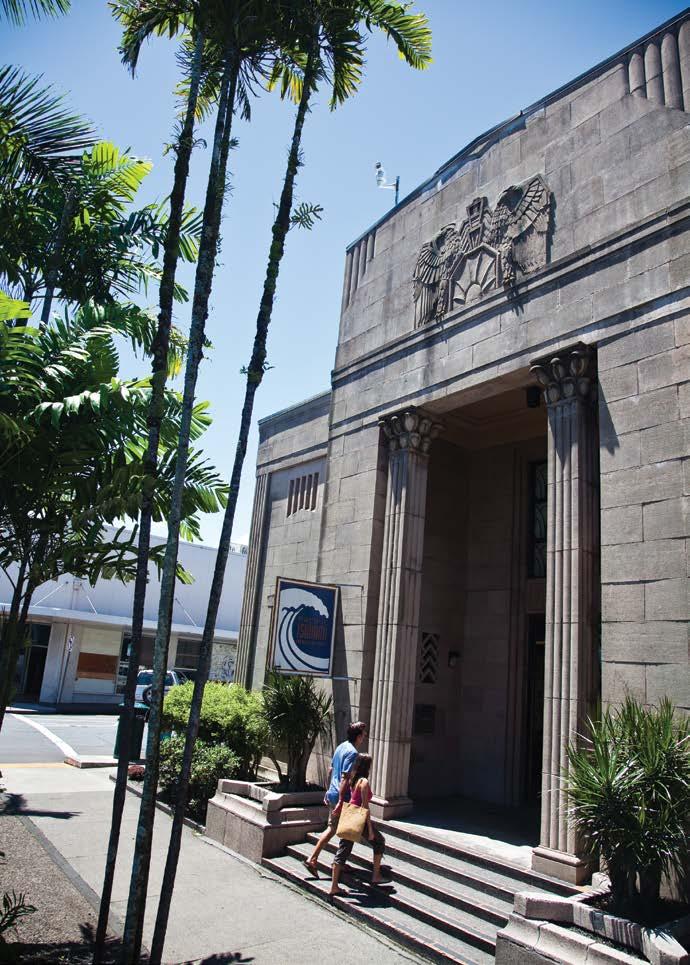
This museum is housed in the historic H.N. Greenwell Store built in 1875, which originally served as a general store for the local community. The museum offers a glimpse into the region’s history, showcasing exhibits related to the sugar industry, early Hawaiian life and the Greenwell family’s legacy. 808-323-3222, konahistorical.org/ hn-greenwell-store-museum
On the State and National Register of Historic Places, this center celebrates the history of ranching in Hawai‘i, offering exhibits that highlight the island’s rich agricultural heritage. Visitors can learn about the evolution of the cattle industry, traditional ranching practices and the influence of ranching on Hawaiian culture and economy.

Formerly a vacation residence for Hawaiian royalty, this museum displays royal Hawaiian artifacts and personal memorabilia of the island’s kings and queens. Overlooking Kailua Bay, the beautifully restored palace offers guided tours, sharing the rich history and legacy of Hawai‘i’s ali‘i (chiefs) in an intimate oceanfront setting. 808-329-1877, daughtersofhawaii.org/hulihee-palace
A step back in time to the days of the paniolo (Hawaiian cowboy). History is brought to life and illustrated through a collection of artifacts, images and even original Hawaiian saddles. The Center also offers a variety of ranch-themed gifts and is home to the Nā Wāhine Holo Lio Pā‘ū Museum, honoring the history of the region’s pā‘ū riders. paniolopreservation.org/heritage-center
With so many natural wonders and cultural riches, who can blame residents for celebrating yearround?
From hula to history, food to flowers, coffee to kings, there’s always a special event to enjoy. And don’t forget championship golf, tennis, rodeos and triathlons!


The PGA TOUR Champions’ season-opening event, attracting top golf legends for an exciting competition on the stunning oceanfront course. facebook.com/MitsubishiElectricChampionship
A family-friendly annual rodeo event held over Presidents’ Day weekend. hawaiirodeostampede.com
A weeklong festival that includes an internationally acclaimed hula competition, a Hawaiian arts fair, hula shows and a grand parade through Hilo town. The festival typically begins on Easter Sunday and concludes the following Saturday. merriemonarch.com
The IRONMAN® 70.3 Hawai‘i, also known as the Honu Race, is an annual swim, bike and run triathlon event that serves as a qualifier for the October IRONMAN® 70.3 World Championship, offering Age Group Qualifying Slots. ironman.com/races/im703-hawaii
Activities and ho‘olaule‘a (festivals) around the island include visits to North Kohala (birthplace of King Kamehameha I) with lei-draping and protocol, a parade in KailuaKona and a lei-draping ceremony in Hilo, all celebrating the life and legacy of the island’s first monarch. sfca.hawaii.gov/ resources/king-kamehameha-celebrationcommission
Waimea celebrates the paniolo way of life with traditional rodeo events, family-friendly activities, live music, food vendors and a tribute to Hawai‘i’s ranching heritage. parkerranch.com
Pu‘ukoholā Heiau National Historic Site celebrates its annual “Ho‘oku‘ikahi” (Establishment Day) Hawaiian Cultural Festival, featuring a ho‘okupu (offering) ceremony, workshops and demonstrations of traditional Hawaiian arts and crafts, including lauhala weaving, canoe rides, quilting, Hawaiian games, lei making, kapa making, bamboo stamping and live Hawaiian music. nps.gov/puhe/index.htm
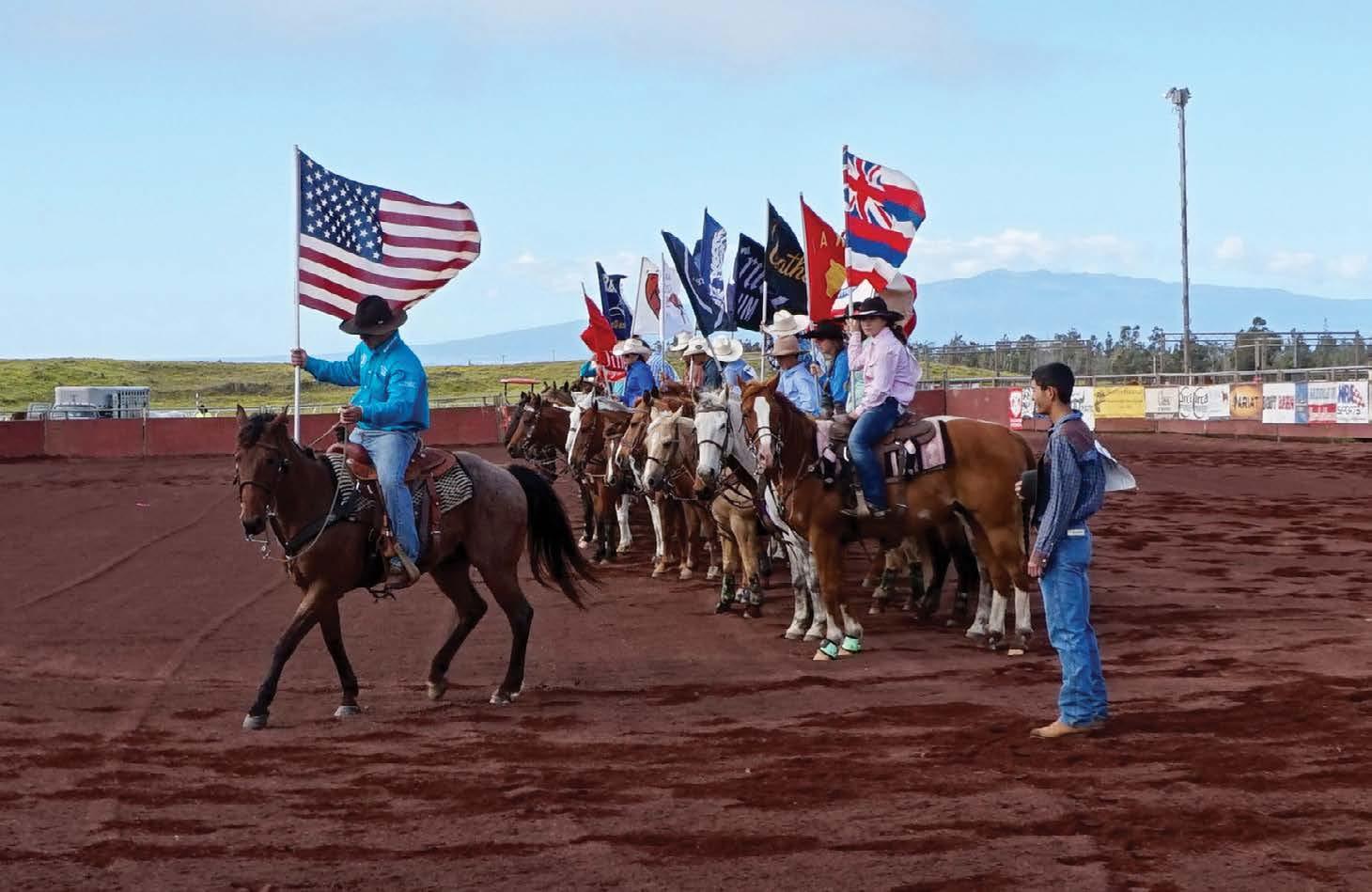
Since its inception in 1972, it has grown into the world’s largest long-distance outrigger canoe competition, attracting over 2,500 paddlers from around the globe to Kona for a multi-day event featuring elite races, cultural festivities and traditional Hawaiian ceremonies. qlcanoerace.com

This historic race is an iconic endurance challenge set against the stunning backdrop of Hawai‘i Island, taking athletes on an unforgettable journey through the birthplace of the IRONMAN® World Championship, where they push their limits in the ultimate test of strength, stamina and determination. ironman.com/races/im-world-championship-kona
Hawai‘i’s oldest food festival celebrates nearly 200 years of Kona’s rich coffee heritage through farm tours, tastings, cultural performances and a prestigious cupping competition. This annual event honors the generations of coffee farmers who have shaped Kona’s globally renowned coffee industry while promoting its history, sustainability and deep multicultural roots. konacoffeefest.com
For more Hawai‘i Island events, visit gohawaii.com/events

Tours showcasing every incredible sight on the Island of Hawai‘i. Departs from Waikoloa Heliport.




Several major carriers offer non-stop flights to Ellison Onizuka Kona International Airport at Keāhole (KOA), and include flights from the Continent, Canada (seasonal), and Japan (seasonal). Most major airlines serve Daniel K. Inouye International Airport (HNL). From there, it’s a quick 45-minute “island hop” on Hawaiian Airlines or Southwest Airlines to Kona (KOA) and Hilo (ITO) International Airports.
Hawai‘i Standard Time is GMT-10 (Pacific Standard Time-2, Eastern Standard Time5). Since Hawai‘i doesn’t observe daylight saving time, add one hour to the time difference when in effect (March through November).

The average daytime summer temperature at sea level is 85 degrees Fahrenheit. In winter months, the average temperature is 78 degrees Fahrenheit at sea level and 45 to 55 degrees Fahrenheit at higher elevations; however, mountaintop elevations can be below freezing. Rainfall varies widely from the west/dry side to the east/wet side. The Kohala Coast averages 10” per year. Hilo averages 132”, though much of the rain on the Hilo side falls at night.
You’ll want to show off a nice tan when you go home, but please use common sense when sunbathing in the tropics. Remember, it’s usually hottest between 11 a.m. and 2 p.m. and the sun is stronger here than you’re probably used to. Non-prescription sunscreen containing oxybenzone and octinoxate is prohibited in Hawai‘i waters.
The dress code is resort casual. Because of the numerous Hawai‘i Island microclimates, pack a sweater or light jacket.
The ocean is Hawai‘i’s playground, but there are precautions to observe. Offshore winds and currents can be powerful and change suddenly. That means, don’t stray far from shore or head out to kayak, windsurf or sail if warning signs are posted or if conditions
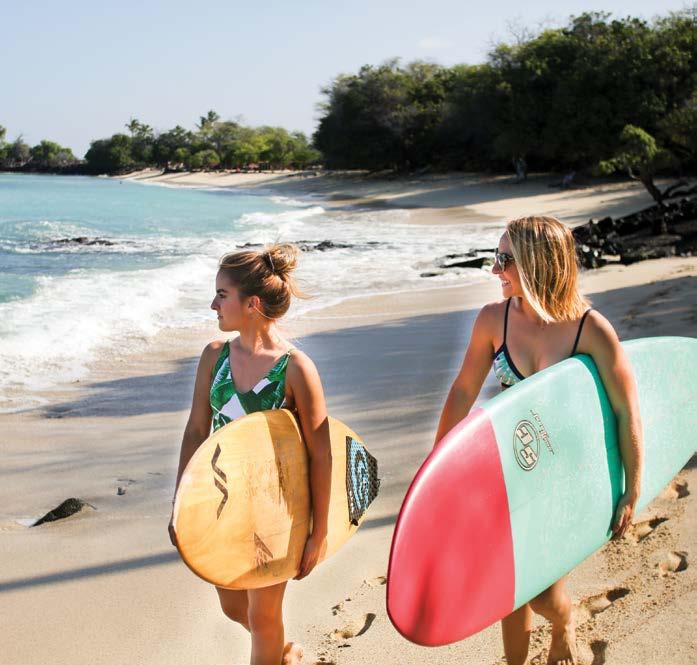
warrant caution. If you’re unsure about conditions, ask a lifeguard. For information about beach safety conditions, visit hawaiibeachsafety.com. If you’re hiking into a wilderness or remote area, be sure someone knows where you are going and your expected return date/time, and observe all warning signs. In the national parks, sign out with park rangers. Few places are as safe as Hawai‘i, but that doesn’t mean you should abandon all care as you travel about. Lock your car doors and don’t leave any personal belongings in your unattended vehicle.
The area code for the entire state is 808. For calls between islands, dial 1-808 and then the number. When placing calls to the Continental U.S. from Hawai‘i, dial 1, the area code and the number. All on-island calls are local. Hawai‘i Island’s cell phone law requires the use of a hands-free device when using a mobile electronic device
while operating a motor vehicle. Many of Hawai‘i’s larger hotels and condominium resorts have high-speed internet access, including wireless in some public areas.
Ground transportation includes rental cars, limousine services, shuttles and taxis. Several companies provide guided tours with transportation included. Since the island is large, most visitors rent a car. Hawai‘i County provides public transportation around the island on the Hele-On bus, although routes and frequency are extremely limited. For information on child car seat regulations, visit hidot.hawaii.gov/ highways/safe-communities/child-passenger-safety
The natural beauty of Hawai‘i’s fragile environment comes from its geographical isolation from other ecosystems. The Department of Agriculture enforces strict rules regarding the exportation of uninspected plants and animals. When departing, luggage must pass a pre-flight check at the airport to ensure that no plants, insects or diseases are hitching a ride back with you. You’re welcome to take inspected fresh flowers and fruits home. Many items purchased at the airport or mailed home from local vendors are already inspected. For more information, call the Department of Agriculture at 808-933-9040 (Hilo) or 808-326-1252 (Kona).
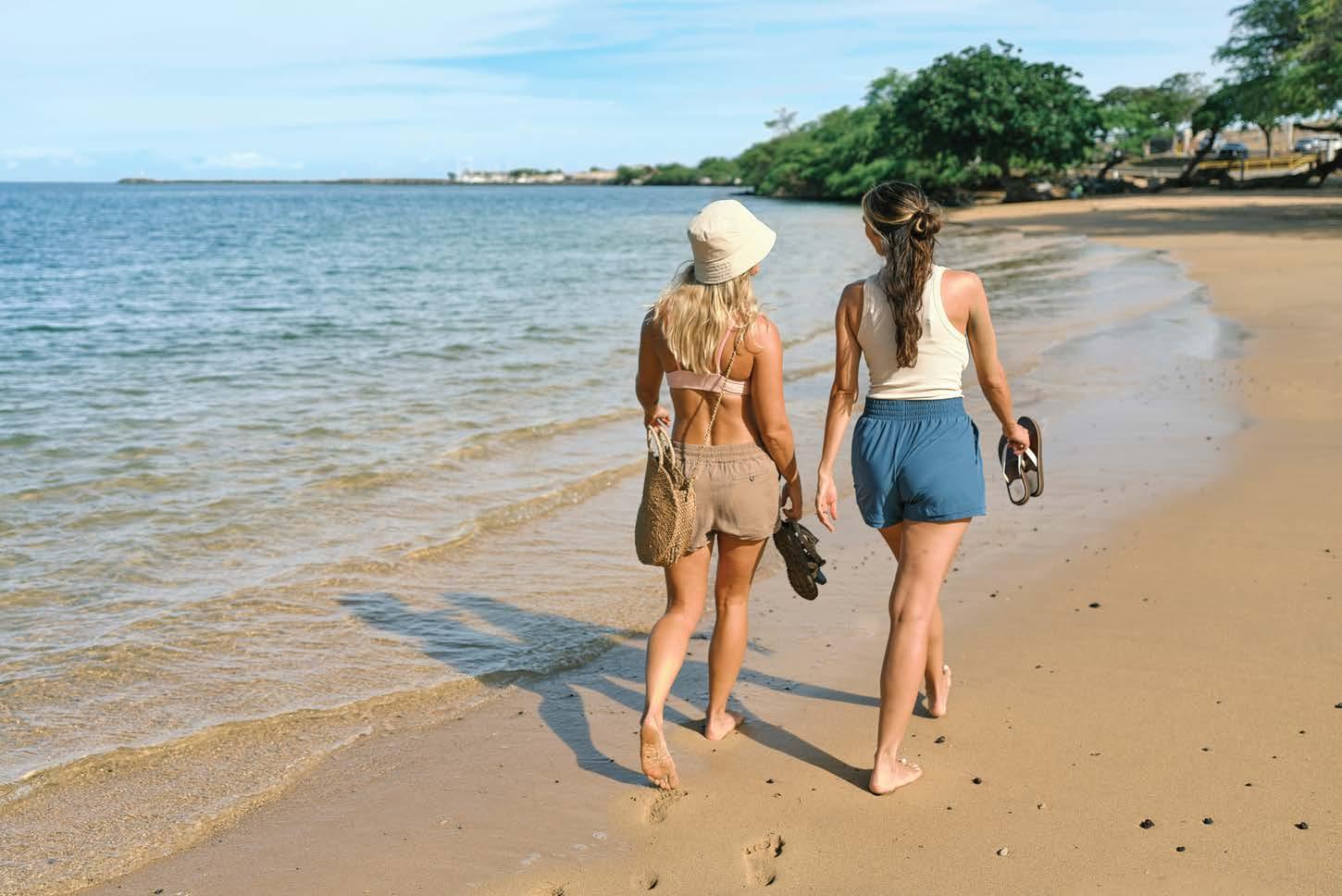
THE ISLAND OF HAWAI‘I
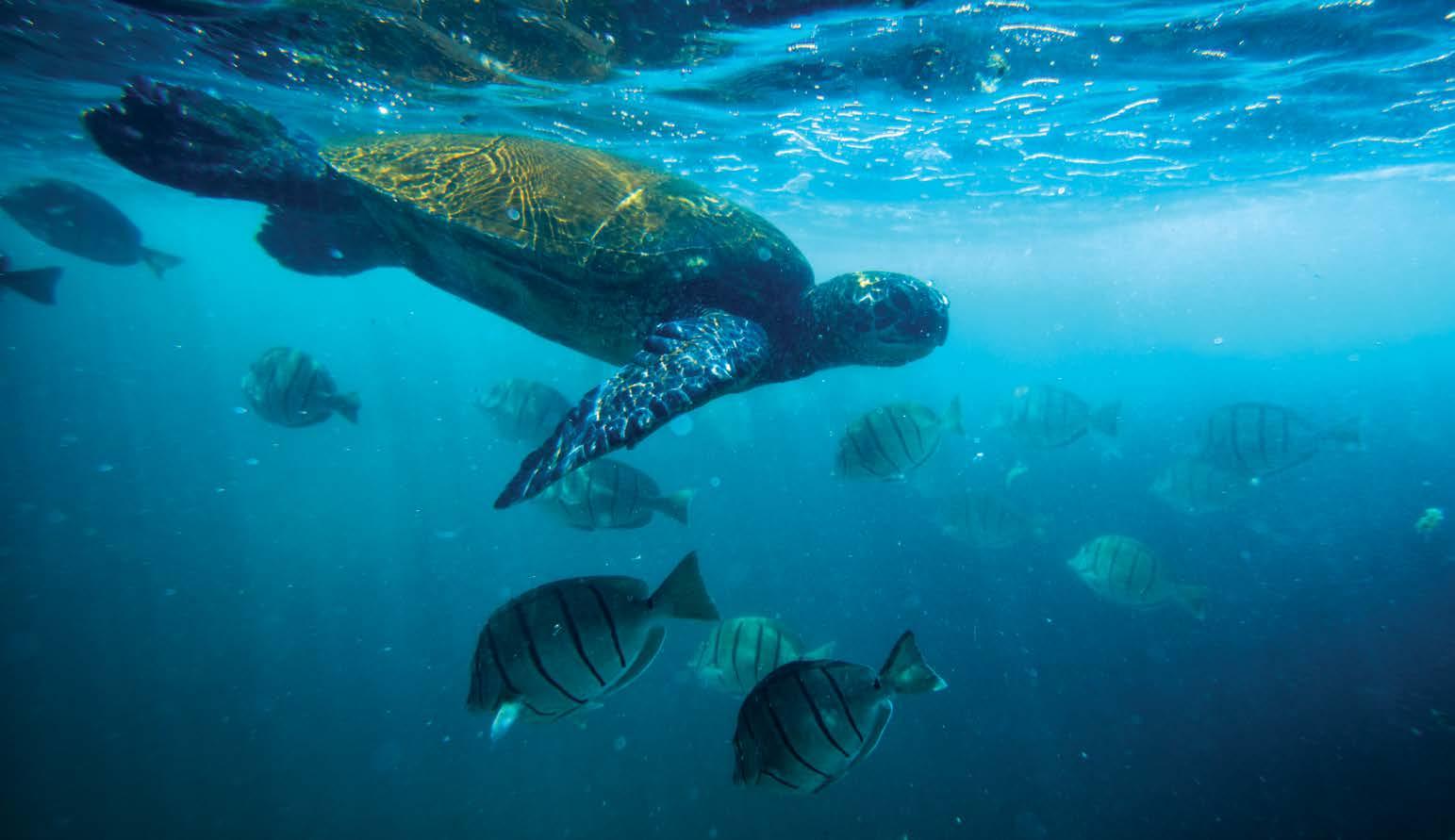
Mālama i ke kai (care for the ocean) is a Hawaiian tradition that you should practice while visiting the Island of Hawai‘i. This means please don’t touch the coral or the plants and animals surrounding it. In fact, keep a respectful distance from all sea creatures — for their safety and yours. Use reef-friendly sunscreen only.
Mālama i ka ‘āina (care for the land) is one of the more important concepts in Hawaiian philosophy, and it’s as important today as ever. Help us take care of natural resources by staying on trails when hiking and by not disturbing any plants or historical features. Guided tours are sensitive to the environment, and you are sure to learn more with an expert on hand.
There are many organizations dedicated to revitalizing the island’s diverse and sometimes fragile ecosystems. Should you wish to volunteer, please visit gohawaii. com/malama for a list of opportunities. Volunteering is a great way to have fun while exploring and learning more about the island.
This is a fungal disease that rapidly kills ‘ōhi‘a trees, causing major disruptions to Hawai‘i’s ecosystems, impacting watersheds, cultural traditions and native wildlife.
Help stop the spread: Before and after forest visits, clean shoes and boots thoroughly. Stay on marked trails. For more information, visit: cms.ctahr.hawaii.edu/rod
Please help us by recycling and/or properly disposing of your ‘ōpala (trash) and avoid littering. Single-use plastic bags with handles are not provided in stores. Consider purchasing a reusable grocery bag (offered at most stores).
If you have any unopened/unused food items toward the end of your visit, and would like to donate it to the local Hawai‘i Island Food Basket, please visit: hawaiifoodbasket.org/donatefood
The Hawai‘i Smoke-Free Law prohibits smoking in enclosed public areas, beaches, workplaces and within 20 feet of doorways, windows, and ventilation intakes, including e-cigarettes.

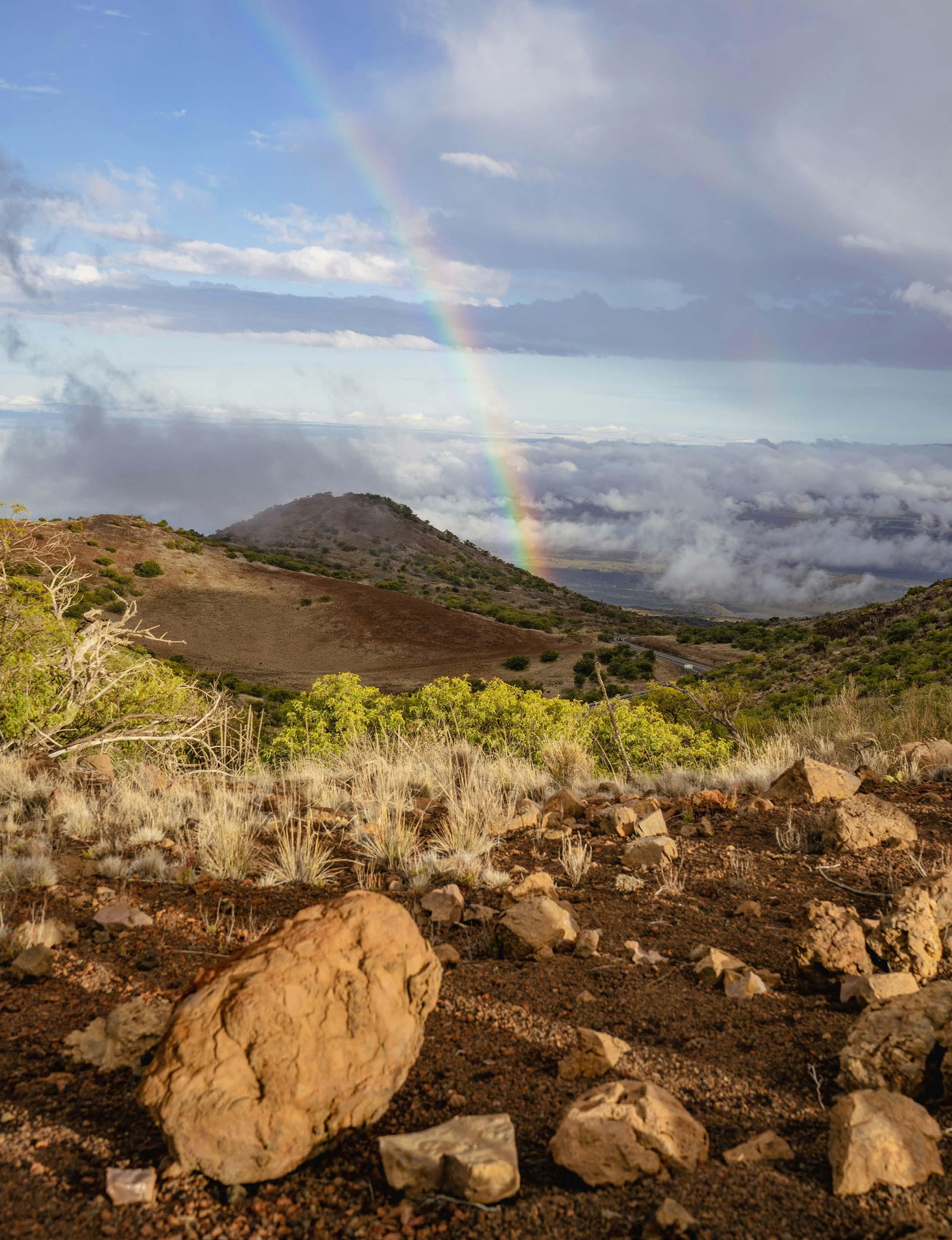
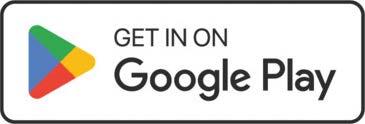







HVCB members are a community of more than 1,300 businesses collaborating with the Hawai‘i Visitors & Convention Bureau to shape Hawai‘i’s future and deliver valuable experiences.
View the directory by clicking on the buttons below.
